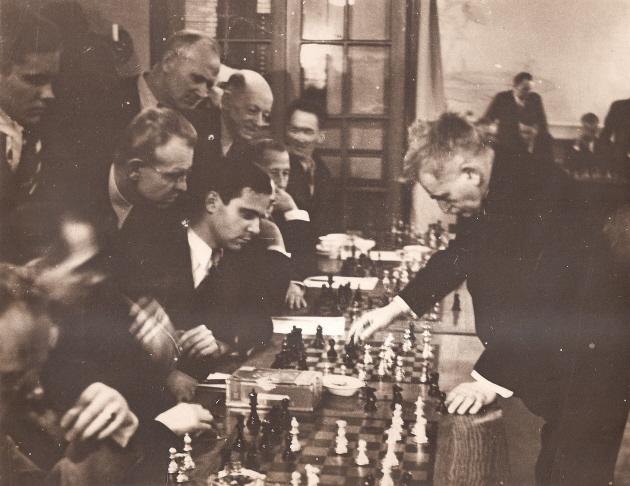
Edward Winter

See C.N. 7738.
***
One type of book that we would like to see far more of is memoirs of the great and half-great. An example, which has received little attention, is Chess Memoirs by Dr Joseph Platz (Chess Enterprises, Inc., 1979). The early part of the book is particularly fine, and no future writer on Emanuel Lasker (‘My dear friend and teacher, the greatest of them all’) will be able to ignore the insights offered by Platz, especially into the ex-world champion’s final hours (page 40) ...
(101)
Fischer aficionados will want to refer to page 135 and Dr Platz’s victory in a 1964 simultaneous exhibition over R.J.F. After 37 moves, Fischer resigned: ‘The end came so swiftly that I hardly knew what had happened when he threw his king over in disgust.’ For some reason Platz manages to see the victory as revenge for the unkind things Fischer had said about Platz’s mentor, Dr Lasker. Incidentally, it needs to be pointed out that Alekhine [as opposed to the Editor, Hermann Helms] did not write in the New York, 1924 tournament book: ‘History had repeated itself. Lasker was again King! Once more the chessworld expressed in tournament play was at his feet.’
(138)
Botvinnik was another notable absentee from Fischer’s selection of ‘the ten greatest masters in history’ (Chessworld, January-February 1964). The following explanation was on page 57:
‘In compiling this list of ten greatest Masters is history, Bobby Fischer (who in the editor’s opinion belongs on such a list himself) based his final selection on the games of the players he has named rather than on performances and credits earned – which could explain players like Lasker, Botvinnik, etc. not being mentioned. When queried on this point, Bobby replied: “Just because a man was a champion for many years does not necessarily mean that he was a great player – just as we wouldn’t necessarily call a ruler of a country ‘great’ merely because he was in power for a long time.”’
See also C.N. 2489 below.
There is a peculiar sentence in Emanuel Lasker’s book How to Play Chess (we are following the recent edition of Gramercy Publishing Co. , New York). Page 17 has a list of conditions under which castling is permissible. The third reads:
‘3. In Castling, neither the K nor the R are permitted to expose themselves to capture, nor may the K castle to get out of check.’
Why ‘nor the R’?
(189)
Scrutiny of Lasker’s Manual of Chess clarifies matters, for it is explained that castling is illegal if the rook would land on a square attacked by the opponent. This may seem odd to modern eyes since it is normally explained that the king in castling may not ‘pass through check’. However, since the square the king ’passes through’ (KB1 or Q1 ) is the same as where the relevant rook lands up, it all amounts to the same thing.
(813)
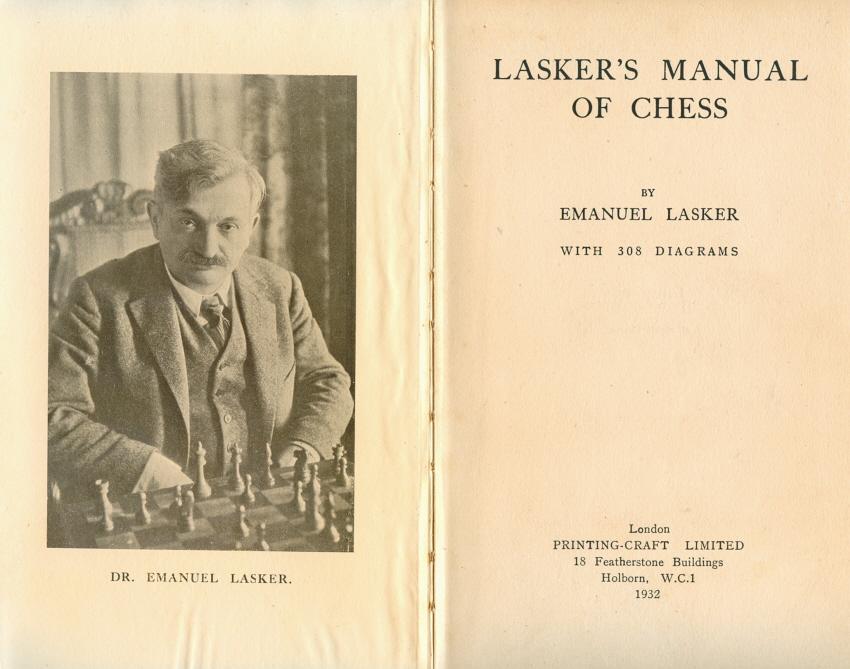
Emanuel Lasker came third at Graz, 1890 when he was 21 and was placed second at Moscow, 1925 when he was 56. In the intervening period he was third once, joint second once and won every other tournament in which he participated. During the same time he played 19 matches, losing only one (to Capablanca, 1921).
Capablanca came lower than first (i.e. second) in only two tournaments between San Sebastián, 1911 and London, 1922 inclusive. Alekhine came second just twice between Scarborough, 1926 and Dresden, 1936.
(288)
With respect to the earliest encounters between Lasker and Capablanca, see Fast Chess.
Regarding Draw! by Wolfgang Heidenfeld, C.N. 394 (see page 234 of Chess Explorations) gave a selection of quotations, including the following on the seventh match-game, Schlechter-Lasker, Berlin, 1910) from pages 26 and 30:
‘It is probably the most profound game ever played in a world championship match.’
At the end of his (wonderful) annotations to the game Heidenfeld concludes:
‘And yet there are people who maintain that Karpov and Korchnoi are stronger than Lasker and Schlechter. They must be joking.’
(394)
V.N. Panov’s biography of Capablanca (Moscow, 1970 edition, page 19) states that in February 1909 Lasker predicted that Capablanca would beat Marshall in the forthcoming match, and that the Cuban might well be a future world title challenger. Do any other sources confirm this?
(404)
See Chess Predictions.
As noted on page 50 of Chernev’s Wonders and Curiosities of Chess, N.M. MacLeod holds the unenviable record of the most games lost in a single tournament: 31 at New York, 1889.
He was, however, responsible for an extraordinary defeat of Emanuel Lasker in a simultaneous exhibition in Quebec in 1892. Extraordinary, because it must surely be the only game Lasker ever played in which he struggled on in vain when two queens down:
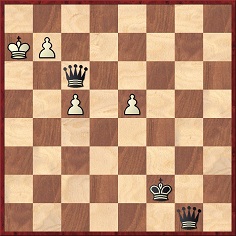
57....Qa1+ (There is a mate in two with 57...Qb1, 57...Qgh1 or 57...Qg7.) 58 Kb8 Qe8+ 59 Kc7 Qa5+ 60 Kd6 Qad8 mate.
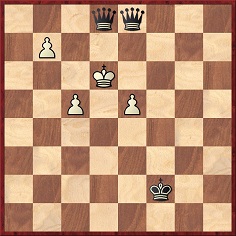
Source: BCM, August 1893, pages 359-360.
A potted biography of Nicholas Menelaus MacLeod which Jeremy Gaige sent us in 1983 was reproduced in C.N. 479 and is included in our feature article on Gaige.
An extract from C.N. 548, written in 1983:
The recent death of Salo Flohr, aged 74, removes from the chess world one of the finest players of the century. By the late 1930s he was in line for a world championship match with Alekhine, and was nominated (albeit unjustly, in our view) by FIDE as the official challenger. The match, however, never came about ... By the end of the Second World War, Flohr was but a shadow of his former self ...
Flohr was unquestionably at his best in the 1930s. Indeed – although this may not have been pointed out before – at Nottingham, 1936 he became the only player who has ever managed to beat both Lasker and Capablanca in the same tournament.
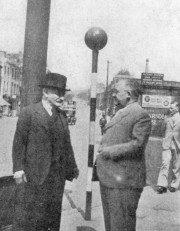
Lasker and Vidmar, Nottingham, 1936
See Photographs of Nottingham, 1936.
The fourth issue of Lasker and His Contemporaries, edited by Robert B. Long, is at last available. Few readers of Chess Notes will want to miss this good production, there being the now familiar blend of articles, games, photographs, artwork, etc. that adds up to a considerable amount of leisurely reading material.
Nonetheless we have reservations about L&HC and found this fourth edition rather a let-down. Since Mr Long objects in his editorial column to criticisms not substantiated by facts, we will endeavour here to provide all the back-up details necessary to justify our substantial worries about the direction being taken by what ought to be an excellent, and not just a good, journal.
There is an article (1892 vintage) by Lasker himself on blindfold chess. This is riddled with blunders, and surely these should at least have been pointed out in footnotes. How could Labourdonnais have played at the Divan in 1842 when he died in 1840? Morphy did not play a challenge game with Löwenthal in 1852 in London; it was only six years later that he first travelled to Europe. Moreover, his score at New York, 1857 was +14 –1 =3, not +5 –1 =1. (Perhaps Lasker was confusing the tournament result with Morphy’s individual ‘match’ score with Paulsen, but even here he would be in error since that was +5 –1 =2). Lasker mixes up Horwitz with Harrwitz. And for Lichtenstein read Lichtenhein. Morphy was 20, not 21, when he won the New York tourney. Louis Paulsen is stated to have been born in Iowa (!), but was actually born in Nassengrund, Germany.
That is an awful lot wrong for a little article, and it is hard to escape the conclusion that the Editor of L&HC failed to notice any of it, since otherwise he would surely have drawn the reader’s attention to the publication of what must clearly be one of the most careless articles ever written by a world champion.
Similarly, the Editor should surely have cried ‘No!’ when, on page 150, Luigi Miliani claims that the famous 5 Qe2 in the Petroff Defence was ‘first introduced in the St Petersburg 1914 Tournament’. In fact, Morphy played it when he was 12 against Löwenthal in New Orleans (May 1850). This, we thought, is very well known.
There are, also, rather too many typographical errors. These we do not propose to list (except if challenged ...), and most of the time they are spelling or proof-reading slips that will mislead nobody. Note, however, on page 170 that in the fourth match-game Steinitz-Lasker it was Black, not White, who resigned. There is also a degree of diagram trouble, but this is perhaps of only aesthetic importance. Ironically, some sections of issue four seem to have been rushed. Some games and photographs are too familiar, although the fine New York, 1893 group shot is the first time that we can recall ever seeing Gossip.
One stray thought: when translating Dus-Chotimirsky’s reminiscences of Lasker, Jim Marfia does give a corrective note. The Café Kerkau in Berlin is mentioned and we read, ‘I think maybe he meant Hamburg? – JDM ’. There is no point to such a comment unless one is sure. JDM should have read page 34 of issue one of L&HC – Berlin is correct. And, once again, we feel that the Editor should have stepped in.
It is a pity to be so hard on this journal, but maximum possible accuracy must always be demanded. At times, frankly, we felt that this issue of L&HC was unscholarly and not a master of its subject. There is no contradiction between these sentiments and our general appreciation in the opening paragraph that L&HC is required reading. Specific criticisms made here should be seen as a measure of how much we believe the journal has to offer in the future and how much we care that subsequent issues should be better.
(631)
Lasker’s limited interest in blindfold chess was summarized on pages 51-52 of the Hearst/Knott monograph.
Capablanca once chose his top 12 (active) masters, dividing them into three groups:
1) Alekhine, Capablanca, Lasker;
2) Bogoljubow, Nimzowitsch, Vidmar;
3) Euwe, Marshall, Réti, Rubinstein, Spielmann, Tartakower.
Source: Wiener Schachzeitung February 1929, page 61, the material being acknowledged as taken from the Glasgow Herald.
(694)
We note that the Scottish newspaper published this unsourced report on page 7 of its 8 December 1928 edition:
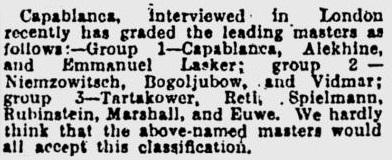
A quote from page 102 of J. Platz’s Chess Memoirs, concerning the two Laskers:
‘... I personally witnessed when Edward came to Emanuel just to “show” him an interesting endgame position. And everybody who knew Emanuel Lasker knows that he would never ask: “Who is White and who is Black?” but go right down to the analysis of the position and get deeply involved with it. And that is how Dr Edward Lasker got a thorough analysis of a position which in reality was one of his adjourned tournament games! Emanuel Lasker never knew the truth.’
From pages 30-31 of Chess for Fun & Chess for Blood by Edward Lasker:
‘Some contestants think nothing of showing adjourned positions to stronger players and asking their advice. In fact, they have grown so accustomed to this unfair practice they are almost no longer capable of realizing that what they do is just plain cheating, whether sanctioned by usage or not.’
(747 & 811)
C.N. 772 gave from a Shipley scrapbook a game between van Vliet and Lasker, London, March 1892 which had this introduction:
‘Some years ago Herr Lasker was asked which game he considered his deepest. In reply he instances the following beautiful partie he won from Vliet.’
We noted that the game was in neither the Reinfeld/Fine nor the Hannak collections of Lasker’s games.
1 d4 d5 2 Nf3 Nf6 3 e3 e6 4 c4 c6 5 Nc3 Bd6 6 Bd2 Nbd7 7 Be2 Ne4 8 Qc2 f5 9 O-O O-O 10 Be1 Qf6 11 Nd2 Qh6 12 f4 Ndf6 13 Ndxe4 dxe4 14 Bg3 Bd7 15 Rad1 Kh8 16 Rd2 Rfc8 17 c5 Be7 18 b4 a5 19 b5 cxb5 20 Bxb5 Bxb5 21 Nxb5 Ng4 22 Re2 e5 23 h3 Nxe3 24 Rxe3 exd4 25 Nxd4 Bxc5 26 Qb2 Qf6 27 Rd1 Rd8 28 Bf2 Bxd4 29 Rxd4 Qxd4 30 Qxb7 Rab8 31 Qa6 Qd6 32 Qxa5 Qxf4 33 g3 Qg5 34 Rxe4 Qf6 35 Rf4 Rd1+ 36 Kh2 Qc6 37 g4 Qh1+ 38 White resigns.
In a ChessBase article on 13 January 2008 we added:
Where did Lasker state that this game was his deepest, and has it ever been annotated in depth? Lasker himself offered some notes on pages 3-4 of his magazine the London Chess Fortnightly, 15 August 1892, but without any indication that he regarded the game as outstanding. He described 22...e5 as ‘the winning move’ and broke off with an abrupt ‘And won’ after his 28th move.
We have just been re-reading Emanuel Lasker, The Life of a Chess Master by J. Hannak (London, 1959), ‘translated’ into English by Heinrich Fraenkel, an unreliable work.
To justify our remark, we take as an example a single page (page 27):
a) misspelling ‘concurrant’.
b) ‘Samuel Hoffer, Chess Editor of The Field ...’ Leopold would be correct. (Translator’s mistake.)
c) (At Amsterdam, 1889, Lasker ... ) ‘lost the decisive game against the British master Burn.’ Not so. In fact, Lasker never lost to Burn.
d) ‘For the first time in his life Lasker crossed the German border and got the thrill and experience of being abroad in a foreign land.’ (So much more thrilling than being abroad at home ...)
e) ‘Nor was he to fare any better when, early in 1890, he went to compete in a small Austrian tournament at Graz.’ ‘Late in 1890’ would be more exact since the event took place in September.
f) ‘True, he didn’t lose a game.’ Untrue, he did.
Not bad for one page.
(776)
From page 42 of My Chess Adventures by Charles W. Warburton (Runaway Press, 1980):
‘Mr Cairncross replied with the Caro-Kann, an opening which to my mind is uninteresting, sterile, and which permits White altogether too much choice and initiative. It was with something of pleasure, but little surprise, that I learnt of Botvinnik beating Spielmann’s Caro in 11 moves, and Alekhine several times won match games in 12 or 13 moves against it. Typically convincing is the thought of Dr Emanuel Lasker who was known to say “anything is good enough to play once”, but apparently not the Caro-Kann for he never once played it in a match game!’
Where does one start? Botvinnik’s win was in 12 moves; for ‘match’ games (twice) read tournament and/or match; did Alekhine really win ‘several times’?; is the Lasker quote credible?; why the anti Caro-Kann dogmatism?
(876)
As quoted in C.N. 876 (see too Book Notes), Charles W. Warburton wrote the following on page 42 of My Chess Adventures (Chicago, 1980) in a discussion of the Caro-Kann Defence:
‘Typically convincing is the thought of Dr Emanuel Lasker who was known to say “anything is good enough to play once”.’
Countless masters are purportedly ‘known’ to have said countless things, but in this case we can at least cite a vague attribution from Lasker’s heyday. On pages 516-517 of the December 1898 BCM J.H. Blake annotated Tarrasch v Halprin, Vienna, 1898, which began 1 d4 d5 2 c4 e6 3 Nc3 Nf6 4 Bg5 Be7 5 Nf3 h6 6 Bf4 dxc4 7 e3 Nd5 8 Be5 f6 9 Bg3 Bb4 10 Qc2 b5 11 a4 c6 12 axb5 cxb5 13 e4.
After 8 Be5, Blake wrote:
‘Black’s moves six to ten constitute a line of defence to the attack by B-KB4 in the Q. Gambit, which is little known, and which, though not strictly recommendable, may occasionally serve its turn, in accordance with a maxim attributed to Lasker, that in the opening “anything is good enough to play once”. Dr Tarrasch, however, was on this occasion no stranger to it, since it was played against him (after 4 B-B4 PxP 5 P-K3 Kt-Q4, etc.) by Maróczy at Buda Pesth [in 1896]; it is the more surprising therefore that he should so nearly have fallen a victim to it here, as his continuation on the previous occasion by 6 KBxP KtxB 7 PxKt is in the present position the only good defence, and a perfectly satisfactory one.’
(11984)
From The Literature of Chess by John Graham (published by McFarland & Company, Inc., 1984), page 127:
‘In 1936, at 68, he [Emanuel Lasker] played in the Nottingham tournament. In the opening stages he led the field of the best in the world. However his age eventually told and he finished in eighth place. This was hardly a poor performance since four of the places above him were filled by world champions of the future!’
In the next paragraph, Graham writes:
‘His life ended in 1940, still playing chess, this time in the middle of a match against his old rival Marshall, a match destined to remain unfinished.’
Lasker died in 1941.
(889)
See The Chess Chamber of Horrors.
The opening words of Lasker’s Chess Primer:
‘Everyone should know chess, because the mentality and individuality of the white race has found expression in this game in its modern development. To try to understand its aspirations and to comprehend what masters and thinkers have given to mankind is a tribute to the genius of the white race.’
(907)
An endnote on page 172 of Chess Explorations:
In 1994 Louis Blair wrote to us:
‘The book Lasker’s How to Play Chess is, as far as I can tell, essentially the same as Lasker’s Chess Primer, but the word “white” has been replaced by “human”. The Portman Press reprint of Lasker’s Chess Primer left out the first two paragraphs altogether and started with, “Chess originated from warfare ...”.’
Would Lasker have attempted a world championship comeback after 1927? Under certain circumstances, according to Kotov’s Alexander Alekhine (page 118):
‘Emanuel Lasker immediately rejected any attempts to organize a match between him and the new world champion. “If the match had been won by Capablanca, I would have taken the opportunity to cross swords with him” – wrote Lasker. “But to do battle with youth in chess, thank you – no!”’
Where, if anywhere, did Lasker write these words?
(908)
No sign yet of where Lasker’s alleged words were written. See, however, in the Wiener Schachzeitung, March 1924, pages 86-87, an interview with Lasker with earlier comments along more or less similar lines.
(1051)
This well-known position occurred in the tenth match-game between Lasker and Capablanca, Havana, 1921:
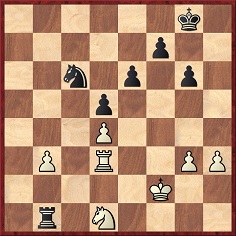
White to move
What did Capablanca think of his opponent’s 44 Ke2? In his match book (page 24) he writes, ‘Not a mistake, but played deliberately. White had no way to protect his QKtP’. Similarly, in A Primer of Chess he commented, ‘There is no way for White to save his QKtP. White’s next move is not, therefore, a blunder’.
However, in notes reproduced in Homenaje a Capablanca the Cuban writes, ‘White’s next move is a blunder which facilitates Black’s task’.
(921)
An addition on page 266 of Kings, Commoners and Knaves:
In Mein Wettkampf mit Capablanca Lasker gave 44 Ke2 a question mark, without further elucidation.
Richard Forster comments:
‘The point is that after 44 Ke1 Na5 45 Kd2 Rxb3 (45...Nxb3? 46 Kc2) 46 Rxb3 Nxb3+, the rooks are exchanged and White has better drawing chances than in the game, where Black retains his active rook.’
Carl-Eric Erlandsson (Lund, Sweden) sends the following list from Ståhlberg’s I kamp med världseliten (Örebro, 1958), page 70:
‘My hardest opponents: Alekhine and Botvinnik; my most interesting opponent: Lasker; my most pleasant opponent: Keres; the greatest master: Alekhine; the greatest talent: Capablanca; the greatest strategist: Botvinnik; the greatest tactician: Lasker; the foremost endgame practitioner: Smyslov; the most imaginative master: Bronstein.’
The December 1901 BCM (pages 492-493) quotes from Lasker’s Manchester Evening News column of 20 November:
‘[Janowsky] is one of the great chess matadors ... He is a typical Parisian in style and appearance. He has lively eyes, black moustache and hair, and manages his conversation in English wonderfully well in spite of the meagreness of his stock of perhaps less than 120 words ...’
Some ten years later the same magazine (February 1911, page 60) quoted from the Berliner Zeitung a rather more penetrating analysis by the world champion:
‘This, in my judgement, is the Janowsky problem. His brain is stored with tactical ideas in myriad forms. He has them arranged and possesses the power to mobilize them and bring them to bear on any given position. If success is to be reached by any combination lying fathoms deep in the position, his tireless energy and creative fancy will find it and fashion it. But has he the presentiment necessary to detect the gradual grouping of the factors of such a position? Has he more than the energetic and teeming brain of the tactician; is he a strategist in addition? This last demands intellectual qualities rarely found in prodigal temperaments ... If the strategist preserve his intellectual energies, he invariably wins against the tactician.’
(1109)
On the subject of Emanuel Lasker and money, C.N. 1189 gave two quotes, the first of them from a letter he contributed to page 260 of the June 1907 issue of the BCM:
‘The reviewer of the book [Struggle] comments on the lack of success of chess masters in practical life. He argues that the masters of strategy should be able to achieve success in business if my contention – that all contests follow the same strategic laws – is correct. I think that men like Zukertort and Steinitz would have been great in any enterprise if they would have ardently devoted themselves to it. They did achieve their purpose. Probably they never tried to gain wealth, or, at least, they did not try hard, and chessplayers – this reproach cannot be withheld – were content to buy their success as cheaply as they could. A starving man can, of course, not make a fair bargain. They were the victims of circumstance – like Mozart and Beethoven. Does it denote any great business qualities in Paderewski that he makes a hundred times more money than some of his predecessors no less distinguished in their day?’
The second Lasker quote comes from Der Schachwart No. 3, cited in the July 1913 BCM, page 294:
‘If Idealism means the thrusting of mediocrity into the foreground to the disparagement of perfection, and the failure to display any enthusiasm for the idea of chess-play, then Das Wochenschach bears away the palm for Idealism. If, on the other hand, Materialism implies the striving to raise the social position of the chess master, to extend a true understanding of the deep mentality of chess-play, to get the master treated with some recognition of his rights as a man, instead of being neglected in poverty like Morphy [sic], Harrwitz, Neumann, Steinitz, Pillsbury – then I am a Materialist.’
C.N. 1197 gave a selection of quotes from William Winter’s posthumous memoirs, which were published in CHESS between 29 October 1962 and 28 March 1963. They included the following:
‘[Emanuel Lasker] before any tournament made a careful study of the weaknesses of each of his opponents, both as regards style of play and temperament. It is entirely legitimate, and can prove very useful until one comes up against an opponent like Capablanca who had no weaknesses of any kind.’
From our feature article on William Winter:
Regarding the original edition of Chess for Match Players, C.N. 2663 noted that Emanuel Lasker praised it highly in a review published in a Russian journal and quoted extensively on pages 194-195 of CHESS, 14 February 1938. To cite just one passage:
‘In the case of the difficult science of the openings on which attention has been focussed for decades, any master, even a world champion, might be proud of such an achievement as this. Neither Euwe nor Alekhine nor Capablanca nor I can boast of such a splendid achievement in this sphere. There is one man in the USSR who would be equal to this task, and that is Botvinnik, but the time has not yet come for him to share his thoughts with the world.’
Can any reader identify the Russian publication?
Addition on 24 December 2024:
From Lasker’s column in the New York Evening Post, 26 June 1907, page 5:
‘... Chess players are under a moral obligation to support a professional chessplayer who conforms to the general demands of society, and who comes up to a certain standard of usefulness.
Chess entertains and teaches. It takes us away from the contemplation of the hard facts of life, soothes the combative spirit aroused in us by the jolts that we receive in the struggle for existence and progress, and the disappointments to which we are subject in the non-realization of our hopes. From the imaginary and imaginative battles that we fight on the chess board the bitterness engendered by a sentiment of unequal opportunity is absent.
Absolute justice reigns there. Privilege in any shape or form is impossible on the chess board. Thus the game is a draught of consolation and of encouragement, whether we win or lose.
Chess stirs our aesthetic faculties because it is so intelligible that its beauties are an open book even to the tyro. A brilliant stroke arouses the enthusiasm of the chessplayer of any class in the same way that a symphony or rhapsody acts on our sense of music harmony.
This is the reason that a game of chess, if conducted with mastery, commands the attention of spectators for hours.
It is true that mediocre chess tires quickly. But so does mediocre music or acting.
Chess is a great teacher, because profound strategic principles are expressed in it to him who can read its language. The opportunity which chess affords to test frequently the many principles that have been discovered is of immense utility.
In any other contest the results of our researches are rarely so evident as on the chess board where “check mate” leaves no room for argument.
It is for the professional chessplayer to entertain by masterly play that compels attention; to cause feelings of delight by exhibiting the nature of true brilliancy, to elevate the standard of taste by exposing the faults and defects of cheap and sham brilliancy; to be a mouthpiece for teaching the language of chess and translate the inward meaning of its manoeuvres.
If the chess master does his duty it is incumbent on the chess world to support him, to silence those who malign him though they are always ready to enjoy and profit by the fruits of his labor, and to give him his proper share of the honors and rewards by which society measures success.’
Regarding a proposal for a new notation from Emanuel Lasker, see C.N. 1221 (pages 125-126 of Chess Explorations). The report had appeared on page 18 of the January 1901 BCM.
C.N. 403 asked for the origin/source of the well-known Lasker quote, ‘I have known many chessplayers, but only one chess genius, Capablanca’.
From page 148 of Ajedrez en Cuba by Carlos Palacio (Havana, 1960):
‘I am proud to be in the Club which perpetuates the memory of the great Capablanca. All chess enthusiasts loved and admired the master; but nobody described him more magnificently than Dr Lasker, who said to me in Berlin in 1922 or 1923: “I have known other great masters but only one genius: Capablanca.”
Gregor Piatigorsky (world famous cellist) April 1951.’
(1362)
From page 155 of the February 1907 issue of the Chess Amateur:
‘Emanuel Lasker, who now particularly is attracting world-wide attention, was born in Brussels in 1869, and was first heard of as a public player in 1889, having, in that year, carried off first prizes in a tournament held at the Kaiserhoff, in Berlin, without the loss of a game.’
No special effort is required to find four or five mistakes there.
(1407)
‘I well remember the advice Dr Lasker gave me after the tournament of Mährisch-Ostrau in 1923: “You will never attain a balanced positional judgement until you start to adopt the Ruy López habitually.”’
S. Tartakower, CHESS, December 1948, page 64.
(1409)
Page 471 of the December 1897 BCM quotes from a speech made by Steinitz at New York on 16 October of that year. How we should love to have been there.
‘“Uneasy lies the head that wears a crown”, says the sublime analyst of human nature and character. Mine was not a golden crown, but it was not worthless. Perhaps it might be no more properly compared with a crown of roses, interwoven with all their natural thorns which made my rest uneasy for a greater part of the time. Whatever it was it is now transferred to Mr Lasker, and I can only express a hope that the crown will now be made in reality a golden and yet an easy one, for him or any one else to wear, who may hereafter honourably gain the title of champion. Taking this opportunity, I desire to thank Mr Lasker for having started a similar testimonial in England, and considering that I have ceased to be connected with chess in the old country for 15 years, the generosity of all other English subscribers cannot be too highly commended.
(1413)
For a more extensive excerpt, see Steinitz Quotes.
A noteworthy comment by Janowsky appears on page 71 of the April 1921 American Chess Bulletin. Annotating the fifth game in the 1921 world championship match, he writes after 1 d4 d5 2 Nf3 Nf6 3 c4 e6:
‘Dr Lasker, in his chess magazine, made the following remark on one of my match games with Frank Marshall: “Why should one develop the knight at d7, blocking his bishop, while that knight can be developed at c6?” I quite agree with him. Strange to say, all the great masters in their older days play against their own theory. They evidently miss the power of conviction which is the characteristic of youth.’
What passage by Lasker did Janowsky have in mind?
(1429)
From Louis Blair (Pittsburgh, PA, USA):
‘The information on pages 1-3 of Edward Lasker’s book Chess Secrets does not seem to agree with what Hannak says on pages 124-126 of his biography of Emanuel Lasker. How could they have met in 1907 in Germany if Emanuel was in the United States from 1904 to 1908?’
It is clear from various contemporary sources, as well as the third Em. Lasker volume published by the Chess Player, that the world champion did not return to Germany until the spring of 1908. It therefore seems that ‘1907’ in Chess Secrets was an error for 1908 – an error, moreover, that Edward Lasker repeated on page 119 of issue 3 of Lasker & His Contemporaries (letter dated 8 February 1973).
(1641)
Most readers will be familiar with the Reinfeld/Fine book Dr Lasker’s Chess Career, Part I: 1889-1914 (London and New York, 1935), reprinted in 1965 by Dover under the title Lasker’s Greatest Chess Games 1889-1914. Part II was never published, but a manuscript may still exist. As quoted in C.N. 1500, Reinfeld wrote in the October 1948 CHESS (page 24):
‘Mr Finck’s letter is typical of a number of requests I have had for a Dr Lasker’s Chess Career, Part II. I have had such a manuscript in readiness for a number of years, but I do not know of any publishing firm which has a burning interest in the project. To my deep regret, therefore, the manuscript continues to remain unpublished. If any of your readers know of any way to make publication possible, I shall be deeply grateful.’
Reinfeld did not make it clear whether Fine also collaborated on Part II.
(1500)
As pointed out in C.N. 1572, Fine referred to his participation in Part I on page 80 of his book Lessons from My Games.
From the New Orleans Times-Democrat of 28 May 1905 comes the subjoined game, ‘one of several individual games played by Dr Lasker during his recent visit to the New Orleans Chess, Checkers and Whist Club’. The opening is played in original style and the sacrificial attack is fascinating:
Martin D. McGrath – Emanuel Lasker
New Orleans, 19 May 1905
Ruy López
1 e4 e5 2 Nf3 Nc6 3 Bb5 a6 4 Ba4 Nf6 5 O-O d6 6 Nc3 b5 7 Bb3 Bg4 8 h3 Bh5 9 d3 Qd7 10 Be3 g5 11 Nd5 Qd8 12 Bxg5 Bg7 13 g4 Bg6 14 Nh4 Nd4 15 Nf5 Bxf5 16 exf5 h5 17 c3 Nxb3 18 axb3 hxg4 19 hxg4 Kd7 20 Kg2
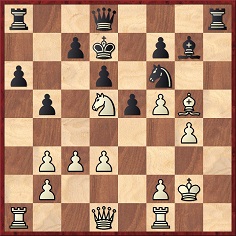
20... Nxd5 21 Bxd8 Nf4+ 22 Kg1 Nh3+ 23 Kg2 Nf4+ 24 Kg1 Raxd8 25 f3 Rh3 26 Kf2 Rh2+ 27 Ke1 Bf6 28 Qb1 Rdh8 29 Rxa6 Rh1 30 White resigns.
The Times-Democrat has the loser’s detailed notes.
(1673)
The problem below, a joint production by Keidanz and Emanuel Lasker, was given in C.N. 1719:
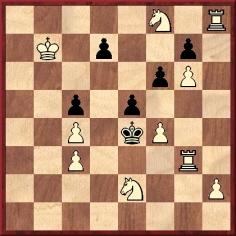
Mate in four
The composition was published on page 214 of the October 1906 American Chess Bulletin, with the solution presented on pages 17-20 of the January 1907 number. It was the subject of a prize competition, and the winner, who solved it in 25 minutes, was Murray Marble (1885-1919).
C.N. 1781 pointed out that the solution was 1 Ne6 and that even after 1...dxe6 the solver faces a hard three-mover. As reported in C.N. 1825, the solution then continues 2 f5. See too C.N. 5364.
On page 229 of the October 1911 American Chess Bulletin, Emanuel Lasker responded to a charge that he had written an article in bitterness:
‘... Possibly in writing the article, I thought of Morphy, Mackenzie, Steinitz and Pillsbury. The reflection upon their life is not an agreeable one to me. They were pathfinders, yet their lot was a hard one. They got flattering notice, but received no practical support. And their talents were never sufficiently utilized. A good use might have been made of these men as teachers. Morphy or Steinitz, explaining their theory as to the mode of thinking appropriately, would have been worthy the attention of philosophers. They remained silent, because they were never asked. The curiosity of the men around them was aroused by the question how strong they were and how many games they might be able to play simultaneously or blindfolded, and how they could perform this tour de force or that one. Their real excellence, which was the result their having discovered principles of wide application by no means restricted to chess, was probably not even guessed. At any rate, the chess world did not make the effort to make the two great thinkers speak, and the highly beneficial work which they naturally would have performed if they had been coaxed into action remained undone. The splendid soil of their inner consciousness was allowed to lie uncultivated and to yield far from enough fruit for others.
Perhaps the state of chess as it is at present in England and the United States is a consequence of this omission. But whether so or not, the blunder should not be repeated. The chess world, richer and larger now than ever, is under an obligation which it should fulfil now unhesitatingly. The important chess clubs and chess associations should request Marshall and other masters to teach chess. They should cooperate with their masters to devise and to evolve a practical mode of teaching, and they should give a generous reward for the work. In this manner, after a short period of trying, a durable and beneficial institution would be established.’
(1898)
Some chess writers contend that Tsar Nicholas II awarded the title of Grandmaster to Lasker, Capablanca, Alekhine, Marshall and Tarrasch, the five finalists at St Petersburg, 1914. Does evidence exist to corroborate this?
(1998)
See Chess Grandmasters.
Hanon Russell (Milford, CT, USA) has a collection of thousands of chess documents representing all periods. Its importance for serious historical research is immeasurable, but here we publish the following, with his kind permission:
Open letter from Emanuel Lasker, April/May 1927 (item 581):
On Capablanca: ‘I think not badly of him; he has great faults, as I shall presently explain, and also great virtues, for instance, his word is reliable even where others would falter; but he insists on misunderstanding my motives ...
[Capablanca] looks upon argument as a personal affair. He uses invective, sometimes direct, sometimes covered by a thin veil of inference. He assumes that his opponents, and possibly men generally, are actuated by highly selfish motives. At least, that has been my invariable experience with him for 16 years.
His great fault, from a chessic point of view, is lack of self-discernment. He is, without doubt, a chess master of exceeding merit and rightly belongs in the series of chess champions which starts with Philidor. Yet he is fearsome as if he mistrusted his own powers.
And that has grown on him and threatens to clog the wheels of his own evolution.
... Capablanca is passionately angered by every kind of opposition. That is a great danger to him, too. The genius of chess has been kind and generous to Capablanca, but if he insists on his present ways he will stand still while others advance and in the end cut only a poor figure in the gallery of champions.’
(1999)
From Brad Thomson (Ottawa, Canada):
‘While preparing an article (published on pages 34-39 of the June 1994 En Passant) on the 100th anniversary of the Lasker v Steinitz match, which concluded in Montreal, I noticed that the three sources I was using did not agree at one point. In game 17, Steinitz’s last victory, the following position arose:
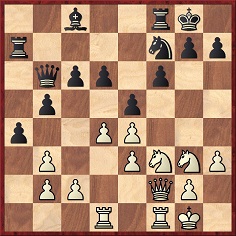
C. Devidé’s book on Steinitz gives Lasker playing 21 Ne1 c5 22 Qd2 Be6 23 b4 Qc7, and now 24 d5, at which point all sources agree again. But the move order given in The World Chess Championship: Steinitz to Alekhine by P. Morán and in the Weltgeschichte volume on Lasker is 21 b4 Qc7 22 Ne1 c5 23 Qd2 Be6 and now 24 d5, whereupon the transposition is complete.’
We add that the logical latter version is supported by such contemporary sources as the Deutsche Schachzeitung (July 1894, page 202), the BCM (July 1894, page 300) and the Chess Monthly (July 1894, pages 335-336).
(2071)
Colin Crouch (Harrow Weald, England) points out that on page 50 of The World’s Great Chess Games Reuben Fine said that Emanuel Lasker wrote a book on unemployment. Mr Crouch has been unable to find such a work in any bibliography, although there is a 1911 book, published by Macmillan, London, entitled Unemployment: a social study, by B.S. Rowntree and B. Lasker. Bruno Lasker subsequently wrote extensively about East Asian economies, but it is not known whether he was related to Emanuel. We add that Emanuel Lasker did write about, inter alia, unemployment in The Community of the Future (New York, 1940).
Emanuel Lasker’s brother Berthold (1860-1928) was a strong chessplayer and problemist, and the two were apparently distant relatives of Edward Lasker. C.N. 10 quoted the latter’s claim to this effect, which appeared on page 119 of issue 3 of Lasker & His Contemporaries, published in 1980. On page 184 of the March 1974 Chess Life & Review Edward Lasker wrote: ‘I did not discover that we were actually related until he [Emanuel Lasker] told me shortly before his death that someone had shown him a Lasker family tree on one of whose branches I was dangling’.
Another Lasker was Alfons. Page 143 of the May 1910 Deutsche Schachzeitung gave this game between him and Eduard (i.e. Edward):
A. Lasker – E. Lasker (simultaneous)
Breslau, October 1909
Giuoco Piano
1 e4 e5 2 Nf3 Nc6 3 Bc4 Nf6 4 d3 Bc5 5 Bg5 d6 6 h3 Be6 7 Bb5 a6 8 Bxc6+ bxc6 9 d4 exd4 10 Nxd4 Bxd4 11 Qxd4 c5 12 Qc3 Nxe4 13 Qxg7 Qxg5 14 Qxh8+ Kd7 15 Qxa8 Qc1+ 16 Ke2 Qxc2+ 17 Ke3 Qxf2+ 18 Kd3 c4+ and mate next move.
According to page 48 of Fred Reinfeld’s Chess: win in 20 moves or less, a reprint of his 1948 book Relax with Chess, the two players were brothers. Giving this game on page 15 of 500 Italian Miniatures, Bill Wall affirmed that Black was Emanuel Lasker.
A fifth Lasker (forename unknown) had a game-score published on page 53 of the February 1870 Deutsche Schachzeitung. It was one of three blindfold games played simultaneously by Alexander Alexander in Hamburg on 18 August 1869.
(2106)
A footnote on page 233 of Kings, Commoners and Knaves:
A sixth Lasker, Hermann, a cousin of Edward, was mentioned on page 204 of Deutsches Wochenschach, 13 June 1909.
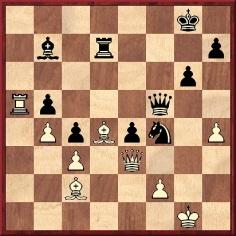
F.J. Lee-Em. Lasker, London, 4 July 1899
Play continued: 37...Rxd4 38 cxd4 Qg4+ 39 Kf1 Qg2+ 40 Ke1 Qg1+ 41 Kd2 c3+ 42 Qxc3 Qxf2+ 43 Kd1 e3 44 Bb3+ Kg7 45 d5+ Kh6 46 Qe1 Bc8 47 White resigns. After the game Lasker stated that he had seen 46...Bc8 at move 37 (Wiener Schachzeitung, October 1899, page 163). The magazine gives as an alternative line 46...e2+ 47 Kd2 Qd4+ 48 Kc2 Qe4+ 49 Kc3 Qe3+ 50 Kc2 Ng2, and also reports that from the diagram Tarrasch offered another possibility: 37...Qg4+ 38 Kf1 Qg2+ 39 Ke1 Qg1+ 40 Kd2 Ng2 41 Qe2 e3+ 42 fxe3 Bf3.
(2140)
In a book review published on the Internet (at the Campbell Report/Correspondence Chess site) John Hilbert has justifiably panned Emanuel Lasker Volume 1 by Egon Varnusz (Budapest, 1998) for chronic slovenliness and plagiarism. A dreadful book indeed, notwithstanding what magazines/stockists such as the BCM and CHESS have chosen to tell their readers/customers. We note, with a shiver, that in addition to a second Lasker volume Mr Varnusz has collections of both Capablanca and Alekhine’s games in the pipeline.
(2218)
In a footnote on page 286 of A Chess Omnibus we added:
A second Lasker book duly appeared, followed by two sloppy volumes on Capablanca.
One curious way in which history repeats itself is in the practice whereby the quality of world championship match play is run down by contemporary critics but aggrandized by posterity. For example, page 5 of the Chess Amateur, October 1908 quoted from the Daily Mail:
‘The match in progress between Dr E. Lasker and Dr S. Tarrasch for the chess championship of the world creates in the minds of many chessplayers a feeling of doubt whether the pre-eminence suggested by such a title as “champion” ought justly to be the award of either player in this contest.
In the eyes of expert analysts only a small proportion of the nine games played up to the present moment can be called first-class chess – except by the players themselves.
The monotonous repetition of the Ruy López Opening, varied only by the equally tiresome and uninteresting French Defence, exhibits a want of enterprise disappointing to those who regard chess as a game par excellence of resource, imagination, and self-reliance; while the blunders committed on both sides in several of the games are blemishes which render them worse than useless as studies or models.’
In contrast, here is a remark from page 3 of the 1951 world championship book by W. Winter and R.G. Wade:
‘… the play between Lasker and Tarrasch has generally been considered the best seen in any match for the world championship.’
To conclude here with a brief non-chess matter, various quotation books attribute the observation ‘History repeats itself; historians repeat one another’ to Philip Guedalla, in his 1920 work Supers and Supermen. We note, however, that the poet Rupert Brooke (1887-1915) gave the epigram as his own invention in a letter to Geoffrey Keynes dated 4 June 1906.
(2372)
Because Nottingham, 1936 was Emanuel Lasker’s last tournament it is sometimes assumed that thereafter he retired from top-level play. In a letter published on page 194 of the May 1969 Chess Life Joseph Platz commented on Lasker’s absence from AVRO, 1938:
‘It is useless to speculate how the man who was among the top players of the world for 50 years would have fared at the AVRO tournament. Had he been invited, he would have played. Lasker and I were good personal friends and he expressed bitter disappointment that he was not invited.’
(2430)
From page 272 of Chess Explorations:
On page 242 of the June 1979 CHESS we published Emanuel Lasker v Powell, simultaneous exhibition, Liverpool, 1895, a game which saw play similar to Botvinnik’s against Capablanca [AVRO, 1938]. Lasker too offered the sacrifice Bb2-a3 with the aim of diverting the enemy queen, which was blocking a white passed pawn at e6.
The Australian magazine Chess World, July 1961 (page 158) reprinted from The Hindu an account by Leonard Barden of his interview with Fischer at Leipzig the previous autumn:
‘… I was astonished to discover how unorthodox his views were about the great chess masters of the past.
Lasker, considered by many the greatest chessplayer who ever lived, was dismissed by Bobby as “a weak player”. He told me he had played through the games of Alekhine but they were “nothing too interesting … he’d make some manoeuvres and then the other guy would fall for some combination”.
Among the world champions, Bobby had the greatest respect for Capablanca, whose games he had studied in some detail; but he’d also considered Chigorin, the man admired by the Russians, to be very interesting.’
A number of previous C.N. items have concerned Fischer’s article ‘The Ten Greatest Masters in History’ in the US magazine Chessworld, January-February 1964 (pages 56-61).
(2489)
See Fischer’s Views on Chess Masters.
Christian Sánchez (Rosario, Argentina) points out that the ‘walling in’ motif was seen in Kasparyan’s only pawn study, published in Shakhmaty v SSSR, 1937. It is too well known for repetition here; see, for example, page 37 of Kasparyan’s book Finales artísticos (Barcelona, 1976) and pages 34-35 of The Complete Studies of Genrikh Kasparyan by A. John Roycroft (Milford, 1997). The latter source also gives a superb study by Grigoriev from Shakhmatny listok, 1929.
Mr Sánchez adds that on page 63 of 2.500 finales (Buenos Aires, 1963) Kasparyan offered another study with the same motif.

A. Selesniev
White to move and draw.
This was published on page 44 of the January-March 1920 number of Tidskrift för Schack. The solution appeared in the November-December 1920 issue (page 105):
1 b6 c6 2 f4 f6 3 Ka6 c4 4 a5 c3 Stalemate.
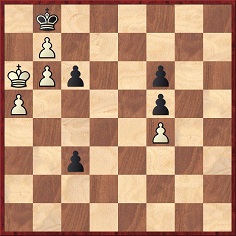
Black cannot avoid this with 4…c5 because of 5 Kb5 c3 6 Kc6 c2 7 a6 c1(Q) 8 a7 mate.

The Selesniev composition was printed a year after he enjoyed the remarkable accolade of having a monograph on his studies published by the reigning world champion. 35 Endspielstudien von Schachmeister A. Selesnieff by Emanuel Lasker came out in Berlin in 1919. It was, however, only a 20-page booklet.
(2603)
A line given by Emanuel Lasker on pages 17-20 of his book Common Sense in Chess is 1 e4 e5 2 Nf3 Nc6 3 Bb5 Nf6 4 O-O Nxe4 5 Re1 Nd6 6 Nc3 Nxb5 7 Nxe5 Be7 8 Nd5 O-O.
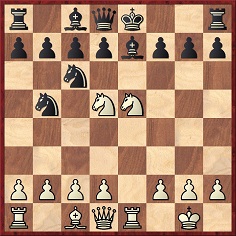
On page 192 of the July 1953 CHESS Norman Whitaker pointed out that instead of castling Black could remain a piece ahead by playing 8…Nbd4.
(2615)
Olaf Wolna (Hamburg, Germany) points out that on page 14 of the 1925 German edition (Gesunder Menschenverstand im Schach), Lasker himself remarked that with 8 Nd5 he had committed an oversight, because of 8…Nbd4. He therefore recommended 8 Nxb5 Nxe5 9 Rxe5 d6 ‘with a good game for Black’.
Concerning Whitaker’s observation on page 192 of the July 1953 CHESS, we are surprised by the magazine’s afterword: ‘Reinfeld’s revision of this book (1946) naturally omits this glaring blunder.’ In our copy, the ‘glaring blunder’ is still there (page 11).
(2631)
Now we have found that this error was already known in the nineteenth century. From page 246 of the December 1899 American Chess Magazine:
‘Attention is called by J. Biggs, of Bonham, Texas, to the following variation of the Ruy López, given both in Lasker’s Book and Freeborough’s Openings: 1 e4 e5 2 Nf3 Nc6 3 Bb5 Nf6 4 O-O Nxe4 5 Re1 Nd6 6 Nxe5 Be7 7 Nc3 Nxb5 8 Nd5 O-O. Mr Biggs played this line recently, but his opponent, instead of castling on the eighth move, played 8…Nbd4, with the result that Mr Biggs found himself with a clear piece down and no compensating attack. In bewilderment he applied for information. The move of 8 Nd5 by White is unsound and merely constitutes an oversight by the authorities named.’
(3208)
From the Preface (page vi) of How to Play Better Chess by Fred Reinfeld (New York, 1948):
‘But the present type of book – one intended for players who are beyond the beginning stage – is much more difficult to write. How does one select the subject matter?! What A needs to know is familiar to B and of no interest to C.
Looking at earlier books is of no great help. Capablanca’s Chess Fundamentals does not indicate any awareness of the problems involved. He does not bother, for example, to explain the moves of the pieces, the nature of checkmate, the details of the chess notation! Yet his book devotes three pages to an ending which has occurred only once, to my knowledge, in the whole history of master play. Again, eight pages are spent on the mate with bishop and knight and the win with queen against rook – although most of us play chess for a whole lifetime without once encountering these problems!
In Lasker’s Manual of Chess we find the same lack of selectivity. The book is long, and demands considerable reading time. It contains pages and pages of abstruse philosophical thinking, which is interesting but of no use to a beginner. There are many composed endings which are artistic but of no practical value; yet Lasker gives slight attention to the endings that actually occur in real games; and he (intentionally!) skimps the openings rather badly.’
(2644)
Coles Publishing Company pirated editions of books by Capablanca, Marshall, Reinfeld, Rice and Love (see A Publishing Scandal).
Postings at the Chess Café’s Bulletin Board in 2001 (most notably by Paul Kollar) pointed out many passages published under Larry Evans’ name which were identical or similar to what had appeared in books by Lasker, Réti, Reinfeld and Fine.
(2971)
Some time ago we were struck by the similarity between the signatures of Emanuel and Edward Lasker in our inscribed copies of The Community of the Future (1940) and The Game of Chess (1972):
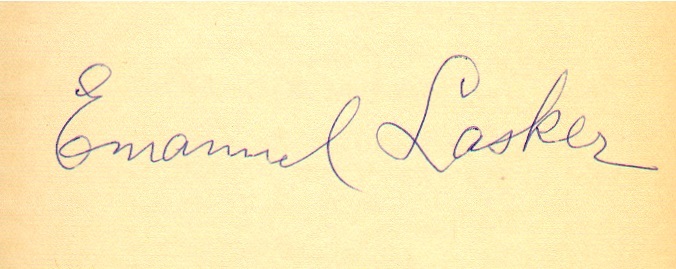

Now we see that Edward Lasker made the same point on page 131 of Chess Life, May 1961:
‘Looking at the signatures of the players with whom I was honored to compete in 1924 [i.e. in the New York tournament] I was astonished to note for the first time the extraordinary similarity between Emanuel Lasker’s signature and my own, and – also for the first time – the perhaps not altogether silly question occurred to me whether, lacking other evidence, this might have served as an acceptable argument for his often expressed opinion that our families were probably related, although we never could find out how. It was not until a few weeks before his death that he told me he had seen a definite proof. A young man from Australia had visited him and shown him a Lasker “family tree”, and there I was, dangling from one of the branches.’
As recorded in C.N. 2106 [see above], Edward Lasker used the same arboreal metaphor on page 184 of Chess Life & Review, March 1974.
(2997)
The full text of C.N. 10 (mentioned above and also given on page 173 of Chess Explorations):
Was Edward Lasker related to Emanuel Lasker? The answer is yes, according to Lasker & His Contemporaries No. 3, which quotes (page 119) a letter from Edward L. dated 8 February 1973 to the magazine’s editor, Robert B. Long:
‘The genealogy, incidentally, indicates that the common forbear of Emanuel and myself was the son Samuel Lasker of the Rabbi of the Polish village Lask, whose name was originally Meier Hindels. However, later the additional name Lasker was given to him to distinguish him from another Meier Hindels also living in Lask. Samuel Lasker moved to another Polish village, Kepno, in 1769, after it had been captured by Frederick the Great and became a German township, and I am the last descendant of his who was born there. He was the greatgrandfather of my greatgrandfather. His first-born son left Kepmen [sic – Kempen] and moved to Jarotschin, another Polish village, and Emanuel Lasker was that one’s greatgrandson.’
Hassan Roger Sadeghi (Lausanne, Switzerland) refers to the spelling of Lasker’s name (‘Emmanuel’) in the signature shown in a picture from the C.N. gallery:
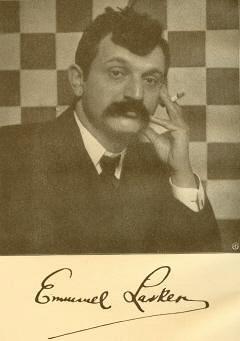
Is it possible to draw up a list of other instances of that non-standard spelling in Lasker’s own hand?
(8643)
From page 400 of El Ajedrez en la Argentina by José Pérez Mendoza:
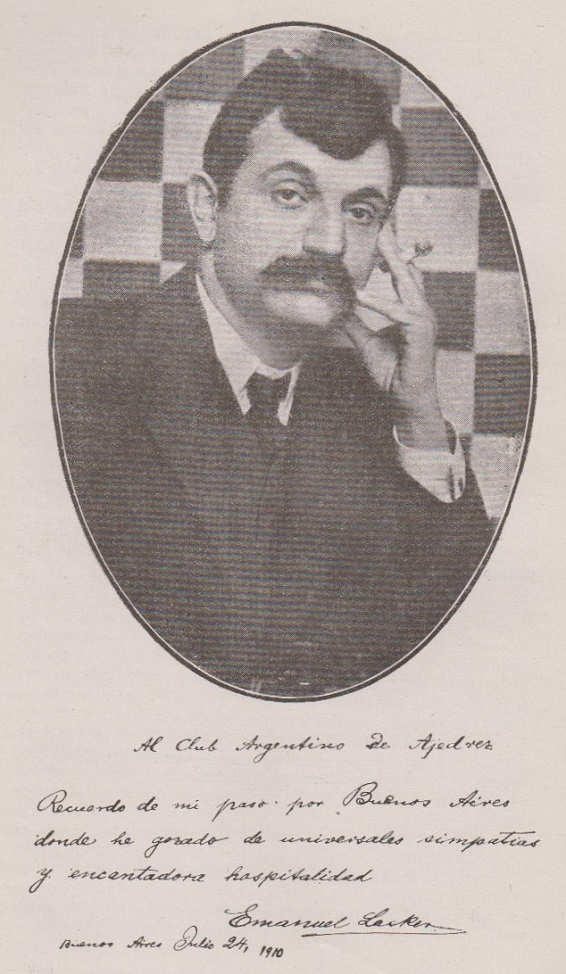
(10749)
Page 181 of 2010 Chess Oddities by A. Dunne (Davenport, 2003) affirms:
‘The top selling chess book of all time is Lasker’s Manual of Chess.’
That is the entire item, the reader being offered not one word of corroboration or other information. So why would such an improbable claim be made? All we can say is that on page 198 of the 1984 edition of The Book of Chess Lists A. Soltis asserted that the Lasker book was the best-selling chess title of Dover Publications, Inc.
(3107)
From the report of an interview on pages 215-216 of the American Chess Magazine, November 1898:
‘Janowsky spoke freely of his colleagues among the chess masters of the world, not hesitating to place himself in the niche he believed he fitted. He stated he classed Harry N. Pillsbury, the American champion, and Emanuel Lasker, the world’s champion, above Dr Tarrasch, and thinks that he and the champion are about equal in strength just below the other two. He thinks Lasker is a sounder player than Pillsbury, but Pillsbury possesses greater powers of combination than the world’s champion. Despite his modest admission that he considers the others above him, he said he did not fear any of them, and would not be averse to matches with them.’
(3173)
We are grateful to HarpWeek LLC for permission to reproduce a group photograph which appeared in Harper’s Weekly at the time of the New York, 1893 tournament:
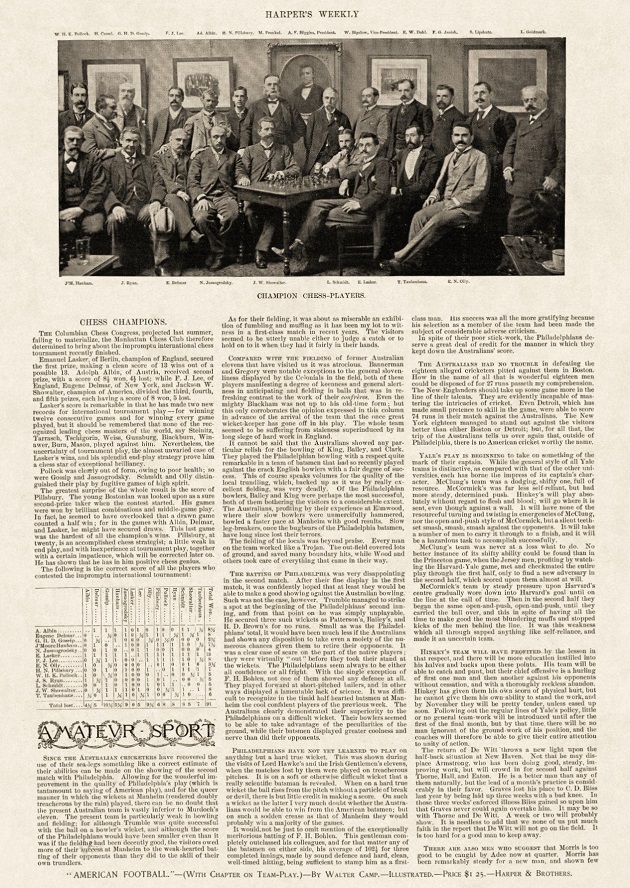
From left to right in the back row: W.H.K. Pollock, H. Cassel, G.H.D. Gossip, F.J. Lee, A. Albin, H.N. Pillsbury, M. Frankel, A.F. Higgins, W.Bigelow, E.W. Dahl, F.G. Janish, S. Lipschütz and L. Goldmark.
Front row: J.M. Hanham, J. Ryan, E. Delmar, N. Jasnogrodsky, J.W. Showalter, L. Schmidt, Em. Lasker, J. Taubenhaus and E.N. Olly.
(3240)
From page 227 of The Great Chess Masters and Their Games by Fred Reinfeld (New York, 1960):
‘So Lasker dodged Rubinstein and Capablanca for years, and Alekhine acquitted himself shabbily in never allowing Capablanca a return match. Alekhine merely waited over 20 years, until Capablanca’s skill deteriorated below the level required for a match.”
It may be wondered which period of ‘over 20 years’ Reinfeld had in mind.
(3271)
As regards St Petersburg, 1914, the financial conditions granted to Lasker were reported by B.E. Maliutin on pages x-xi of Tarrasch’s tournament book. Moreover, on pages 154-155 Tarrasch made his well-known remark that Lasker had received the colossal sum of more than 4,000 roubles for his participation but that this was not too high in view of the quality of his play:
‘Lasker hat für seine Mitwirkung auf dem Turnier vom Komitee eine Riesensumme erhalten, über 4000 Rubel. Ich finde das nicht zu hoch. Wenn man solche Partien spielt!’
Page 221 of the English edition (Yorklyn, 1993) incorrectly called the money ‘a travelling sum’, the translator having confused Riesen (colossal) with Reise (journey). By a circuitous, tentative journey of our own we have calculated that 4,000 roubles then would be roughly $41,500 now.
Having so far found no pre-1914 instances of appearance fees in tournament play, we conclude here with a characteristically dire nineteenth-century space-filler (published in the Kentucky State Journal and reproduced on page 104 of the Columbia Chess Chronicle, 15 November 1889):
‘While most of the professionals advocate the “modern school” they all believe in the more-fee system.’
(3279)
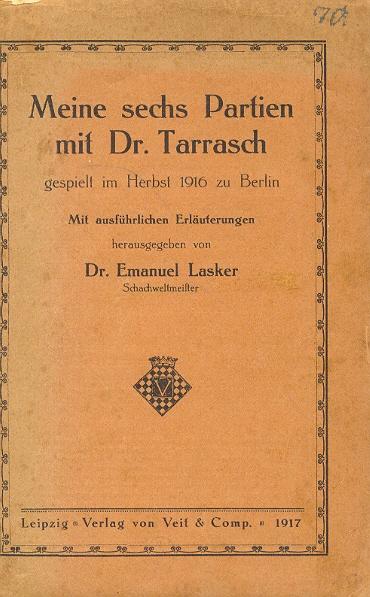
Contrary to claims by Koltanowski, the 1916 match between Lasker and Tarrasch was not for the world championship title. See too, on this topic, the various falsehoods of Eric Schiller.
A further illustration of the ‘once’ school of narrative comes from page 24 of Curious Chess Facts by I. Chernev (New York, 1937):
‘Steinitz was once arrested as a spy. Police authorities assumed that the moves made by Steinitz in playing his correspondence games with Chigorin were part of a code by means of which important war secrets could be communicated.’
The identical paragraph appeared on page 31 of Chernev’s Wonders and Curiosities of Chess (New York, 1974), whereas on page 89 of The Fireside Book of Chess by I. Chernev and F. Reinfeld (New York, 1949) the wording was slightly different:
‘Steinitz was once misjudged to be a spy. Police authorities assumed that the moves made by him in playing his correspondence games with Chigorin were part of a code by means of which important war secrets could be transmitted.’
We have yet to find any such incident mentioned in contemporary reports on the two-game cable match in 1890-91 between Steinitz and Chigorin, about which, incidentally, the then world champion wrote on page 107 of the April 1891 International Chess Magazine:
‘Never before in the history of our pastime has a chess contest created such widespread and literally universal interest during its progress as the one just concluded between myself and Mr Chigorin.’
We would, though, draw attention to the following passage by Walter Penn Shipley in the Philadelphia Inquirer, as quoted on page 62 of the American Chess Bulletin, March 1918:
‘We note in the daily papers a curious break in the affairs of Lorenz Hansen, a Dane, but who has been in this country for many years and is a naturalized citizen. Lorenz Hansen has been for many years an enthusiastic chessplayer and an able problem composer. We have published many of his problems in this column, and some of exceptional merit. Lorenz Hansen was recently arrested on a technical charge, the Federal authorities believing that he had a secret code and was communicating with someone at Grand Rapids, Mich. On further examination the secret code appears merely to have been a harmless correspondence game of chess, the moves, as usual, being sent by postal card. It is unnecessary to state that when the true state of affairs became known Mr Hansen was promptly released.
This adventure recalls one of the late William Steinitz. When he played his second match with Lasker at St Petersburg, before leaving this country Steinitz arranged an elaborate code whereby at slight expense he could cable the moves in his match to a syndicate of New York newspapers. Steinitz received a liberal compensation for his work. The old man had spent a great deal of time on perfecting his code, but unfortunately on arriving in St Petersburg the authorities promptly confiscated the code, stating that it was impossible to believe that it was merely for the purpose of cabling chess moves and in reality was to give secret information to parties in America. Being thus deprived of his code, he was unable to cable the moves of his match, and thereby lost the fruit of many months’ hard labor. At the termination of the match the code was returned to Steinitz by the Russian authorities, stating they had found it to be as represented, but then, of course, it was too late to be of any use to the world’s master. Steinitz’ breakdown was unquestionably partially due to his great disappointment in this matter.’
What truth there is in any of the above we have no idea, and for now we merely point out that the second match between Steinitz and Lasker was held in Moscow, not St Petersburg.
(3345)
A paragraph from page 468 of the December 1896 BCM:
‘The long-expected return match between Messrs Lasker and Steinitz, for the championship of the world, began at Moscow, on 7 November, having been delayed a few days owing to a political difficulty. Mr Steinitz had arranged to telegraph the games to America in cypher, which cryptogram, however, had to be submitted first to the censorship of the Russian government, and it took some time to convince the authorities that there was nothing nihilistic in the mysterious messages to be sent.’
(6699)
A Chess Omnibus had this footnote on page 308:
Another straightforward example of K. Whyld’s propensity for distortion and untruth is his assertion (Kingpin, Summer 1997, page 61) that on page 264 of Chess Explorations we ‘savaged’ Irving Chernev over a Lasker/Capablanca matter. The public record is 100% clear there too. As regards Whyld’s conduct regarding F.M. Edge (see pages 245-260 of A Chess Omnibus), at the Chess Café on 1 August 2000 we quoted a number of Frank Skoff’s apposite observations about Whyld, from a communication to C.N. dated 17 November 1989. Among the milder ones were: ‘He thinks calling people names (including myself) somehow is proof by itself’ and ‘It is astonishing how little value K.W. places on truth: He prefers its suppression at any cost. Why?’
Below is the complete passage on page 264 of Chess Explorations:
C.N. 564 quoted from pages 38-39 of Chernev’s Wonders and Curiosities of Chess:
‘A strange disaster occurred to Lasker and Capablanca in 1934. Alekhine beat Lasker at Zurich in 26 moves, sacrificing his queen to do so; Lilienthal beat Capablanca at Hastings in 26 moves, sacrificing his queen to do so!’
Alas, the Lilienthal-Capablanca game was played on 1 January 1935.
Would anyone other than K. Whyld suggest that the above passage ‘savaged’ Irving Chernev?
Pre-1934 predictions that Euwe had chances of becoming world champion are not too difficult to find. For example, the text below appeared on page 54 of the February 1931 BCM:
‘The popular Dutch champion is still under 30, so he should be a strong candidate for the world championship before long.’
On the other hand, we note the following on page 3 of the January 1936 BCM:
‘Euwe has fulfilled the prophecy of Dr Emanuel Lasker, when he was still a boyish student, that he would one day win the world title.’
When and where did Lasker make such a prediction about Euwe?
(3348)
See also Chess Predictions.
This text appeared on page 23 of the February 1931 American Chess Bulletin:

See too pages 105 and 261 of Chess Explorations and Retirement from Chess.
On page 171 of World Chessmasters in Battle Royal by I.A. Horowitz and H. Kmoch (New York, 1949) Kmoch wrote:
‘… although he had unequaled ability to master complications, [Lasker] did not care for prepared complications in the opening. During one of the many discussions I had with him he once accused Pillsbury of having started the deplorable custom of studying the openings too extensively. Lasker himself never paid much attention to the openings.’
(3378)
The following appeared on page 121 of the January 1905 issue of Lasker’s Chess Magazine:
‘The pending negotiations for the match between Mr Marshall and Mr Lasker for the title of chess champion of the world brings [sic] up for discussion a few questions which, it is believed, have never been fully considered by the chess public, and a study of them again forcibly demonstrates the necessity for some kind of organization by chess masters and the leading men of the chess world.’
(3387)
See FIDE: The Prehistory.
Birger Flindtholt (Randers, Denmark) writes:
‘I found an interesting drawing in a recently acquired book, Lehrbuch des Schachspiels by Emanuel Lasker (4. Auflage, 1927). Bound together with the book was a German-language newspaper cutting reporting on the third round of the Moscow, 1925 tournament and dated 13 November. The report included a sketch of Capablanca and Lasker seated at a chess board. The position on the board makes no sense.’
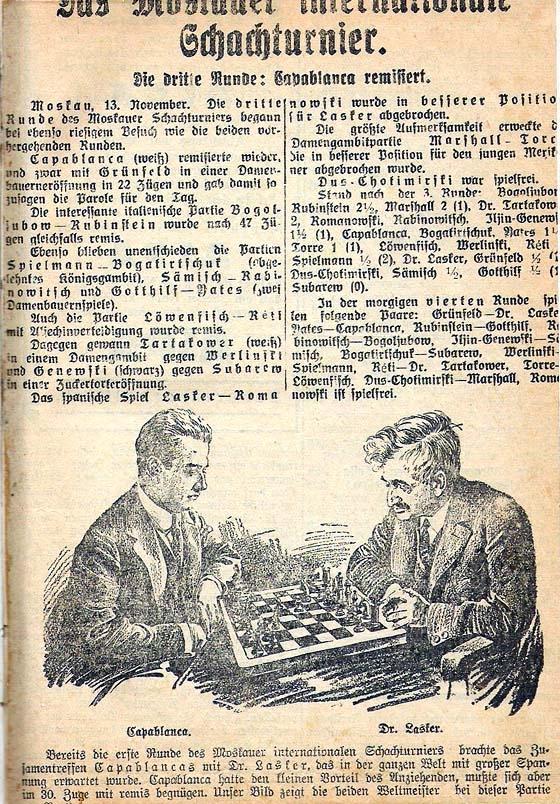
Capablanca and Lasker met in the first round of the Moscow tournament, on 10 November 1925, the opening being a Queen’s Gambit Declined. The Capablanca sketch is evidently based on the photograph of him given in our earlier items and published on, for instance, page 14 of the ‘1. Extra-Ausgabe’ of Kagans Neueste Schachnachrichten in late 1925 or early 1926, whereas the drawing of Lasker corresponds to a photograph given two pages earlier in the same issue:
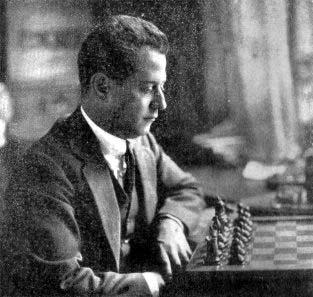
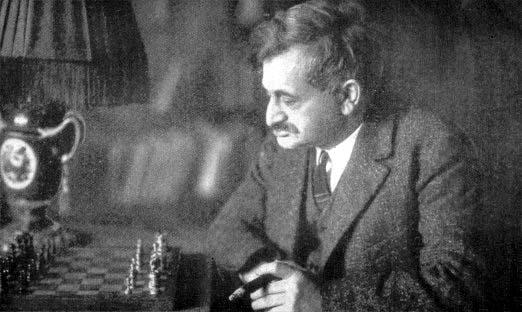
(3610)
See also our article A Fake Chess Photograph.
Bernard Levin was a British writer of the supposedly highbrow variety who, like Arthur Koestler and George Steiner before him (see C.N.s 3256 and 3266), occasionally wrote about chess, on autopilot, if a world championship match was in the news. We recently came across a piece by Levin on pages 171-174 of his anthology All Things Considered (London, 1988). Endowed with the catchpenny title ‘The mating game’, it had already somehow received space in the (London) Times, of 9 November 1987, and was the usual dollop of flash-fried offal served by writers who think that a readable overview of chess can be rustled up for the populace by cribbing tittle-tattle from books like Cockburn’s Idle Passion, Fine’s The Psychology of the Chess Player and Schonberg’s Grandmasters of Chess.
A prime objective of such output is to deride chess masters (particularly dead ones), and we quote just one passage from Levin’s ‘The mating game’, i.e. the sum total, ‘all things considered’, of what he had to impart about Emanuel Lasker:
‘Lasker, for instance, tried a variety of business schemes, all of which came to nothing (or to bankruptcy), his record being a pigeon-breeding establishment which failed, not surprisingly, because he tried to mate two male pigeons to get the thing properly started.’
The pigeon yarn is often seen, and in C.N. 1048, an examination of The Kings of Chess by W. Hartston (London, 1985), we commented:
‘The Lasker chapter captures the German champion vividly but still cannot resist churning out vague claims (page 81) about his “being swindled by all who did business with him”, trying to mate two male pigeons, despising imitation flowers, etc. (We might point out that Dus-Chotimirsky – Lasker & His Contemporaries, issue 4, page 140 – quotes Lasker as saying that he could not stand real flowers, but we have no wish to launch a debate on his floral tastes ...)’
When the unsubstantiated pigeon story about Lasker started circulating is difficult to say, but it was a staple feature of chapter 22 of Emanuel Lasker Biographie eines Schachweltmeisters by J. Hannak (Berlin-Frohnau, 1952) and chapter 21 of the English version, Emanuel Lasker The Life of a Chess Master (London, 1959). Since many parts of Hannak’s book read like a novelette, it may reasonably be felt that something more substantial is required before Lasker is mocked.
If any outsider is to cast an eye over chess and chessplayers, how we wish that it could be a truly outstanding writer with the finest insight, such as Alan Bennett.
(3662)
C.N. 11127 quoted the following from page 3 of the Chess Amateur, October 1925:
‘To the folly of the lay journalist writing about chess there is no end.’
The following item by G. Koltanowski on page 83 of the December 1969 Chess Digest Magazine comes to mind:
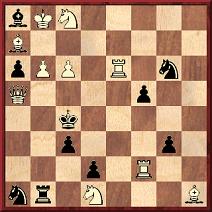
‘White to play and mate in three moves. The author of the problem wrote “... a horrible looking think [sic], which was set up to be difficult and not elegant ...” It was shown to the Masters participating at the New York International Tournament of 1893. It took Dr E. Lasker, champion of the World at that time, 35 minutes to solve. Pillsbury took 40 minutes. The others were way off.’
Quickly passing over Koltanowski’s customary inaccuracy (in 1893 Lasker was not world champion), we note that he did not name the composer. As Michael McDowell mentions to us, the problem is number 247 in A.C. White’s Sam Loyd and His Chess Problems (Leeds, 1913). Pages 200-201 identify it with the caption ‘Manhattan Chess Club, 1893’ and quote Loyd:
‘No. 247 is a horrible looking affair designed for a State Solving Contest. It was evidently posed for difficulty and not for elegance.’
What was the source of Koltanowski’s assertion about the (surprisingly long) time taken by Lasker and Pillsbury to solve the problem?
(3751)
The dates of Emanuel Lasker’s world championship reign, 1894-1921, are well known, but even an elementary matter like that can unhorse someone like Dimitrije Bjelica. Page 126 of his book Šahovska Čitanka (undated, but circa 1966) had the following:
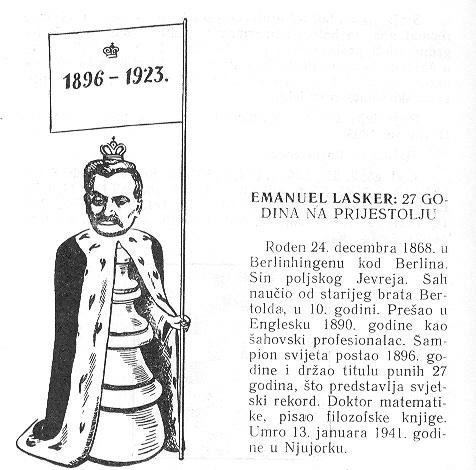
(3936)
As regards the other masters [apart from Capablanca], it may be noted that the set of pairings filmed (e.g. Marshall v Torre and Réti v Yates) corresponds to no round of play at Moscow, 1925, and there is much artificial smiling for the camera. Another point is that the cinema entry in The Encyclopedia of Chess by H. Golombek (London, 1977 and Harmondsworth, 1981) stated that the director, Pudovkin, utilized ‘such real personages as Capablanca and Lasker as figures in his short film’, whereas Basalla writes (justifiably, from our own viewing), ‘I can’t see where Emanuel Lasker appears at all’.
(3992)
From Thomas Höpfl (Halle, Germany) comes a link to a Russian film which contains (starting at about 4’37”) some moving pictures of Emanuel Lasker.
For Marshall’s book Chess Masterpieces (New York, 1928), the world’s leading masters (and a few others) nominated their best game. The following is the contribution from Lasker on page 60:
‘I think the game I won against Pillsbury in the St Petersburg Tourney in 1896 to be the best I ever played. I was just able to ward off a furious attack and then succeed in carrying my own counter-attack through. It is true that I missed the logical continuation at one point, owing to fatigue and time pressure, and so had to win the game twice; but then the sacrificial termination has some merit.’
See The Best Chess Games. It will be noted that Hodges, Napier and Rubinstein all nominated games of theirs against Lasker.
From the same feature article:
On pages 334-335 of the October 1919 BCM B. Goulding Brown described the game H.E. Atkins v J. Barry (in the 1910 Anglo-American cable match) as ‘the nearest that I know to perfection’, and The Golden Treasury of Chess by Francis J. Wellmuth (New York, 1943) gave it on pages 172-173 with the heading ‘The Perfect Game’. Atkins’ victory was also highly praised by Emanuel Lasker in his annotations in the New York Evening Post, which were reproduced on pages 75-76 of the American Chess Bulletin, April 1910. The world champion concluded:
‘Mr Atkins must be congratulated upon this game, in which every move he made, starting with his eighth, is beyond criticism.’
That assessment was quoted by Fred Reinfeld when he gave the game on pages 70-72 of A Treasury of British Chess Masterpieces (London, 1950). Lasker had preferred 7 Qd2, on the grounds that 7 Nb5 ‘puts the white knight out of play’, but Reinfeld regarded this as ‘carping criticism’ and concluded:
‘Had Lasker omitted the qualifying phrase, he would have been more just as well as more generous.’
The game Atkins v Barry (1910 cable match) has been highly praised, notably by Emanuel Lasker.1 On pages 334-335 of the October 1919 BCM B. Goulding Brown described the game as ‘the nearest that I know to perfection’, and the Chess Review book The Golden Treasury of Chess gave it with the heading ‘The Perfect Game’.
The score is too familiar to be republished here, but other nominations for that title are invited. And, in any case, what exactly is a ‘perfect game’? A ‘best game’ without the fireworks?
(2229)
A footnote on page 142 of A Chess Omnibus:
See pages 75-76 of the American Chess Bulletin, April 1910 and pages 70-72 of A Treasury of British Chess Masterpieces by F. Reinfeld.
Napier: [Of Lasker’s play beginning 17…Rxc3 against Pillsbury at St Petersburg, 1895-96]: ‘Pillsbury told me that the exquisite combination here initiated was the only startling and utterly diabolical surprise he suffered in all his career abroad.’
An extract from a letter from Emanuel Lasker to Walter Penn Shipley, as quoted on page 249 of the November 1919 American Chess Bulletin:
‘In chess I have become a “duffer”, though with training I might learn the game anew. I am rather sick of war, famine, revolution, immorality and violence. Not that I despair of the world – not at all – but for the moment I should like to be out of the center of the tempest; because my power of endurance is nearly used up, not physically, but morally. I have a longing to be at a quiet spot for a while until I know that fruitful effort is again appreciated. My wife is wonderfully patient and enduring, as, in fact, all good women are.’
(2259)
Part of an endnote on page 269 of Chess Explorations:
Page 193 of CHESS, 14 February 1938, quoted from H.W. Hawks in the Newcastle Evening Chronicle: ‘In a long career – over 50 years of chess – Dr Lasker has acquired the unique distinction of never winning a game from a lady. As a chess gallant he is without a peer.’ In fact, Lasker had a 100% record in serious play, derived from his win against Vera Menchik in their only game (Moscow, 1935). We gave a simultaneous display victory by Lasker over Miss A.M. Gooding on page 103 of CHESS, March 1980.
There follows a composition by Emanuel Lasker which was published on page 45 of the March 1926 American Chess Bulletin:
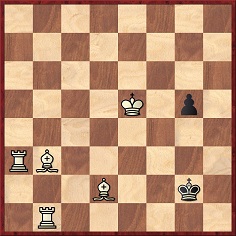
Mate in three
(2292)
We now note that the composition had appeared on page 203 of Checkmate, June 1903, where it was described as ‘an original contribution to Checkmate from the most eminent of the masters of the game’.
(3081)

Black to move
This position appeared on page 240 of Lasker’s Chess Magazine, September 1905, as well as on page 129 of Lasker’s book Curso de ajedrez (Mexico, 1908). Although both stated that with 1…Nf3 Black can force mate, it is not difficult to see that White can hold on with 2 Qe5.
(2321)
Christian Sánchez informs us that he has the fifth edition of the book (published in Paris/Mexico in 1925) and that on page 118 the position is given without the white queen. Its removal means that there is a forced mate, but most of the composition’s artistic flavour has gone.
(3080)
Confusion between Emanuel and Edward Lasker persists. On page 104 of The Amazing Book of Chess (Bramley Books, 1999) Gareth Williams gave the conclusion of the well-known game against Englund at Scheveningen, 1913 in the belief that the then world champion had been White.
An older example comes from page 59 of Famous Chess Players by Peter Morris Lerner (Minneapolis, 1973):
‘In 1921 Sammy [Reshevsky] played in a New York tournament during which former World Champion Emanuel Lasker required 70 moves to beat him.’
Again it was Edward Lasker. He won the tournament, for which 1922 would be the correct date.
(2361)
When C.N. 2361 was given on page 310 of A Chess Omnibus we added a footnote:
In his subsequent book Master Pieces (see pages 127 and 160) G. Williams proved unable even to spell Lasker’s forename, which came out as ‘Emmanual’.
See too the episode related in our feature article on Yates, which included the following, published by the BCM in 2017:
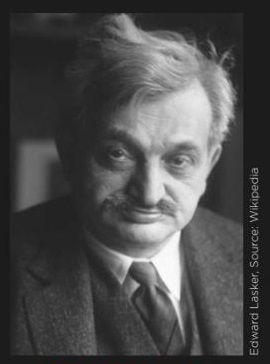
An observation by R.C. Griffith on page 155 of the April 1932 BCM:
‘It is most unfortunate that there always seems to be bickering between reigning and past champions. This has been the case for many decades, and it is for this reason that we so strongly advocate that the arrangements for the championship should be in the hands of the FIDE. If the patrons of chess who help to put up the necessary finance would agree that they would only do so through the FIDE, it is possible that our suggestion may be practical politics earlier than we anticipate.’
Steinitz demonstrated his outstanding eloquence and debating skills on umpteen occasions, and was seldom in the wrong. (His writings indicate that he was one of the most intelligent and honest of all the world champions.) He regularly expressed the view that tournaments had much less significance than matches, and during an argument with G.H. Mackenzie about a possible match he wrote (on page 333 of the November 1887 International Chess Magazine):
‘For my part, I would have been satisfied if he had called himself the International tournament champion and had left me the International match championship until such time when he was prepared to contest it, or until I otherwise forfeited my claim.’
‘We have two champions!’, commented La Stratégie of 15 November 1894 (page 357) after quoting a letter dated 10 October 1894 which was signed by ‘W. Steinitz, Chess Champion of the World’. Steinitz was addressing Lasker, reclaiming from him the title he had just lost, on the grounds that Lasker was refusing the agreed rematch:
‘No doubt you could retain the champion title, and prevent your ever being beaten on the checkered board, if the precedent were to be established that the champion could quite alone choose his own time of playing again, and break a positive agreement for a match, first on the plea of “a tour round the world”, and next of “chess and other engagements”, which it was your pleasure to enter into subsequently, instead of making preparations to fulfil your previous promise. But the general public will probably allow that I, as well as my backers, may hold a different opinion on the subject, and I shall therefore take the fullest responsibility of retaining the champion title, which you have forfeited by your letter of 22 June, after the expiration of the time of grace which I gave you for reconsideration.’
Lasker’s reign ended too in some disorder. In June 1920 he wrote publicly to Capablanca ‘I cannot play the match, knowing that its rules are widely unpopular. I therefore resign the title of the world’s champion in your favor’ (American Chess Bulletin, July-August 1920, page 126). The September-October issue of the Bulletin (page 142) published a statement by the Cuban dated 20 August 1920 which was signed ‘J.R. Capablanca, Chess Champion of the World’.
At least one chess writer has even affirmed that Alekhine retained the world championship after his death. On page 34 of Chess Openings for Progressive Players (London, 1949) M. Graham Brash intentionally gave the dates of the second reign as 1937-1948 ‘although Dr Alekhine died in 1946’.
Never, though, has there been such squalid anarchy as in the period 1993-2000.
(2407)
On page 168 of A Chess Omnibus we added an endnote referring to the final sentence:
And some way on into the twenty-first century.
‘Young players often proudly “invent” what was discarded a generation ago. Then they add another chapter to a very old story, fancying all the while that they have just stumbled across the plot of a new one.’
Emanuel Lasker, Lasker’s Chess Magazine, June 1908, page 43.
(2455)
From a letter (written in Moscow on 23 April 1936) which Emanuel Lasker had published on pages 357-358 of the 14 May 1936 issue of CHESS:
‘Réti’s alleged remark that my conception of chess as a fight is fully in accordance with my philosophy to fight against my opponent not only intellectually but “with the whole of my personality” is astounding. I often wrote of the theory of contests – in Common Sense in Chess, 1896, in Struggle, 1906, in Das Begreifen der Welt, 1913, in Die Philosophie des Unvollendbar, 1918, in Lasker’s Chess Manual, also in my Chess Primer. Moreover, my philosophical books were painstakingly discussed, over a period of five years, by the pupils of a professor of philosophy at the University of Giessen, but I do not think anybody has found in my writings anything bearing out the above remark, even remotely. My writings deal only with the laws and principles governing the struggle between perfect strategians. These do not exist in the flesh, because no-one, in any respect whatever, is perfect. Perfect strategians are instincts personified and idealized, for instance the perfect strategian at chess is the perfect chess instinct (usually called judgement). My books do not deal with mistakes or human foibles. Only my latest manuscript goes further than that, in that it deals with the erring and blundering creature, his psychology, his ethos and his drama. But it was never known to Réti. In fact, only a few persons know it, because, as the world at present runs, it has, as yet, not found its publisher.
But did Réti make the above remark in sober earnest? I think not. I have examined what he said of my style in his Lehrbuch (1930) page 123 e.g. and in the sentences cited by Fred Reinfeld and Reuben Fine in their Dr Lasker’s Chess Career page 12. In the former book Réti explains my style in that I strive to take advantage of the shortcomings of my opponent (but everybody does that) and in the latter by “my boundless faith in common sense”, which is much more to the point. Probably, after mature deliberation, Réti preferred to express his real views as in these two places, and the remark you quote was uttered as a mere casual and only half-serious conjecture.
The worst of his remark is that it is very vague. What does “the whole of one’s personality” circumscribe? Did other masters fail to fight “with their whole personality”? Without further explanation Réti’s alleged remark, I fear, has many widely different meanings. Under the cloak of such vagueness a debater is at liberty to support any theory whatsoever, for instance, that of Kmoch (“infallible judgment”, “elasticity of outlook”) or Spielmann’s (“the ideal fighter”) or Dr Tartakower’s (“unswerving belief in the elasticity of the position”; I became “the father of ultra-modern chess”) or Dr Tarrasch’s (in his Die moderne Schachpartie, 1916, page 193, he said, one is tempted to believe that I use witchcraft, hypnotism or such in order to induce my opponent to commit mistakes) or that of Maróczy (I smoke execrable cigars during play which cause my opponent to deteriorate for the time being, New York Times, 1928).
A collection of judgements on my style would be quite interesting and instructive. As the years passed I came across many of them. He who judges another, judges himself. However, I cannot go into this question at present. But I have repeatedly explained my conception of a contest between masters, i.e. between creative minds representative of their period. The fight between them is the necessary and sufficient condition of their creative work. To have a worthy opponent is a boon. He is short-sighted who strives for indisputable supremacy in his domain, whether at chess or other creative work. If, by ill-chance, he succeeds in approaching his stupid goal, he is blinded to his defects and deteriorates. When the outcome of tournaments is most uncertain and incalculable, as at present, then is chess passing through its most fertile periods.’
(2516)
See also Chess and Tobacco.
An otherwise complimentary evaluation of Emanuel Lasker on pages 174-177 of Everybody’s Guide to Chess and Draughts by Henry W. Peachey (London, 1896) contains the following:
‘Lasker is essentially a disciple of the modern school, which, unlike the Morphys and Andersons [sic] of the past, is content to let brilliancy severely alone and play for a draw. … He has gone, in fact, ahead even of the modern school. His practice is to treat the opening and middle game as means to the end, that is, of bringing about a pawn ending, in which, by some subtle and perhaps only theoretical advantage gained by previous play, he can steer through to victory. Few of his games come to an early close. Nearly all result in pawn endings, and in these he is a master of masters.’
(2525)
See also Chess and Draughts/Checkers, which gives a number of games played by Lasker.
From pages 156-157 of the 10 April 1909 Chess Weekly comes this position in which Charles Curt had the white pieces against Hermann Helms in ‘a rapid transit tournament recently played at the Brooklyn Chess Club’:
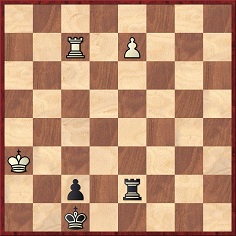
Black to play
The game went 1…Kb1 2 Rb7+ Ka1 3 Rc7 Re3+ 4 Ka4 Kb2 5 Rb7+ Ka2 6 Rc7 Re4+ 7 Ka5 Kb3 8 Rb7+ Ka3 9 Rc7 Re5+ 10 Ka6 Kb3 11 Rb7+ Ka4 12 Rc7 Re6+ 13 Ka7 Rxe7 14 Rxe7 c1(Q) 15 Rb7 Qc5+ 16 Ka8 Qc6 17 Kb8 Ka5 (‘Here the queen should have been played away from the c-file, but even then the ending is difficult to win in ten-second chess.’) 18 Ra7+ and draws. (‘Drawn by perpetual check, because if 18…Kb6 19 Ra6+ and stalemate.’)
No mention was made of Emanuel Lasker’s 1890 endgame study featuring the same motif.
(2717)
From an editorial by C.S. Howell on pages 17-18 of the Chess Weekly, 12 December 1908:
‘We admire the modern style of a Lasker who accumulates small advantages and relentlessly squeezes his opponent, but the big majority of us would rather play over the games of Morphy than those of Lasker. We want sacrifices and combinations and brilliancy.
Let’s do something! Let’s rise up in our wrath and make the masters play at the rate of 40 moves an hour, and in our little matches and tournaments let’s play at the rate of 50 moves an hour! Then more of the public will play and the published games will have more sparkle and spontaneity to them. The natural objection to such a plan is that it would result in blunders and a poor quality of chess. At first, perhaps, but under a fast time-limit players would have to use position judgment and that judgment would develop and improve. Trained players generally pick out a good move at sight and waste time only because they have it.
For proof, the reader is referred to the quality, brilliancy and accuracy of Pillsbury’s simultaneous blindfold play, which was conducted generally at a speed well above 50 moves an hour. In London, Dr Lasker, in an exhibition against 20 strong players, averaged over 100 moves an hour and only lost one game. The writer watched the exhibition and did not see the doctor make one real blunder.
And these are cases where the attention was divided among many games. In all seriousness, we should like to see the experiment tried in at least one important tournament.’
(2746)
From pages 389-390 of Kings, Commoners and Knaves:
‘Paul Morphy’s games constitute a beautiful bequest to the chess world, and give aim and purpose to the modern chess master; they have magnetized chess and taught players to develop their game to the fullest extent and then await the opportune moment for aggressive play.’
Emanuel Lasker, in a lecture in New Orleans, 18 June 1907, reported on page 372 of the August 1907 BCM.
‘His style is of extraordinary fineness, and his knowledge of the game can hardly be surpassed by any living player.’
A comment by Emanuel Lasker in the Neues Wiener Tageblatt, given on page 49 of the February 1914 BCM and appeared on page 389 of Kings, Commoners and Knaves.
From pages 151-152 of Kings, Commoners and Knaves:
On page 260 of the April 1974 Chess Life & Review Edward Lasker made the peculiar claim that it was only during the New York, 1924 tournament that Emanuel Lasker learned of the Marshall Gambit:
‘I had told him [Emanuel Lasker] on one of our morning walks in Central Park that during the war, when of course no chess news crossed the Atlantic, Marshall had invented a pawn sacrifice against the Ruy López which he had tried against Capablanca in a tournament in New York in 1918, but despite his tremendous attack, Capablanca succeeded in refuting it over the board. I told him how this “Marshall attack” went …’
We have been reading Walter Penn Shipley Philadelphia’s Friend of Chess, noting with admiration that both author (John S. Hilbert) and publisher (McFarland & Company, Inc.) are on top form.
A curiosity, from page 315, is a letter to Shipley dated 6 October 1908 from Emanuel Lasker, who disclosed information about Lasker’s Chess Magazine when inviting Shipley to take over the editorial chair:
‘Its expenses – 32 pages and four pages cover per month, 1,500 copies printing, say $100-$110, bookkeeping, mailing, etc. $40-$50 per month – are paid by 600 subscribers and to cover any possible deficiency I will place into your hands the $600 per annum ($19 a week) [Lasker would in fact seem to have written “$12 a week”] that I get from the Evening Post.’
Hilbert notes that Shipley did not take up the invitation and that early the following year Lasker’s Chess Magazine ceased publication.
(2862)
‘If you have Black, and your opponent plays 3 Bb5, your best move is to offer him a draw.’
This remark by Emanuel Lasker appeared in the Boston Transcript of 31 January 1903, an item quoted on page 130 of the March 1903 Checkmate. The Boston newspaper commented:
‘And although this was a bit of pleasantry, Dr Lasker did say in all seriousness that where the second player in almost any other opening might hope for a win, it was good judgment in the Ruy to hope for a draw. The suggestion that the chess world was waiting for some man who should begin an exhaustive analysis of the Ruy early enough in life to complete it, he dismissed with a deprecatory shrug. “I’m afraid he would have to continue it in the hereafter”, he said.’
(3058)
We have wanted to verify the Checkmate passage in the Boston newspaper and to add the page number, but so far only a similar, not identical, text has been found, on page 1 of the Boston Evening Transcript, 2 February 1903:

(12098)
Which great chessmaster published a book containing this cryptic-looking chart?

(3201)
The cryptic-looking chart came from page 165 of a book by Emanuel Lasker, Encyclopedia of Games, Volume one, Card Strategy (New York, 1929). It illustrated how a hand of whist was played, with ‘h8 cA’, for instance, meaning ‘eight of hearts, ace of clubs’.
The book had much mathematical content related to probability and risk. Lasker did, though, begin his explanations of poker and whist by devising simplified versions of these games, and he christened these inventions ‘pokerette’ and ‘whistette’.
(3207)
An unattributed quote on page 108 of The Bright Side of Chess by Irving Chernev (Philadelphia, 1948):
‘Lasker played 1 P-K4 with a view to the endgame.’
From page 62 of Modern Chess by Barnie F. Winkelman (Philadelphia, 1931):
‘But of Lasker it was said that he played P-K4 with a view to the endgame …’
Who first made this remark, and in what context?
(3330)
The questions in C.N. 3330 remain open, but an earlier occurrence can be added here, in the section about Lasker on page 30 of Modern Master-Play by F.D. Yates and W. Winter (London, 1929):
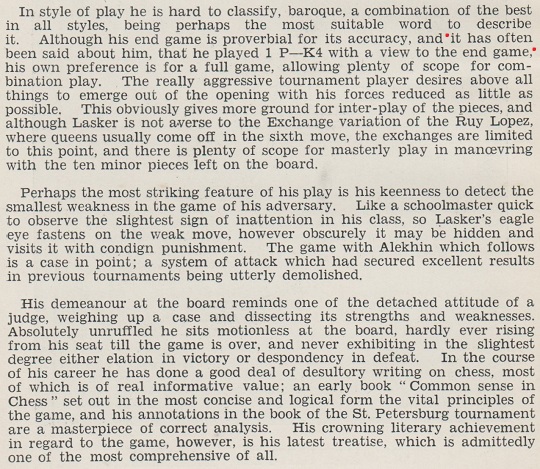
The game against Alekhine referred to in the second paragraph was Lasker’s victory at New York, 1924.
(9329)
Pages 273-274 of Kings, Commoners and Knaves presented some quotes from Marshall’s book Modern Analysis of the Chess Openings (Amsterdam, 1912/13). Here are a few more, from the ‘Casual Remarks’ section on pages 15-17:
‘I have often been asked, how can one improve at chess. I should advise that to “take the board and men, and analyze by oneself” is as good a way as I know anyway, it will familiarize one with the pieces, also to practice on, an opponent what has been studied.’
‘The different phrases of the game and well to think about are, – developement, position play, combination, attack, defense, simplicity, middle and end game play, also complications.’
‘The finest combinations are not always in the longest game, play for a centre, towards a centre and from a centre. The strongest attack are often a conception of small advantages and the hardest thing in chess is to win a won game.’
And from pages 60-61:
‘Of the Centre Gambit, little can be said in White’s favour, except the unwary falls, into one of the innumerable traps, with which this opening seems to afford. one in particular won by the great playwrite, Sydney Rosenfeld, against Lasker, in New-York, i.e. 1. P-K4, 1. P-K4; 2. P-Q4, 2. PxP; 3. QxP, 3. Kt-QB3; 4. Q-K3, 4. Kt-B3; 5. KtQ-B3. not (5. P-K5, 5. Kt-KKt5; 6. Q-K4, 6. P-Q4; 7. PxP en passant 7. B-K3; Blacks fine development would soon tell). 5. B-Kt5; 6. B-Q2, 6. Castles; 7. Castles, 7. P-Q4; 8. PxP, 8. KtxP; 9. Q-Kf3, 9. KtxKt; 10. BxKt and won,’
We have proof-read the above with particular care to ensure maximum accuracy (i.e. inaccuracy). The game-score jumble amounts to the following (on which further information is sought):
Sydney Rosenfeld – Emanuel Lasker
New York (date?)
Centre Game
1 e4 e5 2 d4 exd4 3 Qxd4 Nc6 4 Qe3 Nf6 5 Nc3 Bb4 6 Bd2 O-O 7 O-O-O d5 8 exd5 Nxd5 9 Qg3 Nxc3 10 Bxc3 and wins.
Marshall did not mention that White could have won a piece with 9 Nxd5.
(3364)
At a Manhattan Chess Club dinner on 19 March 1910, Emanuel Lasker gave his views, as reported on page 87 of the April 1910 American Chess Bulletin:
‘The champion in his turn spoke at length and hoped he would see the time when the study of chess might become a part of the school curriculum, not so much for the purpose of making boys and girls strong players as for the sake of initiating them into the strategic principles, which are the outcome of two thousand years [sic] of study, but which have been set forth in orderly array only since the time of Steinitz. The champion referred to chess as a playground on which the intellect may acquire useful habits of lasting benefit.’
(Kingpin, 1994)
Emanuel Lasker had some harsh words for chess analysts in his New York Evening Post column of 15 March 1911, page 11, which was quoted on page 155 of the July 1911 American Chess Bulletin:
‘Games from San Sebastian continue to arrive. The majority of them are very fine. But the chess-press disfigures them by misleading notes. If the games had voice, they would cry out against the violence done them. They are bespoiled of their true beauty, and a pink and powder brilliance is forced upon them.’
(Kingpin, 1994)
‘Chess is a Siamese-twin of clean living.’
Emanuel Lasker, quoted on page 51 of the April 1926 American Chess Bulletin. He had been speaking in Los Angeles that March, also declaring: ‘Chess is the greatest game of all if played in moderation.’
(Kingpin, 1999)
In Psychoanalytic Observations on Chess and Chess Masters (New York, 1956) Reuben Fine stated (page 51) that Lasker ‘invented a kind of tank in World War I’. (In the 1967 Dover reprint, The Psychology of the Chess Player, the quote is on page 45.) What more is known about this?
(3650)
From W.D. Rubinstein (Aberystwyth, Wales):
‘In Gerald Abrahams’ essay “Assessment of Lasker”, originally (it seems) a Third Programme BBC broadcast but reprinted on pages 145-147 of Not Only Chess (London, 1974), there is this paragraph, in a review of Hannak’s biography of Lasker:
“Lasker was terribly lazy. The authors [sic] of the book do not say this, but it is written clearly between the lines. (With more energy he would have been a great mathematician.) I have it from Amos Burn and Gunsberg and Mieses that, in his early tournaments, Lasker was in the habit of driving up to the hall in a barouche or droshky, in order to find himself with 20 moves to make in as little as five minutes. I have it from Levenfisch that he showed the same inertia when they gave him opportunities for mathematical research at Moscow. He was content to ‘throw out ideas’.”
This does not sound like Lasker. Did he really arrive at tournaments with five minutes to spare? Abrahams was a barrister and a talented chess writer. He was born in 1907, but did he really have anecdotes like this from Amos Burn?’
(3673)
As regards Nardus the artist, we turn to L’oeuvre de Léonardus Nardus, a catalogue of the paintings and drawings he put up for sale in Amsterdam on 23 January 1917 for the benefit of the Red Cross in France and Belgium. An introductory note on page 3 stated that he had been born in Utrecht on 5 May 1868 ‘et fit ses études à l’Académie des Beaux Arts d’Amsterdam (Altmann)’. Having travelled widely (Italy, Tunisia, Algeria and Spain), he was, at the time of the sale, resident in Holland.
The catalogue began with four portraits of chessmasters (all signed and dated 1912), including the following:
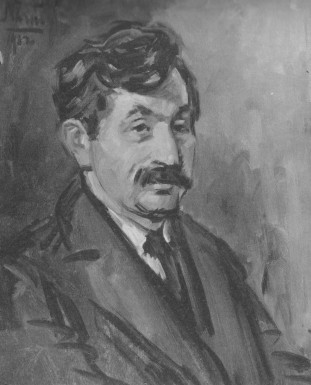
Emanuel Lasker
A footnote on page 5 specified that the painting of Lasker was not for sale, being the property of Lasker himself and included in the catalogue only for the sake of completeness. In addition, page 11 listed (but did not show) a 1913 charcoal drawing of Janowsky.
(3715)
The painting was mentioned in the introduction to an off-hand Janowsky v Lasker game on pages 16-17 of the January 1913 issue of La Stratégie:
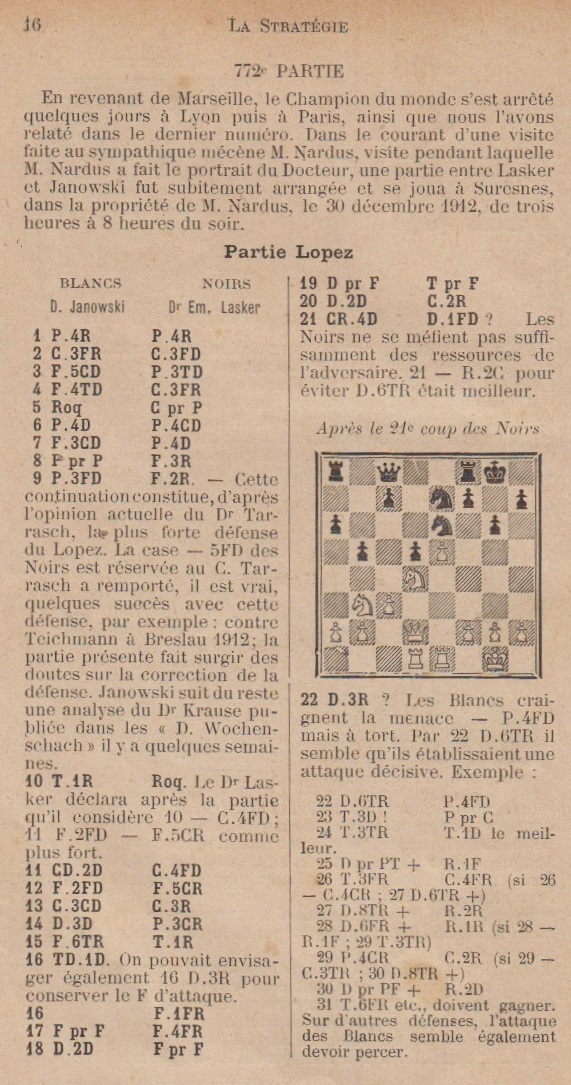

Page 158 of K. Whyld’s 1998 collection of Lasker’s games erroneously gave the source as ‘La Stratégie 1913, p. 39’. The game is on pages 39-40 of the February 1913 Deutsche Schachzeitung, which stated after 37...Nf5 ‘und Weiß gab nach einigen Zügen die Partie auf’. That corresponds to what Lasker himself had written in the annotations in his Pester Lloyd column of 5 January 1913, pages 9-10:
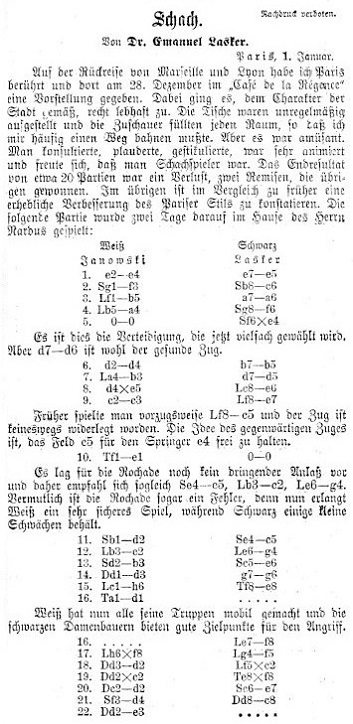
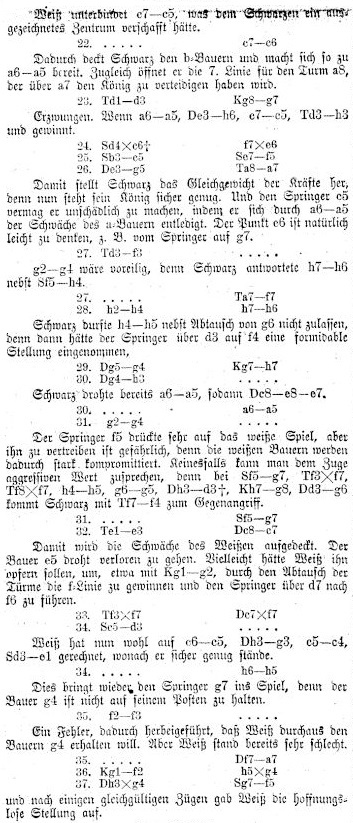
1 e4 e5 2 Nf3 Nc6 3 Bb5 a6 4 Ba4 Nf6 5 O-O Nxe4 6 d4 b5 7 Bb3 d5 8 dxe5 Be6 9 c3 Be7 10 Re1 O-O 11 Nbd2 Nc5 12 Bc2 Bg4 13 Nb3 Ne6 14 Qd3 g6 15 Bh6 Re8 16 Rad1 Bf8 17 Bxf8 Bf5 18 Qd2 Bxc2 19 Qxc2 Rxf8 20 Qd2 Ne7 21 Nfd4 Qc8 22 Qe3 c6 23 Rd3 Kg7 24 Nxe6+ fxe6 25 Nc5 Nf5 26 Qg5 Ra7 27 Rf3 Raf7 28 h4 h6 29 Qg4 Kh7 30 Qh3 a5 31 g4 Ng7 32 Ree3 Qc7 33 Rxf7 Qxf7 34 Nd3 h5 35 f3 Qa7 36 Kf2 hxg4 37 Qxg4 Nf5 and wins after a few more moves.
(11525)
Page 102 of the September-October 1937 American Chess Bulletin transcribed a radio broadcast (Station WYNC, New York City) by Hermann Helms. A brief extract is given below:
‘The courage of the man is downright amazing, so I was moved to ask: “Doctor, do you ever intend to retire?”
To which he replied with a smile: “No; at any rate not until I have succeeded in gaining a competence from chess.”
He gave me a wink, as he said it, for you must know that the pursuit of chess professionally is not exactly a producer of wealth in large figures.’
(3736)
See also Chess and Radio.
This illustration appears on page 22 of Famous Chess Players by Peter Morris Lerner (Minneapolis, 1973):
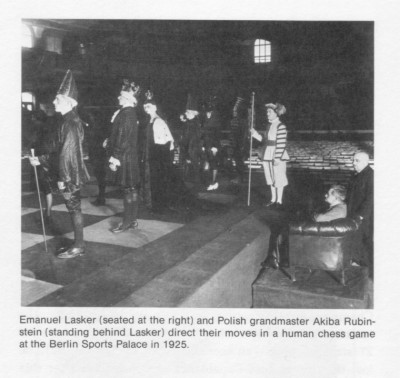
The date 1925 is an error for 1924, but we also suggest that the person on the far right is not Akiba Rubinstein but, probably, Ossip Bernstein. The latter participated in the event, as reported on page 300 of the October 1924 Wiener Schachzeitung.
(3775)
On page 130 of the May 1951 Chess Review a reader, E. Gram-Larsen of Solar, Norway, wrote regarding a Lasker v Steinitz ending:
‘In the 14th game of the second world championship match, the following position occurred after Black’s 52nd move:
There followed 53 Rc2?? Rxc2+ 54 Kxc2 and Black resigned after White’s 78th move. But if Black had played 53...Ra1+ White might have resigned as his rook on d1 is lost. It could have been Emanuel Lasker’s greatest blunder.
I have the game from Ludwig Bachmann’s book Schachmeister Steinitz, Vol. 4, Ed. 1921. It was played on 29 December 1896. I thought there might be errors in the score – there are many in other places in the book – but, so far as I can see, the moves leading to the above position are in order.’
We believe, however, that Bachmann erred by putting as White’s 50th move Rd6-d1, rather than Rd6-d8, and that there was thus no blunder by Lasker at move 53.
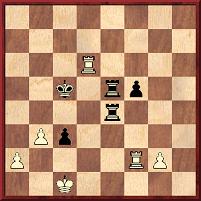
Position after 49...Kd4-c5
Although 50 Rd1 was also given in the Weltgeschichte des Schachs volume on Steinitz by David Hooper (Hamburg, 1968) and the two editions of Chess World Championships by James H. Gelo (Jefferson, 1988 and 1999), all contemporary magazines verified by us so far have 50 Rd8. Examples are Deutsches Wochenschach, 10 January 1897, pages 6-7 and Deutsche Schachzeitung, February 1897, pages 38-40.
(3847)
From page 97 of the book Cuba/66 XVII olimpíada mundial de ajedrez comes a photograph of Tigran Petrosian ‘and other masters’ looking at the board used in the 1921 world championship match between Lasker and Capablanca:
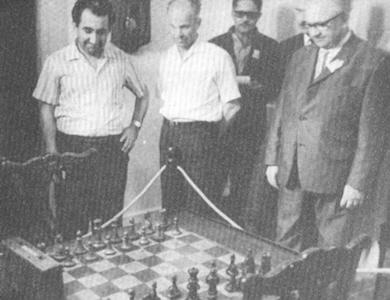
(3997)
It is frequently stated that Emanuel Lasker and Richard Teichmann were born the same day, 24 December 1868, but were they? Richard Forster points out that when Teichmann died various obituaries in German magazines gave 23 December 1868, one example being on pages 198-199 of the July 1925 Deutsche Schachzeitung. Indeed, page 281 of Deutsches Wochenschach, 21 June 1925 specifically stated that 24 December was incorrect:
‘Teichmann war am 23. (nicht 24.) Dez. 1868 in Lehnitzsch in Sachsen-Altenburg geboren ...’
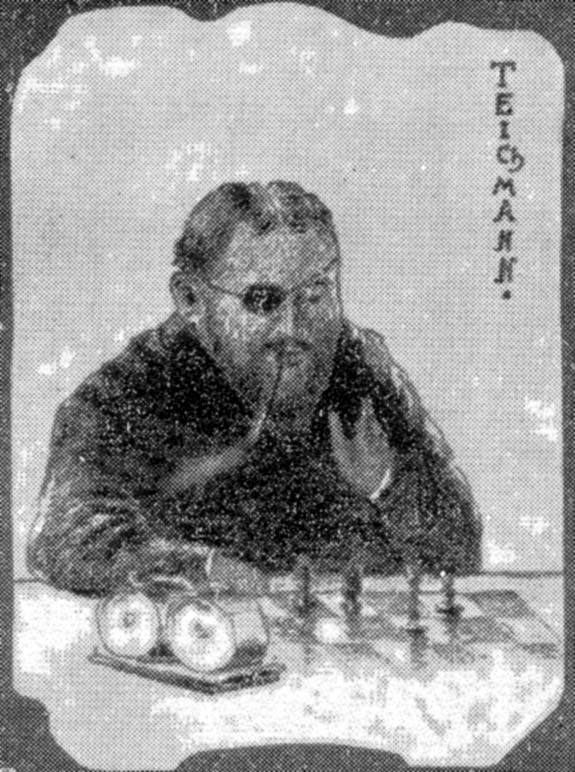
Richard Teichmann
(4058)
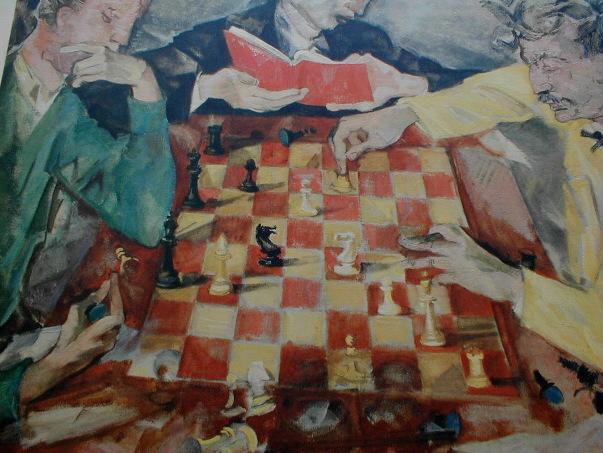
Mark N. Taylor (Mt Berry, GA, USA) sends the above picture and observes:
‘This is Maximilian Mopp’s “Chess with Emanuel Lasker”, of which I have a print (“Copyright 1953. Arthur Rothmann Fine Arts, Inc., N. Y. C.” ). Can anyone identify the position on the board, Lasker’s opponent, or the third figure? Mopp is perhaps best known to chessplayers as the illustrator of Edward Lasker’s Chess for Fun & Chess for Blood.’
(4091)
See Chess and Paintings.
José Angulo (Barcelona, Spain) asks about the graves of Lasker and Euwe.
Concerning Lasker we have no photograph but can outline the facts.
Emanuel Lasker died at Mount Sinai Hospital, New York shortly before midday on 11 January 1941 (the erroneous date 13 January is sometimes seen even today); he had been in the hospital for two weeks. This information comes from page 1 of the January-February 1941 American Chess Bulletin, which also reported:
‘Many sorrowing friends and admirers gathered on Monday, 13 January at the Riverside Memorial Chapel, to attend the funeral services conducted by the Rev. Dr David de Sola Pool, rabbi of the Spanish and Portuguese Synagogue, Shearith Island, a personal friend of Dr Lasker’s and a member of his chess class. That afternoon, interment took place at the Shearith Israel Cemetery in Cypress Hills on Long Island.’
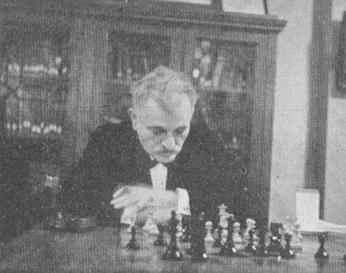
Emanuel Lasker
(4103)
Hassan Roger Sadeghi provides a link to some information about the grave of Emanuel Lasker.
(4109)
Alexander Rietema (Fort Lee, NJ, USA) has forwarded some photographs, which he took in late September/early October 2006, of the graves of Steinitz (Brooklyn, NY) and Lasker (Queens, NY). The Lasker pictures:
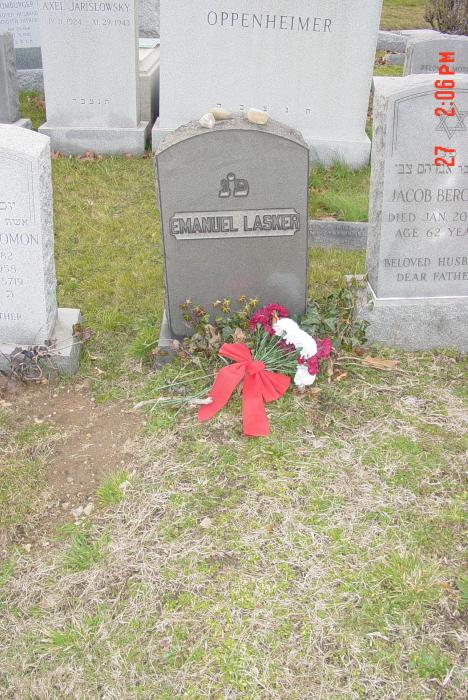
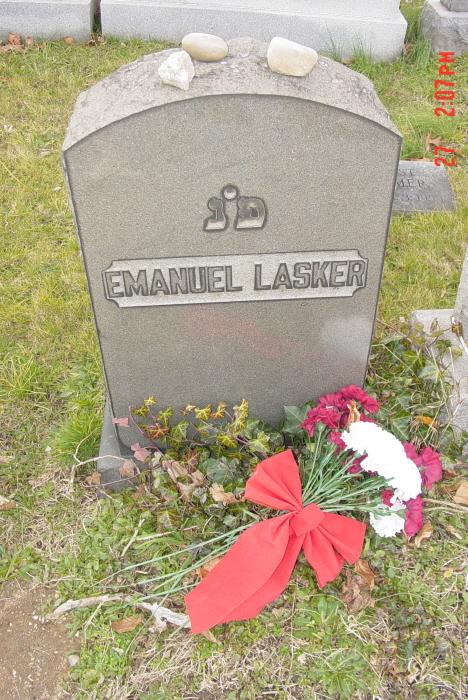
(7794)
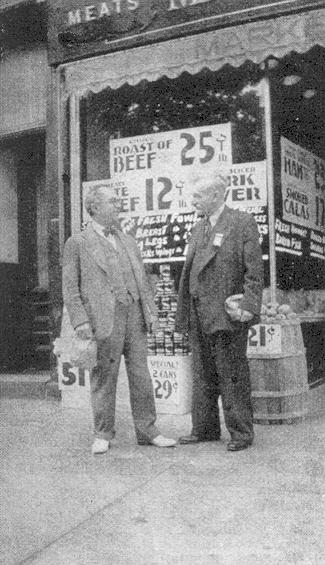
This picture was published on page 5 of the January-February 1941 American Chess Bulletin under the heading ‘Good Companions’ and with the following caption:
‘Shopping in Hamilton. The last photograph taken of Dr Lasker was this snapshot of him standing outside a market in Hamilton, NY, where he attended the State meeting, 17-24 August 1940. To the lapel of his coat is attached a committeeman’s badge, and in his left hand the veteran carries the inevitable bag of fruit. His vis-à-vis, Harold M. Phillips, wears an expression which shows him to be sensitively attuned to the quizzical good humor of his famous friend.’
(4161, 4195)
Page 622 of the Literary Digest, 19 May 1900 gave the following extracts from an article by Pillsbury in The Independent of 10 May that year:
‘Perhaps the mental quality most useful to the chessplayer who wishes to rise to distinction in the game is concentration – the ability to isolate himself from the whole world and live for the events of the board while a match is proceeding. And yet “concentration” does not quite suit me as expressing the quality I refer to, for concentration implies narrowing, and I am satisfied that the influence of chess broadens the mind.
Besides the quality which we have, for want of a better name, called concentration, there are others that are essential to the good chessplayer. One of these is patience, or ability to wait. We have players who are known as plungers, who see an opening and drive ahead into it without studying out all that it leads to. Such men can never become good players. The chessmaster must have full control of himself at all times. He must not be impatient, he must be content to mark time, as it were, till he sees the result of his opponent’s attack, and he must be able to resort to meaningless moves to kill time if there is no other way of holding fast to the fortified position till the danger is over. Not all men can do this. They want to rush out and attack, and thereby they expose themselves and lose the game.
Another most useful quality is accuracy, in which Lasker excels. His foresight has not so great a range as that of Chigorin, for instance, but so far as he sees he is infallible. Chigorin may see five moves ahead and Lasker only three, but the latter more than evens up matters by his deadly accuracy and thoroughness.’
(4165)
From a letter about Emanuel Lasker contributed by Heinrich Fraenkel to CHESS, 20 June 1957, page 230:
‘Whoever told you about “his chronic insolvency” can’t have known Lasker. True enough, he was desperately poor in his youth (and so was brother Berthold, later to be a famous Professor and head of a fashionable clinic); but ever since the early and mid-nineties Lasker’s considerable earnings were much in excess of his requirements; to say nothing of the fact that his wife Martha (daughter of one of the wealthiest bankers in Berlin) was a very well-to-do woman. It was only after 1933 – when the Laskers had to emigrate, leaving their large flat in Berlin’s West End, their country cottage and their bank accounts behind – that the old man had to resume working for a living. But for financial reasons, it is almost certain that he wouldn’t have played at Zurich, Moscow or Nottingham. Hence, so far as chess history and chess literature is concerned, it was certainly a blessing in disguise, however deplorable the thought that so great a man, in his declining years, should have been exposed to financial worries.’
(4170)
This illustration appeared on page 60 of A Book of Chess by C.H.O’D. Alexander (London, 1973):
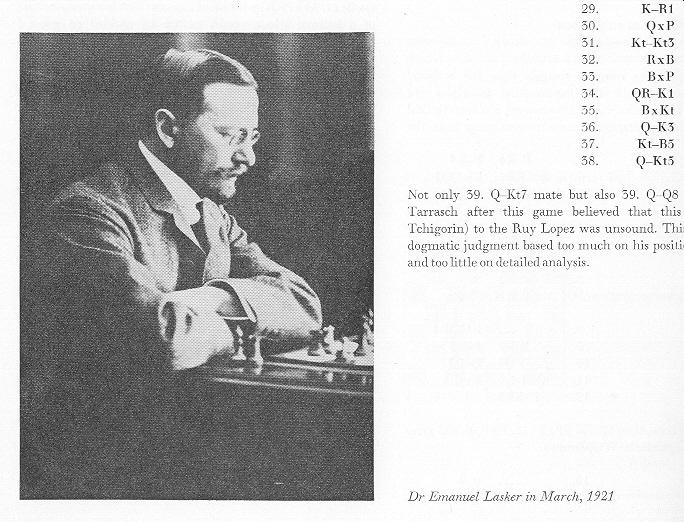
In reality, both parts of the caption (‘Dr Emanuel Lasker’ and ‘in March, 1921’ are wrong. As noted on page 315 of A Chess Omnibus, the player is Tarrasch. We add here that the photograph was the frontispiece of Schachjahrbuch für 1908 by L. Bachmann (Ansbach, 1909), whose caption correctly identified the two masters and noted that the picture had been taken in Munich during their 1908 world championship match.
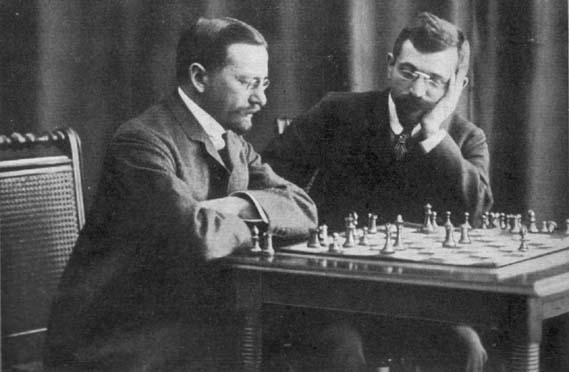
(4221)
As also mentioned in our Kingpin article in 2000 (see too page 315 of A Chess Omnibus), the same mistake occurred on pages 64 and 66 of Chess by Paul Langfield (London, 1978).
See also Chess: Mistaken Identity.
Tartakower’s oft-quoted commentary on Lasker, Capablanca and Alekhine (see, for instance, pages 3, 18 and 29 of the Baden-Baden, 1925 tournament book published by Caissa Editions in 1991) was presented as follows by Koltanowski on page 52 of the Chess Digest Magazine, March 1972:
‘Tartakower, when Alekhine was stunning the chess world in 1930-33, made this witty remark: “Lasker was world champion, Capablanca is world champion, and Alekhine plays like a world champion.’
Since Alekhine became world champion in 1927, this is just another example of Koltanowski’s difficulty with elementary facts.
(4279)
From an article by the pitifully undependable George Koltanowski, on page 52 of the Chess Digest Magazine, March 1972:

Koltanowski’s reference to Tartakower was given in C.N. 4279, which pointed out that in the 1930s Capablanca was no longer the world champion. We gave mid-1920s references for the remark, and below is what Bernhard Kagan wrote, without identifying the speaker, on page 344 of Kagans Neueste Schachnachrichten, 1 July 1925:

A similar observation (‘Capablanca has the title, Lasker has the results, but only Alekhine has the style of a real world champion’) appeared in an article by Tartakower in issue 4-5 of Shakhmaty, 1925. It was reproduced on page vii of the Baden-Baden, 1925 tournament book by N.I. Grekov (Moscow, 1927):

Elsewhere, Tarrasch has been named in place of Tartakower. From pages 176-177 of The Great Chess Masters and their Games by Fred Reinfeld (New York, 1952):
‘It was the St Petersburg International Tournament [in 1914] that catapulted Alekhine to world fame as a grandmaster and not merely a brilliant player. The main object of attention was of course the duel between Lasker and Capablanca, but Alekhine came very near to stealing the show by thrusting Rubinstein, Nimzowitsch and Bernstein aside and then outpacing Tarrasch and Marshall and coming a fine third to Lasker and Capablanca. It was in this famous tournament that Alekhine first displayed that white-hot fusion of logic and fantasy that was to enthrall chessplayers for three decades; that was to prompt Tarrasch to declare later on that “Lasker used to be the world champion, Capablanca is the world champion, but Alekhine plays as a world champion should play.”’
Given that Alekhine, aged 21, finished well behind Lasker and Capablanca at St Petersburg, 1914 (by a margin of 3½ points and 3 points respectively), it is odd to suggest that he ‘came very near to stealing the show’. What Reinfeld termed ‘a fine third’ was called ‘a poor third’ in the entry on Alekhine in the Oxford Companion to Chess (1984 and 1992 editions) and ‘a bad third’ on page 46 of Championship Chess by P.W. Sergeant (London, 1938).
An earlier claim that Tarrasch made the remark about the three world champions was published on page 86 of Chess World, 1 May 1946, in an article, ‘Glimpses of Alekhine’, by M.E. Goldstein:
‘Before Alekhine defeated Capablanca, Dr Tarrasch, a man not given to fulsome praise, wrote that “Lasker was world champion, Capablanca is world champion, but Alekhine plays as a world champion should play”. To the man in the street, Alekhine was the man to watch – the sacrifice of the queen for a mating attack represented the triumph of mind over matter, which everyone could appreciate. On the other hand, the positional cavortings of a Capablanca or a Rubinstein were beyond the ken of ordinary men.’
When presenting Réti v Alekhine, Baden-Baden, 1925 (under the heading ‘The Gem of Gems’) on pages 110-111 of the 1 June 1946 issue of Chess World, C.J.S. Purdy wrote:
‘We disagree with Mr Goldstein when he says that Alekhine’s chess is easier for the ordinary player to understand than Capablanca’s. Capablanca’s moves may often surprise, but usually their logic is soon apparent after examination. But many of Alekhine’s moves depend on some surprise that comes far too many moves ahead for an ordinary mortal to have the slightest chance of foreseeing it. Alekhine’s chess is like a god’s. One can revere, but never hope to emulate.’
(9384)
See also our feature article How Many Moves Ahead?
Hassan Roger Sadeghi asks for more information about a statement by Christiaan M. Bijl on the first page of his Foreword to The Monte Carlo Tournament of 1903 (Zurich, 1983):
‘World champion Lasker did not take part; he had just taken up residence in St Louis, USA, as assistant professor of mathematics.’
Perhaps a reader can provide details of Lasker’s various academic postings. As regards St Louis, we note the following on page 133 of Checkmate, March 1903:
‘Dr Lasker has accepted a mathematical tutorship at the St Louis (MO) University, it is reported.’
(4290)
In a letter to us dated 11 February 1972 C.H.O’D. Alexander wrote:
‘Capa was undoubtedly one of the two or three most gifted players who ever lived – but lazy (that’s why Alekhine beat him). Nowadays he would have to work much harder – especially at the openings – than he did. I think Fischer is equally gifted (his style is very much like Capa’s) and a much harder worker; so in fact I put Fischer ahead of him. I’m now inclined to think Fischer the best there has ever been.’
We subsequently asked Alexander how he would place the other main contenders for the title of greatest player ever, to which he replied:
‘Very close – probably 1 Lasker 2 Botvinnik, Capablanca 4 Alekhine, but there are so many different ways of defining “greatest player” which give different answers.’
As regards Capablanca and Alekhine’s respective characters, Alexander informed us:
‘Capablanca was a conceited man (i.e. he thought very well of himself) who liked chess because he excelled at it.
Alekhine was a vain man (i.e. he liked other people to think well of him) who – though he had childish and vicious streaks that Capablanca was free from – did at least really love chess.’

(4293)
A paragraph from a letter that Harry Golombek wrote to us on 26 February 1972:

(11823)
From page 314 of Emanuel Lasker The Life of a Chess Master by J. Hannak (London, 1959) comes this extract from ‘one of Lasker’s last lectures’, in Chicago:
‘When in England in 1936 I had the most pleasing acquaintance of the Member of Parliament, Brigadier-General Spears. He invited my wife and myself to his house, and he wanted to know what we thought of the Hitler régime ...’
It is not specified whether Lasker met the politician on a chess occasion. We note from page 337 of Who’s Who of British Members of Parliament, volume three (Brighton and Atlantic Highlands, 1979) that Major General Sir Edward Louis Spears, KBE, CB, MC (1886-1974) was a Member of Parliament from 1922 to 1924 (Liberal) and from 1931 to 1945 (Conservative). He adopted the surname Spears, instead of Spiers, in 1918.
(4451)
Michael Negele (Wuppertal, Germany) has sent us a rare photograph of Emanuel Lasker’s brother, Berthold, which appeared on page 47 of a biography of Berthold’s wife, Else Lasker-Schüler by Sigrid Bauschinger. The book was first published in 2004 by Wallstein Verlag, Göttingen and is now also available as a paperback (Suhrkamp). The source of the photograph is the Stadtbibliothek Wuppertal, from which our correspondent has received permission for it to be reproduced here.
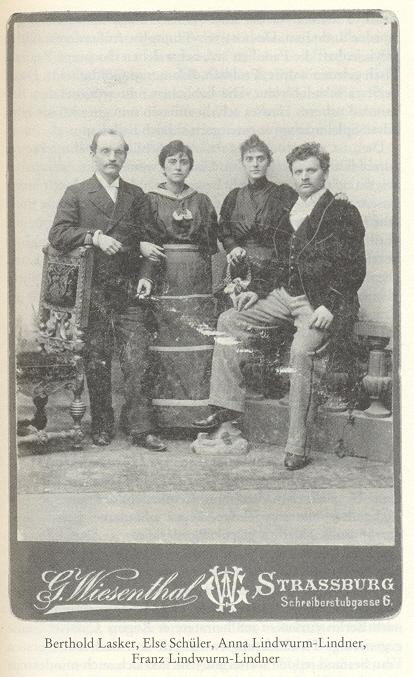
Courtesy of the Stadtbibliothek Wuppertal, Else Lasker-Schüler Archiv (Mr Henry Schneider).
(4514)
Two tournament games played by Berthold Lasker are given here, from the August 1890 Deutsche Schachzeitung (pages 230-231 and 237-238 respectively):
Berthold Lasker – Horatio Caro
Berlin, 21 July 1890
Ruy López
1 e4 e5 2 Nf3 Nc6 3 Bb5 d6 4 d4 exd4 5 Nxd4 Bd7 6 Nc3 Nf6 7 O-O Be7 8 Nxc6 bxc6 9 Bc4 O-O 10 Qd3 Kh8 11 h3 c5 12 Bf4 Nh5 13 Bh2 f5 14 e5 f4 15 Bd5 Rb8 16 Bf3 g6 17 Bxh5 gxh5 18 exd6 cxd6 19 Nd5 Bg5 20 Rfe1 Rf5
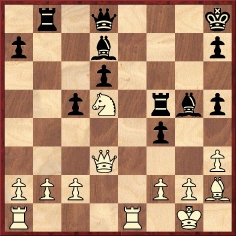
21 h4 c4 22 Qxc4 Bxh4 23 Bxf4 Qf8 24 g3 Rc8 25 Qd4+ Bf6 26 Nxf6 Qxf6 27 Qxf6+ Rxf6 28 Re7 Bg4 29 Rxa7 Rxc2 30 Re1 Be2 31 Re7 Bb5 32 Rd1 Bc6
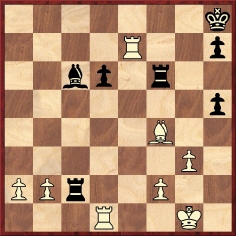
33 Be5 Rxf2 34 Bxf6+ Rxf6 35 Rf1 Rxf1+ 36 Kxf1 Kg8 37 Kf2 Bb5 38 Ke3 Resigns.
Berthold Lasker – Curt von Bardeleben
Berlin, 24 July 1890
Vienna Game
1 e4 e5 2 Nc3 Bc5 3 Nf3 d6 4 Bc4 Nf6 5 d3 c6 6 h3 b5 7 Bb3 Qb6 8 Qe2 a5 9 a4 Be6 10 Bxe6 fxe6 11 axb5 cxb5 12 Be3 Nc6 13 O-O Rb8 14 g3 O-O 15 Kg2 Nd7 16 Nd1 h6 17 Ne1 Rf7 18 Bxc5 Nxc5 19 Qd2 Rbf8 20 f3 a4 21 Nc3 Nd4 22 Ne2 Nxe2 23 Qxe2 b4 24 Qe3 Qb7 25 Rf2 Qc6 26 Rd2 Rb8 27 d4 exd4 28 Qxd4 Rd7 29 Qc4 d5 30 exd5 exd5 31 Qf4 Rdd8 32 h4 Ne6 33 Qg4 d4 34 Nd3 b3 35 cxb3 Rxb3 36 Rc1 Qd5 37 Re1 Rd6
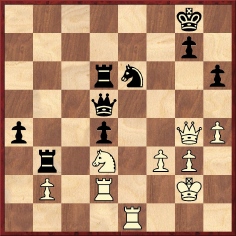
38 Rxe6 Qxe6 39 Qxe6+ Rxe6 40 Nc5 Ree3 41 Nxb3 Rxb3 42 Kf2 d3 43 Ke3 Kf7 44 g4 Ke6 45 Ke4 g6 46 Kd4 h5 47 gxh5 Drawn.
White in the latter game is sometimes incorrectly given as Emanuel Lasker.
There follows a brief feature on Berthold Lasker from page 84 of Die Schachspieler und ihre Welt by Arpad Bauer (Berlin, 1911):
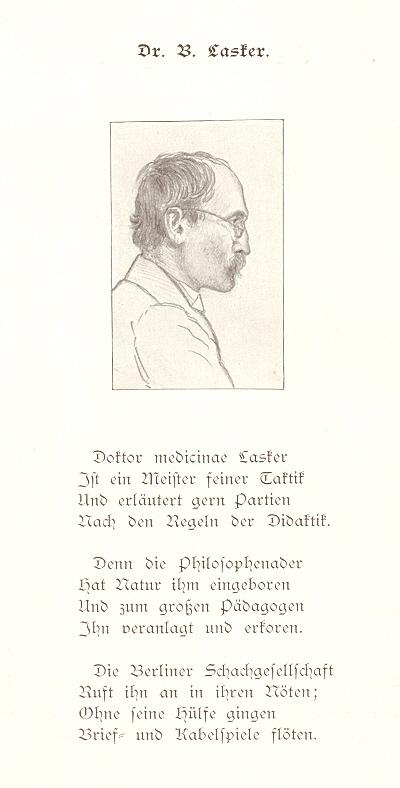
(4515)
From page 165 of the November 1928 American Chess Bulletin:

(6679)
Fine photographs of Emanuel Lasker and Richard Réti are online from the holdings of the National Library of Israel.
(9914)
From the Israel National Library link in C.N. 9914 Avital Pilpel (Haifa, Israel) has found a photograph of Emanuel and Berthold Lasker.
With regard to Berthold Lasker, the game below is taken from pages 141-142 of the July-August 1921 American Chess Bulletin:

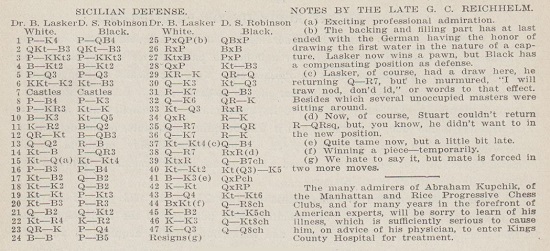
1 e4 c5 2 Nc3 Nc6 3 g3 g6 4 Bg2 Bg7 5 d3 d6 6 Nge2 Nf6 7 O-O O-O 8 f4 e6 9 h3 Ne8 10 Be3 Nd4 11 Kh2 Bd7 12 Rb1 Bc6 13 Qd2 Rc8 14 Nc1 a6 15 Nd1 Nb5 16 c3 f5 17 Nf2 Qc7 18 Ne2 Qf7 19 Ng1 b6 20 Nf3 h6 21 Qc2 Qb7 22 Nh4 Kh7 23 Rbe1 d5 24 Bc1 c4 25 exd5 Bxd5 26 Rxe6 Bxg2 27 Nxg2 cxd3 28 Qxd3 Nf6
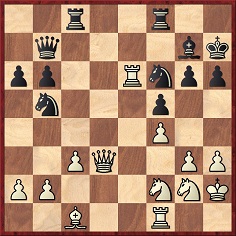
29 Rfe1 Rcd8 30 Qe3 Nd6 31 Re7 Qc6 32 Qe6 Rde8 33 Nd3 Rxe7 34 Qxe7 Re8 35 Qa7 Ra8 36 Qe7 Re8 37 Nb4 Qc5 38 Qa7 Rxe1 39 Nxe1 Qf2+ 40 Ng2 Nde4 41 Be3 Qxg3+ 42 Kg1 Qxh3 43 Bd4 Ng3 44 Bxf6 Qh1+ 45 Kf2 Ne4+ 46 Ke3 Qg1+ 47 Kd3 Qd1+ 48 White resigns.
(9917)
Links are added here to a portrait of Tarrasch and another shot of Berthold Lasker. The latter has the same background as in a picture of Emanuel Lasker held by the Library (and also shown in C.N. 8643).
(9921)
The above links are broken.
‘Next day Reuben Fine and his young wife came to see him [Lasker] for the last time. He could merely give them a feeble wave of his hand. When Fine had gone, Martha [Lasker’s wife] heard Emanuel whisper: “A King of Chess”.
These were the last words he was heard to speak. He died next day, on 13 January 1941.’
Lasker died on 11 January 1941.
(4705)
From Javier Asturiano Molina (Murcia, Spain):
‘There is a slightly different version in the book Lasker: el difícil camino hacia la gloria by Miguel Ángel Nepomuceno (Madrid, 1991). On pages 237-239 the story of Lasker’s last days was related by Dr Platz and Martha Lasker, and the following words were attributed to Martha Lasker on page 238:
“Al día siguiente le visitaron por última vez Reuben Fine y su joven esposa. Sólo pudo hacerles una señal con la mano. Cuando se hubieron marchado, le oí susurrar esta frase: ‘Un rey del ajedrez’. Fueron las últimas palabras que salieron de su boca.”
English translation: “The following day Reuben Fine and his young wife visited him for the last time. He could merely give them a wave of his hand. When they had gone, I heard him whisper this phrase: ‘A King of Chess’. These were the last words he uttered.”
The book Lucha by Emanuel Lasker (Albacete, 2003) has a Preface by Ricardo Calvo which states (on pages 11-12):
“Una de las últimas frases que se le oyó, dirigida a su fiel esposa Martha, fue: ‘Qué hermosos eran los bosques y lagos de nuestra infancia.’
English translation: “One of the last sentences of his to be heard, spoken to his faithful wife Martha, was: ‘How beautiful were the forests and lakes of our childhood.’”
Joseph Platz discussed Lasker’s death on page 40 of his book Chess Memoirs (Coraopolis, 1979), referring to Hannak’s volume but not mentioning Fine.
(5076)
Our recommendation in C.N. 3514 was ‘to dispense with any publication or website which offers “chess quotes” without indicating where and when the statements in question were purportedly made’. From our recent reading, nothing in this field compares with the quotes section (pages 155-169) of Check Mate and Word Games by Carlos Tortoza (Denver, 2006). For example:
Emanuel Lasker: ‘Who wants to instill itself the ability in Chess independently to think, which everything must avoid, which is live less: thought out theories, on very few examples and a quantity the brain support themselves.’
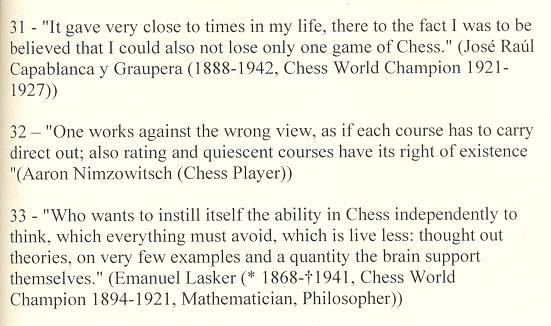
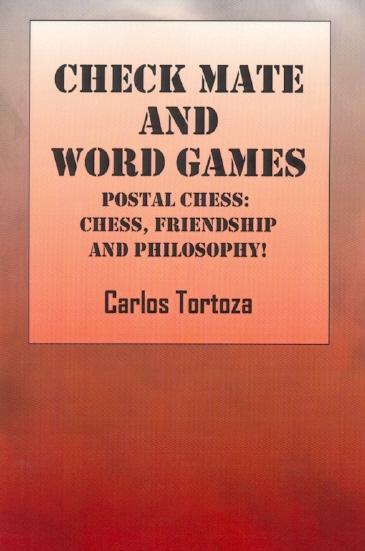
Sourceless quote-dumps are bad enough, but who would bring out a book with such an unmistakable (Germanic) reek of computer translation? A child, perhaps? The back cover provides some biographical information about Carlos Tortoza, who is Brazilian:
‘He is a psychologist and economist, with a postgraduate degree in economic projects, specializing in psychoanalysis. He is an academic professor of psychology, philosophy, sociology and economic business administration.’
(4716)
See too C.N.s 9025 and 10536.
We are grateful to Michael Clapham (Ipswich, England) for permission to reproduce this photograph from his collection:
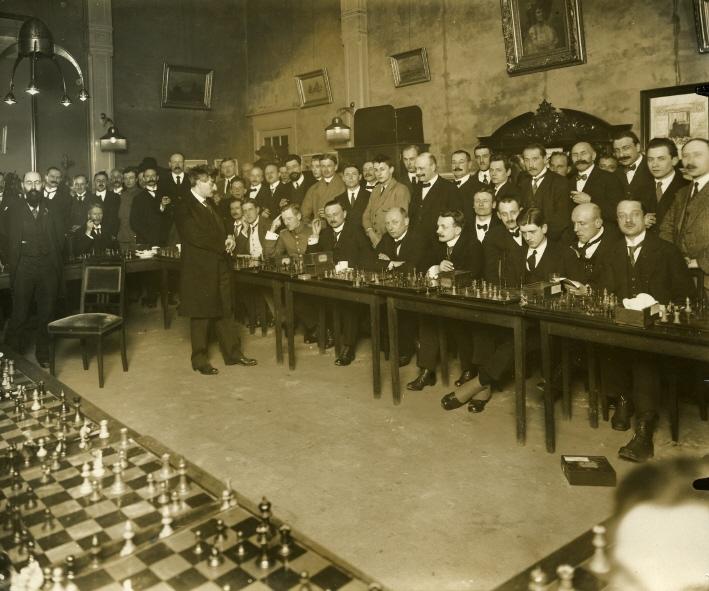
Emanuel Lasker in the Netherlands, January or February 1920
(4791)
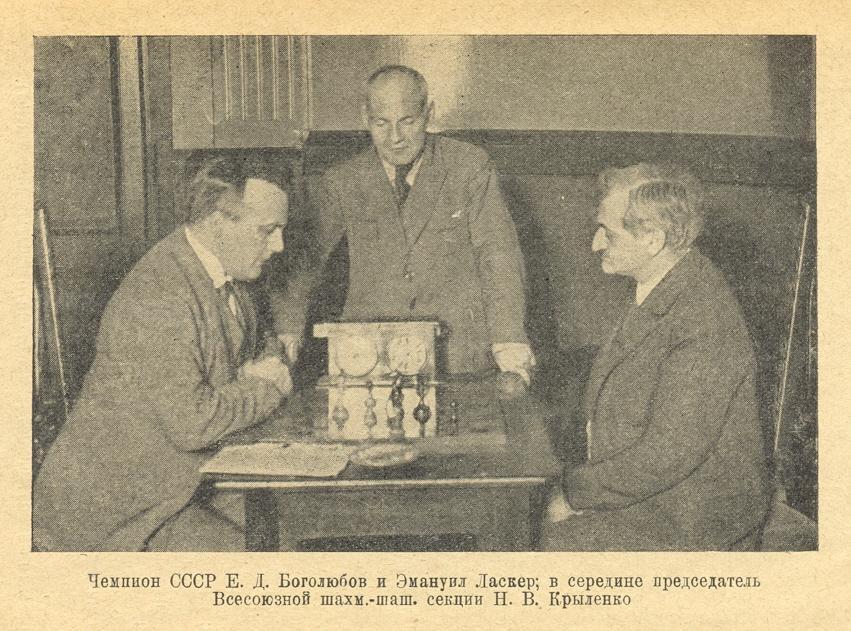
The above photograph (Moscow, 1925) comes from page 27 of Shakhmatnaya pravda by S. Tartakower (Leningrad, 1926). As mentioned in the caption, the person standing between Bogoljubow and Lasker is N.V. Krylenko.
Between 4 March and 28 May 1895 Emanuel Lasker gave a dozen or so lectures at 8 King William Street, London EC, the entrance fee being one guinea. Source: the 1895 BCM, March (page 123), April (page 169), May (page 226) and July (page 298). Early the following year the texts were published by Bellairs & Co., London, under the title Common Sense in Chess. A ‘corrected’ version was brought out in 1917 by David A. Mitchell; it was reissued by Dover Publications, Inc. in 1965.
The book has received high praise. See, for instance, the observations of Harry Golombek on page 33 of Chess Treasury of the Air by T. Tiller (Harmondsworth, 1966), page 182 of A History of Chess (London, 1976) and page 355 of The Encyclopedia of Chess (London, 1977). In the second of those books Golombek commented:
‘One remark alone, on pawns, contains so much wisdom in so little space that it must be regarded as possibly the wisest remark ever made about what is after all the life-blood of the game: “A pawn move without a clearly defined purpose is to be blamed.”’
There has, though, been a dissenting voice regarding Lasker’s book. Pages 141-146 of The Gambit, May 1930 carried an heretical article ‘How Emanuel Lasker refutes his own unsound chess principles by wholesale violations’ by Solomon Hecht. It was reproduced under the title ‘Telling Off the World Champion’ on pages 56-66 of The Fireside Book of Chess by Irving Chernev and Fred Reinfeld (New York, 1949), and Reinfeld was apparently impressed. On pages 138-139 of The Human Side of Chess (New York, 1952) he wrote:
‘Another paradox: Lasker, who had the most sensitive feeling for the impalpable, the imponderable in chess, wrote a book in his youth called Common Sense in Chess. Whether it was a potboiler or a seriously intended work I do not know; but it had a considerable success because it purported to reduce good chess to a small number of common-sense principles. Many years later Solomon Hecht, an ordinary amateur, observed justly that “it is nothing short of astounding that a world[’s] champion a century after [the death of] Philidor should thus presume to crowd this game of infinite resources into the space of a peanut shell”. I agree: it is nothing short of astounding.’
In contrast, Reinfeld wrote admiringly of Common Sense in Chess in his Introduction to the revised edition which he brought out in 1946.
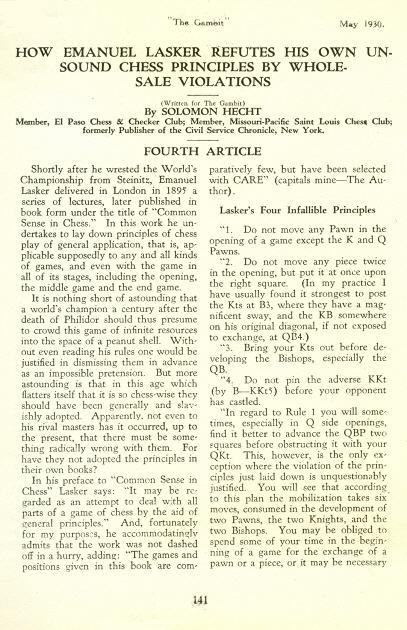
As shown above, the heading to Hecht’s article described him as follows: ‘Member, El Paso Chess & Checker Club; Member, Missouri-Pacific Saint Louis Chess Club; formerly Publisher of the Civil Service Chronicle, New York.’ Other information about him is slender. On page 3 of A Catalog of U.S.A. Chess Personalia (Worcester, 1980) Jeremy Gaige wrote:
‘Then there is the case of the American Chess Bulletin reporting the death in 1927 of Solomon Hecht and that he was buried in Woodlawn Cemetery. The only problem is that a check with the cemetery revealed that it was not Solomon but a Simon Hecht who was then interred, i.e. the American Chess Bulletin buried the wrong person.’
In Chess Personalia A Biobibliography (Jefferson, 1987) the entry for Hecht stated that he died in New York circa 1932, and it is therefore surprising that the privately circulated 1994 edition of the book reverted to circa January 1927 for his death. That edition also added that he was born in New York in January 1870, the source being the 1900 US census.
Hecht wrote many other articles for The Gambit, and some of them will be referred to in a future item.
(4982)

Emanuel Lasker
Emanuel Lasker Biographie eines Schachweltmeisters by J. Hannak (Berlin-Frohnau, 1952) featured a Preface (Geleitwort) by Albert Einstein signed ‘Princeton, NJ, Oktober 1952’. (For Einstein’s handwritten version, see the link provided in C.N. 3533.) Heinrich Fraenkel’s English version of the Hannak book was published in London in 1959 under the title Emanuel Lasker The Life of a Chess Master.
This chronology seems straightforward, but the reality is more complex. Firstly, a Vorwort by Herbert Engelhardt to the German edition (omitted from the English book) noted that Hannak’s volume was originally intended for publication in 1938, to mark Lasker’s 70th birthday. The possibility at one stage of an English translation by Reuben Fine was also mentioned.
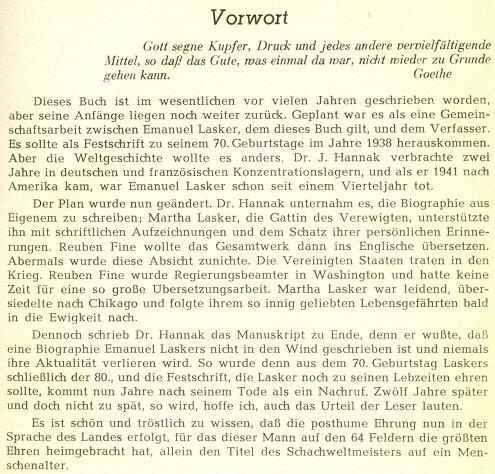
Another complication arises from the following paragraph on page 171 of CHESS, August 1944:
‘New Book on Lasker. Dr Albert Einstein has written a fine introduction to Dr Hannak’s biography of Emanuel Lasker, which Barnie F. Winkelman has translated from the German. The English edition will be published as soon as the paper shortage abates.’
Although 15 years passed before the English book appeared, Einstein’s text was published in English on page 130 of the May 1955 Chess Review. In a footnote Winkelman stated:
‘In 1942, Dr John J. [sic] Hannak had completed his biography of Dr Emanuel Lasker and sent the manuscript to me – in German – with a view to an edition in English. I translated his work into English and, in view of the references to Dr Einstein, suggested that the latter might write an introduction. I wrote to Dr Einstein and received a most courteous reply in which he referred to his old friend and asked for a few days to prepare a fitting foreword to the book. With characteristic care and caution, he also asked for the biography. This I sent to him. Within a week, I received the foreword – in German. I have translated it adequately, I hope. I believe Dr Hannak has embodied this in his biography which was duly published in Vienna [sic] ...’
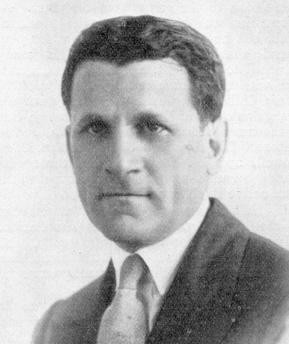
Barnie Frank Winkelman
Winkelman’s translation of the Einstein text differs, of course, from the Fraenkel version in Emanuel Lasker The Life of a Chess Master. On pages 315-316 of that book Fraenkel explained his own involvement by referring to his ‘impatience for an Anglo-American edition of Dr Hannak’s book’; the fact that Winkelman had already undertaken a translation was not mentioned. We recall no reference to Winkelman in Hannak’s book and do not know what became of Winkelman’s complete translation. And why is Einstein’s Geleitwort dated 1952 rather than 1942? Was it a mere case of re-dating to make the text appear more current?
(4995)
Jan Kalendovský (Brno, Czech Republic) sends the following curiosity, dated 1900:
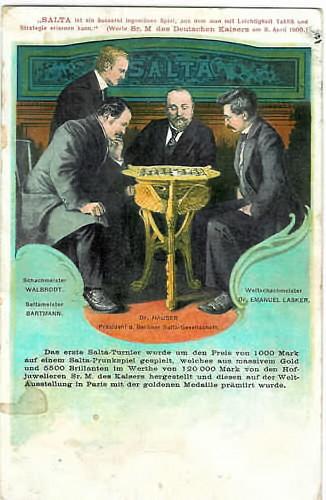
[Afterword: On 18 June 2010 Mr Ralf Gering (Brohltal, Germany) informed us that he is the owner of the above card, which he posted at the BoardGameGeek webpage.]
(5012)
From John Roycroft (London):
‘Do any photographs or good drawings exist, possibly in contemporary Russian sources, of the chessmen used in the 1896-97 world title match in Moscow between Lasker and Steinitz? Moreover, are there any illustrations of the match sponsors and the “playing committee”? My particular interest is in establishing whether or not reports are correct that a chess set was made in Russia to the order of Steinitz.’
(5020)
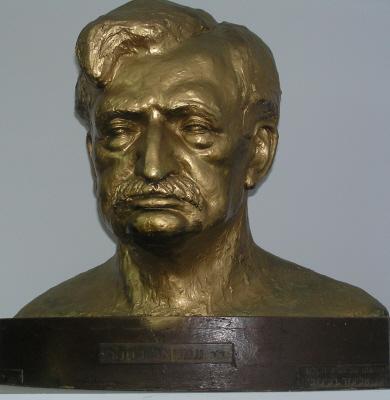
The above photograph of Emanuel Lasker was provided in C.N. 5035 by Avital Pilpel, who wrote:
‘This bust of Emanuel Lasker has been in the Lasker Chess Club in Tel Aviv for the past 50 years or so. The three plaques on the base read (from left to right): “P. (or F.) N. Weber” (presumably the sculptor);“Dr Emanuel Lasker”; “Gift from the Club’s President, Mr Eliezer Rabinowitz”.’
C.N. 5052 added the following item from page 137 of the June 1944 BCM:
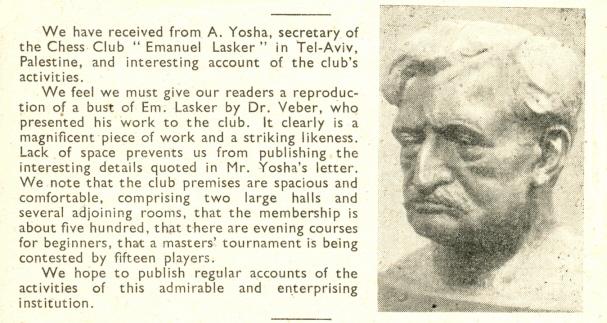
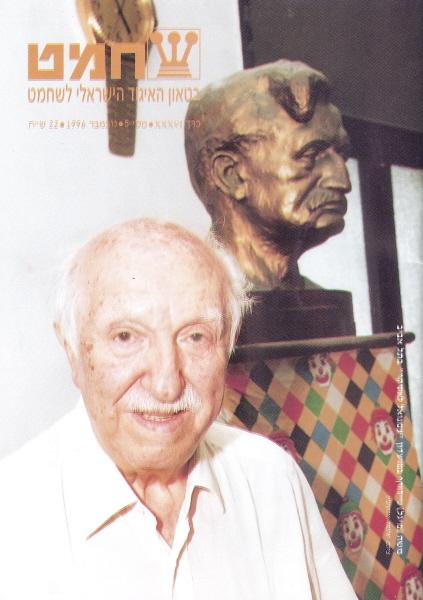
Regarding the Lasker bust, Martin Weissenberg (Savyon, Israel) forwards the front cover of the November 1996 issue of the Israeli magazine Shakhmat and comments:
‘It features Najdorf standing next to the bust of Emanuel Lasker at the Lasker Chess Club in Tel Aviv, and was taken by Shlomo Volkowitz during Najdorf’s last visit to Israel, in Autumn 1996.’
(8372)

The above woodcut of Emanuel Lasker, another piece of work by Erwin Voellmy, was published on page 65 of the Schweizerische Schachzeitung, May 1924. It is similar to an illustration by W.H. Cozens on page 143 of the May 1959 BCM:
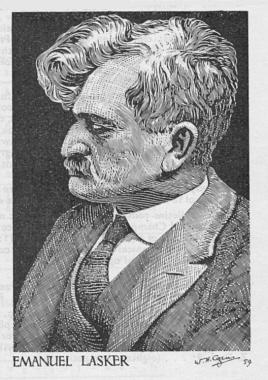
Another picture of Lasker by Cozens appeared on page 323 of the November 1964 BCM:
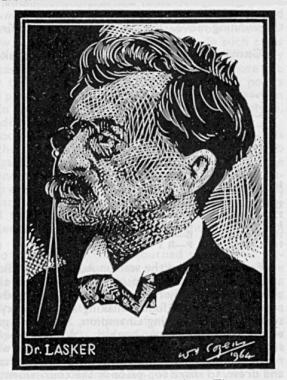
(5059)
The third image in C.N. 5059 was based on a photograph of Lasker on page 81 of the earliest editions of Chess by C.H.O’D. Alexander:
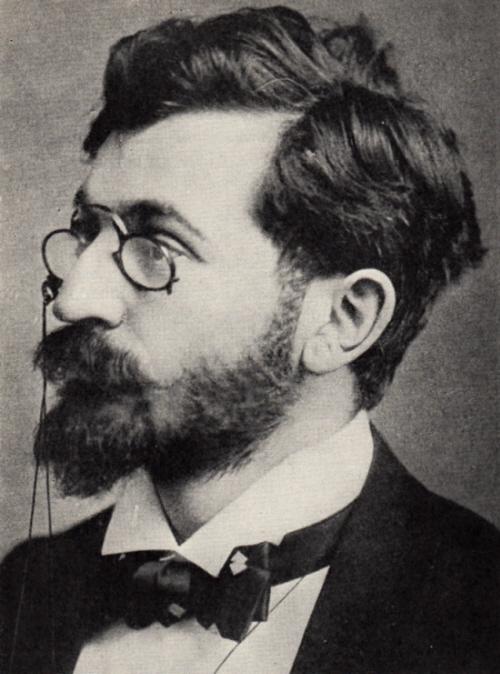
(8644)
Paintings of Emanuel Lasker by L. Nardus and M. Mopp were presented in C.N.s 3715 and 4091 respectively, and the work below was the frontispiece of Lasker’s Uchebnik shakhmatnoi igri (Moscow and Leningrad, 1926):
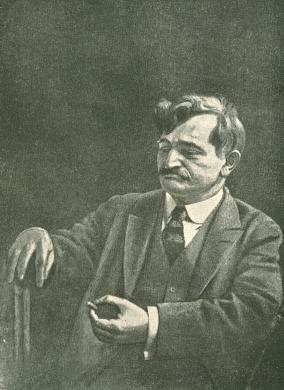
A further painting on which information will be appreciated was on the front cover of the January 1963 Chess Review:
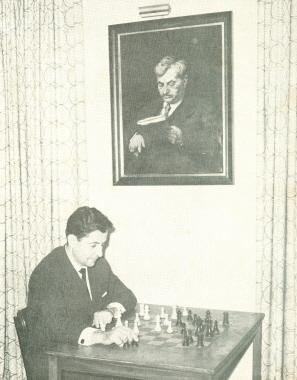
The player at the board is Petar Trifunović, during a visit to the United States. The same painting was on page 61 of the February 1973 Chess Life & Review (obituary of Morris J. Kasper):

(5071)
David DeLucia also mentions that he owns one of the paintings of Lasker featured in C.N. 5071. This is another matter on which full particulars will be presented in his forthcoming book, but he has kindly authorized us to reproduce the illustration below:
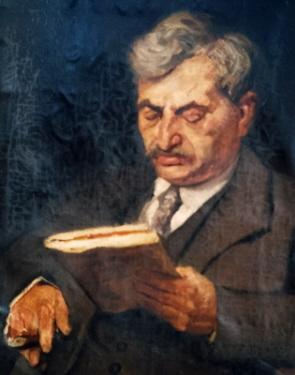
(5103)
See our feature article on Léonardus Nardus.
John Hilbert (Amherst, NY, USA) enquires about a matter discussed on pages 195-197 of our book on Capablanca: Lasker’s allegation that owing to a defective clock he lost 20 minutes during his defeat at the hands of the Cuban at New York on 5 April 1924. We quoted from De Telegraaf of 3 January 1927 Lasker’s strong attack on the tournament organizers in explanation of his refusal to participate in New York, 1927.
Our correspondent asks whether the 1924 clock dispute was public knowledge before Lasker’s article appeared nearly three years later.
(5080)
C.N. 5080 asked whether the clock dispute in the game Capablanca v Emanuel Lasker at New York, 1924 was public knowledge before Lasker wrote about it in De Telegraaf of 3 January 1927. Luca D’Ambrosio (Bolzano, Italy) cites the following from page 74 of Deutsches Wochenschach, 30 April 1924:
‘Auffällig ist eine Mitteilung, die Dr. A. Seitz, der als Zuschauer dem Turnier beigewohnt hat, über die Partie Capablanca-Dr. Lasker macht. Danach wäre die Niederlage L’s die Folge eines Uhrendefekts. L sei infolge dieses Defekts, der zur Folge hatte, daß im kritischen Augenblick beide Uhren gingen, in Zeitnot geraten u. habe das Remis übersehen.’ [Our English translation: ‘A noteworthy report comes from Dr A. Seitz, who attended the tournament as a spectator, regarding the Capablanca-Dr Lasker game. It states that L.’s defeat was the result of a defective clock; owing to that fault, which caused both clocks to be running at the critical moment, Lasker fell into Zeitnot and overlooked the draw.’]
More generally, our correspondent refers to a sentence written by Seitz on page 146 of the May 1924 Wiener Schachzeitung:
‘Dem Turniersekretär konnte man nicht das Lob allzu großer Unparteilichkeit geben.’ [‘The tournament secretary could not be praised for excessive impartiality.’]
Finally, Mr D’Ambrosio quotes a passage from the report about New York, 1924 on page 3 of volume one of Schachjahrbuch 1924 by L. Bachmann (Ansbach, 1925):
‘Über ihre Aufnahme und ihren Aufenthalt haben sich die Turnierteilnehmer sehr günstig ausgedrückt. Selbstverständlich gab es die regelmässigen Klagen über gewisse Rücksichtslosigkeiten einzelner Meister, wie gewöhnlich so auch hier, auch fehlten nicht Beschwerden wegen Parteilichkeit des Turnierleiters von deutscher Seite.’ [‘The participants in the tournament expressed great satisfaction with their welcome and stay. Of course, there were the regular grievances about certain inconsiderate behaviour by individual masters, as is usual and as occurred here too, and there was no lack of complaints of favouritism by the tournament director, from the German side.’]
(5088)
Luca D’Ambrosio submits a further report on the dispute regarding the game Capablanca v Emanuel Lasker, New York, 1924 (from Deutsches Wochenschach, 15 June 1924, page 110):
Our translation:
‘The apparent clock defect in the Capablanca-Lasker game. Dr A. Seitz stated in his tournament reports, among personal attacks on the New York tournament director, N.L. Lederer, that Lasker’s defeat against Capablanca was due to a clock defect, as a result of which at the critical moment both clocks were running and L., who was in Zeitnot, overlooked the draw. Ignoring the personal attacks, we briefly mentioned this information on page 74 on the assumption that an explanation would not be lacking. In a communication Mr Lederer has now drawn to our attention the fact that Dr Seitz did not have access to the playing tables and therefore knew of the matter only by hearsay. “I noticed”, observes Mr Lederer in this respect, “that during the game Dr L. did not press the ‘off’ lever on his clock far enough and that both clocks were running. When play was broken off at six o’clock, we noted precisely the time difference, which was around eight minutes. It should be remarked here that Dr L. was not in Zeitnot at any time. On the contrary, before the end of play C. was in considerable Zeitnot and twice after the piece sacrifice did not make the best moves (Qf3 instead of Qe2 and Nxd6 instead of g4 [sic]). When play resumed at eight o’clock both players were, of course, out of Zeitnot, and the move which, according to Dr L.’s analysis, offered Black the prospect of a draw (Bd5 instead of Qe6) took place long after play had been interrupted ... Dr L. has, of course, never made a remark which could be interpreted as meaning that he lost the game for any reasons other than those having to do with chess, and he spoke about his opponent’s play with the greatest respect; he merely remarked that Qe6 was the losing move and that Bd5 would probably have given him a draw, and analysis will surely bring a final verdict on this.” Mr Lederer goes on to express his regret over the derisive and denigrating comments made by Dr Seitz about the committee and the tournament management, which are as unjustified as they are untrue. He says that this could cause the men whom we have to thank for the organization of the tournament not to repeat their efforts, undertaken purely in the interests of chess, if the result of their work is mean-spirited attacks by people who have enjoyed the hospitality of the Manhattan Chess Club and the Hotel Alamac. In the end, Dr Seitz was requested no longer to enter the premises of the Manhattan Chess Club.’
When the Lasker affair blew up in the United States in January 1927, Lederer wrote as follows regarding the clock incident on page 71 of the March 1927 American Chess Bulletin:
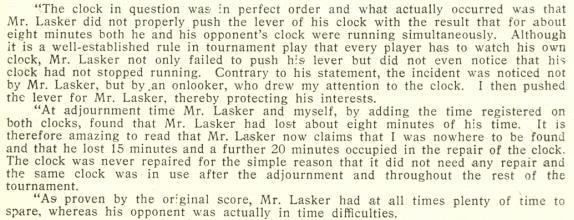
The rules for New York, 1924 were given on pages 27-28 of the February 1924 American Chess Bulletin. The time-limit was 30 moves in the first two hours and 15 moves an hour thereafter. The playing hours stipulated there (13.30-17.30 and 19.30-23.30) were subsequently amended to 14.00-18.00 and 20.00-00.00 (American Chess Bulletin, March 1924, page 49). For Capablanca’s score-sheet of his victory over Lasker see page 80 of A Picture History of Chess by Fred Wilson (New York, 1981).
(5098)
See too Lasker Speaks Out (1926) by Richard Forster.
As noted on page 109 of our book on Capablanca, in June 1920 Lasker abdicated as world champion. A prime source for this information is page 126 of the July-August 1920 American Chess Bulletin, part of which is reproduced below:
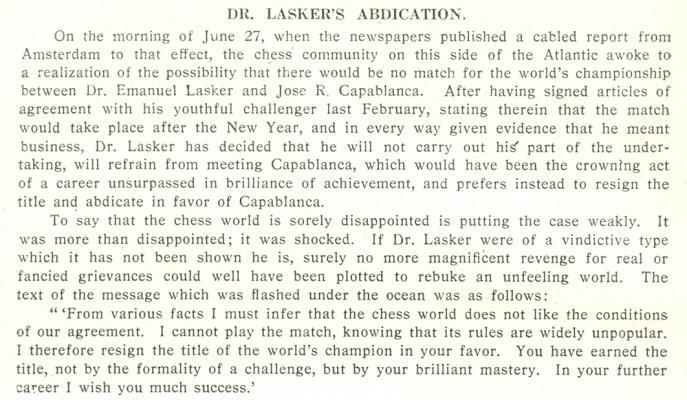
Javier Asturiano Molina notes that a slightly different wording appeared in Lasker’s letter of 18 June 1920 to Capablanca, written from the Hotel Stadt Elberfeld, Amsterdam. It was reproduced on page 214 of The Collected Games of Emanuel Lasker by K. Whyld (Nottingham, 1998).
David DeLucia (Darien, CT, USA) informs us that he owns a letter dated 17 June 1920 written by Lasker to his wife, from Huize Parkzicht in Amsterdam, in which he stated that he had resigned the world title that day. The document will be appearing in a book on Mr DeLucia’s collection which he is currently preparing.
(5102)
In C.N. 5132 Pablo S. Domínguez (Madrid) pointed out Emanuel Lasker’s unusual explanation of the knight move which appeared on pages 5-6 of Lasker’s Manual of Chess (New York, 1927), as well as in later editions of the book:
‘... the knight jumps in making the shortest move that is not a straight one.’
The corresponding text in the earlier German edition, Lehrbuch des Schachspiels, reads:
‘... der Springer macht einen Sprung, nämlich den kürzesten auf dem Schachbrett möglichen Zug, der nicht gerade ist.’
The English volume (page 10) also had this description of the knight’s move:
‘The shortest jump on the chess board is, namely, to take two squares (in the air) in a line or row and one square perpendicularly thereto.’
Pages 171-172 of the 30 July 1893 issue of Emanuel Lasker’s magazine the London Chess Fortnightly quoted some remarks about Gunsberg by Steinitz in the New York Tribune. The context was a dispute over whether Lasker had a right to issue a world championship challenge to Steinitz, and we give merely the start of the latter’s salvo (which Lasker quoted approvingly):
‘Mr Gunsberg is not alone a chess professor, but he also professes to be a philosopher of the so-called “individualistic school”, and he has lectured and written on doctrines which, if I may quote myself, are based on the theory that “one man has rights, but two men have none”. When, however, he applies his egoistic principles to chess affairs, he finds that though he may be unique in the chess world he is not alone in it. For instance, he seems to be possessed of the idea that the championship of the world can only be at stake when he himself is a party in a contest. Thus he played a match with Chigorin for “the championship of the world”, and the whole chess world laughed. He fought another for the title against myself in which he virtually received the odds of the draw and played to take advantage of the odds. The whole chess world might have laughed if – he had won it ...’
(5137)
John Hilbert quotes from pages 130-131 of the Chess Weekly, 18 September 1909:
‘Speaking of the peculiarities of chessplayers, the man who writes the biography of the World’s Chess Champion will face a Herculean task. Our friend Dr Lasker is a most interesting psychological study, and in all that has been written about his personality we have never seen anything even approaching the truth. Sharing the failings of many great men, Dr Lasker measures his capacities in all lines of endeavor by his phenomenal genius in one. He prides himself more on his business abilities and on his knowledge of things miscellaneous than he does on chess, wherein he is admittedly pre-eminent. Tell him that he has an equal in chess and he will modestly admit it, or perhaps mildly debate the question; but tell him that he has an equal in philosophy, in the sciences – or in pinochle – and you may hurt or offend him. His thoughts, sometimes inconsistent, often impractical, but always unique, reflect a vortex of diverse personalities – An Aristotle, A Claudius, A Nero and a George Peabody, rolled into one and inspired to play chess.’
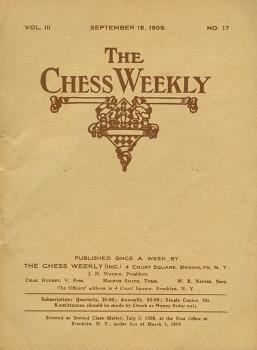
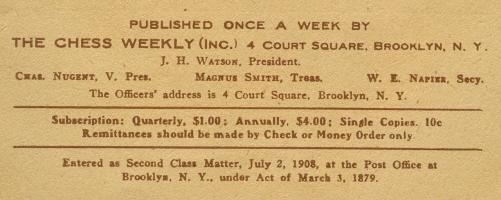
Front cover of the 18 September 1909 issue
Noting that Magnus Smith was listed as the ‘Editor-in-Chief’ of the Chess Weekly on the (inside) mast-head, the names of Nugent and Napier having been removed therefrom the previous month, our correspondent comments:
‘I think that the Smith paragraph is well done and features perhaps the most incisive words written about Lasker’s personality by anyone on this side of the Atlantic, certainly for the time.’
(5146)
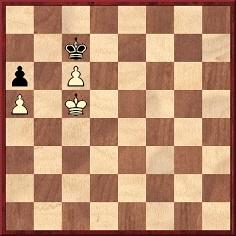
This ending is usually published in books with the caption ‘Fahrni-Alapin’ (see pages 42-43 of A Chess Omnibus), but we are grateful to Anssi Korhonen (Helsinki) for pointing out that the position appeared in Emanuel Lasker’s Common Sense in Chess. Depending on the edition, the page numbers are 108-110, 108-109 or 126-127. The first of these references relates to the original edition of 1896.
Lasker wrote:
‘White has two chances of winning, the one based on his passed pawn, the other on the weakness of the black RP. The black K occupies at present a position of advantage in regard to both. This is changed by the following manoeuvre:
1 K-Q5 K-B 2 K-B4 K-Q 3 K-Q4 K-B 4 K-Q5 K-B2 5 K-B5.
Now the move is changed, and White wins easily; or
4...K-Q 5 K-Q6 K-B 6 P-B7 K-Kt2 7 K-Q7
and mates in a few more moves.’
(5157)
See also The So-called Fahrni-Alapin Pawn Ending.
Emanuel Lasker (simultaneous) – A.B. Yurka and G.
Goldenberg
New York, 25 April 1910
French Defence
1 e4 e6 2 d4 d5 3 Nc3 Nf6 4 Bg5 Be7 5 e5 Nfd7 6 Bxe7 Qxe7 7 Qd2 a6 8 Nd1 c5 9 c3 Nc6 10 f4 b5 11 Nf3 Bb7 12 Bd3 c4 13 Bc2 Nb6 14 Ne3 b4 15 O-O g6 16 Rf2 Qf8 17 Raf1 bxc3 18 bxc3 Qa3 19 Rb1 Qa5 20 Ng4 Ra7 21 Nf6+ Ke7 22 Ng5 h6
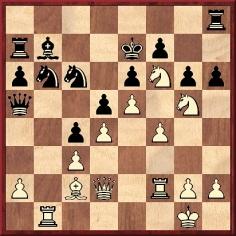
23 Nxf7 Kxf7 24 Bxg6+ Kxg6 25 f5+ exf5 26 g4 Bc8 27 gxf5+ Bxf5 28 Rbf1 Ne7 29 Rxf5 Nxf5 30 Qg2+ Kf7 31 Rxf5 Raa8 32 Nxd5+ Ke6

33 Rf6+ Resigns.
Source: New York Sun, 8 May 1910, third section, page 10.
An unusual mate in three was available at the end: 33 Qg6+ Kxd5 34 Rf6, etc.
(5171)
From page 190 of Modern Chess Strategy by Edward Lasker (London, 1951):
‘I recall a remark which Emanuel Lasker made one day as we were discussing the characteristic differences between the older and the younger generation of chess masters. He said modern tournaments were much harder because the young masters played much more exact chess than was encountered in tournaments up to the great meeting in New York in 1924. He felt that the old masters – Steinitz, Schlechter, Tarrasch, Teichmann, Bernstein, etc. – had played just as deep chess as can be found in any modern game, perhaps even deeper because they played more slowly, but that they lacked the accuracy with which present-day masters took advantage of the slightest positional superiority.’
(5189)
From Olimpiu G. Urcan (Singapore) comes this sketch from the Sunday Inter Ocean (Chicago) of 27 December 1896, page 20:
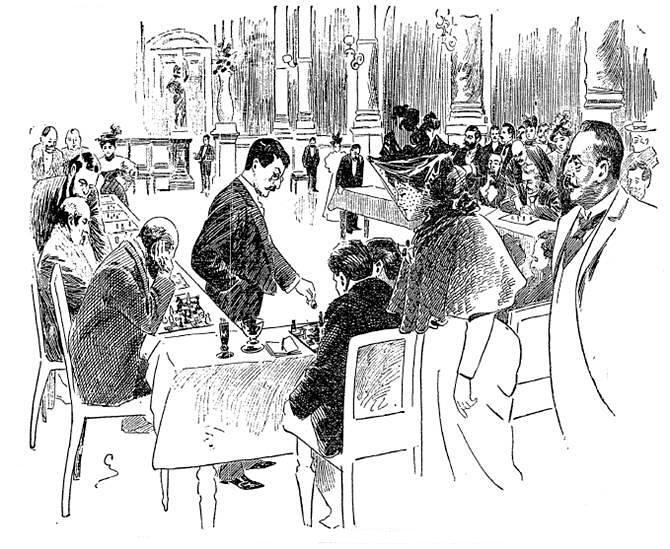
Our correspondent adds that the caption was ‘Lasker, the chess expert, playing several games at the same time at the Kaiserhof, Berlin’, it being specified that the drawing was taken from Zur Guten Stunden.
(5194)
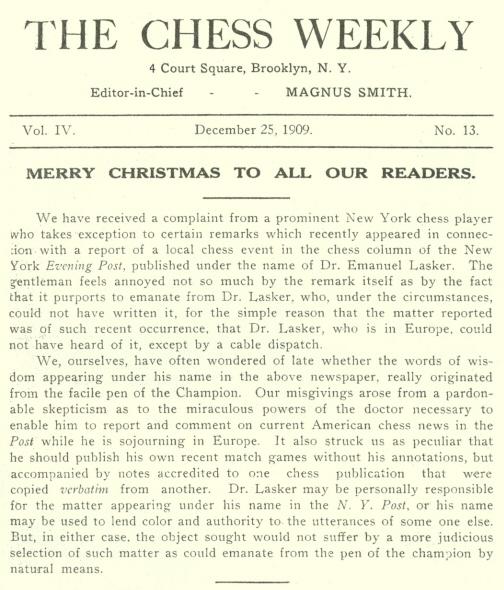
What facts are available regarding this suggestion that Emanuel Lasker’s column in the New York Evening Post may have been ghosted?
(5272)
Steve Wrinn (Homer, NY, USA) draws attention to the following remark by Emanuel Lasker:
‘Bogoljubow, it seems, believes in the art of subjecting one person to the will of another by some extraordinary power. Can such an art exist? Decidedly no. If it did exist and someone set himself up as a teacher of this art, he would have the whole world for his customers and yet derive no advantage therefrom, because his pupils would hypnotize him and then suggest to him the return of the tuition fee.’
This comes from page 11 of Lasker’s book Games Played in the Return Match for the World’s Championship (London, 1935), and for the context we reproduce below the full page:

(5282)
See also Chess and Hypnosis, which includes the following:
See too page ix of Bled 1931 International Chess Tournament (Yorklyn, 1987), in a 1976 article by Flohr translated from 64:
‘This time, Nimzowitsch said that “Alekhine has hypnotized all of us”. But this was not original, since both before and after Alekhine all world champions “have hypnotized and will hypnotize”.’
Our feature article also has the following:
Pages 170-171 of Kings, Commoners and Knaves quoted the following by Tarrasch in his book on the St Petersburg, 1914 tournament (page 168 of the German original and page 238 of the English translation):
‘Lasker appears to exert a certain hypnotic influence upon many opponents, for it is difficult to explain how warriors accustomed to victory, when they have come into the advantage against him, suddenly play the game for a loss.’
C.N. 2516 reproduced a letter (written in Moscow on 23 April 1936) from Lasker on pages 357-358 of the 14 May 1936 issue of CHESS in which he mentioned that Tarrasch had also made a hypnotism reference to him on page 193 of Die moderne Schachpartie, (Leipzig, 1916):
This was the fifth game of the Lasker v Janowsky world championship match (Berlin, 1910).
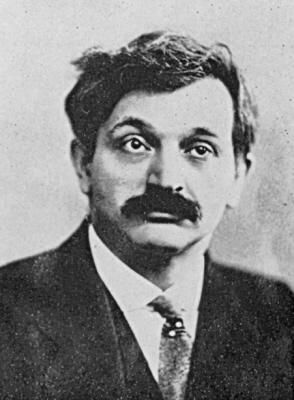
Emanuel Lasker
From page 143 of Combinations The Heart of Chess by Irving Chernev (New York, 1960):
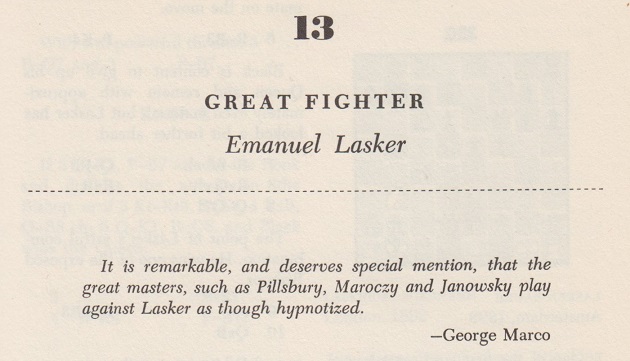
Chernev included Georg Marco’s observation in a number of books, having featured it as the ‘thought for the month’ on the inside front cover of the November 1954 Chess Review.
No source was ever offered, but below is Marco’s presentation of Janowsky v Lasker, Paris, 1900 on pages 149-150 of the July 1900 Wiener Schachzeitung:
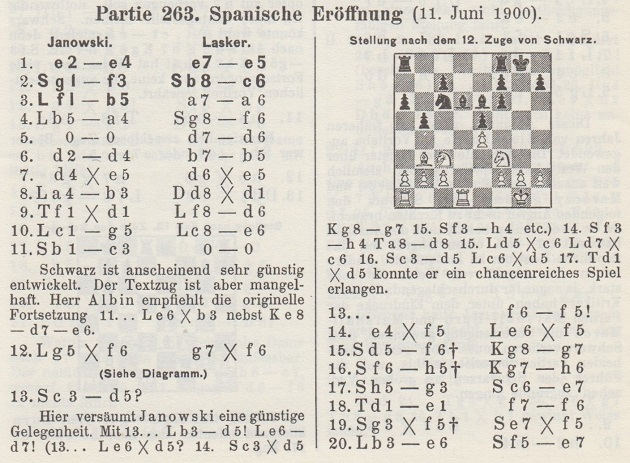
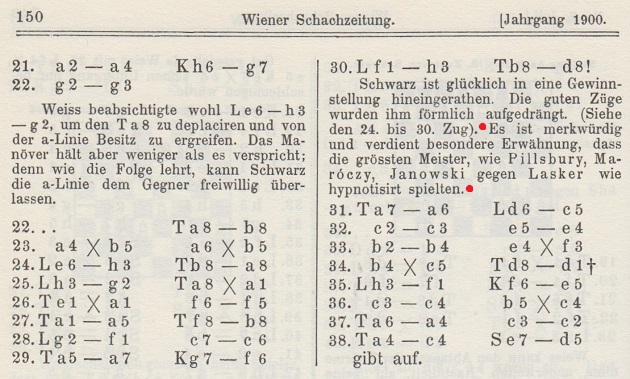
1 e4 e5 2 Nf3 Nc6 3 Bb5 a6 4 Ba4 Nf6 5 O-O d6 6 d4 b5 7 dxe5 dxe5 8 Bb3 Qxd1 9 Rxd1 Bd6 10 Bg5 Be6 11 Nc3 O-O 12 Bxf6 gxf6 13 Nd5 f5 14 exf5 Bxf5 15 Nf6+ Kg7 16 Nh5+ Kh6 17 Ng3 Ne7 18 Re1 f6 19 Nxf5+ Nxf5 20 Be6 Ne7 21 a4 Kg7 22 g3 Rab8 23 axb5 axb5 24 Bh3 Ra8 25 Bg2 Rxa1 26 Rxa1 f5 27 Ra5 Rb8 28 Bf1 c6 29 Ra7 Kf6 30 Bh3 Rd8 31 Ra6 Bc5 32 c3 e4 33 b4 exf3 34 bxc5 Rd1+ 35 Bf1 Ke5 36 c4 bxc4 37 Ra4 c3 38 Rc4 Nd5. According to pages 60-62 of Samuel Rosenthal’s Paris, 1900 tournament book, a few additional moves were played: 39 h4 h5 40 g4 fxg4 41 Kh2 Rxf1 42 White resigns.
Around the same time, Miron James Hazeltine also referred to hypnosis in connection with Lasker and the Paris tournament, on page 398 of the New York Clipper, 30 June 1900:
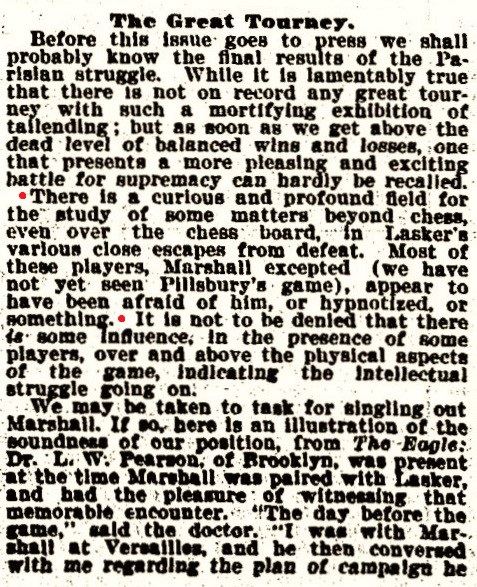
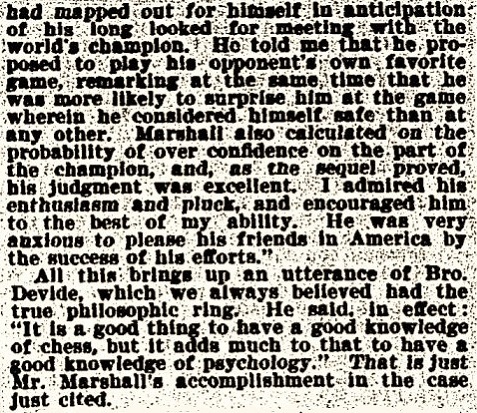
(10546)
More information is sought on this game:
Allies – Emanuel Lasker
Berne, 1919
Ponziani Opening
1 e4 e5 2 Nf3 Nc6 3 c3 d5 4 Qa4 dxe4 5 Nxe5 Qd5 6 Nxc6 bxc6 7 Bc4 Qd6 8 O-O Ne7 9 Qb3 Qg6 10 Re1
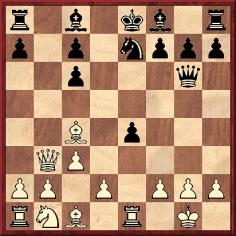
10...Bh3 11 g3 Rd8 12 d4 Nd5 13 Nd2 f5 14 Nf3 Bd6 15 Bg5 Qh5 16 Bxd8 Qxf3 17 Bf1 Bxf1 18 Kxf1 e3 19 Qc2 Kxd8 20 Kg1 f4 21 White resigns.
Source: American Chess Bulletin, November 1919, page 249.
The Bulletin did not name the allies and merely said that the game had been played ‘recently’. We have not found the score in the Schweizerische Schachzeitung.
On page 7 of the January 1920 issue of the American Chess Bulletin Hermann Voigt of Philadelphia stated that Lasker’s 10...Bh3 was questionable, as it could have been met by 11 Bxf7+ Qxf7 12 Qxf7+ Kxf7 13 gxh3, after which the e-pawn cannot be saved.
(5286)
‘Schach in seiner gegenwärtigen Gestalt wird bald den Tod des Remis erleiden’, wrote Emanuel Lasker in his booklet Mein Wettkampf mit Capablanca (see pages 32-33 of the 1926 edition). The English translation on page 249 of the July 1921 BCM was: ‘Chess in its present form will die the death of the draw.’
For some comments by Capablanca, made while he was still world champion, see Capablanca on Moscow, 1925, as well as C.N. 4228. The latter item reproduced a remark by him written on 15 November 1925:
‘Chess is becoming so easy to play that very soon there will be several unbeatable players.’
It may be wondered when the Cuban first formed such a view, and one oddity, currently inexplicable to us, is a letter from C.Y.C. Dawbarn of Liverpool on pages 184-185 of the May 1922 BCM. It began:
‘In the course of his match with Dr Lasker, Señor Capablanca hazarded the opinion that chess was in fact exhausted; that, as in billiards or croquet, other reasons rather than the game itself determined the issue ...’
For his part, Capablanca stated a couple of months later:
‘I have been quoted as saying that chess has reached its limit. I never said anything of the kind. Somebody else made some such remark, and even he was misquoted.’
Source: The Times, 19 July 1922, page 15.
(5437)
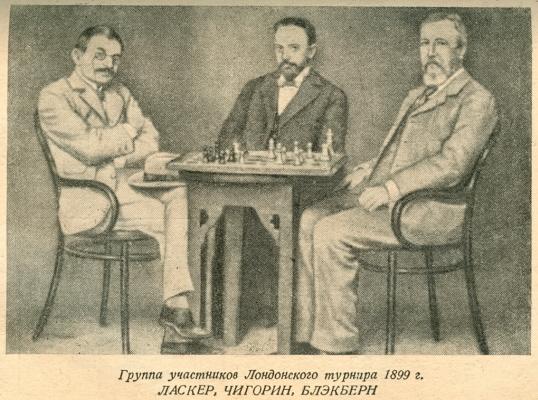
This picture comes from page 113 of N.I. Grekov’s 1952 monograph in Russian on Chigorin. Does any reader have a copy of better quality?
(5509)
Regarding pages 111-112 of Tarrasch’s book on his 1908 world championship match, Der Schachwettkampf Lasker-Tarrasch (Leipzig, 1908), Scott Thomson (New York) writes:
‘Tarrasch states that he planned to play a training match with a chess master, but that at the last moment the master failed to show up, thus depriving Tarrasch of needed practice and contributing to his very poor start to the match. Tarrasch is quite bitter about what he sees as a betrayal. Do you know the identity of this master?’
This matter was touched on by Emanuel Lasker in the New York Evening Post of 24 October 1908:
‘First, Tarrasch wrote that Düsseldorf has an ocean climate, that the sea winds upset him; then, that at the commencement of the match, he had not had his full force, because both Schlechter and Rubinstein failed, as they had promised, to practise with him; then, that I was lucky.’
See C.N. 1688 (on pages 188-189 of Chess Explorations), as well as page 325 of Siegbert Tarrasch Leben und Werk by Wolfgang Kamm (Unterhaching, 2004).
The photograph below is the frontispiece to The Championship Match: Lasker v Tarrasch by L. Hoffer (London, 1908):
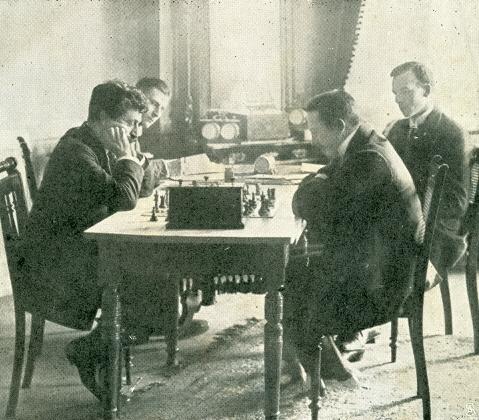
Emanuel Lasker and Siegbert Tarrasch
(5517)
From Ola Winfridsson (Cambridge, England):
‘To judge from the photograph of Lasker and Tarrasch in C.N. 5517, the players are not keeping score of the game. Instead, that seems to be the task of the two men in the background. When did it become customary for the players themselves to keep score of the game? Was there a difference between tournaments and matches?
(5532)
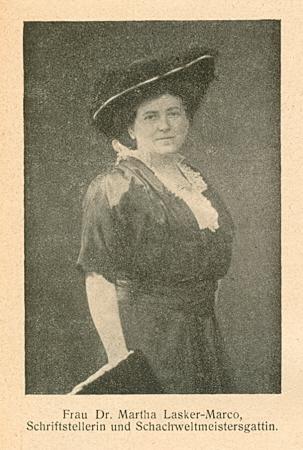
Source: Page 502 of Die Hypermoderne Schachpartie by S. Tartakower (Vienna, 1924).
(5563)
Two pairs of self-contradictions from Reuben Fine, as given in C.N. 1424:
On page 37 of the November 1953 CHESS Irving Chernev pointed out these statements by Fine:
The other example was shown by us on page 10 of CHESS, October 1976:
(5597)
From Unintelligible Chess Writing:
The leading purveyor of psycho-bosh is, of course, Reuben Fine, an individual whose output has often been discussed in Chess Notes. However, an unsung hero in the domain is Cary Utterberg, the author of The Dynamics of Chess Psychology (Dallas, 1994). The following passage from page 106 is wholly typical:
‘All this may be summed up by the hypothesis that Lasker had achieved an existential recognition of strategic masking – that he unconsciously sensed the inadequacy of maintaining the inelastic outlooks characteristic of both idealism and skepticism.’
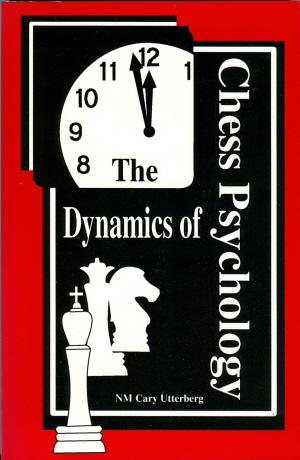
Pierre Bourget (Quebec, Canada) points out this pair of photographs of Alekhine and Bogoljubow, with Emanuel Lasker (Berlin, 1929):
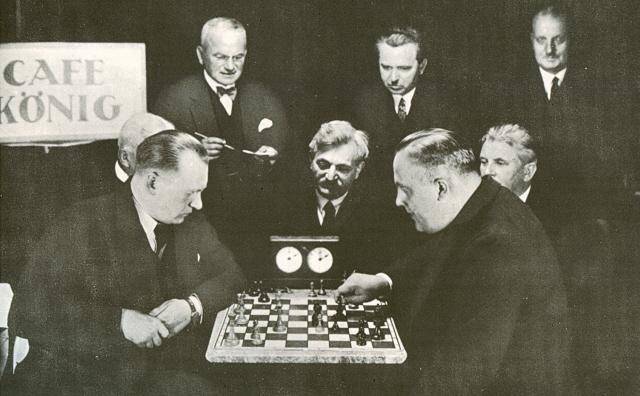
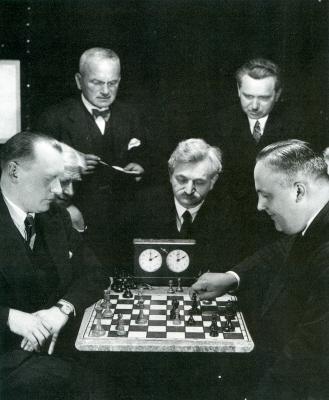
They were published respectively on page 75 of Umkämpfte Krone by R. Stolze (East Berlin, 1986) and page 51 of Schach 2000 Jahre Spiel-Geschichte by R. Finkenzeller, W. Ziehr and E.M. Bührer (Aarau, Stuttgart, 1989).
Can the other persons be named? The man standing on the left also appeared with Alekhine and Bogoljubow in a photograph on page 191 of Grandmasters of Chess by Harold C. Schonberg (Philadelphia and New York, 1972).
(5667)
Alan McGowan identifies the man standing on the right as Ehrhardt Post (1881-1947). We add below a photograph of Post from page 12 of the 1 January 1942 issue of Deutsche Schachblätter:
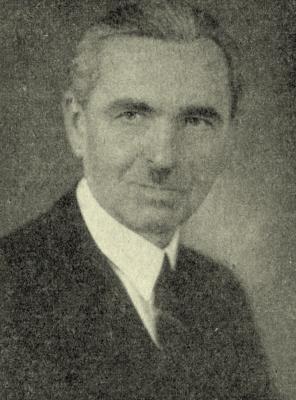
(5697)
from page 24 of Famous Chess Players by Peter Morris Lerner (Minneapolis, 1973):
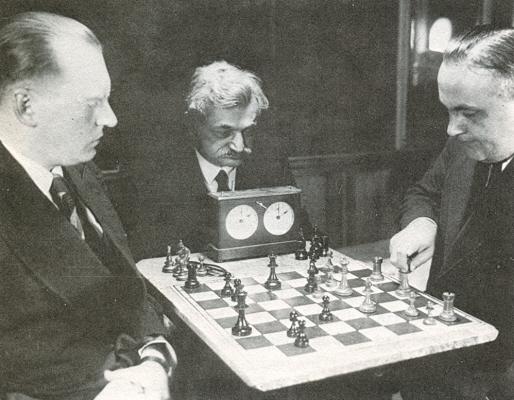
(6312)
Albert Silver (Rio de Janeiro, Brazil) points out some film footage of the occasion, entitled ‘Campionato di scacchi a Berlino’.
(7724)
C.N. 5667 referred to this photograph on page 191 of Grandmasters of Chess by Harold C. Schonberg (Philadelphia and New York, 1972), mentioning that the man behind the players remains nameless:
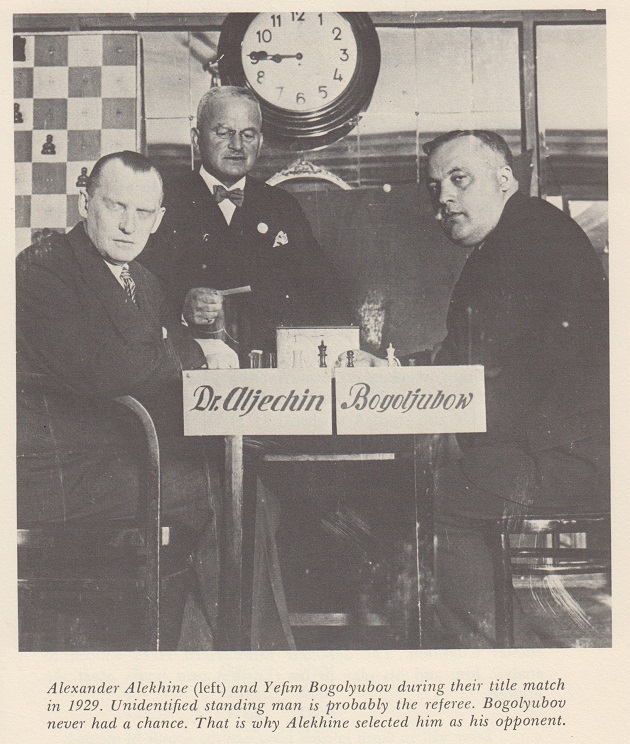
Page 8 credited the picture to Burt Hochberg. Although Alekhine’s eyes seem closed, it may be a matter of photographic exposure, given the following on page 79 of Umkämpfte Krone by Raymund Stolze (East Berlin, 1986):
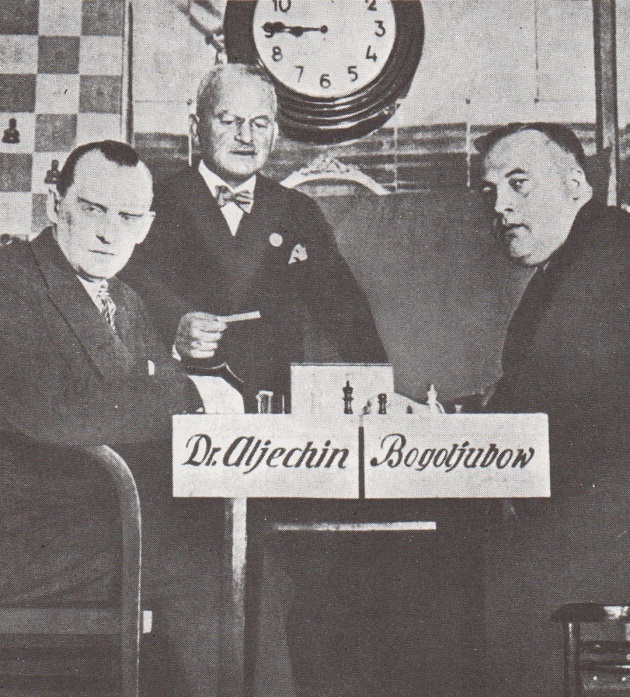
Can the position on the board and/or on the demonstration board be identified?
(11355)
On the basis of a more generously cropped version, Alan McGowan points out that the photograph under discussion shows the 12th match-game, played in Berlin on 11-12 October 1929:
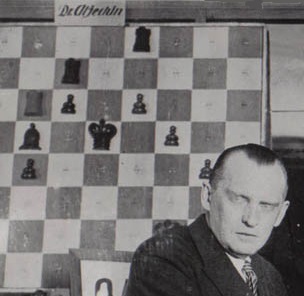
The pawn chain is white.
(11359)
Peter Anderberg (Harmstorf, Germany) identifies the man standing between Alekhine and Bogoljubow as P. Matzdorff, a board member of the Berliner Schachgesellschaft, as shown in this photograph on page 13 of Das internationale Schachmeisterturnier zur Hundertjahrfeier der Berliner Schachgesellschaft by Kurt Richter (Berlin, 1928):

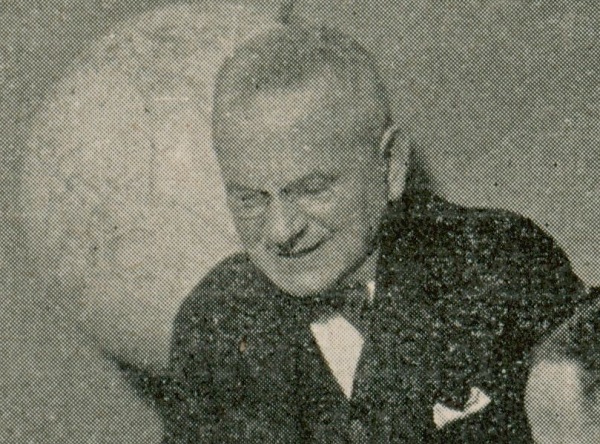
(11760)
The section on Lasker in Réti’s Masters of the Chess Board (London, 1933) suggested that the former world champion ‘often deliberately plays badly’ (page 64). That claim is well known, but we wonder about this passage, regarding Réti himself, on page 173 of B.J. Horton’s Dictionary of Modern Chess (New York, 1959):
‘Réti viewed chess as a struggle between two personalities and as his biographer, Horace R. Bigelow, stated, Réti “often deliberately made bad moves, or inferior moves, if in his judgment these tended to lure his opponent to destruction”.’
(5679)
See also C.N. 6889.
Richard Réti’s remark that Emanuel Lasker ‘often deliberately plays badly’ was given in the section on the former world champion in Masters of the Chess Board (London, 1933); on page 124 of the German edition (Mährisch-Ostrau, 1930) the wording was ‘Lasker spielt oft absichtlich schlecht’. See too pages 404-405 of A Chess Omnibus, as well as C.N. 6889. We should like to give the full text of Réti’s original article (‘published after the New York tournament of 1924’).
A detailed study of Lasker’s play has just been published, John Nunn’s Chess Course (London, 2014), and it is unmissable.
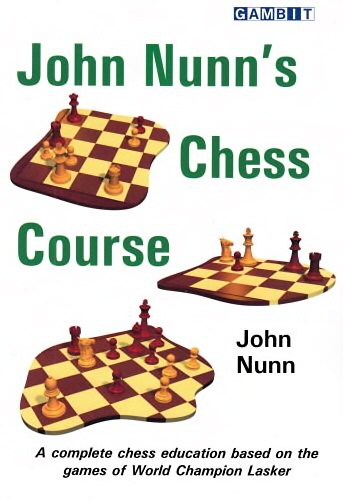
In his Introduction (page 7) Nunn writes:
‘... the myth has developed that many of Lasker’s wins were based on swindles, pure luck or even the effect of his cigars. In reality, there was nothing mystical or underhand about his games; they were based on a deep understanding of chess, an appreciation of deceptive positions and some shrewd psychology. Another myth for which there seems no real evidence is that Lasker deliberately played bad moves in order to unsettle his opponents. Certainly Lasker played bad moves, as all chessplayers do from time to time, but the point which struck me when analysing his games was how often he adopted a safety-first strategy. Lasker was a great fighter and had a strong will to win, but his winning efforts hardly ever crossed the boundary into recklessness; in almost every case, he played moves that appeared provocative but were no worse than the alternatives, with the important difference that they were more likely to induce a mistake.’
(8660)
Concerning Réti’s claim that ‘Lasker often deliberately plays badly’, the idea was rejected on pages 18-19 of Benko and Hochberg’s The Psychology of Chess:


The book’s coverage of Lasker v Tarrasch, Mährisch-Ostrau, 1923 included the following on page 20:
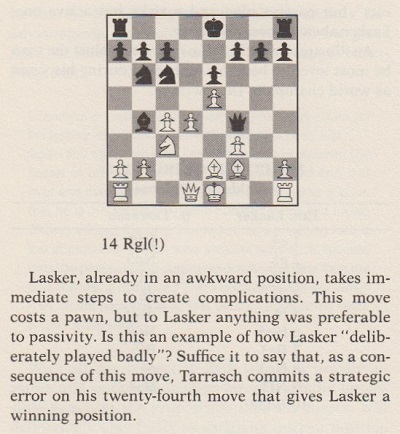
Pages 286-287 of the Australasian Chess Review, 8 October 1936 published Lasker v Levenfish, Moscow, 1936, introduced thus:
‘Not often does one find an out-and-out Lasker game as described by Réti. Here is one that Réti would have seized on with shrieks of joy; the whole game pans out just as Réti would have it. First of all, the deliberately bad play, then the crisis when Lasker totters on the brink of the abyss, followed by the superb resourcefulness that upsets his opponent’s morale, culminating in the final collapse which makes Lasker the victor. It is all here, in this game.’
Levenfish’s annotations in the tournament book do not support the claim that Lasker deliberately played badly in that game (1 e4 c5 2 Nc3 Nc6 3 f4 e6 4 Be2 d5 5 d3 Nge7 6 Nf3 Nd4 7 O-O Nec6 8 Qd2 Be7 9 Bd1 O-O 10 Qf2 a6 11 Re1 Bf6 12 Ne2 dxe4 13 Nexd4 e3 14 Bxe3 cxd4 15 Bd2 Qd5 16 Qg3 Bd7 17 Ne5 Rfd8 18 c4 dxc3 19 bxc3 Be8 20 Bc2 g6 21 d4 Bg7 22 h4 Rac8 23 Be4 Qd6 24 Rad1 b5 25 h5 b4 26 hxg6 hxg6 27 Re3 bxc3 28 Bxc3 Nxe5 29 fxe5 Bxe5 30 Qh4 Rxc3 31 Rxc3 Bxd4+ 32 Kh1 Ba4 33 Rdd3 Bb5 34 Bxg6 fxg6 35 Rh3 Qd7 36 Rcg3 Bd3 37 Rxd3 Resigns).
(9684)
An observation by Purdy on page 43 of the March 1960 Chess World:
‘I have never believed that Lasker played designedly bad moves in the opening. I think he played designedly rapid moves – to conserve time – and it naturally turned out fairly often that they were not the best. And he would vary from “the book” if he thought a move had a good chance of turning out just about as good as the “book” move.’
(9837)
From Ray Johnstone (Nedlands, WA, Australia):
‘Did Steinitz really lose on time in game six of his return match (1896-97) with Lasker, a loss rejected by Lasker? After 48 Kb2 Alex Dunne wrote on page 111 of 2010 Chess Oddities (Davenport, 2003):
“Steinitz exceeded the time limit at this point, but Lasker refused to win in this fashion and allowed Steinitz to play on.”’
Readers’ assistance in building up a digest of contemporary accounts will be appreciated. Here are two reports, the first of which corroborates the above quote:
‘48 Kc1-b2. Hier überschritt Steinitz die Bedenkzeit, Lasker proponirte aber Fortsetzung der Partie, und so wurde sie unter Zustimmung des Comités am nächsten Tage in folgender Weise zu Ende geführt.’
Source: Deutsche Schachzeitung, January 1897, page 10.
In contrast, page 8 of the 15 January 1897 issue of La Stratégie stated that the game was adjourned after 47...Rc8 and that the following day Steinitz was indisposed and did not appear. Instead of forfeiting Steinitz, the Committee allowed him to continue play the next day but one:
‘La partie a été ajournée ici et le lendemain M. Steinitz, malade, ne s’est pas présenté pour la continuer. Le Comité au lieu de lui compter la partie perdue l’a autorisé à la finir le surlendemain ...’
(5687)
From Michael Clapham:
‘I have a typescript of a book on the second world championship match between Lasker and Steinitz, although no book was ever published on this match. The title page states that the games were taken from Deutsches Wochenschach with annotations by Siegbert Tarrasch. I do not know who compiled the typescript, but there are the occasional “Translator’s Notes” which may provide some clues.’
Our correspondent has provided sample pages.
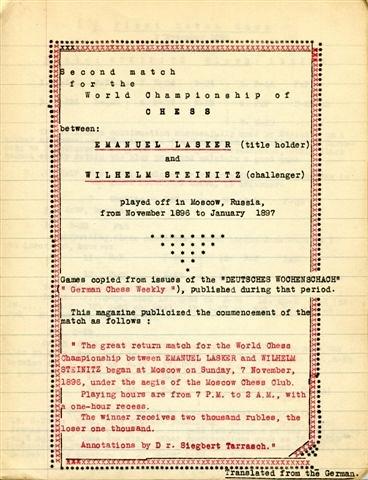
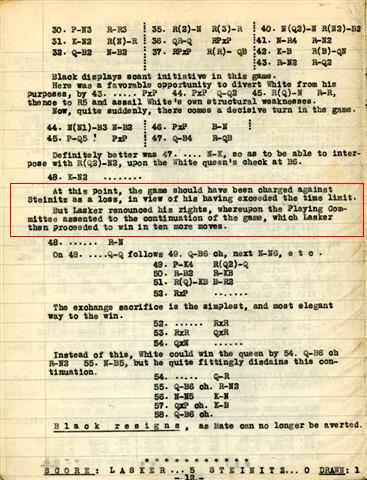
(5691)
From an interview with Helmut Pfleger on page 98 of the 5/2008 New in Chess:
‘What is the best chess truth you ever heard?
What Siegbert Tarrasch said to Emanuel Lasker before their world championship match in Düsseldorf 1908: “For you, Dr Lasker, I have only three words: ‘Schach und Matt!’” Then he lost horribly, excusing himself partly because of the sea climate there.’
How far back can the ‘Schach und Matt’ story be traced? It appeared on page 118 of Emanuel Lasker Biographie eines Schachweltmeisters by J. Hannak (Berlin-Frohnau, 1952):
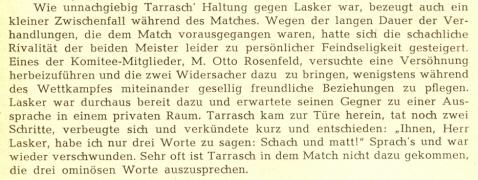
Below is the English version, from page 130 of Hannak’s Emanuel Lasker The Life of a Chess Master (London, 1959):
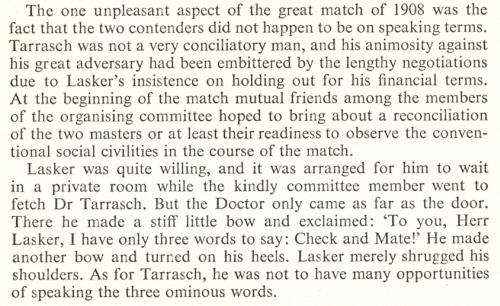
The ‘sea air’ matter was discussed on pages 188-189 of Chess Explorations and in C.N. 5517. We wonder whether Tarrasch gave any further explanation or apology for his claim to have been affected by the sea air in Düsseldorf, which is roughly 180 kilometres from the coast.
Below is a report on page 289 of the September 1908 Deutsche Schachzeitung.
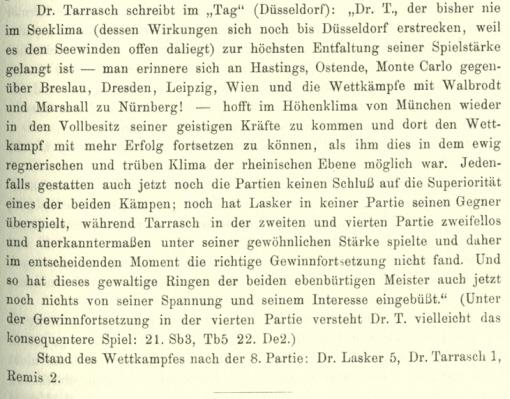
(5707)
Concerning the ‘sea air’ story, see also C.N.s 5724, 9369, 10017 and 10095, as gathered in our feature article Siegbert Tarrasch.
Further to the Tarrasch-Lasker story, we note the following variation on a theme: a passage by Saint-Amant in the course of his bitter public dispute with Staunton. It comes from page 40 of Le Palamède, January 1845:
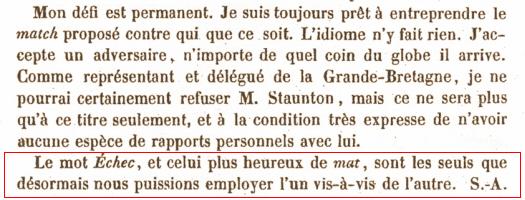
(5719)
Olimpiu G. Urcan submits three sketches featuring Lasker, Chigorin, Pillsbury and Steinitz (the participants at St Petersburg, 1895-96). The illustrations are taken from the New York Tribune chess column of, respectively, 8 December 1895, 5 January 1896 and 12 January 1896.
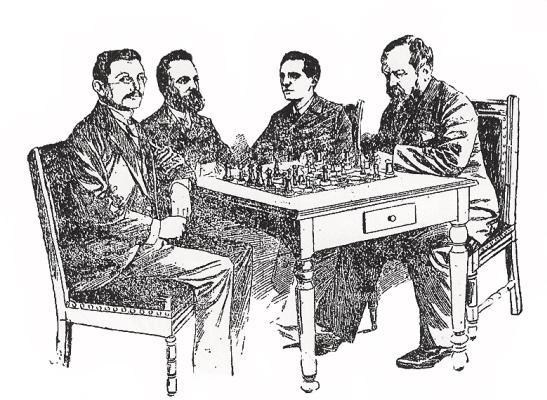
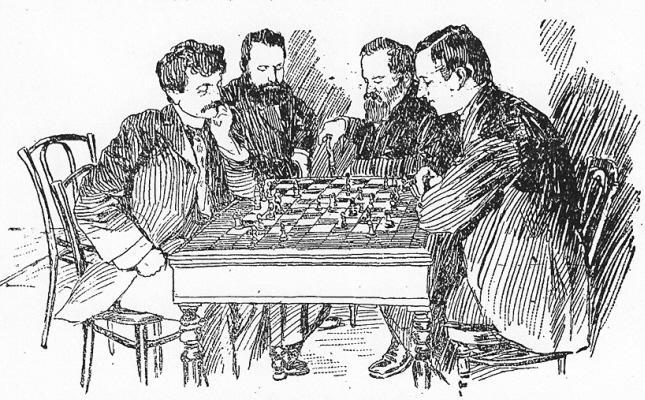
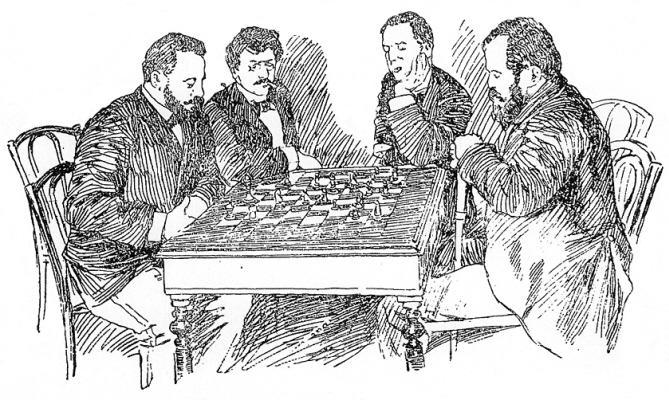
(5713)
Olimpiu G. Urcan provides eight sketches published in the Pall Mall Gazette, 14 July 1899:
(5729)
Our feature article on the event, London, 1899 Pen-portraits, has, in addition to a group photograph, a translation of an article by ‘André de M.’ from pages 210-213 of La Stratégie, 15 July 1899. The first two paragraphs:‘It would, I think, be difficult to imagine two men more completely dissimilar than Lasker and Janowsky. Nothing disturbs Lasker; his shirt, his clothes are the least of his worries. He is hungry; he goes to the sideboard and returns with a bread roll, which he eats with gusto while continuing his game. His legs are in his way; he puts them over one of the arms of his chair and continues to play, smoking strong cigars; when he reflects deeply he blows the smoke through his moustache with a characteristic grimace.
Janowsky, by contrast, is correctness personified. Seated before his board, he remains almost totally immobile. With a dazzling shirt, Turkish cigarettes, ice-cold lemon-squash, which he sucks through a straw, he is a refined, sensitive player par excellence, a sybaritic player who may lose merely because of a rose-leaf being crumpled.’
Lonnie Kwartler (Chester, NY, USA) notes misprints in the pages of Lasker’s Lehrbuch des Schachspiels reproduced in C.N. 5924: ‘Mares’ should read Marco, and in the next diagram White’s king is missing, from h1.
The review of the Lehrbuch on page 318 of the July 1926 BCM commented, ‘There are unfortunately a large number of misprints, which will require correction in a second edition.’ Later versions did indeed make improvements. However, while including such corrections, the English-language edition of Lasker’s Manual, first published in 1927, introduced new problems, and we look at one of them now.
The victim of a famous Alekhine brilliancy (New York, January 1924) was named as Kußmann (i.e. Kussmann) by Lasker in his Lehrbuch (see either page 104 or page 108). In the English edition (page 137) it came out as ‘Kubmann’, i.e. with apparent confusion between the Eszett (ß) and the letter b. The spelling ‘Kubmann’ persisted in subsequent editions of Lasker’s Manual.
(5930)
For further details about the Alekhine game in the above item see Alexander Alekhine Miscellanea.
From Harrie Grondijs (Rijswijk, the Netherlands):
‘On pages 24-25 of the second edition of my small book Four Endgame Studies by Emanuel Lasker (Rijswijk, 2008) I wrote that the Akademisches Monatsheft für Schach, May-June 1908 mentioned a talk by Dawid Przepiórka which I believe made it into print only in the Berliner Lokalanzeiger, although I have not seen what that newspaper published. I also noted that the talk was criticized by Johann Berger on pages 115-119 of the April 1909 Deutsche Schachzeitung. Berger referred to the principle of “eindeutige Beziehung”, which may be translated as “one-to-one relationship” and is not far removed from “conjuguées”. It is not clear to me whether Przepiórka used that particular phrase or whether Berger introduced it in his review.
Page 31 of my book gave the first use of the word “corresponding” in this context, from the start of a feature by C.D. Locock on pages 396-399 of the September 1892 BCM:
Finally, on page 34 I reproduced te Kolsté’s table with corresponding squares, from page 59 of the March 1902 Tijdschrift van den Nederlandschen Schaakbond.’
With regard to Przepiórka’s talk, can a reader trace what the Berliner Lokalanzeiger published?
(6011)
For further information on this topic see Marcel Duchamp and Chess.
Further to a correspondent’s remarks in C.N. 5998 about the signature on an engraving of Staunton, we note that the picture was published in the Chess Monthly Portrait Gallery on page 193 of the March 1890 issue and that the following month (page 225) an illustration of Lasker appeared, with the same signature:
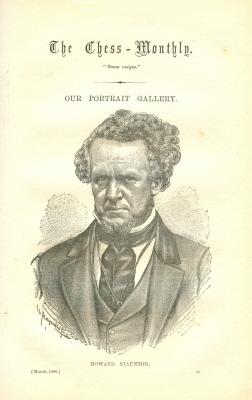
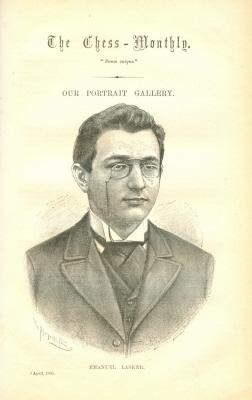
The only artist we recall seeing credited in the Chess Monthly was ‘Mr E. Passingham, of Bradford’ on page 234 of the April 1889 issue. However, his work for the Portrait Gallery bore a different signature.
(6015)
Regarding Bogoljubow v Capablanca, Bad Kissingen, 1928 Irving Chernev wrote on page 238 of Combinations The Heart of Chess (New York, 1960):
‘For Capablanca this victory must have been especially gratifying. It proved once again that Bogoljubow had been deluding himself when he made the statement, “There is nothing more to fear from the Capablanca technique”.’
Where did Bogoljubow make such a statement?
(6047)
Robert Sherwood (E. Dummerston, VT, USA) draws attention to this passage by Bogoljubow on page ix of his book on the Moscow, 1925 tournament:
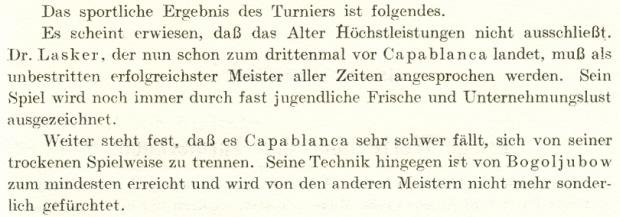
Our correspondent’s translation:
‘The sporting result of the tournament is as follows.
It has been shown that advanced age does not preclude the highest achievements. Dr Lasker, who for the third time finished ahead of Capablanca, must without question be considered the most successful master of all time. His play yet again is enterprising and almost youthfully fresh.
Further, it is apparent that Capablanca finds it very difficult to separate himself from his dry style of play. His technique, on the other hand, has been at least equalled by Bogoljubow and is not especially feared by the other masters.’
(6052)
From page 33 of the November 1905 issue of Lasker’s Chess Magazine (in a signed article by Emanuel Lasker following the Tarrasch v Marshall match):
‘The Doctor [Tarrasch] holds peculiar views on the championship of the world, thinking that the title of champion of the world is an epithet reserved for the best acknowledged player. This a German view, or rather error. To an Englishman or American it needs not to be pointed out that the champion of the world will, generally speaking, be he who is worthiest of the title, inasmuch as a holder not worthy of its possession will soon be replaced by the legitimate claimant, but that for a time the champion may be a second or third best man.
The difference in the German and Anglo-Saxon view leads to results of practical import. A German might claim the title by pointing out his achievements, on the strength of mere argument. An Englishman or American will attempt to prove his right to the title in a battle with the man defending his position.’
(6062)
Three paragraphs by Emanuel Lasker on page 126 of the January 1906 issue of Lasker’s Chess Magazine:
‘Dr Tarrasch’s strength or weakness, if one likes – is his pronounced amour propre. Without it he would have been a very mediocre chessplayer; gifted to an abnormal degree, he has become a giant. His amour propre is such that he must excel in something. Chess was, as it were, the easier medium for him to choose, and he is very fond of chess, therefore, but, most particularly of his own chess. He has written two chess books and is writing a third one – all about himself, his victories, his opinions, his life and evolution. He writes very wittily and entertainingly. But his naïve self-adoration often influences his judgment of men and affairs and even chess positions.
There is no game on earth played by anybody but Dr Tarrasch in which he would not point out a mistake or a faster road to victory or improvement of some kind. In his criticisms his personality must be predominant. This is the one great weakness of the doctor’s critical judgment. In his personal life he is, like many Germans of the better classes, always “correct”. To be “correct” signifies, in Germany, the attitude of a man whose conduct, in the judgment of his neighbors, is always proper and befitting his station. In order to be “correct”, one must be guided by the opinion of others; one must be without a moral or ethical code of one’s own, and annex that of one’s surroundings. In dress, in what he says and does in public, Dr Tarrasch is always “correct”.
It is the same in chess. He always tries to find the “correct” move which, if his understanding of it is analyzed, is the move which, in the opinion of the best judges, would satisfy all requirements. As he is very painstaking and earnest in his studies, his strength in chess is exceedingly great. But still one cannot help feeling that it is acquired, not born in him, for he follows the progress of ideas but never leads it.’
(6066)
In an item written in Havana on 30 April 1921 Lasker commented regarding Capablanca:
‘Aus seinen Zügen liest sich sein Gedanke ab, selbst da, wo er listig sein will. Ob er auf Remis oder Gewinn spielt oder zu verlieren fürchtet, sein Zug verkündet laut, was er fühlt. Bei alledem sind seine Züge, wiewohl durchsichtig, keineswegs naheliegend, und oft tief.’
Source: page 30 of Lasker’s booklet Mein Wettkampf mit Capablanca (Berlin and Leipzig, 1926).
We are grateful to Ralf Binnewirtz (Meerbusch, Germany) and Richard Forster for pointing out a mistranslation on page 111 of our book on Capablanca. The various meanings of the German word Züge, which Lasker used three times, include (a) facial features and (b) moves (in chess) – quite apart from (c) trains. From the way the passage begins, (a) would seem a plausible interpretation, but our correspondents inform us that (b) is the meaning throughout.
A revised translation therefore reads:
‘From his moves you can read his thoughts, even when he is trying to deceive you. Whether he is playing for a draw or a win, or is afraid of losing, his move proclaims aloud what he feels. For all that, his moves, although transparent, are by no means obvious and are often deep.’
(6071)
Wanted: contemporary substantiation of a remark supposedly made by Lasker to Capablanca:
‘A week or so earlier [compared to 26 July 1914] these two masters had met in Berlin, where they played a rapid-transit match of ten games. Capablanca won 6½:3½, and afterwards Lasker is alleged to have said, “It is remarkable: you make no mistakes”.’
Source: The Unknown Capablanca by David Hooper and Dale Brandreth (London, 1975), page 168.
Irving Chernev gave the words as ‘It is remarkable; you never seem to make a mistake’ in Chess Review, April 1954 (inside front cover and page 125) and as ‘Young man, you play remarkable chess! You never make a mistake!’ on page 234 of Combinations The Heart of Chess (New York, 1960).
(6077)
Following publication of the agreement signed by Lasker and Marshall on 26 October 1906 for a world championship match (see pages 147-148 of Lasker’s Chess Magazine, August-September 1906) James Mortimer quoted a few unhappy passages on page 8 of the Daily Mail, 5 December 1906 and commented:
‘All this is wonderfully weird. It may be very good Liskeranto or very elegant Marshallpuk, but it is certainly not very good English.’
(6123)
Frederick S. Rhine (Park Ridge, IL, USA) notes that on page 61 of our Capablanca chapter in World Chess Champions (Oxford, 1981) we wrote regarding the 1921 match for the world crown:
‘Despite the valiant efforts of the man who had held the title for 27 years, the Cuban could, and did, claim that, far from losing a game in the whole match, not once had he actually been in a markedly inferior position.’
However, Capablanca’s notes to the tenth game, given on pages 59-60, included an observation that in this position (after his 16th move, ...Nb6-d5) ...
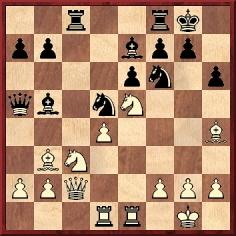
... the line 17 Bxf6 Bxf6 18 Bxd5 exd5 19 Qf5 would have left him ‘with a very hard game to defend’.
Given that ‘a markedly inferior position’ is more or less synonymous with ‘a very hard game to defend’, Mr Rhine wonders to what extent there is a contradiction between our statement and Capablanca’s note. We are grateful to him for raising an interesting matter and offer below some non-exhaustive jottings:
1) Capablanca wrote on page 376 of the October 1922 BCM (in his reply to Lasker):
‘The one outstanding feature of the match and the one that most critics overlook is that not once did he have a won game. A feat to be very proud of, as up to the present it is unique in the annals of championship matches.’
On other occasions the Cuban may have phrased the claim differently, but the above is its most prominent occurrence.
2) The annotations in which Capablanca stated that the 17 Bxf6 line would have left him ‘with a very hard game to defend’ were published over a dozen years later, on page 210 of A Primer of Chess (London, 1935):
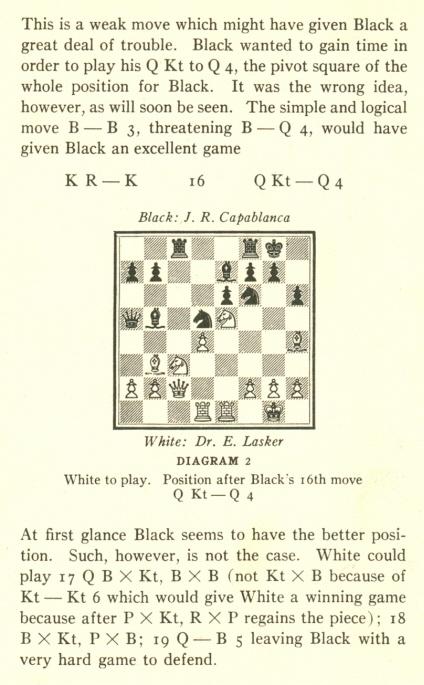
3) In his match book (published in New York in 1921) Capablanca made no comment on moves 16-18. He merely stated after 15...Bb5:
‘With this move and the following, Black brings about an exchange of pieces, which leaves him with a free game.’
This stands in contrast with his remark in A Primer of Chess (shown in the illustration above) that 15...Bb5 was ‘a weak move which might have given Black a great deal of trouble’.
Thus Capablanca’s initial (1921) assessment of the play around moves 15-17 changed considerably later on.
4) That phase of the game became the subject of close examination, as is shown by the following:
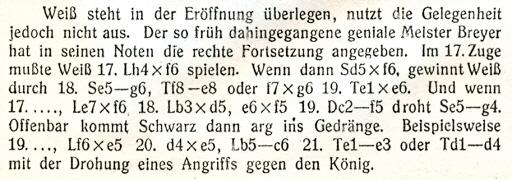
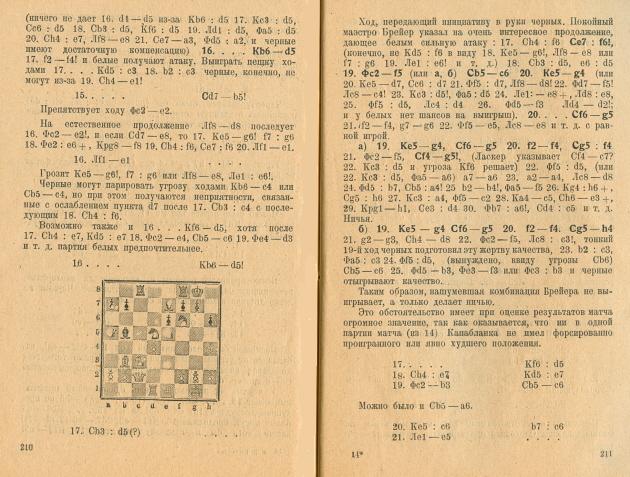
‘Here is the famous position which has appeared all over the world because of Breyer’s sensational analysis giving White the better game. Bogoljubow has subjected this analysis to searching scrutiny, however, and shown that Black can still escape with an even game.’
‘Apart from its intrinsic interest, this analysis is of considerable importance in substantiating the claim that at no stage in his match with Lasker did Capablanca ever obtain a really inferior position.’
‘The position at move 17 may justly be said to be one of the great historic occasions of chess. Had Lasker avoided loss, the course of chess history would have been very different.’
‘It is unique among championship matches in that the winner never seemed to have a lost position. That was Capablanca’s own considered view, and subsequent analysis has done nothing to shake it.’
C.J.S. Purdy: Chess World, January 1954, pages 15-17, and April 1954, pages 85-88. Only the first article was given in The Search for Chess Perfection by Purdy (Davenport, 1997). See pages 166-168.
‘Breyer proposed the illogical-looking 17 Bxf6 as offering White winning chances, but Bogoljubow’s analysis showed that Black had a draw in all variations, and vindicated Capablanca’s claim of never having been in a losing position in his match with Lasker.’
We hope that a master analyst will go into the matter in depth, so that it can be established exactly how strong Lasker’s winning chances would have been after 17 Bxf6.
(6153)
We add the relevant part of the annotations by Bogoljubow on pages 60-61 of volume two of his work Klassische Schachpartien (Berlin and Leipzig, 1926):
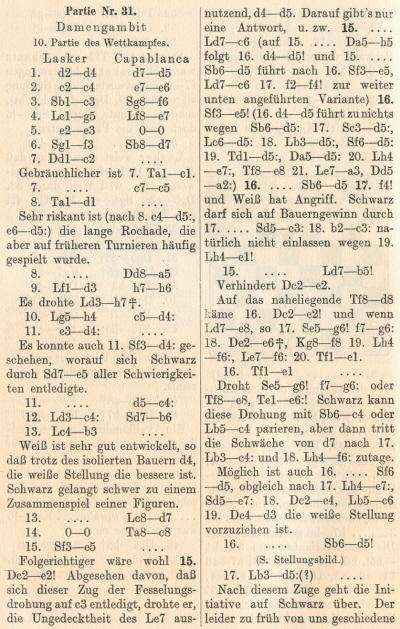
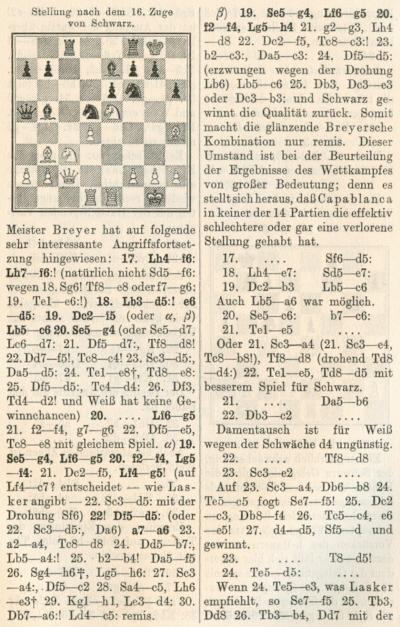
(6182)
A sketch from page 9 of the Daily Mail, 6 October 1906, which accompanied the article by James Mortimer with the ‘rabbit quote’ (C.N. 6122):
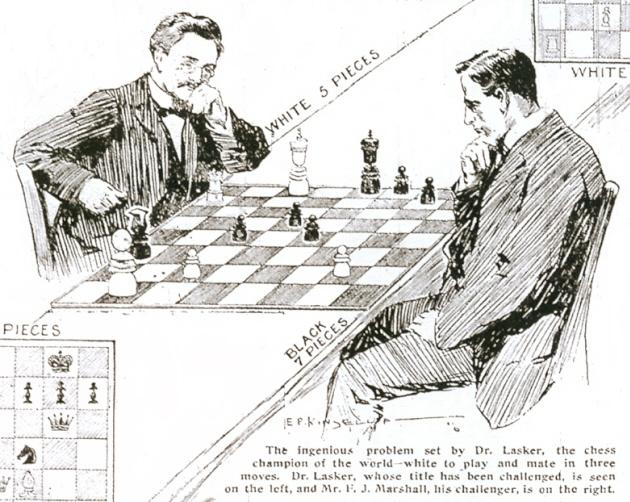
(6177)
From Solitaire Chess by I.A. Horowitz (New York, 1962):

From page 17 of Why You Lose at Chess by F. Reinfeld (New York, 1956):
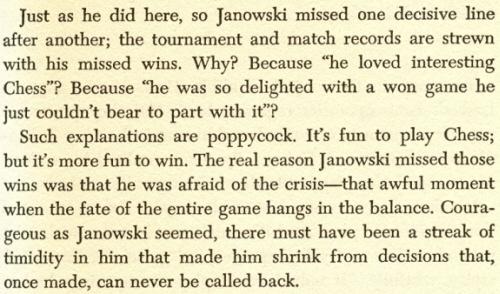
Other quotes on this theme will be welcomed.
(6242)
We now add a ‘once’ account from page 72 of a book co-authored by Horowitz and Reinfeld, How To Improve Your Chess (Kingswood, 1955):
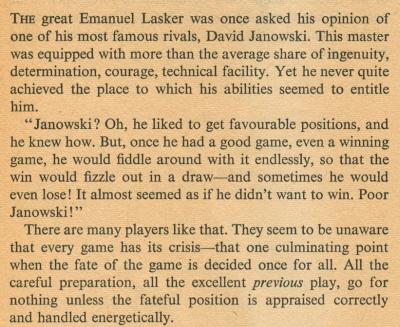
(6567)
Below is what Reinfeld wrote in ‘Emanuel Lasker: An Appreciation’ in his edition of Lasker’s Manual of Chess (Philadelphia, 1947):
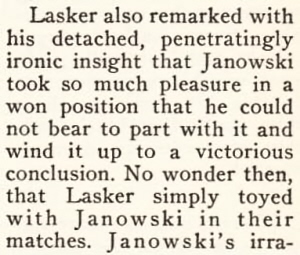
(8233)
Lawrence Totaro (Las Vegas, NV, USA) notes that at the website www.footnote.com [broken link] mentioned in C.N. 6267 it is also possible to view the FBI case file on Emanuel Lasker in relation to a visa application in 1920-21 (case number 40-5546).
(6298)
In C.N. 6198 Nigel Short (Athens) requested examples of magazine reports by leading masters on their simultaneous displays. No proposals having yet been received from readers, we point out the extensive series of articles by Emanuel Lasker entitled ‘My Journey’ which began on page 147 of Lasker’s Chess Magazine, February 1908. From page 197 of the March 1908 issue:
‘In my simultaneous exhibitions [in England] I encountered strong and weak players and made all sorts of combinations calculated to exercise the ingenuity of my audience. I consider such an exhibition in the light of an entertainment and do not measure the success gained by the score made. One should not try to play faultless chess on such an occasion; to begin with under the conditions of play one cannot succeed in that endeavor; then by immediately commencing brisk, if unsound, attacks, one runs the least chance of unduly prolonging the performance, and also presents many interesting and exciting positions to the spectator. Man is, of course, a creature of disposition, and sometimes I achieved only a succès d’estime. But mostly I did entertain players and audience for the space of about three hours very well.’
The second extract, from page 7 of the May 1908 issue, concerns a display which Lasker gave in The Hague on 9 May 1908:
‘I met 25 opponents simultaneously, but had no idea of their strength, since I did not know the best players except by name, nor knew they were playing. I cheerfully ventured on gambits and other rickety openings, and soon found myself in deplorable positions all around. The result was disaster. I won 11, drew 7 and lost 7, playing about four hours and a half.’
From page 66 of the July magazine, regarding a display in Leiden on 6 June 1908:
‘After some preliminaries, play started about a quarter of ten. The Dutch players, as usual, made a hard resistance, impossible to overcome by mere dash. To manoeuvre slowly on 25 boards is no easy matter, since purely strategic operations require, beside an “idea”, an immense attention to detail. So it was nearly three o’clock in the morning before all games were finished. The games had been interesting, but an entertainment of such long duration falls short of its purpose.’
(6333)

A mammoth book of exceptional quality has just been published: Emanuel Lasker: Denker Weltenbürger Schachweltmeister edited by Richard Forster, Stefan Hansen and Michael Negele (Berlin, 2009). It is a beautifully-produced hardback – 1,079 large pages (German text) with hundreds of photographs, many previously unseen. The two dozen contributors of the chapters on various aspects of Lasker’s life and careers include John Donaldson, John Hilbert, Robert Hübner and Victor Korchnoi.
The book, simply unmissable, can be acquired direct from the publisher, Exzelsior Verlag.
(6379)
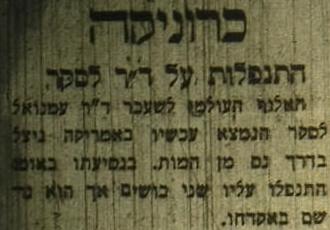
Avital Pilpel submits this report from Davar, 28 September 1933, together with his translation from the Hebrew:
‘An Assault on Dr Lasker
The former world champion, who is now in America, was miraculously saved from death. When riding a car he was attacked by two Blacks, but he scared them away with his pistol.’
Not least because of the reference to the United States, it would seem highly unlikely that Emanuel Lasker was involved in such an alleged incident, but is any further information available?
(6405)
Bernd Graefrath (Mülheim an der Ruhr, Germany) quotes a news item on page 253 of the August 1933 Wiener Schachzeitung:
‘Chicago. Einer Zeitungsnachricht zufolge wurde Exweltmeister Lasker in einem Auto von zwei Negern überfallen. Mit Hilfe seines Revolvers konnte er jedoch die Banditen in die Flucht jagen.’
We believe that in the 1930s Emanuel Lasker did not visit the United States until 1937. The reference to Chicago in the above report may suggest a mix-up with Edward Lasker, who lived there for part of his life, but no corroborative evidence has been found so far.
(6410)
Flemming Larsen (Copenhagen) asks about the existence of pictures from St Petersburg, 1895-96, and particularly shots of Lasker and Pillsbury.
Two come to mind, the first being on page 9 of the Russian edition of the St Petersburg, 1909 tournament book:
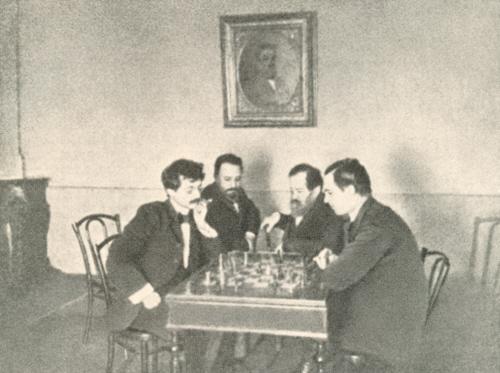
Secondly, and also with Chigorin and Steinitz, there is a picture on page 79 of 120 izbrannykh partiy M.I. Chigorina by N.I. Grekov (Moscow, 1952):
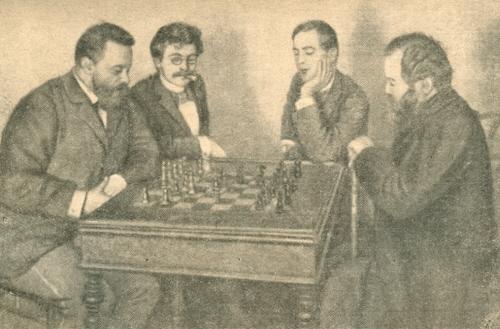
Page 69 of Chess An Illustrated History by Raymond Keene (London, 1990) had a photograph whose caption begins, ‘Under the remote gaze of a picture of Steinitz, Emanuel Lasker faces Harry Nelson Pillsbury in a game in 1896 in St Petersburg’. However, the photograph (which also shows a picture of G.H. Mackenzie on the wall) was taken at the Manhattan Chess Club. For purposes of comparison, see the illustrations in the February 1898 American Chess Magazine, as well as the photograph of Pillsbury at the Club on page 52 of A Picture History of Chess by Fred Wilson (New York, 1981).
(6434)
Jan Kalendovský provides this illustration from Das interessante Blatt, 5 March 1896, page 2:
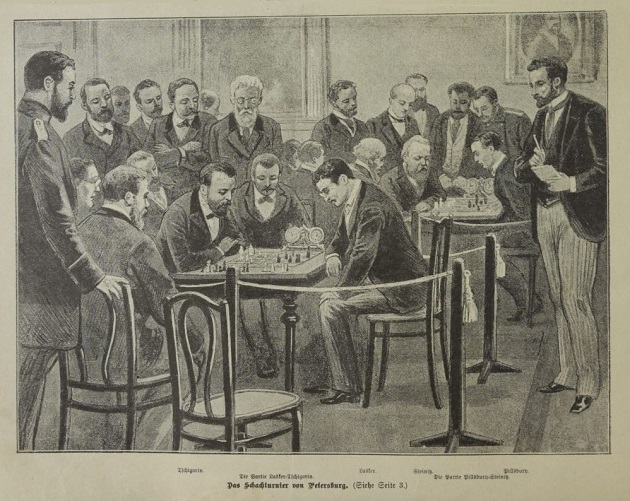
(10731)
‘This little man has taught us all how to play chess’ is a famous remark about Steinitz by Adolf Schwarz, as discussed in C.N. 4375. Here we add a nineteenth-century citation, from page 165 of the August 1897 American Chess Magazine:
‘The chess world owes a debt of gratitude to the past-master, and here is an opportunity to partly repay it. At the Vienna tournament of 1882 the noted chess master Adolph Schwartz [sic], pointing to Steinitz, said, “This little man has taught us all to play chess”, and no truer word was ever spoken. He is the father of modern play, and Lasker, Pillsbury, Tarrasch, in fact all who rank high in chess, willingly acknowledge in him their teacher. Paraphrasing a well-known saying, one can stick a pin at random in any handbook and one will find an innovation by Steinitz and adopted since by the chess world. Moreover, he was the pioneer of scientific annotation, and the best analysts of the day are his pupils.’
An alternative version of the remark under discussion:
‘... Dr Emanuel Lasker said, “This little man taught us all we know”.’
Source: page 17 of Ray Keene’s Good Move Guide by R. Keene and A. Whiteley (Oxford, 1982).
(6505)
John Blackstone (Las Vegas, NV, USA) sends this item from the chess column of the Brooklyn Eagle, 9 January 1941, page 16:
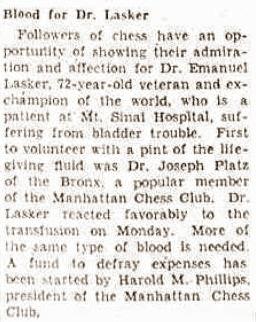
Two days later Lasker died. Joseph Platz gave a personal account of Lasker’s last days on page 40 of Chess Memoirs (Coraopolis, 1979).
(6560)
On page 14 of the October 1974 CHESS Irving Chernev reported that on 28 April 1938 his son Melvin, then aged eight, played a game against Emanuel Lasker when the latter visited the Chernevs’ home. Chernev senior recounted:
‘After ten moves, Lasker said, “Would you accept a draw?” Mel turned to me and said, “Should I take a draw, Dad?” I advised him to do so, whereupon they shook hands on it.
I wrote on the score-sheet, “White offered a draw, which was accepted.”
Lasker added this: “In confirmation of which fact we sign our names to this document.”
Both contestants gravely signed their names to the score-sheet.’
The document was then reproduced in CHESS:

(6614)
Concerning Teichmann, Emanuel Lasker wrote in a ‘Berlin Letter’ dated 30 October 1907 about an 11-round tournament in that city which Teichmann had just won:
‘His victory confirms the opinion held by connoisseurs that Teichmann can easily beat the young crop of masters in a short tournament and in fact is a redoubtable opponent for anyone. In a drawn-out contest, however, the loss of his right eye always proves too severe a handicap.’
Source: Lasker’s Chess Magazine, November 1907, page 4.
After Teichmann’s victory at Carlsbad, 1911 Lasker wrote about him in the Berliner Zeitung am Mittag. The article, ‘Der Sieg Teichmanns’, was reproduced on pages 299-300 of the September-October 1911 Wiener Schachzeitung.
Other authoritative assessments of Teichmann’s skill and potential will be welcome.
(6620)
Some tournaments deviated from the practice of awarding half a point for a draw. A notable example was Monte Carlo, 1901, and we quote from page 373 of the December 1900 issue of La Stratégie:
‘La première partie nulle comptera pour ¼ à chaque joueur et devra être rejouée; si l’un d’eux gagne la seconde elle lui sera comptée ¾ en tout; si elle est encore nulle chacun aura ½ point. Cette modification pour les nullités a été suggérée par M. le Dr E. Lasker.’
(6671)
John Blackstone notes that on page 7 of the 16 December 1908 issue of the New York Evening Post Emanuel Lasker gave a version of the seventh match-game between Marshall and Mieses (played in Berlin on 28 November 1908) which deviated from the commonly-published score.
Lasker’s text was repeated on page 63 of the December 1908-January 1909 issue of Lasker’s Chess Magazine, and for reasons of legibility that is the version reproduced here:
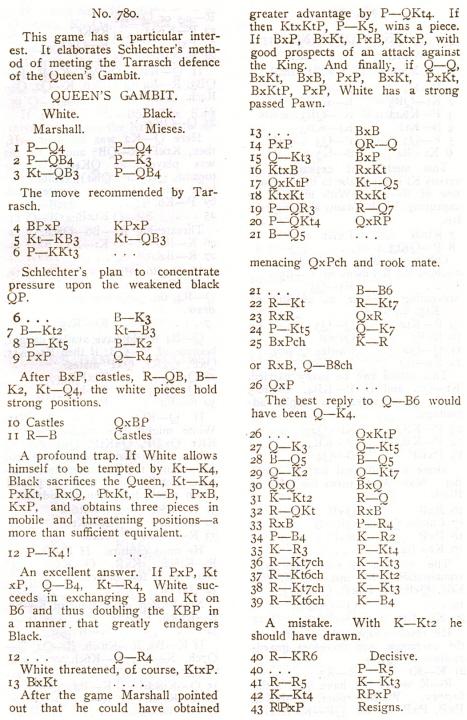
The game-score as regularly presented elsewhere is below (with, in square brackets, observations by Mr Blackstone on the differences from Lasker’s version):
1 d4 d5 2 c4 e6 3 Nc3 c5 4 cxd5 exd5 5 Nf3 Nc6 6 g3 Be6 7 Bg2 Nf6 8 Bg5 Be7 9 dxc5 Qa5 10 O-O Qxc5 11 Rc1 O-O 12 e4 Qa5 13 Bxf6 Bxf6 14 exd5 Rad8 15 Qb3 Bxd5 16 Nxd5 Rxd5 17 Qxb7 Nd4 18 Nxd4 Rxd4 19 a3 Rd2 20 b4 Qxa3 21 Bd5 Bc3
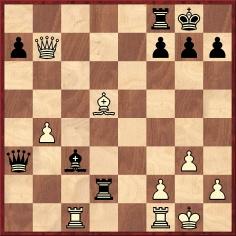
22 Bxf7+ [‘22 Rb1 Rb2 23 Rxb2 Qxb2 24 b5 Qe2 25 Bxf7+ Kh8 is the line given by Lasker.’] 22...Kh8 23 Rb1 Rb2 24 Rxb2 Qxb2 25 b5 Qe2 [‘Now the lines come back together.’] 26 Qxa7 Qxb5 27 Qe3 Qb4 28 Bd5 Bd4 29 Qe2 Qb2 30 Qxb2 Bxb2 31 Kg2 Rd8 32 Rb1 Rxd5 33 Rxb2 h5 34 f4 Kh7 35 Kh3 g5 36 Rb7+ Kg6 37 Rb6+ Kf5 [‘37...Kg7 38 Rb7+ Kg6 39 Rb6+ Kf5 40 Rh6 was given by Lasker.’] 38 Rh6 h4 39 Rh5 Kg6 40 Kg4 hxg3 41 hxg3 [‘This is where Lasker states that Black resigned.’] 41…Kf6 42 Rxg5 Rxg5+ 43 fxg5+ Kg6 44 Kh4 Kg7 45 Kh5 Kh7 46 g6+ Kg7 47 Kg5 Kh8 48 Kh6 Resigns.
The 48-move version was given in various magazines of the time, an example being Deutsches Wochenschach, 13 November 1908, pages 449-450. Even so, Lasker was in Berlin at the time of the game. His column in the Evening Post was headed ‘Berlin, 2 December’, and the introductory text too was reproduced in Lasker’s Chess Magazine (on page 40 of the above-mentioned issue).
(6711)
Jan Kalendovský sends a straightforward problem (mate in three) composed by Emanuel Lasker for young solvers which was published on page 32 of the Neue Freie Presse, 22 December 1935:
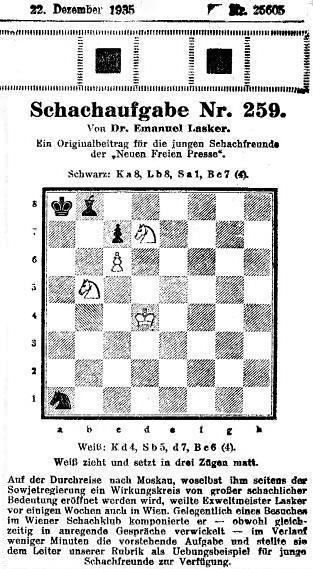
(6731)
From pages 222-223 of ‘Garry Kasparov on My Great Predecessors Part I with the participation of Dmitry Plisetsky’ (London, 2003):
‘To the super-tournament in New York (1927), arranged to “accommodate” Capablanca, Lasker was no longer invited.’
Zenón Franco Ocampos (Ponteareas, Spain) asks whether this is true. The answer is no, because Lasker was invited to New York, 1927.
We discussed the matter on pages 195-197 of our book on Capablanca, referring to the bitter public dispute which had arisen at New York, 1924 between Lasker and Norbert Lederer (the latter being a key figure on the organizing committees of New York, 1924 and New York, 1927).
Much additional information was presented in the article ‘New York 1927 Documentary Evidence Answers Lingering Questions’ by Hanon Russell on pages 88-104 of the first issue of the American Chess Journal (1992). A section of the article (pages 99-101) was headed ‘Why Didn’t Lasker Play?’, and it showed that although the New York, 1927 organizing committee did not believe that Lasker would participate, Lederer ...
‘... made an extraordinary effort to convince Lasker to play. He enlisted the help of influential people in the United States and Europe, but Lasker was not persuaded. Finally, as the plans which were formulated had to be finalized, Lederer made one last effort. On 10 December 1926 he wrote a five-page typewritten letter in German to Lasker (Russell Collection #584). Lederer, whose first language was German (he was born in Vienna), wanted to make absolutely certain that he would not be misunderstood. Lederer’s formal invitation to Lasker specified all the terms, financial and otherwise, being offered to Lasker as well as a strong plea for Lasker to relent and play in what was recognized even then as one of the world’s great chess tournaments.’
Lasker refused the invitation.
See also pages 74 and 640 of Emanuel Lasker: Denker Weltenbürger Schachweltmeister edited by R. Forster, S. Hansen and M. Negele (Berlin, 2009).
(6738)
From Eduardo Bauzá Mercére (New York, NY, USA) comes a report on page A10 of the Brooklyn Daily Eagle, 16 May 1929:
‘Lasker-Lederer Settlement
The judiciary committee of the National Chess Federation, of which Judge Jacob E. Dittus of Chicago is chairman, has adjudicated the controversy between Dr Emanuel Lasker of Berlin, former world’s champion and winner of first prize in the international masters’ tournament in New York, 1924, and Dr Norbert L. Lederer, director of that tournament, according to advices received from Chicago.
Dr Lederer had lodged a formal complaint against Dr Lasker with the committee to the effect that Dr Lasker had published statements reflecting upon his character, as well as upon the executive committee of that tournament, and which, he declared, called for an apology. Dr Lasker, it is said, agreed to abide by the findings of the judiciary committee.
The committee decided that Dr Lederer’s complaint was justified and that the facts in the case did not bear out Dr Lasker’s accusation. A report of the findings was sent to Dr Lasker.
Edward Lasker, recently elected secretary of the National Chess Federation, said yesterday that he and other friends of Dr Emanuel Lasker felt certain that the latter will acquit himself gracefully by publicly retracting his charges. Dr Lasker became 60 years of age on 24 December last, an occasion which was fittingly celebrated by the chessplayers of Germany.’
(6744)
John Blackstone refers to a game given in databases as won by Emanuel Lasker (White) in a simultaneous exhibition in the Netherlands in 1908 against C.A. Moller:
1 e4 e5 2 Nf3 Nc6 3 Bc4 Nf6 4 d3 Bc5 5 Nc3 d6 6 Be3 Bb6 7 Qd2 O-O 8 O-O Be6 9 Nd5 Bxd5 10 exd5 Ne7 11 Bg5 Ng6 12 Nh4 Nxh4 13 Bxh4 Ne4 14 dxe4 Qxh4 15 Bd3 g6 16 Kh1 f5 17 g3 Qf6 18 f3 f4 19 g4 Rf7 20 Rae1 Qh4 21 Re2 g5 22 Rg2 Kg7 23 c4
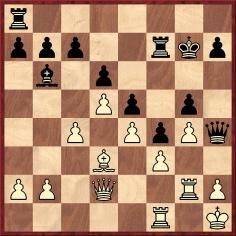
23...Rd8 24 b4 Bd4 25 Qc2 b6 26 a4 Kf6 27 Qe2 h5 28 Rc1 Rh7 29 Rc2 Qh3 30 Ra2 Bc3 31 b5 hxg4 32 Rxg4 Be1 33 Rg2 Bg3 34 Rd2 Bxh2 35 Rxh2 Qg3 ‘1-0’.
Noting that the game was given in Lasker’s column on page 7 of the New York Evening Post, 1 August 1908 as played in Copenhagen at 15 moves an hour, with Lasker as Black against C.A. Möller, our correspondent asks, ‘Do you know the truth?’
This is a further example of the unreliability of databases. The game as given in the Evening Post also appeared on pages 99-100 of Lasker’s Chess Magazine, September 1908. Lasker won as Black, and the game, played in Copenhagen, did not occur in a simultaneous display.
Moreover, both the newspaper and the magazine had Black’s 23rd move as ‘QR-R’, i.e. 23...Rh8 and not 23...Rd8 as given in the databases. With 23...Rh8 the game’s conclusion makes sense.
(6745)
Eduardo Bauzá Mercére has sent us a PGN file of all available games (a total of 28) played by Emanuel Lasker in Buenos Aires in 1910. Sources are given, of course. The following exhibition games, found in the daily newspaper La Nación, were not included in The Collected Games of Emanuel Lasker by K. Whyld (Nottingham, 1998): Portela v Lasker; Lasker v Gelly; Portela v Lasker; Blixen v Lasker; Zamudio v Lasker; Lasker v Howell; Romero v Lasker.
Our correspondent adds:
‘Game 985 in Whyld’s book was played on 19 June, not 17 July, and R. Illa was Ricardo Illa, the brother of the stronger player Rolando.
Lasker’s three results in simultaneous displays were: 19 June 1910: +25 –2 =4; 10 July 1910: +30 –0 =0; 17 July 1910: +10 –0 =2 (against 12 strong opponents, most of whom had played against him in the exhibition games).’
Mr Bauzá Mercére also supplies this photograph, which was published between pages 68 and 69 of the July-September 1910 issue of the Revista del Club Argentino de Ajedrez:
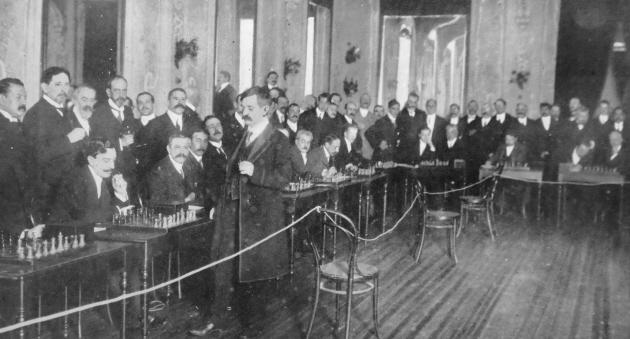
(6770)
Richard J. Hervert (Aberdeen, MD, USA) notes some analysis on page 71 of Lasker’s Manual of Chess (Philadelphia, 1947):
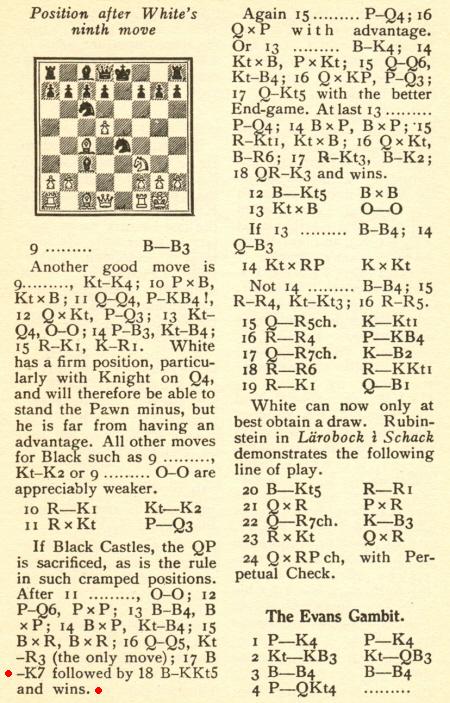
That version of the book was edited by Fred Reinfeld. However, our correspondent comments that it includes a textual change.
Earlier editions of Lasker’s volume (published in New York, 1927 and London, 1932) gave as White’s 18th move not Bg5 but Bf6, as did the 1920s German editions in our collection.
Below is the relevant position, after 1 e4 e5 2 Nf3 Nc6 3 Bc4 Bc5 4 c3 Nf6 5 d4 exd4 6 cxd4 Bb4+ 7 Nc3 Nxe4 8 O-O Bxc3 9 d5 Bf6 10 Re1 Ne7 11 Rxe4 O-O 12 d6 cxd6 13 Bf4 Bxb2 14 Bxd6 Nf5 15 Bxf8 Bxa1 16 Qd5 Nh6 17 Be7 (no 17th move for Black being specified):
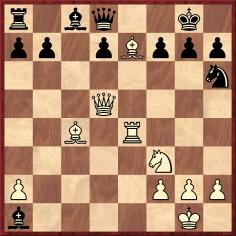
(6780)
The discussion of the position from Lasker’s Manual of Chess C.N. 6780 showed that editions published during Lasker’s lifetime stated that White’s next move would be 18 Bf6, whereas the edition brought out by Fred Reinfeld (Philadelphia, 1947) altered it to 18 Bg5.
Now, Jean-Pierre Rhéaume (Montreal, Canada) points out that in the 1960 Dover re-issue of Reinfeld’s edition the move Bg5 was changed back to Bf6. See page 71.
(9404)
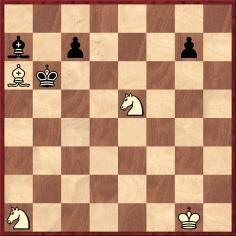
White to move and win
‘This ending is incredibly refined in its relentless utilization of the powers of the pieces and the exceptional subtlety of the winning procedure.’
So wrote Fred Reinfeld on pages 74-75 of The Joys of Chess (New York, 1961), his final comment being: ‘Truly a gem of purest ray.’
On page 200 of The Delights of Chess (London, 1960) Assiac stated that it was Emanuel Lasker’s ‘favourite endgame study, composed by E. Ratner in Paris and first published in Lasker’s own Manual’. It was indeed in the former world champion’s treatise (near the end of the ‘Fifth Book’), and Lasker’s observations included the following:
‘This study makes an excellent impression. The achievements of the White pieces are beyond every expectation. The White army is composed only of heroes. The economy of the pieces here functioning is very pleasing. ... It is incredible, but true, White succeeds in drawing the utmost profit from the position to make, with his puny army, a successful attack against the king.’
In conclusion Lasker wrote:
‘The above composition comes near to the ideal. Even slightest changes in the circumstances would invalidate the solution. And the economy is extreme.’
Assiac was not right to say that the study was first published in the Manual. The invaluable databases of Harold van der Heijden stipulated as the source the Bulletin de la Fédération française des échecs, 1924. Courtesy of Dominique Thimognier (Fondettes, France) and Alain Biénabe (Bordeaux, France) we give below the position and solution from page 19 of the October-December 1924 issue (whose publication date was 15 January 1925):
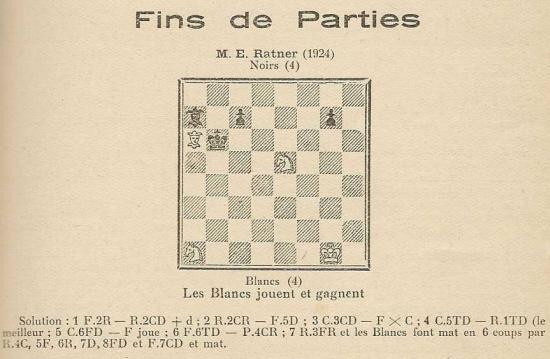
(6801)
C.N. 6801 gave two other studies by Ratner.
From page 306 of The Book of Games by Jack Botermans (New York, 2008), and yet another instance of what might be termed oncery, oncing or oncitis:
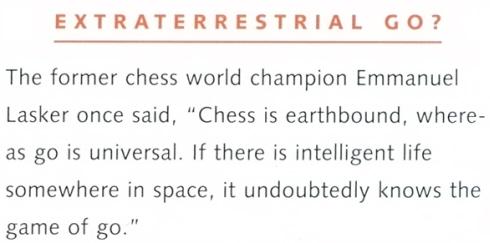
Similar, though not identical, sentiments were attributed to Lasker on pages 253-254 of a book which needs to be treated circumspectly: Emanuel Lasker Biographie eines Schachweltmeisters by J. Hannak (Berlin-Frohnau, 1952):


The passage was quoted from Hannak’s book on page 384 of Emanuel Lasker: Denker Weltenbürger Schachweltmeister edited by R. Forster, S. Hansen and M. Negele (Berlin, 2009). It did not, though, appear in the relevant section (on page 265) of the English-language edition of Hannak’s book (London, 1959).
Can further details about the quote be found?
(6817)
Regarding the Rice Gambit match between Carl Schlechter and Emanuel Lasker (Prague, 1908), see our feature article on that opening.
(6857)
From page 35 of Lasker’s Chess Magazine, November 1907:
‘The comparison of chess to warfare is old and trite, yet with the changing conditions of modern times new viewpoints are continually presented. The submarine and the airship have become factors to be reckoned with and analogy to the pieces on the chessboard is obvious. In how far this analogy holds good no less an authority on both fields than Mr Rice tells in a Washington journal:
“War is becoming more and more a game of chess, a struggle of one mind against another, rather than a physical fight in which brute force wins”, said Isaac Rice, a submarine boat builder at the Shoreham last night. “The introduction of the submarine, the war balloon, which will eventually develop into a flying machine, the searchlight, with all their powers of disclosing the movements of the enemy, and the telephone into modern warfare makes the struggle between opposing forces as open as the moves on a chessboard. The element of surprise which has entered into former wars, to a large extent, is gradually being eliminated. Each commander will know the position of the forces of the enemy, and the victory will go to the man who best lays his plans to checkmate the other.
This reduction of warfare more and more to an exact science and the use of submarine and airships will undoubtedly make the forces employed against each other smaller. Huge armies are hard to handle and to provision. Undoubtedly, too, the sacrifice of life will be less. Battles are fought and won at the army maneuvers as now conducted without the firing of a shot. Judges decide that one force has placed itself in a position to annihilate the other. Generals in actual warfare will recognize this fact, too.”’
We should like to discover the exact source regarding the ‘Washington journal’. C.N. 2823 (see page 316 of Chess Facts and Fables) quoted a paragraph by Emanuel Lasker about Rice’s military prophecies, from page 67 of The Community of the Future (New York, 1940):
‘It is about 30 and some years ago that Isaac L. Rice, the builder of submarine vessels, in a talk with me predicted the coming of the age when technological invention would supersede the niceties of military strategy. He mentioned big, long range, accurately aimed guns and the possibilities of bombing. If he lived today, he would probably specify his prophecy still further. The evolution in the direction of military equipment is almost automatic. To bend the discoveries and conquests of the intellect towards a destructive purpose is easier by far than to develop them in their constructive ethical direction.’
(4787)
See Chess and War.

We offered a book prize for the best attempt by a reader to identify the above figures in a photograph forwarded by David DeLucia (Darien, CT, USA). It was a difficult task, even though some masters, such as Marshall, Janowsky, Teichmann and Schlechter, are immediately recognizable and even though, as will be seen, the photograph concerns a famous tournament.
The winner of our contest is Dominique Thimognier, and we can do no better than paraphrase his excellent entry, which identifies virtually the entire group.
The photograph shows players in, and organizers of, Cambridge Springs, 1904. Newspaper reports of the time mentioned by Mr Thimognier relate that eight players (Lasker, Chigorin, Teichmann, Janowsky, Schlechter, Marco, Lawrence and Marshall), accompanied by the treasurer of the Carlsbad Club, Victor Tietz, arrived in the United States on the Pretoria. (Mieses followed a few days later on the Graf Waldersee.) This account of their reception appeared on page 16 of the New York Daily Tribune, 19 April 1904:
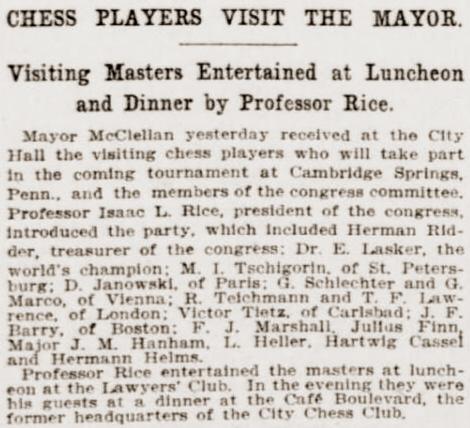
Mr Thimognier also points out that an Internet search confirms that the building in the photograph is the New York City Hall. He offers the following key:
Foreground (left to right): J. Finn, F.J. Marshall, J.F. Barry, M. Chigorin, D. Janowsky, R. Teichmann, V. Tietz, C. Schlechter and J.M. Hanham.
Background (left to right): H. Ridder, I.L. Rice, Em. Lasker, H. Cassel, T.F. Lawrence, G. Marco and N.N. (L. Heller?).
(6891)
From Time, 7 December 1925, page 29:
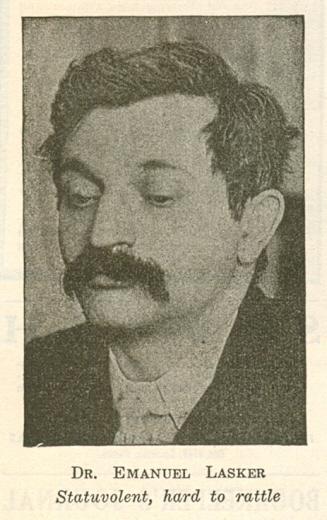
(6917)
A well-known brevity (1 e4 e5 2 Nf3 Nc6 3 Bc4 Bc5 4 b4 Bxb4 5 c3 Ba5 6 d4 exd4 7 O-O dxc3 8 Qb3 Qf6 9 e5 Qg6 10 Nxc3 Nge7 11 Ba3 O-O 12 Nd5 Nxd5 13 Bxd5 Re8 14 Ng5 Nxe5 15 f4 c6 16 Be4 Qh5 17 fxe5 d5 18 exd6 Resigns) won by Judge Leon L. Labatt against Emanuel Lasker in New Orleans in 1907 is often said to have occurred in a simultaneous exhibition. See, for example, page 68 of Play The Evans Gambit by T. Harding and B. Cafferty (London, 1997), as well as various blind-leading-the-blind database productions.
In reality, it was an individual game, as specified on page 105 of the July 1907 issue of Lasker’s Chess Magazine:
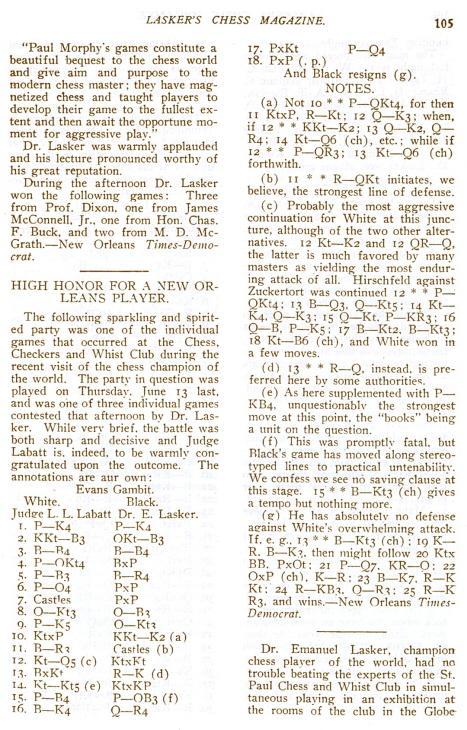
(6942)
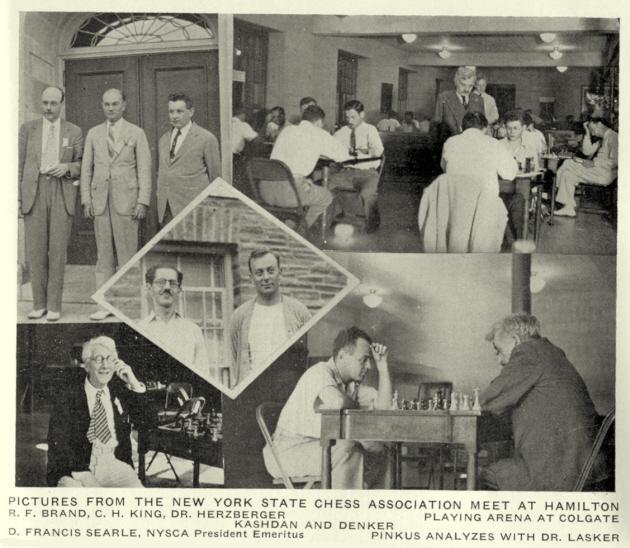
Source: Chess Review, October 1939, page 207.
(6992)
For insouciant story-telling purposes there exists an ideal anecdote: the oft-related one about how Emanuel Lasker, unrecognized, intentionally lost one or more handicap games to N.N. but then turned the tables, thereby convincing his opponent that giving odds is an advantage. The setting and dialogue can be whatever the story-teller wants, in the interests of A Fun Read.
The yarn appeared on, for instance, pages 200-201 of Total Chess by David Spanier (London, 1984), but we are particularly intrigued by the wording on pages 4-5 of The Bright Side of Chess by Irving Chernev (Philadelphia, 1948):
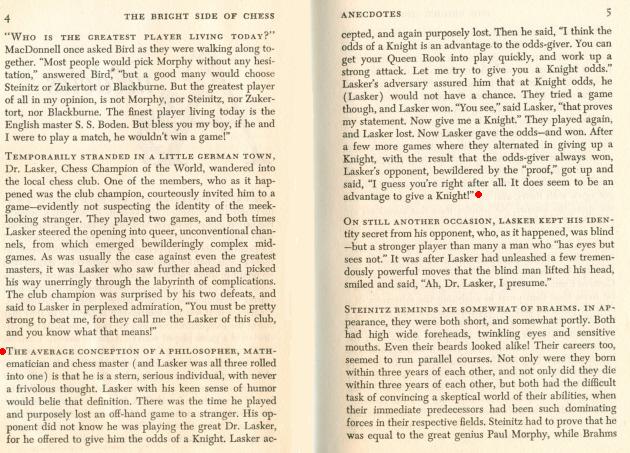
As Alan Slomson pointed out on page 145 of the 30 December 1969 CHESS, the following contribution by Antony Guest appeared on page 111 of The Chess Bouquet by F.R. Gittins (London, 1897):

Alan Slomson commented:
‘Guest says this happened “some 14 years ago”, when Lasker would have been only 15 years old.’
The similarity of the wording in the Chernev and Guest texts prompts a basic question: when was Lasker’s name first introduced into the story?
(7057)
John Blackstone forwards this report by Emanuel Lasker in the New York Evening Post of 6 June 1914:
‘St Petersburg, 24 May – The last days of the tourney were exciting. I beat Capablanca, and thus obtained an even score with him. A huge crowd followed the game, and applauded enthusiastically at the end. That was six days ago. The next day I had a bye, and Capablanca, whose nerve was evidently shaken, lost to Dr Tarrasch. This gave me a lead of one point. I won an adjourned game with Alekhine, who stubbornly defended a forlorn hope, and so two rounds remained to be finished, in which I had to meet Marshall and Dr Tarrasch, and Capablanca had to face Marshall and Alekhine.
Marshall played well with Capablanca, and obtained a winning advantage. I was exhausted, and I was in the lead, so I did not press matters with Dr Tarrasch, but was satisfied with a draw. Then, suddenly Marshall began to play badly – so badly that he did not even draw. Thus my lead was reduced to half a point. On the last day Capablanca played Alekhine. The two are friends, and Alekhine had nothing to gain by drawing or winning, whereas Capablanca had to win the game at any price. Under these conditions, I had no doubt that Alekhine would be unable to get up the will-power necessary for a hard contest. This is human nature. One cannot fight without a propelling motive. Alekhine, in fact, lost easily and quickly. So I had to beat Marshall to win the first prize. It was a short, sharp contest. Marshall nearly lost by time-limit, but was mated before.
The varying emotions of these eventful days exhausted me, so that I could not even sit down to write to the friendly readers of the Evening Post. Now, though still fatigued,it is with pleasure that I take up the pen again to write the report.
After the games were finished the committee invited the players to meet at 10 p.m. Many amateurs came at the appointed time, and the room presented then the aspect of a meeting. The seven members of the committee sat behind a large table covered with green cloth, with papers and with five souvenirs worked in gold by Caucasian artisans. In a row before the table the five masters sat. And the crowd sat or stood behind and beside them. Many speeches were made in the Russian language. I understood only the names of the players and a few simple words, but the meaning of the orations was fairly evident, as in a pantomime. When my name was uttered the crowd applauded. I shook hands with the committee, signed my name in a book, and received my honorarium and prizes. This ceremony was gone through with all five winners nearly in the same manner.
After that a supper table was prepared. We sat down to an elaborate meal at 11.30. Vodka was drunk out of small glasses, the “Sakuska” was eaten, which consisted of various kinds of hors d’oeuvres, for instance, salads, smoked fish, herring, etc., and then fish and meat were served hot. Then glasses were filled with champagne and toasts were given.
First, the toast on the five winners of the tourney. Then I spoke on the committee, praising their unselfish labors. Then Mr Saburov began a series of toasts to each of the winners, in the order of their rank. I was hailed as the prize-winner, and many came to drink my health. And then Capablanca’s health was drunk. While people were going to shake hands with him, Mrs Lasker came to me and proposed that I shake hands with him, too. And I thought in that moment that he, being vanquished, could not well come to me without humiliation. So I stood up, went to him, and drank his health. And he shook hands with me warmly. Then the diners became frenzied. They crowded round us, and then round Mrs Lasker, hailing her as the peacemaker.
The dinner then became very enjoyable. Everybody was in good spirits, and did his best to entertain the others. And it was four o’clock before Mrs Lasker and myself departed. Many stayed even later, some until seven in the morning, drinking, talking, singing.’
The article was reproduced on pages 149-150 of the July 1914 American Chess Bulletin under the title ‘The Great Reconciliation’.
(7086)
John Blackstone also sends an article by Emanuel Lasker published on page 14 of the New York Evening Post of 16 September 1914:
‘Berlin, 12 August (delayed in transit).
These are eventful days. Germany is almost cut off from communication. It is only by chance that I can hope to get a letter written in English through to America. The only hole in the net is Holland, but I am further handicapped, because the German mail does not handle letters unless they are written in German.
The war came suddenly, like the jump of the lion on the back of its prey. Mrs Lasker and myself were beginning to enjoy Switzerland, when rumors of war started. They immediately spread terror. We stayed in the hope that all might end well, and we fled only just in time. Had we waited one day longer the Swiss, who mobilized their troops, would have closed the railways to the public.
The journey home was a memorable one. In Switzerland it was difficult to change money. German notes dropped in value. Swiss notes were not taken at the railway stations, the tickets had to be paid with the exact amount of their price. It was difficult to get one’s luggage, because so many fled in haste, leaving their luggage at the stations. But all these molestations passed. The entrance into Germany, through Basel, was shut, since Germany feared that France might march her troops through Switzerland and attack the city. The railway was full of Swiss soldiers, who hurried to guard the frontier. We took the route via Lindau, which seemed safe from surprise. And all went well. When we arrived there we thanked God, since in these days the whole world seemed to conspire against Germans.
It took us five days to get from Lindau to Berlin. In time of war the trains move slowly. They are of exceeding length, and soldiers guard every bridge, and inspect every inch of the rails. Every station was crowded with old men, women and children. Those who hurried to be enlisted were everywhere given a rousing welcome. They sang patriotic songs, and when two trains passed each other, the soldiers shouted. It was an inarticulate shouting, clear as a musical note, and strong, somewhat like the noise made by the tempest of a winter’s night.
It was impossible to stay unmoved in this emotion which had seized everyone. The social restrictions were blown away. All Germans were brothers. Here a weeping woman was consoled, there the “reservists”, who were leaving their homes to receive arms and the gray clothes of the soldiers, and to hurry to the front, were given food and cigars. To the soldiers who parted we shouted Auf Wiedersehen, and all women waved their handkerchiefs to them.
Our train neared Berlin on Friday the 7th. When we passed a station not far from Berlin, a man who stood there waved a white paper, an Extrablatt. He was far from us, on another platform of the station, and cried two words, “Lüttich genommen” Lüttich (Liège) fallen. What he said was hardly audible, but we in the train knew it in an instant. A tremendous Hurra then went up. And we arrived in Berlin with an elevated sentiment.
Nobody here doubts that the Germans will conquer. There is some question as to the outcome of the war with England, because the English fleet is numerically far stronger than the German fleet. But the German fleet will fight very well. The Germans are seized by wrath against the Russians. They who have killed for years each day hundreds of their best citizens, who have broken their pledge a thousand times, who have sent out murderers into other countries, attack German culture, and want to ruin it. They will never succeed.’
(7092)
With the caption ‘White to play and win’ this position was on page 103 of Lasker’s Chess Primer (London, 1934):
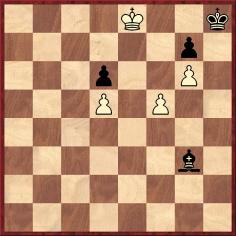
(When the book was reissued as How To Play Chess the diagram was on page 100.) No composer was named by Lasker, and no solution was indicated. (It is mate in 11 moves.) However, thanks to Harold van der Heijden’s endgame study database the missing information is easily found: the composition was by Josef Hašek (published on page 10 of the January 1928 Deutsche Schachzeitung).
A more difficult case is ‘Task Eight’ in Lasker’s book (page 100 and page 96):
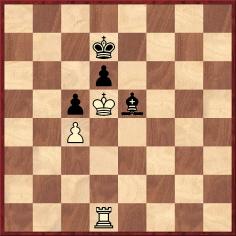
Again, there was nothing but a caption, which asked how the reader would win as White. Apart from the fact that a slightly similar position is on page 36 of Lasker’s Manual of Chess (London, 1932), all we can add is that the composition was discussed inconclusively in ‘Evans on Chess’ on page 25 of the January 1976 Chess Life & Review:
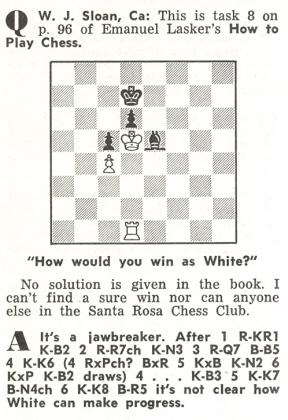
(7113)
What exactly is known about the rapid transit event held on the occasion of the St Petersburg, 1914 tournament?
From page 158 of the July 1914 American Chess Bulletin:
‘Although the chief prize at St Petersburg eluded him by the narrowest of margins, José R. Capablanca, besides taking the second prize, did not come away empty-handed with regard to minor honors, which included the first Rothschild prize for brilliancy, first prize in a rapid transit tourney, in which Dr Lasker was also a participant, as well as a fine record in simultaneous exhibitions, of which he gave three. ...
In the rapid transit tourney Capablanca had the satisfaction of making a score of 5½ out of a possible 6 points, with Dr Lasker, Dr Tarrasch and Alekhine among the competitors. It is not the first time, however, that he has worsted the world’s champion in this style of chess.’
(7118)
C.N. 761 quoted a remark by Sir George Thomas on page 242 of the September 1951 BCM:
‘... It is my firm conviction that either Lasker or Capablanca at his best, and with no more modern equipment than he possessed at that time, could have given the odds of the latest technique to any player of today.’
(7128)
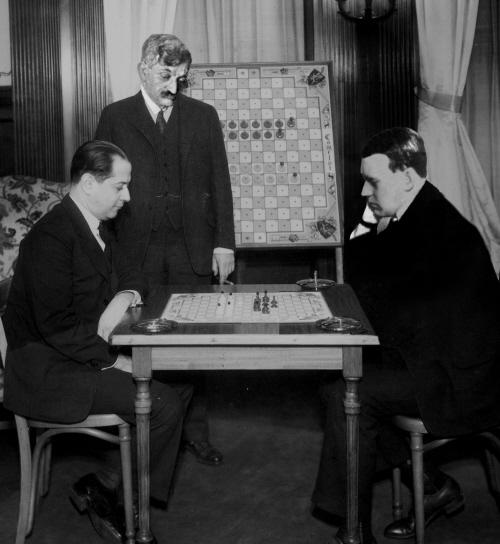
The above photograph (Capablanca, Lasker and Alekhine) comes from a webpage of the World Camelot Federation, and we reproduce it with the permission of the Federation’s President and Founder, Michael Nolan (Troy, MI, USA). He informs us that he created it on the basis of this picture:
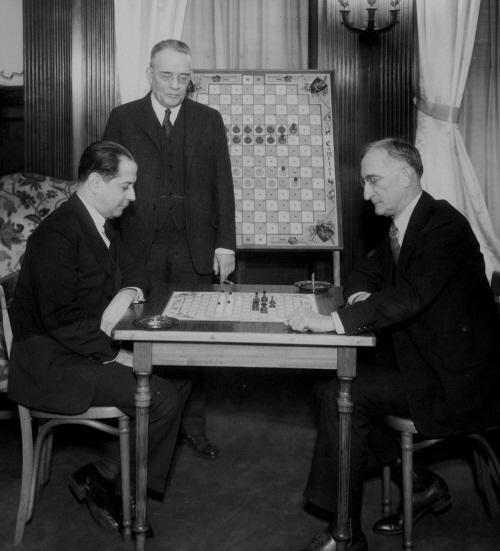
Here, Capablanca’s opponent is the Camelot and bridge expert Sidney Lenz, while E.V. Shepard (another bridge authority) looks on.
On the subject of Capablanca and Camelot see C.N. 2452 on page 172 of A Chess Omnibus. That item included a quote by Capablanca about the game from a 1930s rules booklet:
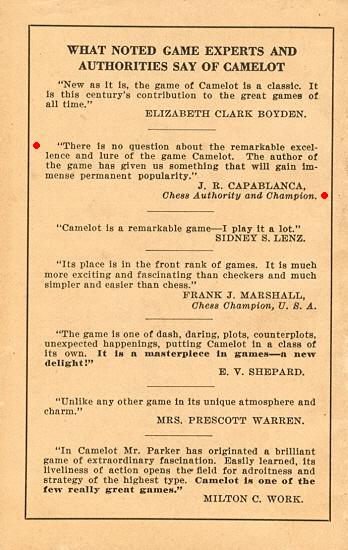
Additional quotes about Camelot are given on another webpage of the World Camelot Federation.
(7164)
Graham Clayton (South Windsor, NSW, Australia) quotes an item from the chess column in the Queenslander, 7 July 1894, page 16:
‘La Stratégie mentions that Madame Reutlinger-Rosenthal is of the opinion that there is no player living who could give her the odds of a knight, and expresses regret that the distance between France and America precludes her from measuring her chess strength against Mrs Showalter’s.’
Our correspondent requests information about Madame Reutlinger-Rosenthal and asks whether any of her games have survived. Assistance from readers on these matters will be appreciated.
Below is the report referred to by the Queenslander:
‘Le paragraphe que nous avons consacré à Madame Showalter, dans le numéro de février, nous a valu une protestation de Madame Reutlinger-Rosenthal qui estime que personne ne pourrait lui rendre le cavalier. Il est regrettable qu’une si grande distance sépare ces deux dames; après le match Lasker-Steinitz, un match pour la “Dame-Champion des Echecs” serait bien intéressant.’
Source: La Stratégie, 15 April 1894, page 119.
The earlier paragraph in the French magazine (15 February 1894 issue, page 55) read:
‘Madame Showalter est bien la digne compagne du vaillant champion du Kentucky; elle vient de le prouver en gagnant un match à M. E. Lasker, qui lui rendait seulement le cavalier, avec le merveilleux résultat de 5 à 2. Probablement aucune autre Dame ne pourrait obtenir un pareil succès contre le célèbre maître allemand.’
(7218)
In an article reproduced in C.N. 7223 G.H. Diggle described J.E.D. Moysey and referred to this game from page 274 of the June 1908 BCM:
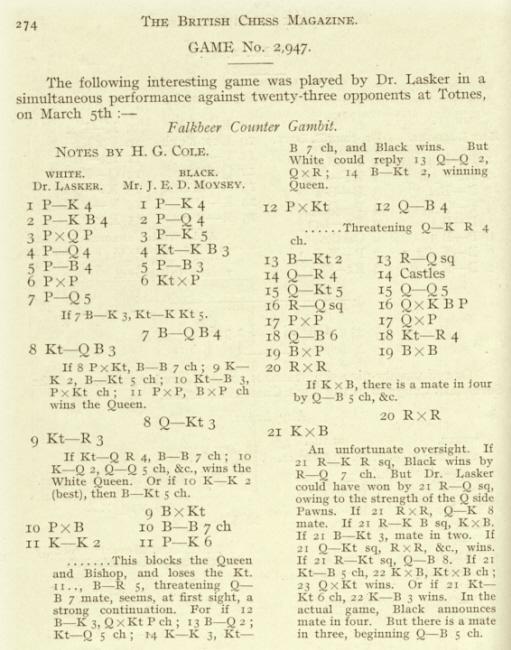
Karel Mokrý (Prostějov, Czech Republic) informs us that he investigated this Moscow, 1935 photograph in the 1980s and drew up the key given below:
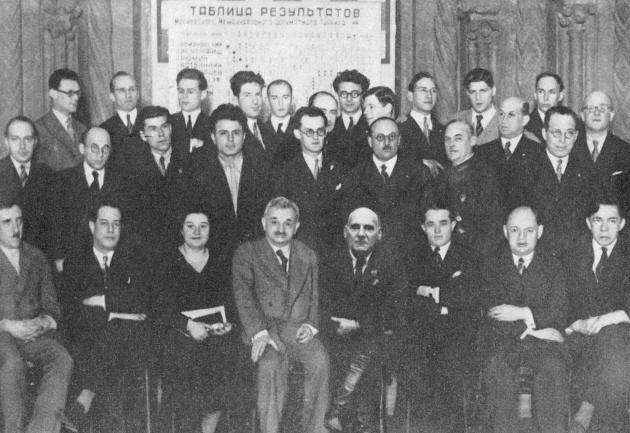
Mr Mokrý also mentions an article which he has written on the two variations of the Russian-language tournament book and the subsequent removal of Krylenko’s name and contribution. See under ‘Moscow 1935’ in the ‘Collector’s Corner’ of our correspondent’s webpage.
(7286)
According to one of the most famous chess quotes, regularly attributed to Tartakower, the winner is the player who makes the next-to-last mistake.
We would point out that the observation pre-dates Tartakower. For example, the following was on page 313 of the October 1890 Deutsche Schachzeitung:
‘Es ging in den Turnieren ziemlich bunt her. Der erste Rang im Meisterturnier wurde nach dem bekannten Witzworte entschieden, wonach derjenige gewinnt, welcher den vorletzten Fehler macht (s. Partie Nr. 5391).’
The game in question was Makovetz v Lasker, Graz, 1890, which was given on page 305 of the same issue:
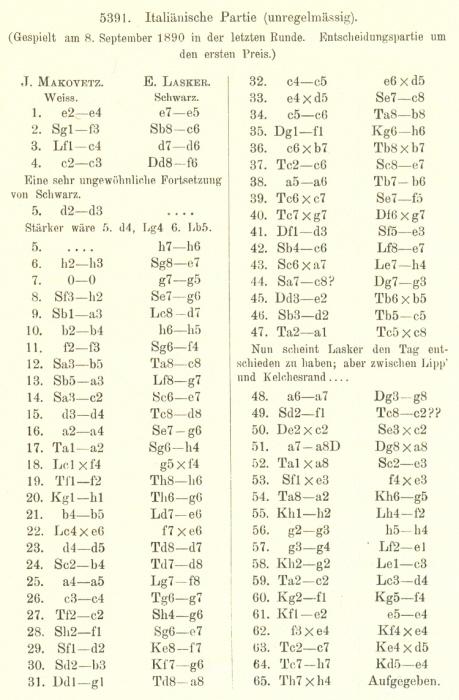
Another example of the remark is on page 167 of the June 1901 Deutsche Schachzeitung, in the notes by Alapin to Mieses v von Scheve, Monte Carlo, 1901:
‘Ein Fehler folgt dem anderen! Dieser hat aber den Vortheil, “der vorletzte” zu sein und muss deshalb gewinnen!’
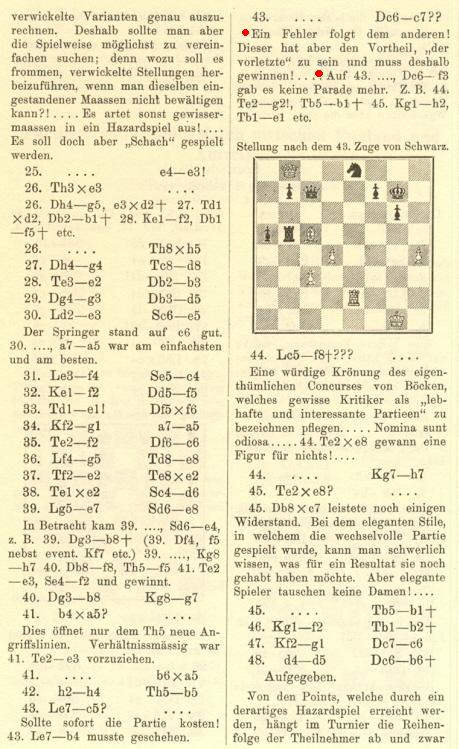
(7288)
From Photographs of Capablanca, a feature article which appealed for better copies of a number of images in Soviet publications:
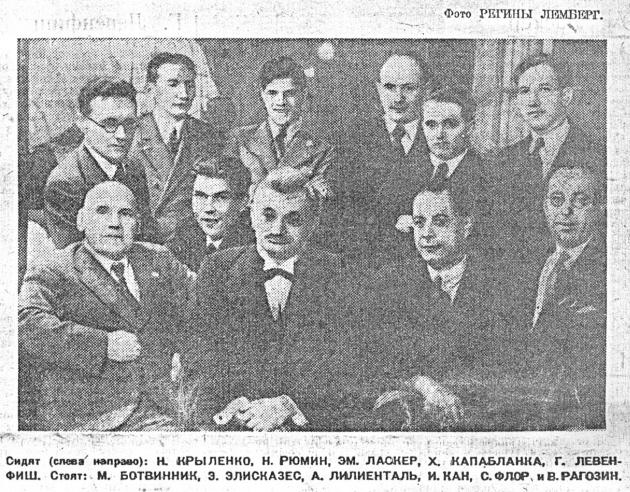
Source: Moscow tournament bulletin, 64, 13 June 1936 and 64, 16 June 1936, page 1
In C.N. 7301 Philippe Pierlot (Le Perchay, France) provided a good-quality copy (source not yet identified):
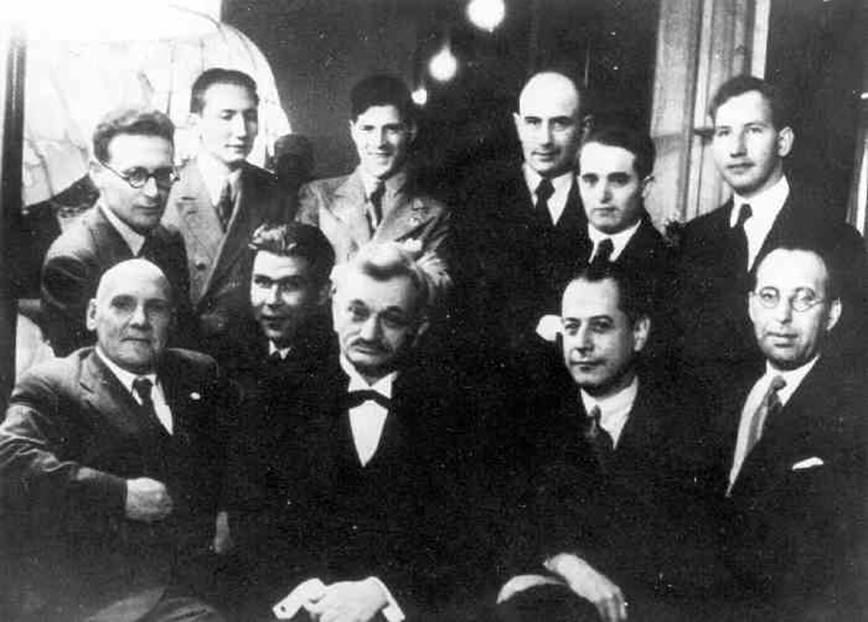
Kevin Harrison (Hunters Hill, NSW, Australia) asks about the authenticity of the Danish Gambit miniature H.E. Bird v Emanuel Lasker, Newcastle-upon-Tyne, 1892: 1 e4 e5 2 d4 exd4 3 c3 dxc3 4 Bc4 cxb2 5 Bxb2 Qg5 6 Nf3 Qxg2 7 Rg1 Bb4+ 8 Ke2 Qh3 9 Bxf7+ Kd8 10 Bxg7 Ne7 11 Ng5 Qh4 12 Ne6 mate.
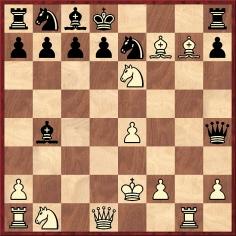
We have no reason to doubt it. The game was published on page 48 of the October 1892 issue of N.T. Miniati’s Chess Review:
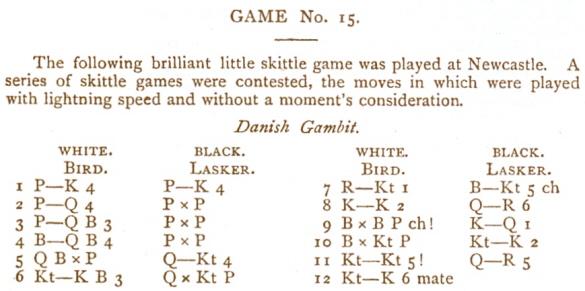
(7326)
Hans Renette (Bierbeek, Belgium) notes that the Bird v Lasker lightning game was also published on page 7 of the Leeds Mercury, 24 September 1892, introduced by this paragraph:
‘The following brilliant skirmish was played at the County Hotel, Newcastle, on the occasion of the presentation of the “Newcastle Chronicle Chess Trophy”. It is only fair to state that about a dozen games were rattled off in the space of two hours, and of these Herr Lasker won the majority. He made the remark afterwards that his arm, not his head, ached; such was the rapidity of the moves and the large amount of woodshifting.’
(7332)
Writers on Mikhail Botvinnik tend to pass over a significant article which he contributed to International Championship Chess by B. Kažić (London, 1974). Published on pages 244-250, it is entitled ‘Botvinnik on his Meetings with World Champions’ and discusses Lasker, Capablanca, Alekhine and Euwe. An observation from page 248:
‘Alekhine’s was a complex character. As soon as he felt any signs of hostility, he would shoot out his quills like a porcupine. When people were kind he felt bound to behave in the same way.’
We should like to know whether Botvinnik’s original text is available, since the English version is sometimes defective. For example, page 247 has the following regarding AVRO, 1938:
‘The tournament marked the greatest in Capablanca’s entire career.’
A word such as ‘failure’ or ‘disappointment’ seems to be missing after ‘greatest’.
There is an interesting passage on pages 246-247, concerning the period after Hastings, 1934-35:
‘At the invitation of S.O. Weinstein, Capablanca came to the Soviet Embassy in London and immediately agreed to play in Moscow. It was a while before Capablanca actually came. Weinstein inconsiderately asked him about a possible match with Alekhine and suddenly the Cuban changed colour! He glared and could not calm down for a long time. Capablanca and Alekhine remained enemies for the rest of their lives.
Capa was phenomenal at calculating positions, but he was also a shrewd tactician. At the tournament in Moscow I played Black and skilfully brought the game to even play, when, unexpectedly, Capablanca in the end “overlooked” a man!? But – no! White had, in fact, been preparing a quiet move and a variation in which he actually took the pawn. All of this was artfully concealed.’
(7337)
Page 116 of Turnierpraxis by Franz Gutmayer (Berlin and Leipzig, 1922):
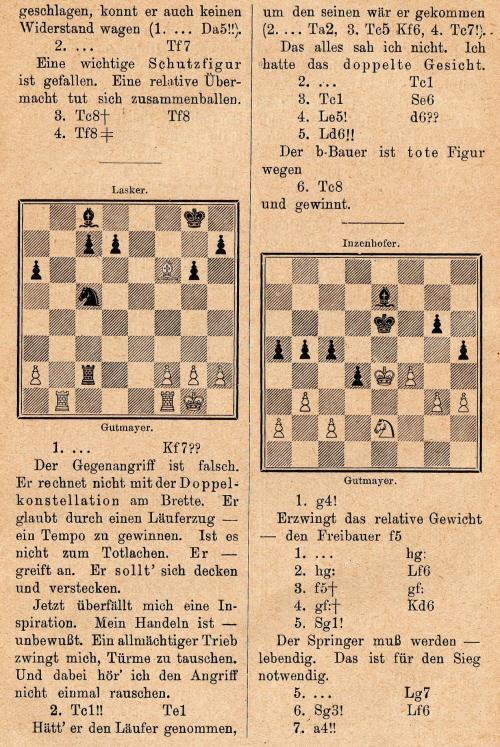
We wonder what is known about the Gutmayer v Lasker game in the second Turnierpraxis diagram above. To begin with, which Lasker was Black?
(7387)
Shortly after posting C.N. 7387 we saw the Lasker game on pages 259-263 of Gutmayer’s book Der Weg zur Meisterschaft (Berlin and Leipzig, 1919). Gutmayer gave the first 28 moves, with the heading ‘Gutmayer u. Genossen – Dr. Em. Lasker’. On page 70 of The Collected Games of Emanuel Lasker by K. Whyld (Nottingham, 1998) the consultants were named as Schlesinger and Thalheim, and the occasion was given as Berlin, 28 February 1896. Gutmayer’s book was not mentioned, and the source was specified as ‘Daniuszewski manuscript [Lothar Schmid]’. Christian Sánchez notes that the game-score is in a number of databases, dated 6 March 1896, and that on page 116 of Gutmayer’s Turnierpraxis (C.N. 7387) the diagram was incorrect. The latter point is also made by Peter Anderberg (Harmstorf, Germany), who adds that the complete game-score was published on pages 113-114 of the 12 April 1896 issue of Deutsches Wochenschach. It was one of three consultation games played simultaneously at the Café Kaiserhof in Berlin on 28 February that year.
We add that Gutmayer also gave the game, naming Schlesinger and Thalheim, on pages 121-122 of his book Die Grosse Offensive am Schachbrett (Innsbruck-Mühlau, 1916).
(7391)
In the line of duty we have been browsing further in the books of Franz Gutmayer. Additional references for the record:
Gutmayer et al. v Emanuel Lasker (position only):(7405)
The second fascicule of Les échecs modernes by Henri Delaire, publication of which was announced on pages 167-168 of the June 1915 issue of his magazine, La Stratégie, has a number of scarce photographs, although they are under 2.5cm in width. Three examples:
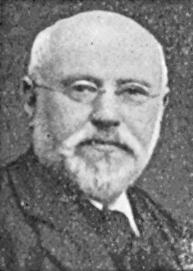
Isidor Gunsberg
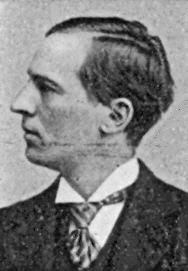
Harry Nelson Pillsbury
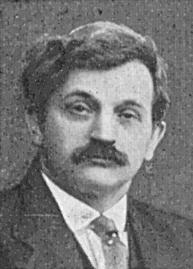
Emanuel Lasker
The Lasker picture is similar to a well-known shot:

Is it possible to find better copies of the photographs which were given in Les échecs modernes?
(7429)
Gene Gnandt has found an article by Capablanca on page 9 of the Evening Post (New York), 22 July 1916. We have transcribed it below:
‘Emanuel Lasker in a Contemporary’s Eyes
Chess master not a peculiar type of individual
Capablanca, the Cuban Player, in an Estimate of the Abilities of the World’s Champion – His Personal Characteristics – Tarrasch and Teichmann as They Appear in Tournaments – Tarrasch, Only, Prepares for Contests
By José Raoul Capablanca
I have frequently heard the remark that a chess master must be a peculiar type of individual. He must not be one who sticks close to the golden mean of conduct, but rather one who approaches extremes, if not in physical, at least in mental, characteristics. With this statement I must say on the strength of my associations with the chess masters of the world, that I am not wholly in accord. It is true that they are, with few exceptions, men of great mental powers.
In this connection there come to my mind the mental pictures of three of my worthiest German opponents – Emanuel Lasker, Tarrasch and Teichmann. I shall speak of these three not only because their pre-eminence demands it but also because my observation of them makes me believe that they possess some of that picturesqueness and oddity suggested by the usual caricature of the chess master.
Lasker, to my mind, is the typical Bohemian, chastened, however, by a large fund of common sense and knowledge. He is one of those long-haired individuals indifferent to dress, a brilliant conversationalist, an inveterate smoker of cigars, and sipper of black coffee, one whose person seems to be an appropriate decoration of a Bohemian café – a Samuel Johnson, without his discourtesy, transported to a Russian café.
Lasker’s conversational powers
Lasker’s conversational power is exercised in a peculiar way. One must first engage him in conversation before he will talk. He is not of that kind of conversationalist who approaches another and, by the brilliance of his talk, gathers around him a host of admiring auditors. His unassuming and courteous manner is not calculated to produce this sort of thing. But he would rather betake himself, unaccompanied, to a café and, like the great Napoleon, sit at one of the tables, listening to the conversation of others. Here, sometimes, Lasker prefers to do some of his thinking. Usually, however, he reserves this function for the long walks for which he is known. He is eager to know the thoughts and opinions of others, never judges them harshly; but takes them all for what they are worth. This attitude he also maintains in chess, lending a willing ear to all discussions.
As for Lasker’s picturesqueness of dress, I have been under the impression that he had long since dismissed the question of dress as one of the unnecessary annoyances of life. I recall a very amusing incident in this connection, when Lasker visited New York. He had been invited by the Manhattan Chess Club to give an exhibition of simultaneous play. Special preparations were made in his honor. That evening Lasker evidently thought the occasion worthy of his wearing a Tuxedo. As he entered the room I heard a slight titter and, looking up in the direction of the sound, I saw that Lasker had come to us that evening with his cravat untied and dangling down upon his shirt. When his attention was politely called to this, he thanked his informant very politely and, endeavoring to correct this breach of the conventions, made several quick passes with his hands in the vicinity of his throat and made a knot that passes description. In this fashion he played through the evening.
Champion a deep thinker
Furthermore, Lasker is a thinker and a philosopher of the true type – such a one as, I have often felt, Plato might have delighted in shutting up in one of his towers, far from the madding crowd, to think only for the welfare of his republic. As a matter of fact, I believe that Lasker would have liked this job, for to be a philosopher of repute is an ambition very close to the heart of the worthy doctor. His predilections, however, lie in the field of mathematics, a fact that probably accounts for his scientific accuracy and inevitableness of result when he plays chess. A professor of mathematics, his love for the subject is very keen, and his capacity for work in this connection knows no bounds. Were it not for the fact that there is an application of Lasker’s knowledge of mathematics to the game he plays I should think of him along with that mathematician whose only claim to fame was the fact that he started out – and succeeded in his attempt – to discover something in mathematics that had positively not even a suspicion of a practical application to anything in this world.
As for Lasker’s method of play, I say, what is commonly conceded, that he is a genius at chess, one well worthy of the distinction of champion of the world. As a tactician, there is no-one of equal ability. Always ready to meet an emergency, however unexpected, he never finds it necessary to come to a game weighted down with the memory of a bookful of variations. He has the faculty of anticipating sooner than his opponent the crux of a situation, and has the power of seeing more. This seems to be common knowledge among those with whom he plays; and as a consequence they seem to play under a handicap. This genius of Lasker’s is reinforced by his accomplishments in mathematics, which assist him in being extremely accurate in games that assume a special aspect, and that adapt themselves to mathematical calculation.
In my own games with Lasker, what I have said of him was verified. There was at all times evidence of his far-seeing vision, his accuracy and quickness of perception. Lasker, however, is generally but not consistently a slow and deliberate chessplayer. Yet, were it not for the fact that I have beaten Lasker at rapid chess, he would be considered the foremost rapid chessplayer in the world.
When I speak of Tarrasch, I feel that I should be very cautious, lest I say something that may offend him. For Tarrasch is one of those who outdo themselves in their efforts to appear scrupulously correct. He is extremely fastidious, sensitive and possessed of a superabundance of pride, which, I should not say, is offensive in his case. When I think of Tarrasch, I see his inevitable boutonnière, his carefully soaped moustache, his immaculate and fashionable clothes. If anything disturbed the orderly appearance of his attire, it was a crime; but if anything caused his moustache to lose its peculiar outlines, it was sacrilege. Tarrasch also believed that he was born to radiate his brilliance especially before the ladies. One day during the San Sebastián tournament a lady was announced. Immediately Tarrasch was on the qui vive. He started from his seat, drew himself up to his full height, settled himself in his clothes so that every crease and fold were in their proper places, assumed a military bearing, threw out his chest, brushed an imaginary speck from his coat and strode to the door to receive the lady. Although he was not well acquainted, he stood there delivering himself of numerous and courtly bows.
But the picture of Tarrasch during tournament play is one hard to forget. He has all the appearance of a diminutive Spartan. I have seen him in important games staring fixedly at the chess board for fully an hour, so intently that one would think his sight was piercing the table, perfectly rigid, not even the smallest muscle twitching, straight-backed and with an almost painful seriousness in his face – a living statue.
The method of Tarrasch differs from that of Lasker. To my mind, Tarrasch is a very weak tactician. Coming always well prepared to his matches, he becomes terribly flustered in emergencies and at unexpected developments. He thinks long and painfully over his moves, for to Tarrasch the loss of a game is worse than the tortures of hell. I recall at San Sebastián, when, after going through all the preliminaries of assuming a military bearing and curling his moustache, he invited me for a walk. He then discussed with me at great length the best opening for the game he was to play Vidmar on the following day.
Richard Teichmann is a player who combines the qualities of both Lasker and Tarrasch. Like Lasker, Teichmann has Bohemian tendencies. He is an accomplished linguist; cannot extend himself to his best effort unless his whiskey and soda are at close call; and is clever at all games of cards and billiards. Work is no virtue with him, despite his massive bulk. As soon as his money is gone, he sets about to play chess.
As a result of an explosion, Teichmann lost the sight of one eye. And I recall with what amusement, in the midst of a brilliant gathering at Petrograd, we received the observation of a spectator that, if Teichmann could see so much in chess with one eye, what might he be capable of if he possessed two?
Teichmann won his first tournament at Carlsbad in 1911, after 20 years of play, and only after he had gone to Switzerland to prepare himself for the event. Up till then, by a strange coincidence, he had to content himself with fourth places generally. In recognition of this achievement, his friends conferred upon him the title of Richard the Fourth.
Chess to Teichmann is a pastime pure and simple. He is a keen student of the game, but plays it mostly for the pleasure that a pastime gives. He is one of those erratic players. When he has the upper hand, his play is of the most masterly kind, but at other times he is weak. Like Lasker, he does not find it necessary to come prepared. But on account of his peculiar indifference, and his disinclination to disturb the serenity of his temperament, he frequently contents himself with a draw.’
(7557)
Napoleon was discussed at the end of an article by James Mortimer entitled ‘How to Win at Chess’ on page 9 of the Daily Mail, 6 October 1906:
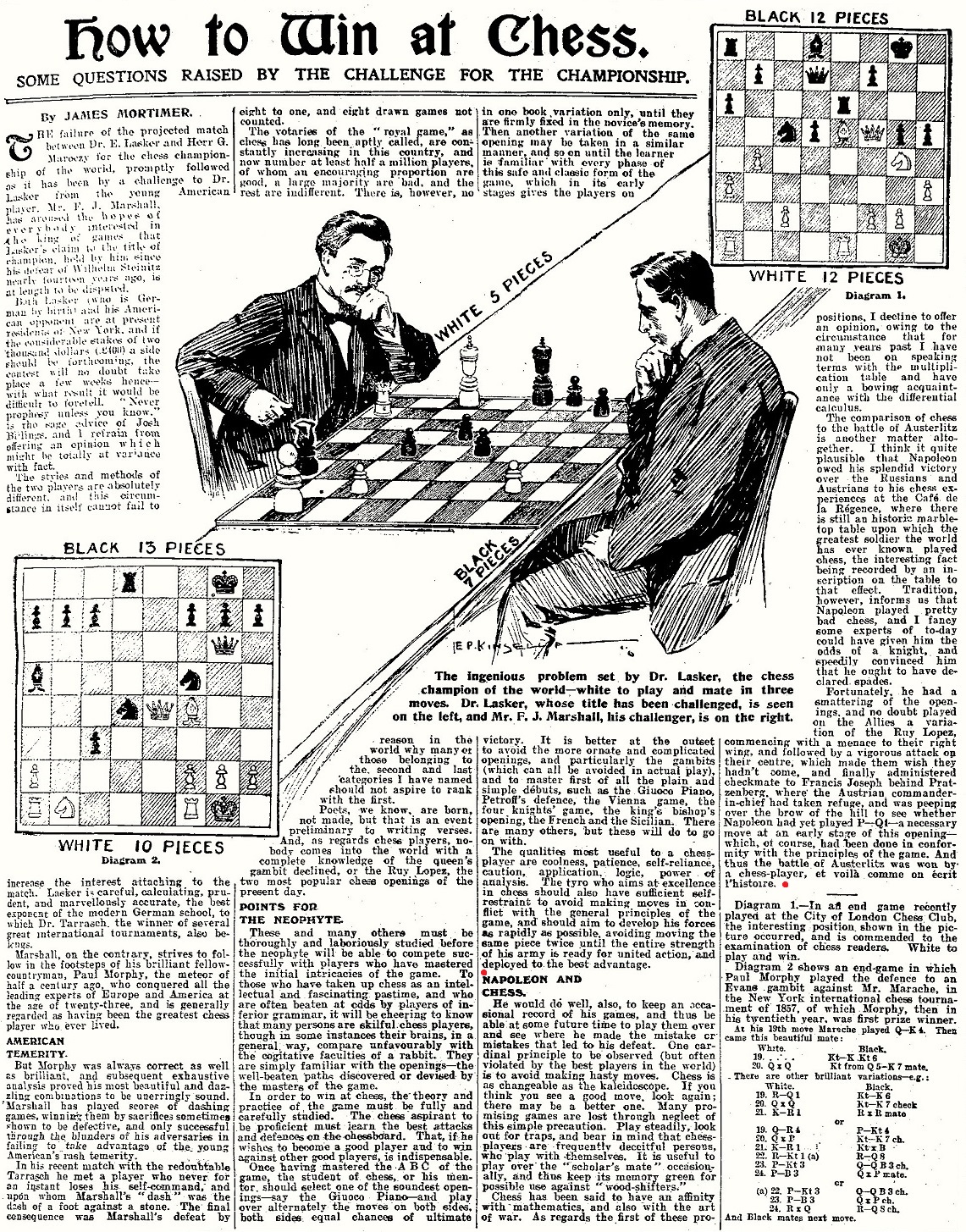
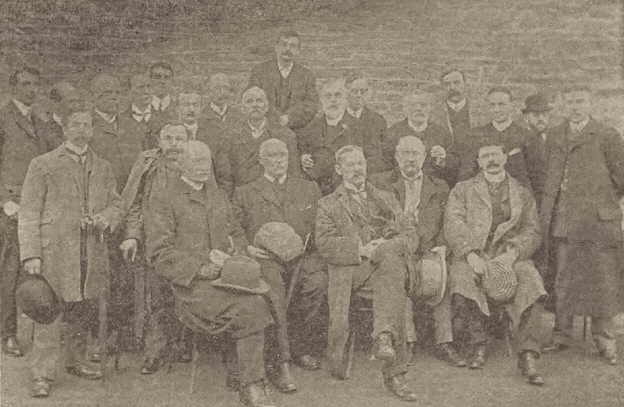

Devon and Exeter Gazette, 13 March 1908, page 14
(7612)
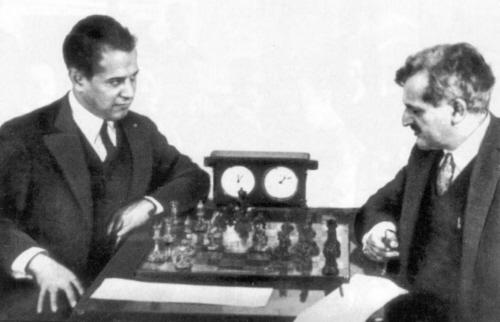
Further to this well-known photograph of Capablanca and Lasker in Moscow in 1925 (see, for instance, page 310 of Chess Facts and Fables), Christian Sánchez notes a brief sequence [broken link] of moving pictures of the two champions (at about 15:40:40). [Addition on 16 November 2012: the material is no longer available at the link indicated.]
(7658)
Eduardo Bauzá Mercére has provided a fine copy (reference: AR_AGN_DDF/Consulta_INV: 259945) from Argentina’s Archivo General de la Nación, courtesy of the Ministerio del Interior, Obras Públicas y Vivienda:
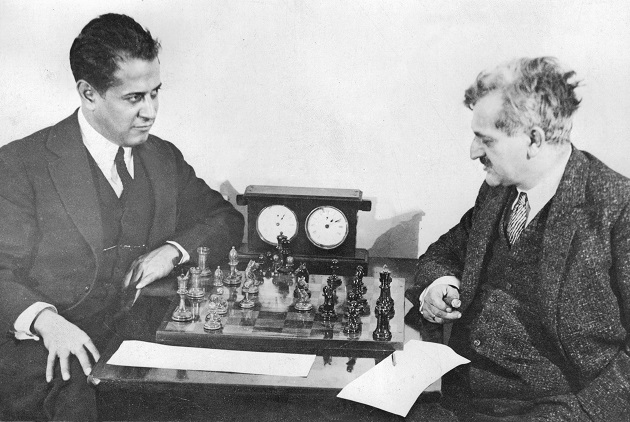
Our correspondent comments that the board position shows a slight variation from their game in the first round of the 1925 Moscow tournament: 1 d4 d5 2 c4 c6 3 Nc3 Nf6 4 e3 e6 5 Nf3 Nbd7 6 Bd3 dxc4 7 Bxc4 c5 8 O-O a6 9 dxc5 Nxc5 10 Qxd8+ Kxd8 11 Rd1+ Ke8 12 Be2 Be7 13 b3 Bd7 14 Bb2 Rd8 15 Rd4 Bc6 16 Rxd8+ Kxd8 17 Rd1+ Bd7 (instead of 17...Kc7, as played by Lasker) 18 Ne5:
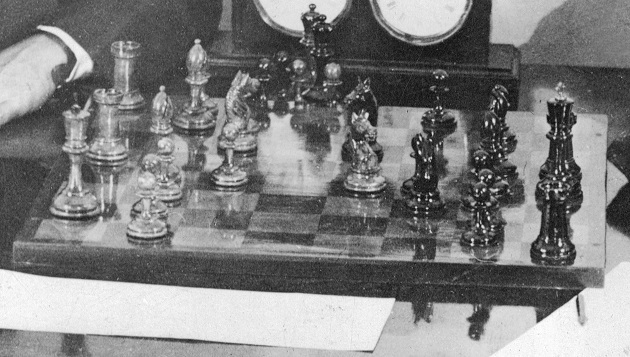
Further information is in C.N.s 3513 (included in a feature article) and 7658.
(10726)
Alan Smith (Manchester, England) has found these games, played in a simultaneous exhibition, in the Baltimore American of 9 June 1901 and 16 June 1901:
Emanuel Lasker – A.W. Schofield
Baltimore, 30 May 1901
Evans Gambit Accepted
1 e4 e5 2 Nf3 Nc6 3 Bc4 Bc5 4 b4 Bxb4 5 c3 Bc5 6 d4 exd4 7 cxd4 Bb6 8 O-O d6 9 Bg5 f6 10 Bf4 Na5 11 Nc3 Nxc4 12 Qa4+ Bd7 13 Qxc4 Ne7 14 a4 a5 15 Rab1 Ng6 16 Bg3 Bg4 17 Nd2 Qd7 18 f4 Qf7 19 Qxf7+ Kxf7
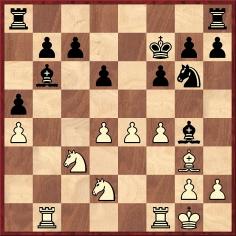
20 Rxb6 cxb6 21 f5 Ne7 22 h3 Rhc8 23 Nb5 Rc2 24 Nxd6+ Kg8 25 Bf4 Be2 26 Re1 Ba6 27 Nf3 Nc6 28 g4 Nb4 29 Rc1 Rxc1+ 30 Bxc1 Rd8 31 Bf4 Nd3 32 Bg3 Nb2 33 e5 Nc4 34 Ne4 fxe5 35 dxe5 b5 36 e6 bxa4 37 f6 gxf6 38 Nxf6+ Kg7 39 e7 Rd1+ 40 Kf2 Bb5 41 e8(Q) Bxe8 42 Nxe8+ Kf7 43 Nc7 a3 44 Ne5+ Nxe5 45 Bxe5 a2 46 Kf3 a1(Q) 47 Bxa1 Rxa1 48 Ke4 Rc1 49 Nb5 Rc6 50 g5 a4 51 h4 Kg6 52 White resigns.
Emanuel Lasker – E.B. Adams
Baltimore, 30 May 1901
Evans Gambit Accepted
1 e4 e5 2 Nf3 Nc6 3 Bc4 Bc5 4 b4 Bxb4 5 c3 Bc5 6 d4 Bb6 7 dxe5 a6 8 Qd5 Qe7 9 Ba3 Qe6 10 Bb3 Nge7 11 Qd1 Qg6 12 O-O Qh5 13 Nbd2 Nxe5 14 Nxe5 Qxe5 15 Nc4 Qf6 16 e5 Qg6 17 Qf3 Ba7 18 Rfe1 Nf5 19 Re4 h5 20 Rf4 Nh6 21 Re1 Ng4
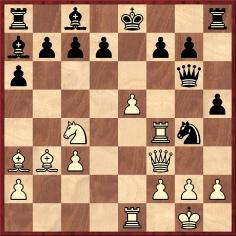
22 Rxf7 Bxf2+ 23 Kh1 c5 24 e6 dxe6 25 Nd6+ Kd8 26 Rd1 Bd4
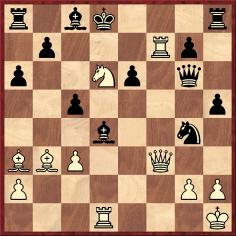
27 Bxc5 Nf2+ 28 Qxf2 Bxf2 29 Nxb7+ Ke8 30 Rf8+ Rxf8 31 Rd8+ Kf7 32 Rxf8 mate.
Emanuel Lasker – J. Ross Diggs
Baltimore, 30 May 1901
French Defence
1 e4 e6 2 d4 d6 3 Nc3 c6 4 Nf3 Be7 5 Bd3 Bd7 6 O-O Qc7 7 Bf4 Nf6 8 h3 h6 9 Re1 a6 10 Ne2 b5 11 a4 b4 12 a5 c5 13 dxc5 Qxc5 14 Be3 Qc8 15 Qd2 Nc6 16 Ned4 Ne5 17 Qxb4 d5 18 Qd2 Nxf3+ 19 gxf3 e5
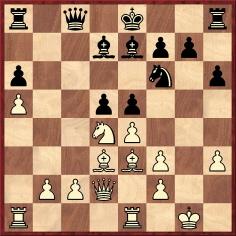
20 exd5 Nxd5 21 Nf5 Bxf5 22 Bxf5 Qxf5 23 Qxd5 O-O 24 Kh2 Qxc2 25 Rg1 Bf6 26 Bxh6 Rfd8 27 Qe4 Qxe4 28 fxe4 Rac8 29 Rg2 Rc2 30 Bxg7 Bxg7 31 Rag1 Rdd2 32 Rxg7+ Kf8 33 R1g2 Rxb2 34 Rg8+ Ke7 35 Ra8 Rxf2 36 Rxf2 Rxf2+ 37 Kg3 Rf6 38 h4 Rg6+
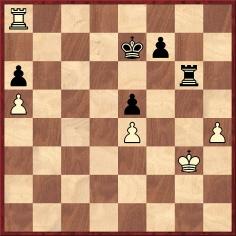
39 Kh3 Rc6 40 h5 Rf6 41 Kh4 Rf4+ 42 Kg5 Rf6 43 h6 Resigns.
(7664)
Olimpiu G. Urcan has forwarded an article ‘Lasker Explains Chess Prodigies’ by William Weer on page 6 of the Sunday Eagle Magazine (Brooklyn), 16 May 1926:
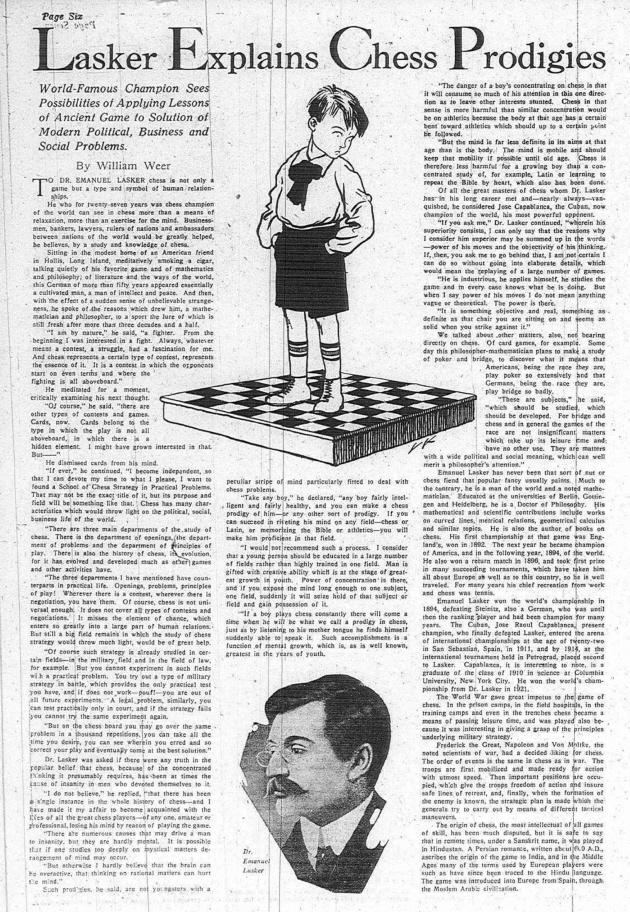
(7665)
A number of websites continue to ascribe to Spielmann, rather than Mieses, the familiar ‘water and poison’ remark concerning Lasker, so it is worth recalling that C.N. 3161 (see pages 246-247 of Chess Facts and Fables) gave three quotes:
1) From an article by Mieses in the Berliner Tageblatt which was reproduced on page 16 of his San Sebastián, 1911 tournament book:
‘Laskers Stil ist klares Wasser mit einem Tropfen Gift darin, der es opalisieren lässt. Capablancas Stil ist vielleicht noch klarer, aber es fehlt der Tropfen Gift.’
2) The translation on pages xix-xx of the French edition of the book:
‘Le style de Lasker pourrait être comparé à de l’eau claire recevant une goutte de poison qui la rendrait opaline; le style de Capablanca est peut-être encore plus clair, mais il y manque la goutte de poison.’
3) An English version by J. du Mont on page 13 of H. Golombek’s book Capablanca’s Hundred Best Games of Chess (London, 1947):
‘Lasker’s style is clear water, but with a drop of poison which is clouding it. Capablanca’s style is perhaps still clearer, but it lacks that drop of poison.’
Chess Facts and Fables explained the misattribution to Spielmann by reproducing page 107 of Irving Chernev’s The Bright Side of Chess (Philadelphia, 1948):
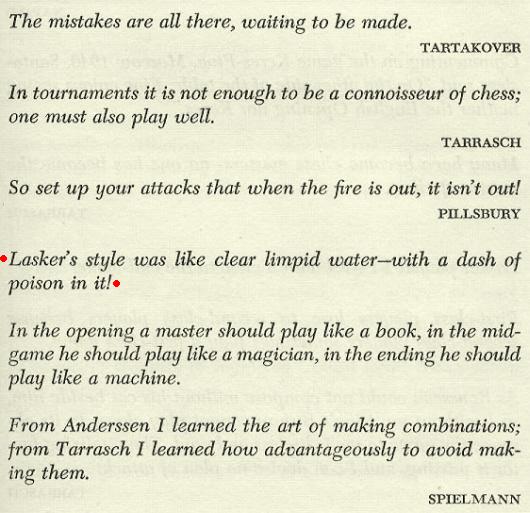
(7697)
See too Muddled Chess Epigrams.
Olimpiu G. Urcan has forwarded, courtesy of Alan Fallert (Chicago, IL, USA), two photographs of Emanuel Lasker in Chicago in the 1930s:
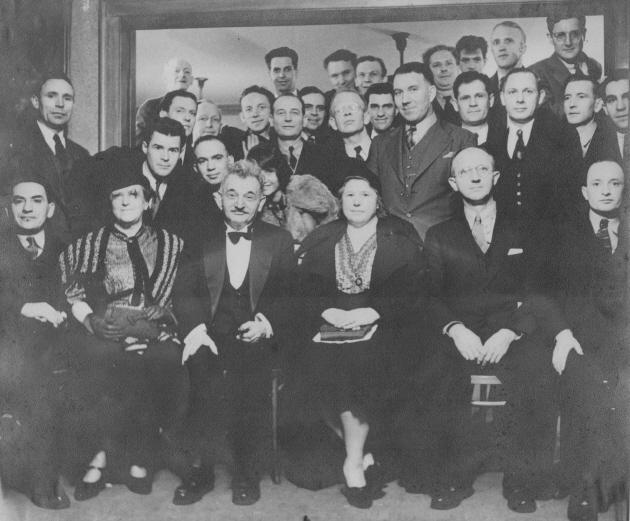

Above, Lasker is making a move against Mr Fallert’s father, Carlton Mross Fallert (1911-76).
In the archives owned by Alan Fallert there is also a 26-page notebook of game-scores and photographs pertaining to the Swedish Chess Club, Chicago in 1939-40, including this portrait:

The Lasker photographs are undated, but we note a reference to a simultaneous exhibition by Lasker at the Swedish Chess Club in Chicago on page 61 of the March 1938 Chess Review. Page 13 of The Collected Games of Emanuel Lasker by K. Whyld (Nottingham, 1998) stated that Lasker gave a display against the Swedish Club in Chicago on 10 December 1937, scoring +21 –1 =5.
Addition on 13 August 2022: when Lasker’s result was given on page 13 of the January 1938 Chess Review it was specified that the loss was by adjudication.
(7738)
John Blackstone draws attention to Pillsbury’s account of Hastings, 1895 in an interview on page 6 of the New York Times, 29 September 1895:
‘Lasker has greater analytical knowledge [than Chigorin], but his body is too feeble to stand the strain of a long tournament ...
Steinitz still wants to play Lasker. He considers himself champion de jure and Lasker champion de facto, but I have left it to the Hastings Chess Club to decide who is champion, and I shall not hesitate to play him whoever he may be. The Hastings Club has already offered a purse for such a match. I shall not challenge the winner of the Lipschütz-Showalter match to be played here. I shall not claim any title, but shall simply stick to business. Then if I can get any I shall go to St Petersburg in November to play in the quintangular tournament ...’
(7760)
Above we have extracted the passages concerning Lasker.
Very similar views by Pillsbury about Chigorin and Lasker were quoted on page 395 of Kings, Commoners and Knaves from page 472 of the November 1895 BCM.
From page 398 of Kings, Commoners and Knaves:
On page 182 of the August-September 1906 issue of Lasker’s Chess Magazine, Emanuel Lasker wrote regarding his first match against Steinitz:
‘When Steinitz entered this contest he felt sure of victory. But when fate went against him and he found himself, for the first time in his life, beaten, he behaved with the utmost chivalry. His way of resigning the last game of the match was to call for cheers for the new champion of the world.’
From World Chess Championship Rules:
Steinitz v Lasker (New York, Philadelphia and Montreal, 15 March-26 May 1894):
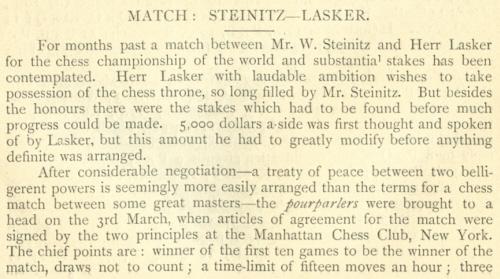

Source: BCM, April 1894, pages 162-163. A signed original (ten pages) of the above-mentioned agreement is owned by David DeLucia, who reproduced the first two pages in the books discussed in C.N.s 3164 and 5323.
Lasker v Steinitz (Moscow, 7 November 1896-14 January 1897):
Page 425 of the November 1896 BCM stated that the return match between Lasker and Steinitz would take place ‘under the same conditions as those of the first match, with the exception of the stake’. On page 468 of the December 1896 issue a summary of the match rules was provided: ‘it will be decided by ten won games, draws not being counted. The time-limit is 15 moves an hour. A purse of £200 will be presented by the Moscow Club to the winner, and £100 to the loser.’
Emanuel Lasker expressed the following view in an autobiographical article in Lasker’s Chess Magazine, May 1908, page 1:
‘The last tournament held there [in England] was in 1899. The continent has had more than a dozen meanwhile. England has not been the playing ground of a match for the championship of the world since Steinitz beat Anderssen, in 1866.’
The inescapable implication of Lasker’s references to England and to 1866 is that he considered a) that Steinitz’s matches against Zukertort (1872) and Blackburne (1876), both of which took place in London, were not for the world title and b) that, consequently, Steinitz held the world title for 20 years (1866-86) without defending it at all. It is hard to imagine, though, that this was the meaning that Lasker intended to convey.
(3325)
Good-quality photographs of the 1921 Lasker v Capablanca match are scarce, and more details are sought about the shot below, from page 175 of Grandmasters of Chess by Harold C. Schonberg (Philadelphia and New York, 1973):
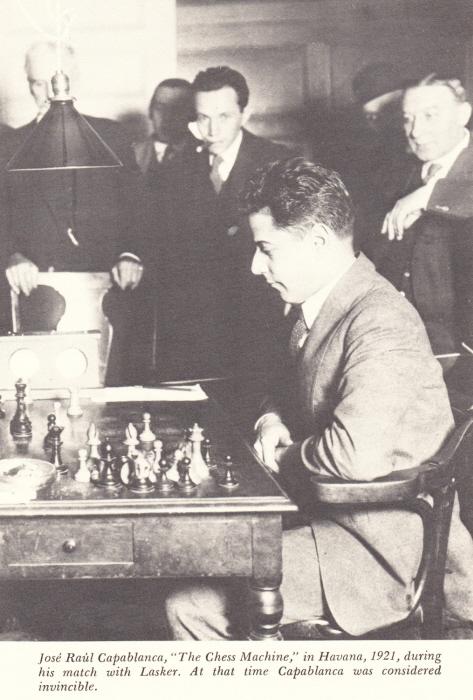
(7815)
From Olimpiu G. Urcan:

‘C.N. 7815 reproduced the above photograph from page 175 of Grandmasters of Chess by Harold C. Schonberg. It was taken not during the 1921 world title match against Lasker but at New York, 1918. From page 3 (photogravure section) of the 22 December 1918 edition of the Baltimore Sun:
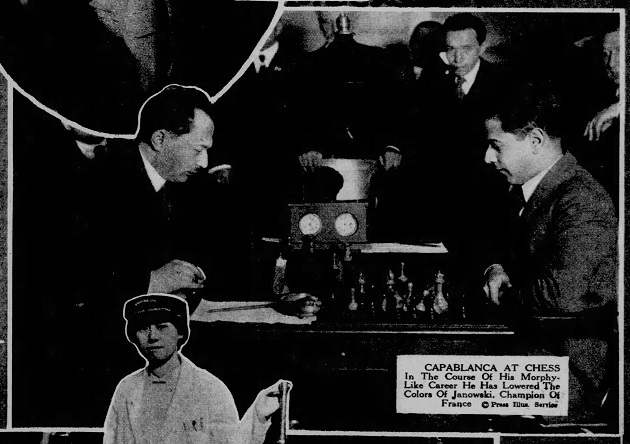
In C.N. 9911 I contributed the picture below from page 394 of Cine-Mundial, June 1921:
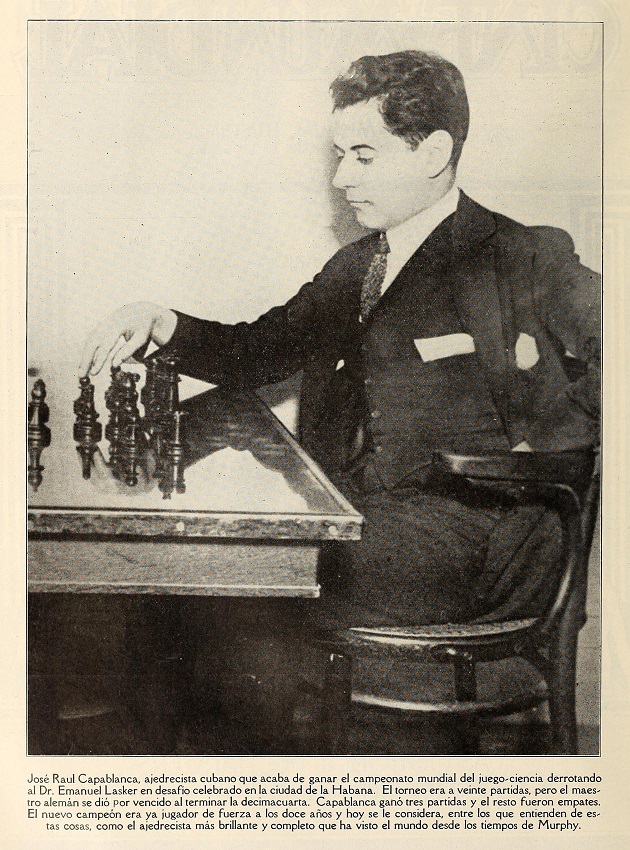
It too was taken at New York, 1918, being a cropped version of the picture given by me in C.N. 10910 from the photogravure section (unnumbered page) of the Baltimore Sun, 1 December 1918:’
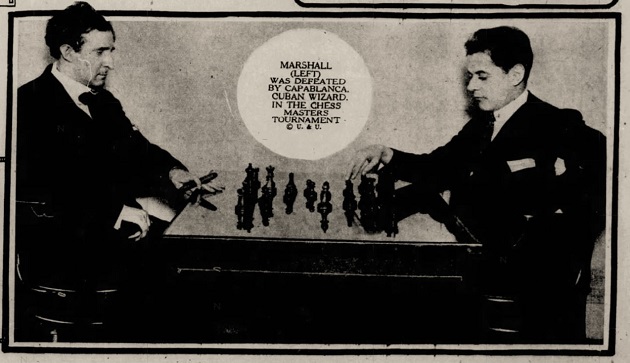
(11757)
An observation by Emanuel Lasker on page 29 of Lasker’s Chess Magazine, November 1904:
‘The chess player is critical and discriminating in his judgment of matters chessic, fastidious in his tastes generally and artistic in his temperament. A chess magazine to please him must therefore be critical and discriminating in the contents of its game, problem and analytical departments, fastidious in its choice of literary contributions and artistic both as to form and substance.’
(7818)
From Chess Journalism and Ethics:
It is worth recalling the words of Emanuel Lasker (American Chess Bulletin, January 1905, page 2):
‘As a general rule, a man whose business it is to sell news to the newspapers should, in my opinion, not be one vitally interested in this news. The public has a right to expect a reporter of events to be an impartial critic and chronicler, serving not his friends or his own interests, but the public.’
The Lasker quote was given in C.N. 1647.
Stuart Rachels (Tuscaloosa, AL, USA) asks about the observation ‘When you see a good move, look for a better one’, which he has seen ascribed, without a source, to Emanuel Lasker.
(7837)
The matter is dealt with in depth in our feature article Chess: ‘When You See a Good Move ...’
From page 15 of Modern Chess Preparation by Vladimir Tukmakov (Alkmaar, 2012), concerning the celebrated Lasker v Capablanca game at St Petersburg, 1914:
‘The young Cuban, who was confidently leading the tournament, needed only not to lose with Black against the current World Champion in order to claim overall tournament victory.’
Some myths endure no matter how often they are disproved, or how easily. Reviewing From Morphy to Fischer by Al Horowitz (London, 1973) W.H. Cozens commented on page 159 of the May 1974 BCM:
‘Horowitz does fall into one historical error – one which has been made by other writers before him – when he speaks [on page 69] of “Lasker’s last-round victory over Capablanca” at St Petersburg, 1914.’
See too, for instance, Larousse du jeu d’échecs. The game was played in the seventh of ten rounds in the final section.
(7846)
Unfounded claims about the involvement of Tsar Nicholas II in the St Petersburg, 1914 tournament are discussed in Chess Grandmasters.
Further to C.N. 7933, which concerned A.E. Santasiere’s book My Love Affair With Tchigorin, a remark by R.E. Fauber about Chigorin is given below, from page 272 of the Chess Digest Magazine, December 1973:
‘He died, mourned by all in 1908. Emanuel Lasker in an uncharacteristic show of emotion declared simply, “I love Mikhail Chigorin”.’
Fauber wrote similarly on page 90 of his book Impact of Genius (Seattle, 1992), but what more is known about such a remark by Lasker?
(7942)
From page 300 of Chess Review, October 1950, in an article ‘The Triumph of Unreason’ by Hans Kmoch and Fred Reinfeld:
‘The following story, no less delightful for probably being apochryphal [sic], conveys Chotimirsky’s qualities admirably: in the St Petersburg tournament of 1909, Chotimirsky defeated both Emanuel Lasker and Rubinstein .,. and managed to come 13th in a field of 19. Regarding his win against Lasker, it is said that he infuriated the world champion by pretending to be deeply absorbed in a Japanese translation of Also Sprach Zarathustra during their game.’
The article was reproduced in Reinfeld’s The Treasury of Chess Lore (New York, 1951); see page 161.
The anecdote also appeared (‘There is a story to the effect that ...’, but with no mention of Japanese) on page 131 of another Reinfeld book, The Great Chess Masters and Their Games (New York, 1952). And again on page 82 of a further Reinfeld work, How to Play Winning Chess (New York, 1962):
‘The story is told that during the course of his game with Emanuel Lasker (the world champion) in the St Petersburg tournament of 1909, Chotimirsky read a Japanese translation of Thus Spake Zarathustra. Legend has it that the world champion was so incensed at the young man’s studied insolence that he lost the game. Whatever the cause of his defeat, Lasker was singularly reticent about this encounter.’
Two or three years later Lasker made some remarks about Dus-Chotimirsky in an item in the New York Evening Post, as related on page 67 of the March 1912 American Chess Bulletin, but there was no reference to their game in St Petersburg or to the episode so flimsily recounted by Reinfeld (‘It is said that ...’, ‘There is a story to the effect that ...’, ‘The story is told that ...’ and ‘Legend has it that ...’).
(7943)
Noting some observations attributed to Emanuel Lasker on pages 5, 11 and 181 of Improve Your Chess Results by Vladimir Zak translated by John Sugden (London, 1985), Jean-Pierre Rhéaume queries, in particular, the first of these, which reads:
‘In his Manual of Chess, Lasker wrote:
“A combination takes shape in a player’s head. Many thoughts – correct and erroneous, strong and weak, practical and impractible [sic] – strive for realisation. They keep being generated and contending amongst themselves, until one of them prevails over its rivals and is embodied on the chessboard in the shape of a move.”’
Our correspondent has been unable to find that passage in the Manual and asks for clarification.
Firstly, we note that the relevant text was on page 7 of the original of Zak’s work, Пути совершенствования (Moscow, 1981); Zak quoted accurately from Lasker’s book Учебник шахматной игры. Below is the text as it appeared on page 101 of the first edition (Moscow and Leningrad, 1926):
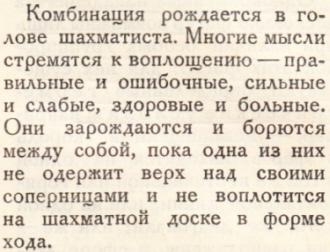
The Russian work was translated from Lehrbuch des Schachspiels (Berlin, 1926), page 97 of which had the following:
‘Die Kombination wird im Kopfe eines Schachfreundes geboren. Viele Gedanken kommen da zur Welt, richtige und falsche, starke und schwache, gesunde und kranke. Sie kommen zur Welt und stoßen einander, und einer trägt den Sieg davon über die Rivalen und setzt sich in einen Zuge auf dem Schachbrett um.’
Finally, below is the English version on pages 127-128 of Lasker’s Manual of Chess (New York, 1927):
‘The combination is borne in the brain of a chessplayer. Many thoughts see the light there – true and false, strong and weak, sound and sick thoughts. They are borne and jostle one another, and one of them, transformed into a move on the board, carries the victory over its rivals.’ [The wording was slightly different (e.g. born, not borne) on page 114 of the 1932 edition of the Manual.]
It would not have required excessive effort for Improve Your Chess Results to give Lasker’s own English text.
(7985)
From The Most Famous Chess Quotations:
Lehrbuch des Schachspiels by E. Lasker (Berlin, 1926), page 201.
Lasker’s Manual of Chess by E. Lasker (New York, 1927), page 262.
Note: ‘lie’ became ‘lies’ on page 235 of the London, 1932 edition.
From pages 190-191 of New Ideas in Chess by Larry Evans (New York, 1958), as well as pages 180-181 of the New York, 1969 edition:

The highlighted sentence has been lifted without credit from Emanuel Lasker’s Manual. See, for instance, page 262 of the New York, 1927 edition:
‘On the Chess-board lie and hypocrisy do not survive long. The creative combination lays bare the presumption of a lie; the merciless fact, culminating in a checkmate, contradicts the hypocrite.’
Ronald Spurgeon (Sutton, England) draws attention to a feature on page 169 of the November 1923 American Chess Bulletin:
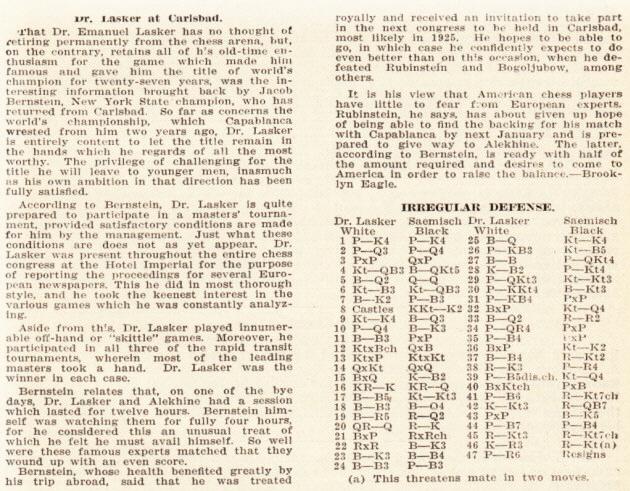
Our correspondent asks whether anything further is known about the rapid transit tournaments and about the Lasker v Sämisch game given by the Bulletin.
We have found the score on page 6A of the Brooklyn Daily Eagle, 21 June 1923:
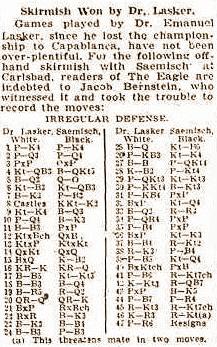
Emanuel Lasker – Friedrich Sämisch
Carlsbad, 1923
King’s Pawn Opening
1 e4 e5 2 d3 d5 3 exd5 Qxd5 4 Nc3 Bb4 5 Bd2 Qd8 6 Nf3 Nc6 7 Be2 f6 8 O-O Nge7 9 Ne4 Bd6 10 d4 Be6 11 Bc3 exd4 12 Nxd6+ Qxd6 13 Nxd4 Nxd4 14 Qxd4 Qxd4 15 Bxd4 Kf7 16 Rfe1 Rhd8 17 Bc5 Ng6 18 Bf3 Bd5 19 Bh5 Rd7 20 Rad1 Re8 21 Bxa7 Rxe1+ 22 Rxe1 Be6 23 Be3 Bf5 24 Bf3 c6 25 Bd1 Ne5 26 f3 Nc4
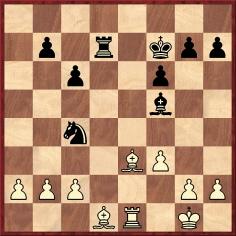
27 Bc1 b5 28 Kf2 g5 29 b3 Nb6 30 g4 Bg6 31 f4 gxf4 32 Bxf4 Nd5 33 Bd2 Ra7
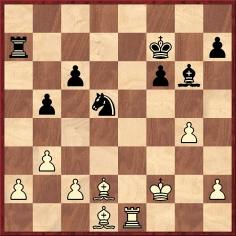
34 a4 bxa4 35 c4 axb3 36 Bxb3 Ne7 37 Bf4 Rb7 38 Re3 h5 39 c5+ Nd5 40 Bxd5+ cxd5 41 c6 Rb2+ 42 Kg3 Rc2 43 gxh5 Be4 44 c7 f5 45 Rb3 Rg2+ 46 Kh3
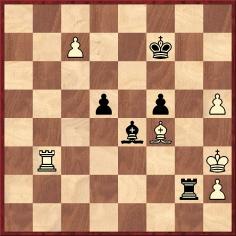
46...Rg8 47 h6 Resigns.
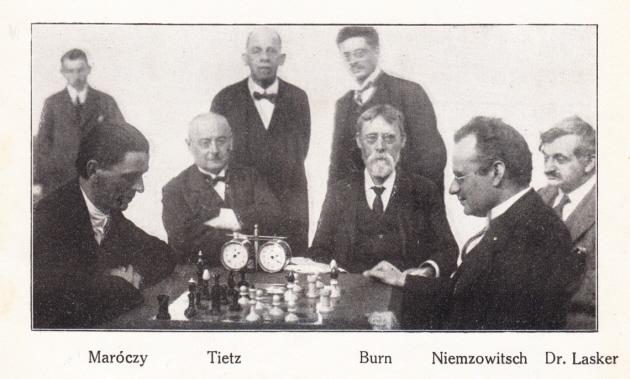
Source: Carlsbad, 1923 tournament book
Regarding rapid transit games in Carlsbad, C.N. 1050 (see page 9 of Chess Explorations) gave the conclusion of Tartakower’s win against Alekhine on 8 May 1923.
(8000)
Ronald Spurgeon asks about the caption to a photograph on page 1029 of Emanuel Lasker: Denker Weltenbürger Schachweltmeister edited by R. Forster, S. Hansen and M. Negele (Berlin, 2009). It states that in summer 1925 Lasker and Nimzowitsch played a match of ten off-hand games, Lasker winning 7-3.
We can do no better at present than reproduce the brief report in the source indicated by the book, i.e. from page 309 of Deutsche Schachblätter, 15 July 1925:

(8001)
Dominique Thimognier has forwarded a shot of Alekhine which was published on page 29 of La Tunisie Revue Mensuelle Illustrée, February 1938:
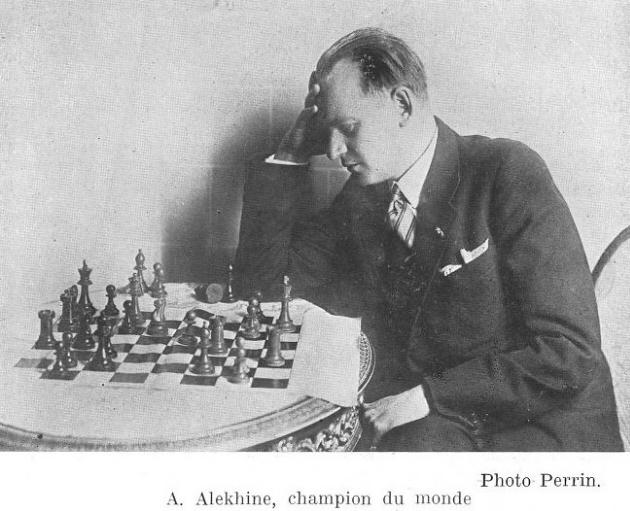
Our correspondent adds that according to the article which followed, the photograph was taken during the world champion’s tour of Tunisia in December 1934.
We note that the position is the conclusion of Alekhine’s victory over Lasker in Zurich earlier that year.
(8043)
John Nunn (Chertsey, England) submits two queries about games by Emanuel Lasker:
‘The first relates to Showalter v Lasker, game six of their 1892-93 match:
This position arose after White’s 48th move. The conclusion of the game, as given in both Mega Database and the Weltgeschichte des Schachs book on Lasker (Hamburg, 1958), was 48...Ke6 49 Nc1 h3 50 Nd3 Bg1 51 a6 Kf5 52 Kc3 Bxh2 53 Nf2 Bg1 54 Nxh3 Bb6 0–1.
From the chess point of view, this makes little sense. Although it does not throw away the win, 48...Ke6 has no point whatsoever. Moreover, with these moves 50...Bg1 is a blunder which allows a simple draw by 51 Nf4+, etc. The whole thing makes much more sense if Black had played 48...Ke4 instead, but is there any evidence for this?’
Black’s 48th move was indeed given as ...Ke4, and not ...Ke6, when the game was published, with notes by both players, on pages 152-153 of the 14 July 1893 issue of Lasker’s magazine, the London Chess Fortnightly:
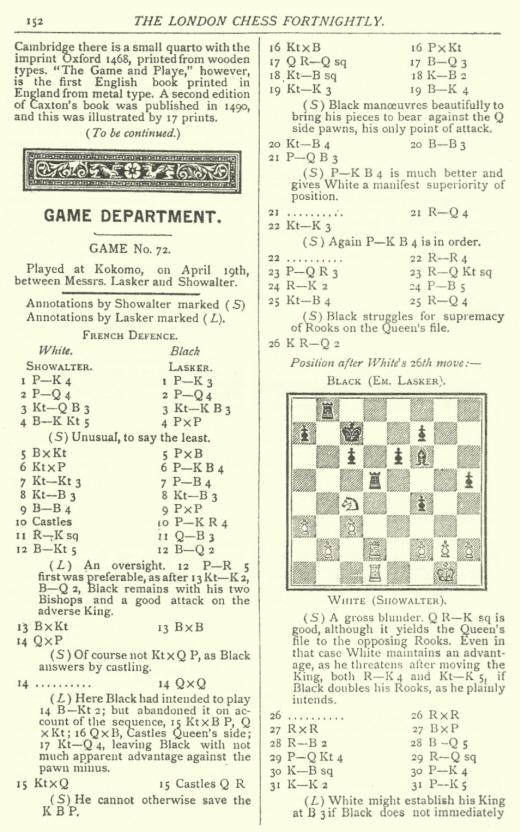
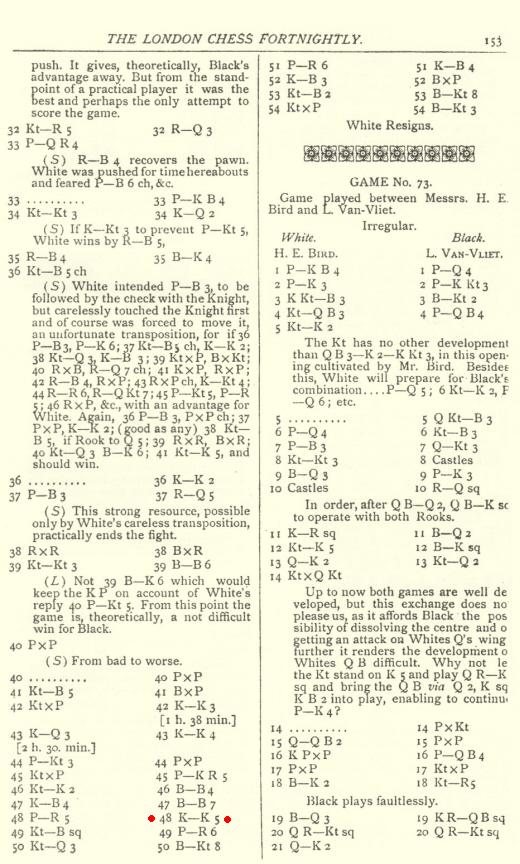
48...Ke4 was also the move specified when the game appeared on pages 298-299 of the September-October 1893 American Chess Monthly. The notes were by Pollock, Lasker and Showalter, the score was from the Pittsburgh Dispatch, and the game was dated 22 April 1893.
‘My second query relates to the game Walter v Lasker, Mährisch-Ostrau, 1923. After the initial moves 1 d4 d5 2 e3 Nf6 3 Bd3 Bg4 4 Nf3 e6 5 c4 Nbd7 6 Qb3 Bxf3 7 gxf3 c5 8 cxd5 exd5 9 Qxb7 cxd4 10 exd4 Bd6 11 Nc3 O-O 12 Nxd5 Qa5+ 13 Nc3 Qh5 14 Be2 Rab8 there are two versions for the continuation:
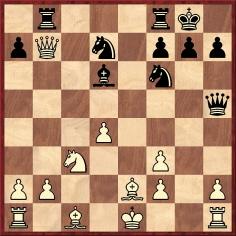
Mega Database gives Version A: 15 Qxa7 Rb6 16 Qa4 Re8 17 Ne4 Nd5 18 Nxd6 Rxd6 19 O-O Rde6 20 Re1 Qh3 21 Kh1 Rxe2 0-1, and according to Soltis on pages 234-235 of Why Lasker Matters (London, 2005) this is the version given in the tournament book.
Version B runs 15 Qa6 Rb6 16 Qd3 Re8 17 Ne4 Nd5 18 Nxd6 Rxd6 19 O-O Rde6 20 Re1 Qh3 21 Kh1 Rxe2 0–1, and this is the version which Soltis gives in the afore-mentioned book and which appears in the Weltgeschichte des Schachs book. From the chess point of view, Version B is far more logical (if only because of the missed 18 Qxd7 in version A), but if, as Soltis says, Version A is the one given in the tournament book, what is the source for Version B and how reliable might it be?’
Although 15 Qxa7 was given in the tournament book by Bernhard Kagan (page 50), that version of the score was corrected on page 48 of Albert Becker’s book on the event which was published by M.A. Lachaga in Argentina in 1977:
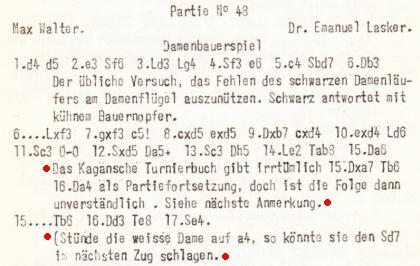
Contemporary sources confirm that the moves 15 Qa6 Rb6 16 Qd3 were played, an example being pages 180-181 of the August 1923 Deutsche Schachzeitung, where the game was annotated by Ernst Grünfeld.
(8050)
From page A3 of the Brooklyn Daily Eagle, 12 June 1924 (column by Hermann Helms):
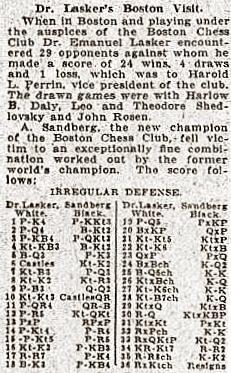
Emanuel Lasker – A. Sandberg
Boston, 24 May 1924
King’s Fianchetto Defence
1 e4 g6 2 d4 Bg7 3 f4 b6 4 Nf3 Bb7 5 Bd3 e6 6 O-O Ne7 7 Nc3 d6 8 Ne2 Na6 9 c3 Qd7 10 Ng3 O-O-O 11 a4 Rdf8 12 a5 Nb8 13 axb6 axb6 14 b4 h5 15 b5 h4 16 Ne2 f6 17 Ra7 e5 18 Be3 f5
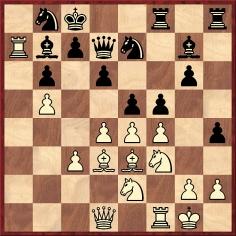
19 d5 fxe4 20 Bxe4 Qxb5 21 Ng5 Nxd5 22 Ne6 Nxe3
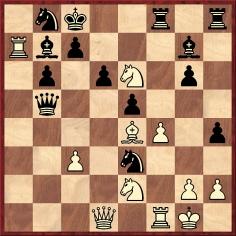
23 Qxd6 cxd6 24 Bxb7+ Kd7 25 Bd5+ Ke8 26 Nxg7+ Kd8 27 Ne6+ Ke8 28 Nc7+ Kd8 29 Nxb5 Nxd5 30 Rd1 Nxf4 31 Nxf4 exf4 32 Rxd6+ Ke8 33 Rxb6 Nd7 34 Rbb7 Rh7 35 Ra8+ Ke7 36 Rxd7+ Resigns.
It is difficult to understand why this game (although with 8...Nbc6 and 35 Rb8+) was given on pages 328-329 of the 4/2000 edition of the Quarterly for Chess History with the statement that the display took place in Boston on 5 February 1926, as supposedly reported in the ‘Boston Evening Transcript, January 1926’ [sic].
(8117)
Patsy A. D’Eramo (North East, MD, USA) forwards page 4 of the San Francisco Chronicle, 11 January 1903, comprising a lengthy article entitled ‘A Chess Talk with Lasker the Champion’.
Among the interesting material is an explanation of a game invented by him, checkerette, and the following comments on chess:
‘I am sorry to say that I do not much care whether I win or not now.’
‘At present a stalemate is regarded as a drawn game. Undoubtedly it will soon be considered a victory for the player who places his opponent in such a position.’
The newspaper also reproduced a Troitzky study in Lasker’s hand:
The composition, dated 1897 and with the knight on g6 instead of h5, is on pages 69-70 of Collection of Chess Studies by A.A. Troitzky (Leeds, 1937).
(8188)
Pages 14-15 of the Winter 1980-81 issue of the Chess Journalist had an article by Albrecht Buschke about Horace Ransom Bigelow (1898-1980) entitled ‘Library of a Great Chess Journalist’. From page 14:
‘For the first American edition of Lasker’s Manual of Chess he compiled a very comprehensive index, which, strangely, in later editions was either suppressed or plagiarized without mentioning his name.
This collaboration with Lasker earned him a very warm handwritten dedication by the famous author reading:
“To one who co-operated with me on this book and who continued the tradition of my Evening Post column in brilliant style. To Horace Ransom Bigelow with kindest regards. Emanuel Lasker. New York, 19th of Sept., 1928.”
No higher praise from a competent authority can be imagined in connection with the famous chess column Bigelow conducted for decades in the New York Post, and this column, indeed, must be considered his greatest achievement.’
We are grateful to David DeLucia (Darien, CT, USA), who now owns the book, for permission to show the inscription:
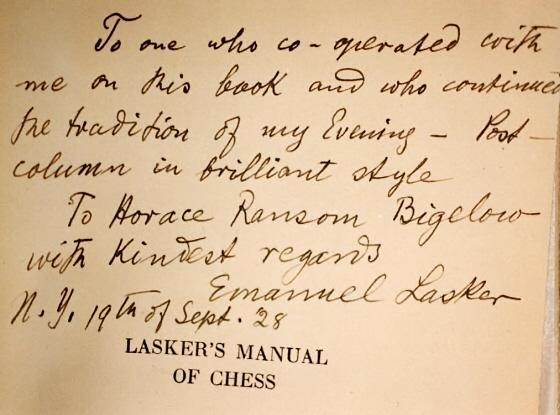
It is unclear which editions of the Manual Albrecht Buschke had in mind when referring to suppression and plagiarism. Bigelow was credited on page 377 of the original edition (published by E.P. Dutton & Company, New York in 1927), and on pages 375-376 he contributed an explanatory text entitled ‘Introduction to Index’. As regards the 1932 edition, published by Printing-Craft Limited, London, the text and index were different, and there was thus no reason for Bigelow to be mentioned. Later editions of the Manual (a revision by Reinfeld published by David McKay Company in 1947 and reprinted by Dover Publications, Inc. in 1960) are based on the 1932 edition.
The entry 10-172 on page 113 of Douglas A. Betts’ Chess An Annotated Bibliography of Works Published in the English Language 1850-1968 (Boston, 1974) concerns an edition of the Manual edited by Reuben Fine which is unknown to us:

Was it ever published?
(8232)
Rick Kennedy (Columbus, OH, USA) notes an entry at the website of the Cleveland Public Library under the heading ‘Reuben Fine Chess Collection’:
‘Fine’s revision of Emanuel Lasker’s Manual of chess published by Dutton in 1942 (27 cm.).’
We are grateful to the Library for permission to show here some sample pages of the work, which, it seems, was not published.
(8236)
The space-filling potential of the smoking-threat anecdote involving Nimzowitsch and a variable supporting cast (Lasker, Vidmar, Tartakower, Bogoljubow, Maróczy and Lederer) is a godsend for a certain type of ahistorical chess author. He may even decide to write a playlet:
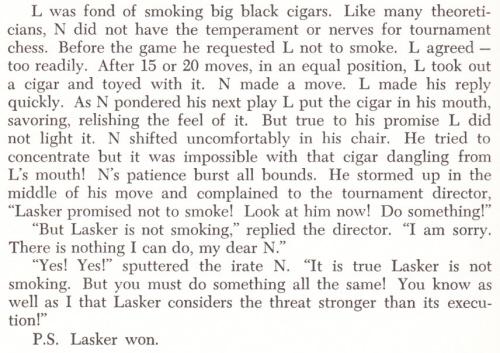
Source: page 86 of Chess Beginner to Expert by Larry Evans (Wellesley Hills, 1967).
(8249)
Olimpiu G. Urcan has supplied a cutting from page 7 of the Philadelphia Inquirer Magazine, 18 October 1914, which quotes the views of Emanuel Lasker as expressed to Walter Penn Shipley:

(8260)
Eduardo Bauzá Mercére has submitted a report by Hermann Helms on page 35 of the New York Sun, 21 September 1940:

Emanuel Lasker – Walter Murdock
Hamilton, 23 August 1940
Ruy López
1 e4 e5 2 Nf3 Nc6 3 Bb5 a6 4 Ba4 Nf6 5 O-O Nxe4 6 d4 b5 7 Bb3 d5 8 dxe5 Be6 9 c3 Be7 10 Nbd2 Nc5 11 Bc2 O-O 12 Nb3 Nd7 13 Re1 Qc8 14 Nbd4 Nxd4 15 cxd4 c5 16 dxc5 Nxc5 17 h3 Bf5 18 Bg5 Bxg5 19 Nxg5 h6 20 Nf3 Bxc2 21 Qxc2 Ne6 22 Qd2 d4 23 Rac1 Qb7 24 Rc2 Rac8 25 Rec1 Rxc2 26 Rxc2 Rd8 27 Rc1 Qe4 28 Re1 Qd5 29 a3 Rc8 30 Rc1 Rc4 31 Kf1 Nc5 32 Rd1 Nb3 33 Qd3 Rc7 34 Ke1 Rd7 35 Kf1 a5 36 Re1 a4 37 Kg1 Rc7 38 Rd1 Rc1 39 Rxc1 Nxc1 40 Qc2 Nb3 41 Qd3 Kf8
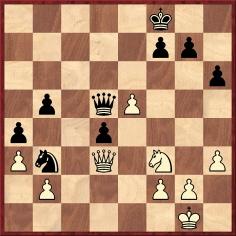
42 h4 g6 43 h5 Qc4 44 Qe4 d3 45 Qa8+ Kg7 46 hxg6 Qc1+ 47 Kh2 Qf4+ 48 Kg1 d2 49 Qd8 Kxg6 50 e6
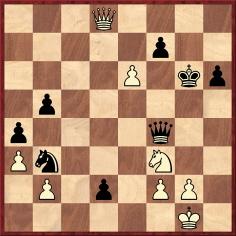
50...Qd4 51 Qg8+ Qg7 52 Qxg7+ Kxg7 53 Nxd2 fxe6 54 Nxb3 axb3 55 Kf1 Kf6 56 Ke2 Kf5 57 Kd3 e5 58 Kc3 Ke4 59 Kxb3 Kd3 60 Kb4 e4 61 Kc5 Ke2 62 Kd4 Kxf2 63 Kxe4 Kxg2 64 Kf4 h5 65 Kg5 Drawn.
(8358)
John Nunn writes:
‘I have been looking at some world championship games from the early twentieth century, and I have a query about the repetition rule in force at the time. Two examples:
This is from Schlechter v Lasker, Game 1, Vienna, 1910. Play continued 56 Rxa5 Rc4 57 Ra6+ Ke5 58 Ra5+ Kf6 59 Ra6+ Ke5 60 Ra5+ Kf6.
The position after Black’s 56th move was repeated at Black’s 58th and 60th moves, so under modern rules Black could have claimed a draw before playing 60...Kf6.
The second position occurred in Janowsky v Lasker, Game 8, Berlin, 1910. The game continued 49 Qd6+ Kb7 50 Qe7+ Kc6 51 Qd6+ Kb7 52 Qe7+ Kb6 53 Qd8+ Kb7 54 Qd7+ Kb6 55 Qe6+ Kc7 56 Qf7+ Kb8 57 Qf4+ Kb7 58 Qf7+ Kb8 59 Qf8+ Kc7 60 Qf4+ Kc6 61 Qd6+ Kb7.
The positions after 49...Kb7, 51...Kb7 and 61...Kb7 are identical, so again Black could have claimed a draw (at this point a draw claim would have been perfectly reasonable even though Black actually won the game).
As I understand it, at one time the repetition rule required that the moves had to be repeated, rather than the positions. Thus in the first example the moves leading to the positions were not the same, being ...Rc4 in one case and ...Kf6 in the other two cases. The second specimen is a little different, in that the move preceding the repeated positions was in every case ...Kb7, but the king came from c6 twice and from c7 once.
My main question is whether anyone knows the exact rule which was in force at the time and, in particular, what was the rule for these world championship matches. I would also be interested to know when the modern form of the rule was introduced.
A repetition rule involving moves must be fairly complicated to cater for repetitions which are more than simple to-and-fro sequences (as in the second example). There is also the question as to whether Qg6xPh6+ is the “same” move as Qg6-h6+, for example, not to mention the matter of castling and en passant rights.’
For Lasker’s world championship matches against Schlechter and Janowsky no consolidated versions of the complete regulations have come to light, and we have found nothing specific about repetition of positions or moves, although the possibility of a draw in the Schlechter v Lasker game was mentioned in vague terms on page 24 of the 16 January 1910 issue of Deutsches Wochenschach:
‘Man sieht, Weiß hat das Remis in der Hand, versucht aber begreiflicherweise auf Gewinn zu spielen.’
The origins of the repetition rule were discussed in C.N.s 3461 and 5695. The wording quoted in the former item (‘If the same position occurs thrice during a game, it being on each occasion the turn for the same player to move, the game is drawn’) also appeared as Rule VII in the ‘Revised International Code’ on page 9 of the English-language Hastings, 1895 tournament book. In that event a practical case arose during Blackburne’s game against Albin. A note by von Bardeleben to 71...Rc8 was contradicted by the tournament book editors (page 118):
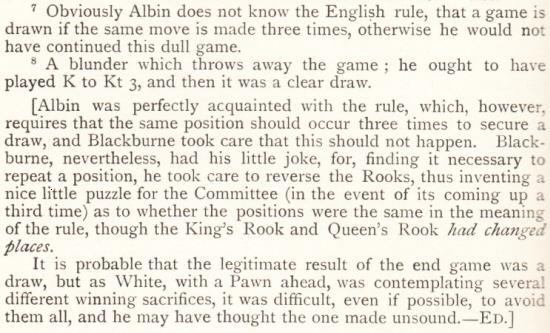
In the British Chess Code (London, 1899 and 1903) the relevant provision was formulated differently:
‘A game is treated as drawn if, before touching a man, the player whose turn it is to play claims that the game be treated as drawn, and proves that the existing position existed, in the game and at the commencement of his turn to play, twice at least before the present turn.’
In Germany a different rule had been in force, enshrined in the Statuten und Meisterturnierordnung des Deutschen Schachbundes, which were adopted in Nuremberg on 15 July 1883:

Source: Nuremberg, 1883 tournament book, page 11:
A comparable provision was still applied in the twentieth century. For example, the following was given by Johann Berger on page 95 of the March 1906 Deutsche Schachzeitung:
‘Als unentschieden gilt auch die Partie, wenn dreimal hintereinander beide Gegner dieselben Züge oder Zugreihen machen.’
An English translation appeared, with discussion, on page 233 of the May 1910 Chess Amateur:
‘The game is also counted as drawn, if three times in succession both sides make the same moves or series (plural) of moves [same moves or groups of moves].’
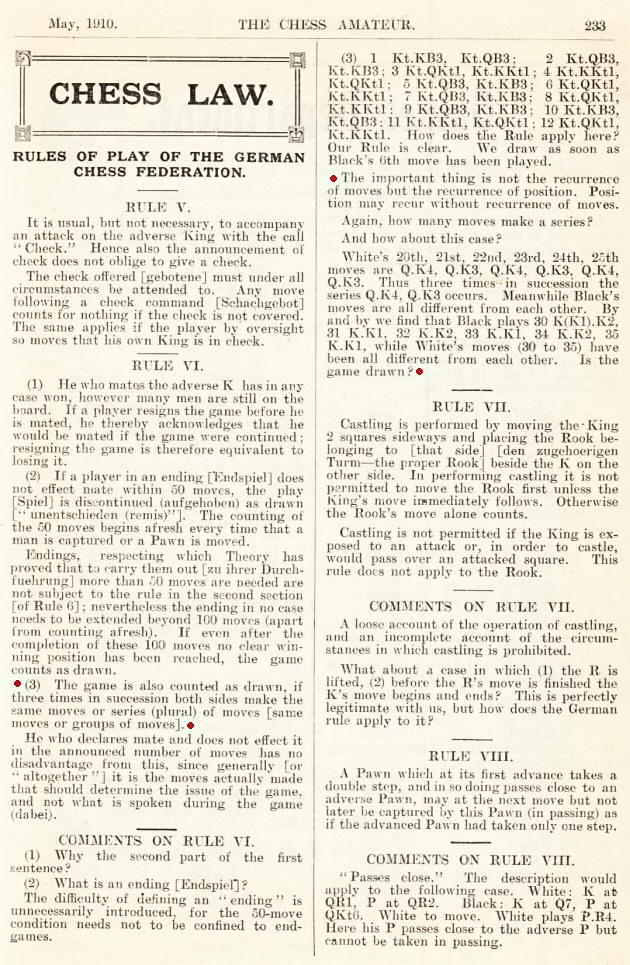
(8395)
A simultaneous game submitted by Eduardo Bauzá Mercére:
Emanuel Lasker – Magnus Smith
Brooklyn, 20 November 1907
Muzio Gambit
1 e4 e5 2 f4 exf4 3 Nf3 g5 4 Bc4 g4 5 O-O gxf3 6 Qxf3 Qf6 7 d3 Bh6 8 Nc3 Ne7 9 Bxf4 Bxf4 10 Qxf4 Qxf4 11 Rxf4 Nbc6 12 Bxf7+ Kd8 13 Bh5 Ng6 14 Bxg6 hxg6 15 Raf1 d6 16 Rf8+ Rxf8 17 Rxf8+ Ke7 18 Rh8 Nb4 19 a3 Nxc2 20 Nd5+ Kf7 21 Nxc7 Rb8 22 Nb5 Ke7 23 Nxa7 Kd7 24 Nb5 Ra8 25 Rg8 Ra5 26 Nxd6 Kxd6 27 Rxc8 Ne3 28 h3 [The next two moves were omitted from the game-score.] 28...Nd1 29 Rg8 g5

30 d4 Nxb2 31 e5+ Kc7 32 Rxg5 Rxa3 33 h4 Ra4 34 Rg4 Nd3 35 Re4 Nc5 36 Rf4 Ne6 37 Rf7+ Kc6 38 d5+ Kxd5 39 Rxb7 Rxh4 Drawn.
Source: Winnipeg Free Press, 30 November 1907, page 6:
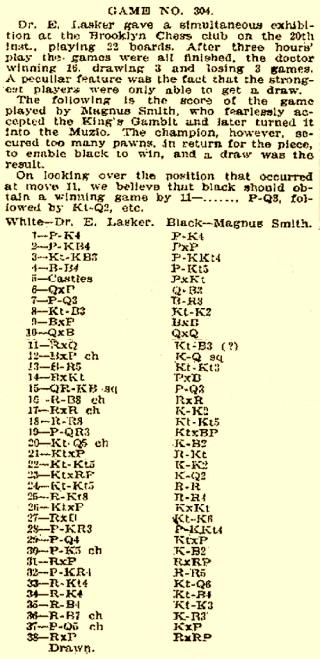
(8503)
Below is a brief extract from an article ‘Some Chess Celebrities Whom I Have Met’ by Rhoda A. Bowles on pages 23-27 of The Year-Book of Chess, 1907 by E.A. Michell (London, 1907):
‘Dr Lasker has also helped me considerably, and I well remember the first, and lasting, advice he gave me: “Attack always, and go on attacking. Never mind if you lose a game or two, you will benefit by these losses. Set yourself to learn a lesson from each, so that you may not lose in the same way again, and by degrees you will become stronger, and your attacking tactics will assist you greatly.”’
For Rhoda A. Bowles’s reminiscences of Steinitz, see Steinitz v von Bardeleben.
(8550)
‘The literature of chess in the English language is enormous in size, but insignificant in value. One might label it for the most part: “Author: Mediocrity. Beware! Poison!” In matters of mentality mediocrity is poisonous. It quenches the thirst for knowledge by unhealthy stuff.’
So wrote Emanuel Lasker, and below is the text as it appeared on pages 171-172 of the August 1911 American Chess Bulletin. Can the original publication in the New York Evening Post be found?
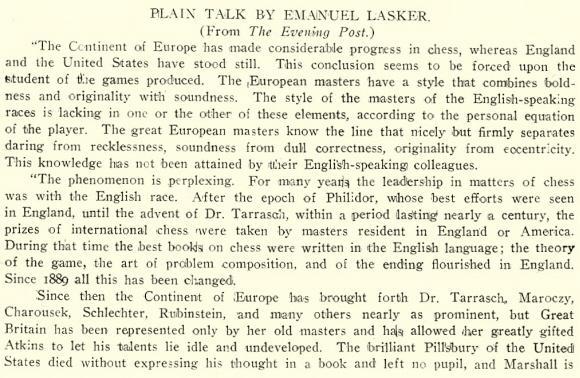

(8624)
Dwight Weaver (Southaven, MS, USA) draws our attention to his article World Chess Championship in Tennessee – 1907, which includes an account of Marshall’s protest over the use of stop-watches rather than a chess clock.
(8641)
Concerning the Lasker v Capablanca world title match, won by the Cuban with four wins, ten draws and no losses, C.N.s 814 and 2470 pointed out a claim on page 75 of La Stratégie, April 1921 that there had been a 15th game, played on 26 April (a Queen’s Gambit Declined supposedly won by Capablanca in 25 moves):
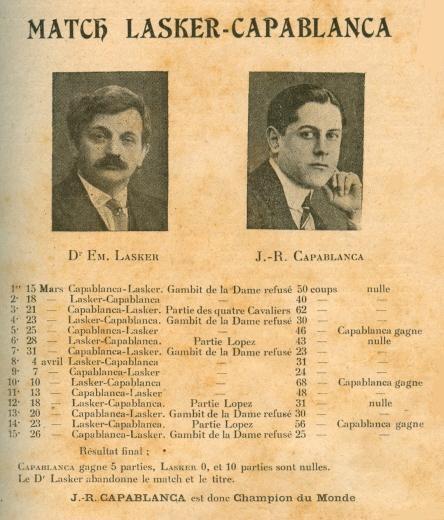
See page 187 of Chess Explorations and pages 356-357 of A Chess Omnibus. A comment by La Stratégie on page 115 of its May 1921 issue was also given in the latter book:
‘La quinzième et dernière partie du match, un Gambit de la Dame refusé, jouée, dit-on, le 26 avril, ne comporte que les quelques premiers coups de ce début, le Dr E. Lasker abandonna sans que sa position présentât le moindre désavantage; mais probablement pour mettre fin à une lutte qui lui était désormais impossible de soutenir avec succès.’
In C.N. 2470 we remarked:
It was intended to be a match of eight games up. Capablanca won the 14th game, concluded on 21 April, which made the score +4 –0 =10 in his favour. Lasker’s brief letter to Judge Alberto Ponce in which he proposed to resign the match was dated ‘Havana, 27 April 1921’. Page 101 of the May-June 1921 American Chess Bulletin gave the text, together with Ponce’s reply of the same date, which confirmed that Capablanca and the organizing committee accepted the proposal. On page 97 of that issue the Bulletin commented:
‘The great chess match, which made Cuba the cynosure for all eyes in the chess world, came to an end on 21 April. On that date the 14th and last game was contested. A few days later, officially on 27 April, though a mysterious press association “beat” made it two days earlier, Dr Lasker sent his resignation to the committee.’
Here, we add that La Stratégie was not alone in suggesting the existence of a 15th game. From page 80 of the May 1921 Schweizerische Schachzeitung:
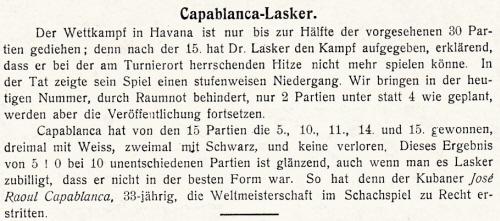
And from page 88 of the June 1921 issue of the Swiss magazine:
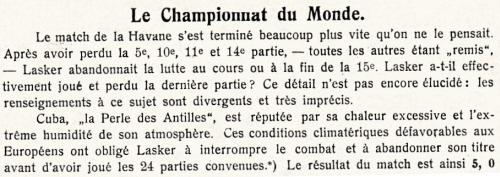
Wanted: other contemporary reports of an alleged 15th match-game, and, more generally, information on how the misunderstanding arose.
C.N. 3035 (see pages 241-242 of Chess Facts and Fables) noted Harry Golombek’s mistaken claims that the match comprised 18 games:
(8656)
C.N. 8474 referred to pages 27-28 of Euwe’s book Meet the Masters (London and his introduction to Alekhine v Lasker, Zurich, 1934:
‘Curious is Alekhine’s knack of developing a seemingly harmless attack, within a few moves, into a hurricane which smashes down all resistance. His methods are simple; it is not so much any particular move which is important, as the whole series of moves – and the move after that! He is a poet who creates a work of art out of something which would hardly inspire another man to send home a picture postcard.’
From page 58 of Blunders and Brilliancies by Ian Mullen and Moe Moss (Oxford, 1990):
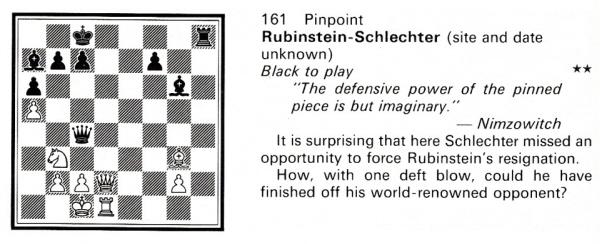
The co-authors did not state their source for the position. Such a finish (with the move ...Be3 overlooked) did occur in a game (Berlin, 1918) between the players named, but Schlechter was White. The position, moreover, was slightly different:
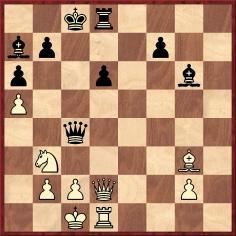
The game was annotated by Emanuel Lasker (who mentioned the players’ extreme time-trouble at move 30) on pages 14-15 of Das Großmeister-Turnier im Kerkau-Palast zu Berlin im Oktober 1918:
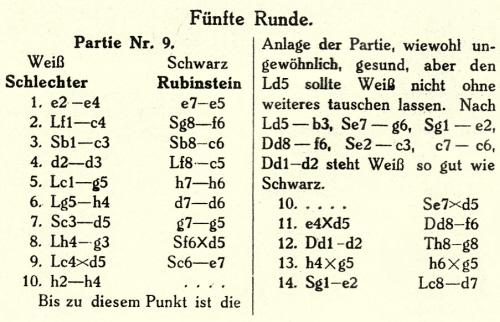
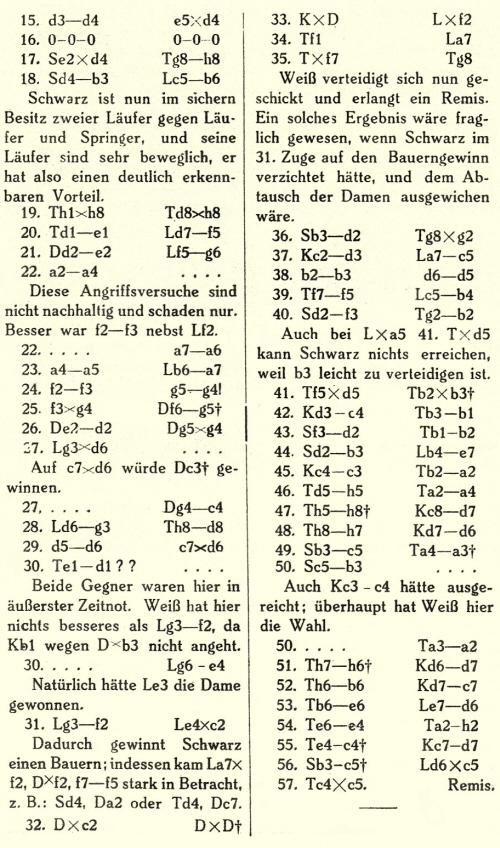
See too page 321 of volume one of The Life & Games of Akiva Rubinstein by John Donaldson and Nikolay Minev (Milford, 2006).
(8715)
From page 105 of Chess Rules of Thumb by Lev Alburt and Al Lawrence (New York, 2003):
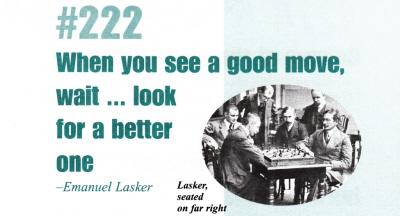
The advice attributed to Lasker is many, many centuries older, as shown in C.N.s 7837 and 7841. Nor should Lasker’s name appear in connection with the well-known photograph, which was the frontispiece to Der Schachwettkampf Schlechter-Tarrasch (Leipzig, 1912):
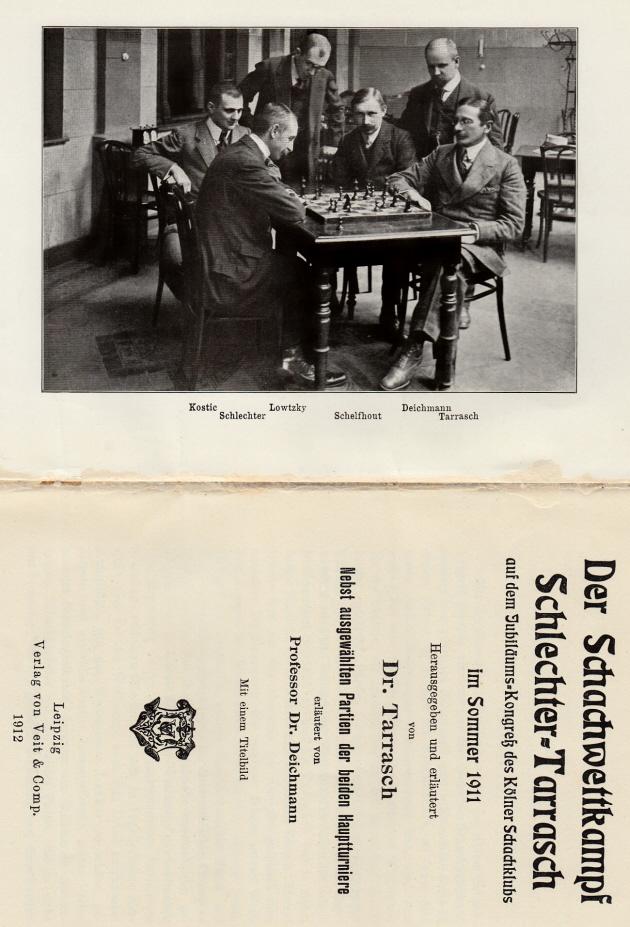
(8738)
See also Chess: ‘When You See a Good Move ...’
‘The first recognized world championship was played between two Germans – Tarrasch and Lasker – and took place at Munich in 1908, resulting in a victory for Lasker.’
Source: Learn to Play Chess by King’s Pawn, page 6.
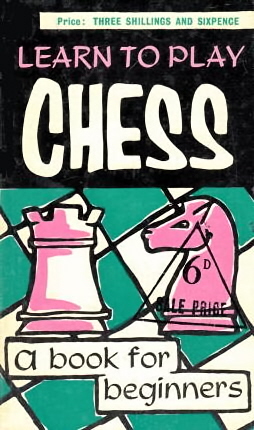
The book, undated, was published by The Liverpolitan Ltd. in Birkenhead, England. Its entry on page 132 of D.A. Betts’s Annotated Bibliography gave 1961 as the year of publication and indicated that the identity of King’s Pawn was unknown.
(8781)
Concerning two positions on pages 324-325 of Lasker’s Manual of Chess (London, 1932), Jean-Pierre Rhéaume asks where and when they occurred.
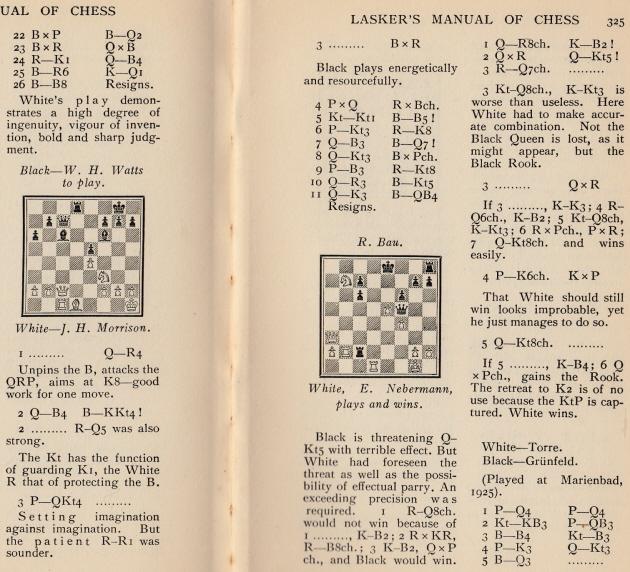
W.H. Watts was the publisher and sub-editor of the 1932 edition of the Manual. The first edition (New York, 1927) did not have the Morrison v Watts game, and it is also absent from the German editions that we have consulted.
A possible lead is that Watts defeated Morrison in the 1924-25 Christmas Congress in London (as shown by the crosstable on page 68 of the February 1925 BCM). At the time, Watts was the Editor of the Chess Budget. Our run of that periodical begins later in 1925, and it will be appreciated if a reader can check whether Watts gave his win over Morrison in one of the first issues published that year.
Even less can be suggested at present about the Nebermann v Bau game. German chess magazines of the early twentieth century occasionally mentioned a player named E. Nebermann in Berlin, one instance being on page 65 of Deutsches Wochenschach, 14 February 1904.
(8814)
Page 101 of The Unknown Capablanca by David Hooper and Dale Brandreth (London, 1975) gave the conclusion of a game between A. Ettlinger and Capablanca (New York, 1907):
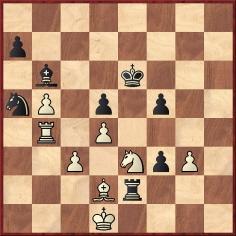
1...Nc4 2 Nxc4 dxc4 3 Rxc4 Kd5 4 Rc8 Ke4 5 Re8+ Kd3 6 Rxe2 fxe2+ 7 Ke1 Bc7 8 Bf4 Ba5 9 Bd2
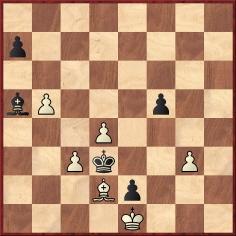
9...f4 10 gxf4 Bd8 11 White resigns.
The book quoted some remarks by Emanuel Lasker and specified, on page 200, that the source was the New York Evening Post, 17 April 1907.
Below (barely legible, alas) is that column of Lasker’s in the Evening Post (page 6), as well as the correction published on page 7 of the following day’s edition:

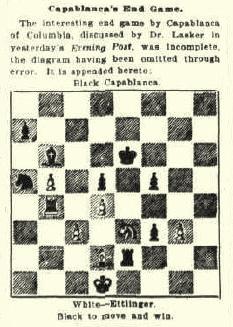
The full game-score has not been found. The finish is seldom seen in chess literature, although it was discussed on page 78 of Surprise in Chess by Amatzia Avni (London, 1998).
There are brief references to Alfred K. Ettlinger in our book on Capablanca. See too pages 170-171 of the April 1987 BCM and page 551 of the December 1987 issue.
(8825)
Robert John McCrary (Columbia, SC, USA) writes:
‘Lasker’s Chess Magazine published a series of copyrighted articles by Emanuel Lasker on basic chess instruction, and on pages 188-189 of the August 1905 issue he discussed the value of pieces. After describing the methods of Jaenisch and the mathematician Euler, he gave, on page 189, a peculiar scale:
“The values of the pieces calculated with sufficient accuracy for over the board play are as follows:
Pawn, 6; knight, 17; bishop, 17; rook, 24; queen, 47.
These values have not been found by executing the indicated calculation, but are those which come nearest to express my experience in hard fought games.”
Lasker then added some provisos and concluded by giving the king a value of 20.
I have yet to find any occurrence of these values elsewhere in Lasker’s writings.’

(8859)
An addition is provided by Peter Banks (Oldbury, England), from pages 106-107 of Lasker’s Manual of Chess (London, 1932):
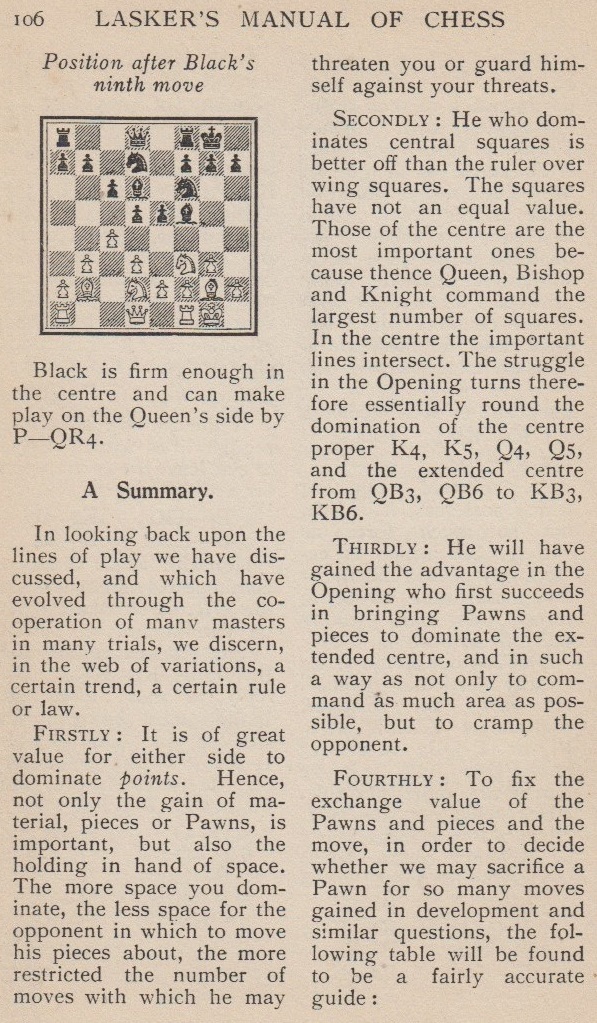
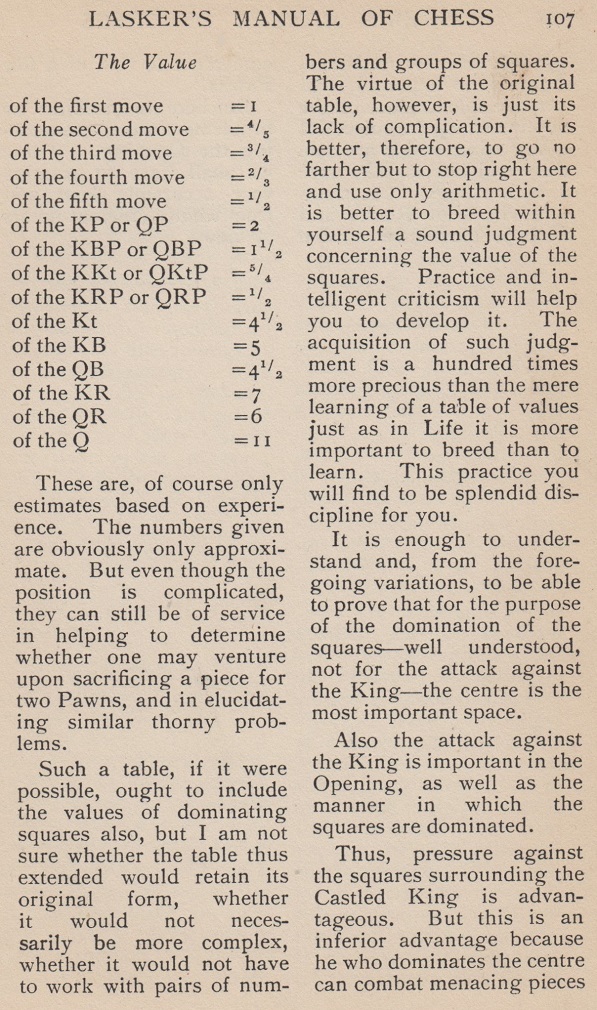
In the original English-language edition (New York, 1927), the text was on pages 119-120.
(10631)
See The Value of the Chess Pieces.
C.N. 3196 (see A Chess Database) mentioned the moves 1 e4 e5 2 Qh5 Nc6 3 Qxf7+, and there are many versions of the related story involving Emanuel Lasker. One ‘is-said-to’ example comes from page 90 of A History of Chess by Jerzy Giżycki (London, 1972):
‘Lasker is said to have won a game of “Alcoholic Chess” by sacrificing his queen in ridiculous fashion at the very outset of the game. The queen contained about a quarter litre of cognac; quaffing this seriously incapacitated his opponent in the ensuing complications – B.H. Wood.’
Page 283 of the August 1959 CHESS had an account reproduced from a chess programme on BBC radio:

How far back can the story be traced? We recall an editorial account of a lunch with G. Koltanowski, one of the least reliable of all chess chroniclers, on page 255 of the November 1938 Chess Review:
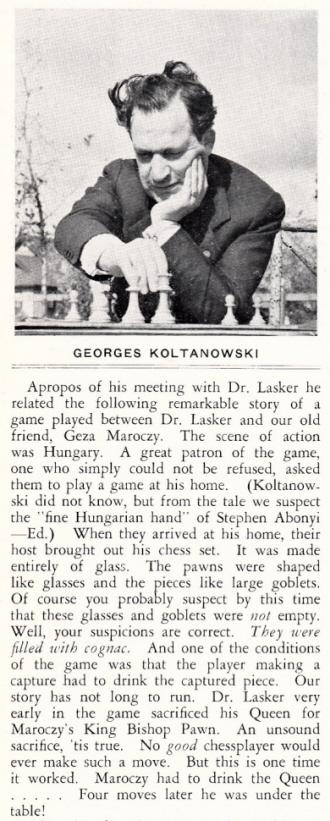
(8871)
‘X’ is an imaginary prolific chess author (‘book-doer’ may be a better term) who decides to bring out an anthology of miniature games won by the world chess champions. A day or two’s casual clicking in his database suffices for the requisite ‘research material’ to be assembled. The book is quickly completed and, no less quickly, warmly welcomed by the review-doers.
One of the games in the compendium is a 13-move victory by Emanuel Lasker against J.E. Randel, courtesy of (i.e. unquestioningly lifted from) Mega Database 2012:

At best, ‘X’ contributes to chess knowledge by mentioning that Black missed a mate in five at move 11.
A more conscientious writer might wonder whether nothing more precise than ‘USA tour sim 1907’ is available, and whether the unusual spelling ‘Randel’ is correct. If FatBase 2000 is consulted, an exact place, New York, will be found, as well as an unwelcome complication: the loser was identified there as ‘J. Randall’.
‘X’ has long since exhausted his interest in the matter, but others may contemplate the drastic step of ascertaining what has appeared in print, whether in primary or secondary sources.
Page 61 of Emanuel Lasker Volume 3 by K. Whyld (Nottingham, 1976) named White as ‘J.E. Randall’, and two sources for the game were mentioned, without dates: the Chicago Sunday Tribune and the Chess Amateur.
Below is what was published on page 4 III (Sporting section) of the Chicago Sunday Tribune, 15 December 1907:
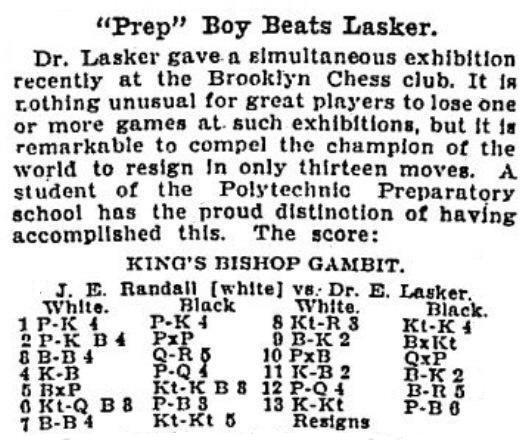
Something is clearly awry here, because the introductory text says that Lasker lost, whereas the game-score specifies that he won.
The Chess Amateur also has a surprise to offer. The Lasker game was one of eight bunched together, with scant information, in the ‘Brilliants and Miniatures’ column on page 271 of the June 1908 issue:

So now there is not only another name, ‘J.E. Randale’, but also the statement that he won the game.
The researcher hopeful of discovering the game-score in the American Chess Bulletin will be disappointed, although a vague passage by Thomas J. Johnston may be found hidden away on page 251 of the December 1908 issue:
‘When the world’s champion gave his simultaneous exhibition in Brooklyn, last year, in which the writer’s Caissic scalp hung at his belt with some 20 others, he offered a King’s Gambit to a young student, not a strong player, who defended conventionally with the counter-attack Q-R5ch. At the tenth move or thereabouts, Black advanced a pawn one square, whereupon the champion resigned.’
Next, it is necessary to consider page 127 of K. Whyld’s second anthology on the world champion, The Collected Games of Emanuel Lasker (Nottingham, 1998):

This time it is said that Lasker was White, and Black’s name has become yet another variant, ‘J.E. Randell’.
Fortunately, the whole affair is not as intractable as it may seem. The obvious source to consult for a game played in Brooklyn is the Brooklyn Daily Eagle. That newspaper’s chess coverage systematically used the spelling ‘J.E. Randall’, and not least when reporting his victory over Lasker the day after the simultaneous exhibition (on page 18 of the 21 November 1907 edition):

‘J.E. Randall’ was also the spelling when the game-score was published on 8 December 1907 (page 10):
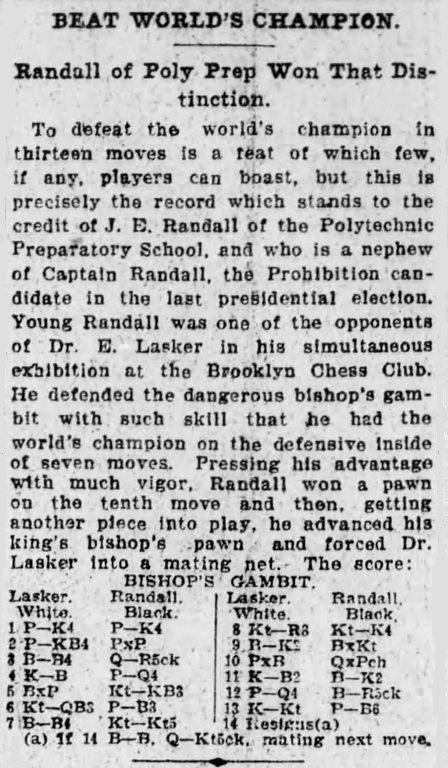
By now, the historian will hardly have grounds for doubting that in Brooklyn on 20 November 1907 Emanuel Lasker lost to J.E. Randall. Although remaining on the look-out for further information, he may find his attention switching to the references in the above Eagle cutting to J.E. Randall and his uncle, Captain Randall, in the hope that some biographical data can be traced.
(8873)
A remark by Emanuel Lasker:
‘Down with all nationalism in our old, noble, profound game.’
Source: Hermann Helms’ chess column on page A3 of the Brooklyn Daily Eagle, 12 June 1924:
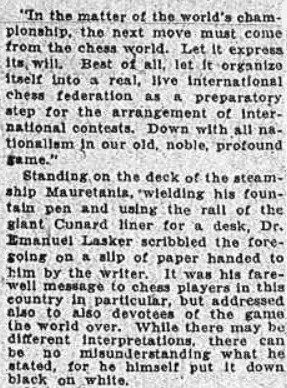
We first quoted the observation by Lasker in C.N. 1158 (see page 264 of Chess Explorations), from page 318 of the August 1924 BCM.
(8918)
Another player [apart from Teichmann] who had occasion to wear an eye patch was Emanuel Lasker, during his autumn 1909 contest against Dawid Janowsky; see the photograph in our article Lasker v Janowsky, Paris, 1909.
Lasker had undergone an operation on his right eyelid, as reported on page 407 of La Stratégie, November 1909:
‘Le Dr. E. Lasker, bien que handicapé par les suites d’une opération subie à la paupière de l’oeil droit, a brillamment maintenu sa renommée en gagnant sept parties contre une perdue et deux nulles.’
(8922)
A game from Ajedrez uruguayo (1880-1980) by Héctor Silva Nazzari (Montevideo, 2013), pages 46-47:
Emanuel Lasker – Alfredo Anaya
Simultaneous exhibition, Montevideo, 27 July 1910
Queen’s Gambit Declined
1 d4 d5 2 c4 e6 3 Nc3 Nf6 4 Bg5 Be7 5 e3 Nbd7 6 Qc2 O-O 7 Nf3 c6 8 Bd3 dxc4 9 Bxc4 Nd5 10 Bxe7 Qxe7 11 e4 N5b6 12 Bd3 e5 13 O-O exd4 14 Nxd4 Ne5 15 Rad1 Nxd3 16 Rxd3 c5 17 Nf3 Be6 18 Re1 Rfe8 19 h3 Rad8 20 Rde3 h6 21 a3 Nc4 22 R3e2 Qd7 23 Rd1 Qc6 24 Ne1 Rxd1 25 Qxd1 Qd7 26 Qxd7 Bxd7 27 f3 Bc6 28 Kf2 Rd8 29 Rc2 Rd2+ 30 Rxd2 Nxd2
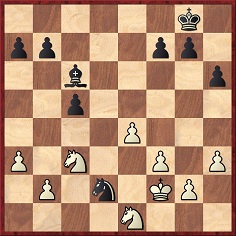
31 Nd3 Nc4 32 Nd1 b6 33 Ne3 Nxe3 34 Kxe3 f6 35 h4 g6 36 g4 Kf7 37 g5 hxg5 38 hxg5 Bb5 39 gxf6 Kxf6 40 Nf2 Bd7 41 f4 a6 42 Nd3 Be6 43 b4 cxb4 44 Nxb4 a5 45 Nd5+ Bxd5 46 exd5 Ke7 47 a4 Kd6 48 Kd4 b5 49 axb5 a4 50 b6 a3 51 Kc3 Kxd5 52 b7 Resigns.
(8973)
What is the basis for a statement about Emanuel Lasker on page 57 of Chess is Chess by Aleksandar Matanović (Belgrade, 1990)?
‘Poor Lasker prepared for his tournaments by studying the photographs of his future opponents. Having nothing else at hand, he scrutinized their facial features and tried to penetrate into their psyches.’
(8980)
In C.N. 6926 (see Fischer’s Fury) a correspondent pointed out a mistake about Pilnik in the introduction to game four in My 60 Memorable Games. Nobody involved in the book ever seemed concerned that the game introductions have many errors, as in game 56:
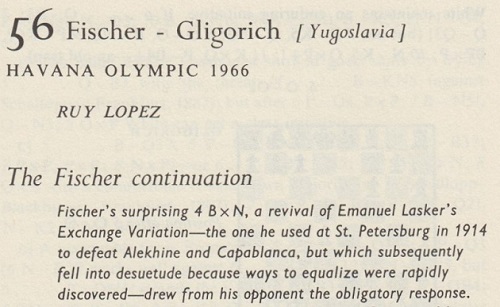
At St Petersburg, 1914 Lasker’s victory over Alekhine in the Exchange Variation of the Ruy López was with the black pieces.
(9059)
‘His demeanour at the board reminds one of the detached attitude of a judge, weighing up a case and dissecting its strengths and weaknesses. Absolutely unruffled he sits motionless at the board, hardly ever rising from his seat till the game is over, and never exhibiting in the slightest degree either elation in victory or despondency in defeat.’
Source: page 30 of Modern Master-Play by F.D. Yates and W. Winter (London, 1929).
(9065)
An article by Julio Kaplan (‘Games from Lone Pine’) on pages 364-366 of the July 1977 Chess Life & Review stated on the final page:
‘... as Lasker used to say: “Long analysis, wrong analysis”.’
Chess literature has references by the barrowful to what this or that master ‘used to say’, but responsible writers do not diffuse such material without secure sources. The ‘long/wrong’ saying is commonly attributed to Larsen, e.g. by A. Soltis on page 190 of The 100 Best Chess Games of the 20th Century, Ranked (Jefferson, 2000) and on page 27 of The Wisest Things Ever Said About Chess (London, 2008). In each case the wording offered was ‘long variation, wrong variation’, and the corroboration offered was zero.
Larsen’s own words are shown below from page 46 of How To Get Better At Chess by L. Evans, J. Silman and B. Roberts (Los Angeles, 1991), in the chapter ‘How Do Top Players See Things So Quickly?’:
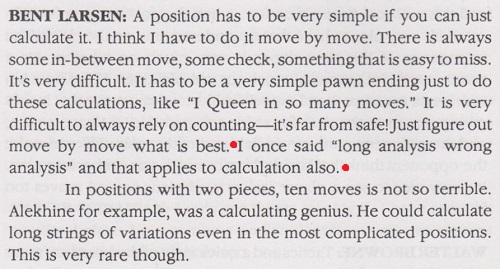
(9260)
From Olimpiu G. Urcan:
‘I have found photographs of Lasker and Blackburne in several large scrapbooks containing application forms for copyright registration filed with the Copyright Office of the Stationers’ Company (digitized via the Nineteenth Century Collections Online Database). The application forms reveal further information about the photographers, as well as the approximate date when each picture was taken.’
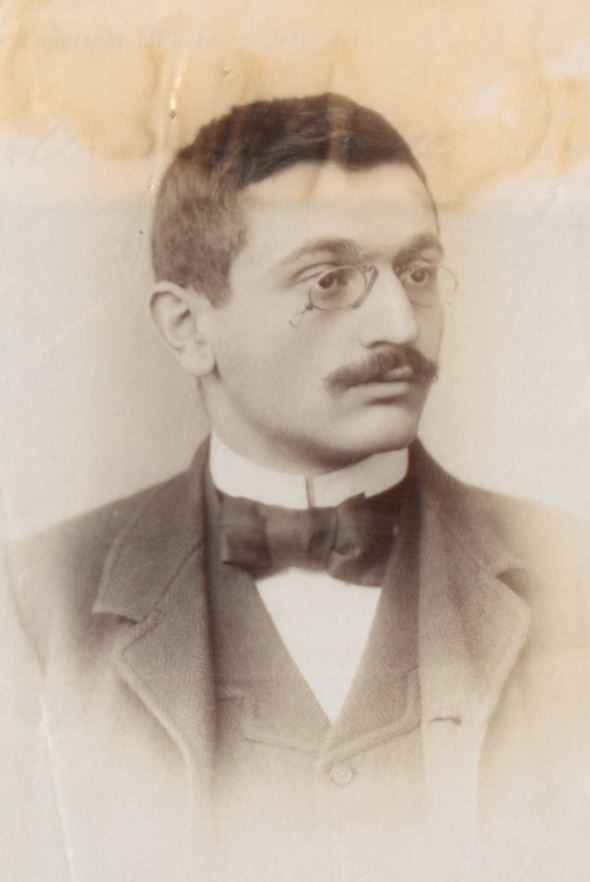
Emanuel Lasker. Photograph taken by Frederick Thomas Downey (July-September 1892)
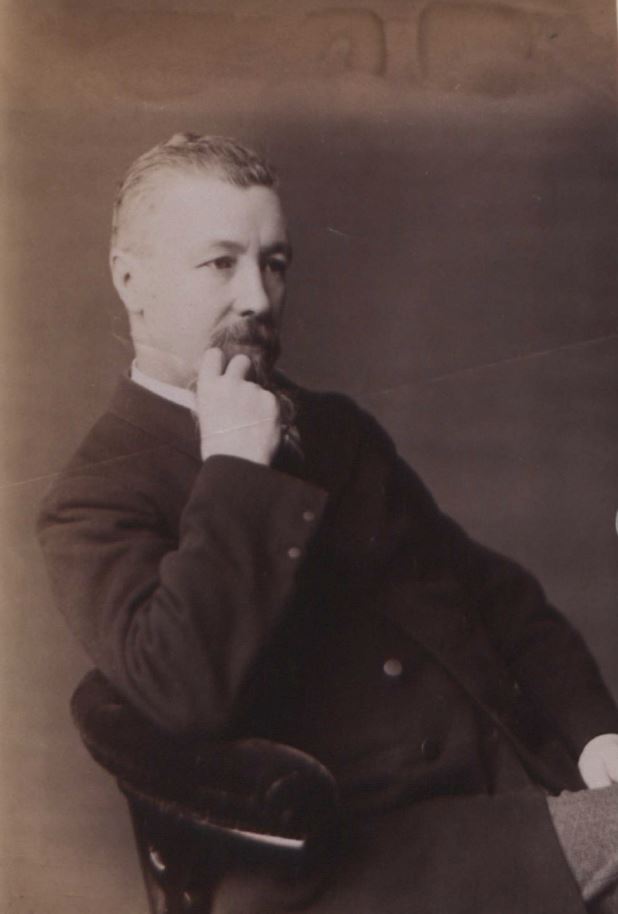
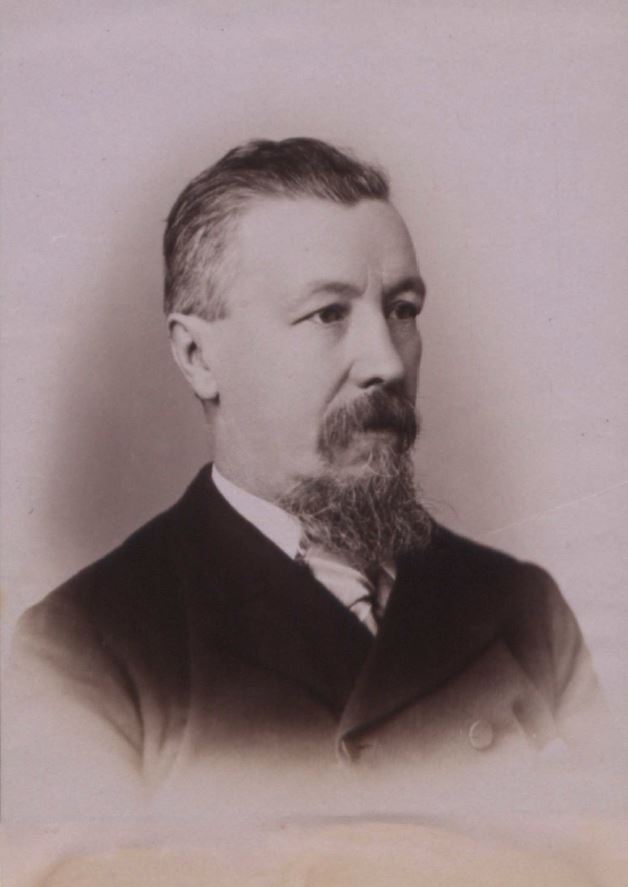
Joseph Henry Blackburne. Photographs taken by David James Scott (January 1892).
(9296)
From page 390 of Kings, Commoners and Knaves:
Blackburne offered his views in an interview with The Standard, from which the August 1910 BCM (page 338) printed an excerpt:
‘I think Zukertort was the best for a short time; but he fell off in a few years through ill-health. Steinitz was considered the strongest player, because he beat Zukertort in a match in the London Tournament of 1883. I played Zukertort in 1887, and beat him, but he was not himself at that time. The present champion, Dr Lasker, beat Steinitz ... in the last match Steinitz ever played. I think Dr Lasker is as good as Steinitz ever was in his best days. At the present time he is undoubtedly champion of the world. Morphy ..., in my opinion, would have been superior to Lasker or any champions of the modern school. He was my ideal of a chessplayer, and one of the greatest players, I think, who ever lived.’
The reference in C.N. 9348 to ‘Bilguer’, i.e. the Handbuch des Schachspiels, is a reminder of the start of a column by A. Soltis on pages 10-11 of the August 1988 Chess Life. The reader does not have to wait long for a ‘once’:
‘“Show me three variations in the German Handbuch”, Emanuel Lasker once said about the foremost opening authority of his day, “and I will show you two that are defective.”
That’s a famous putdown, and one often repeated.’
Soltis repeated it on page 176 of his anthology Karl Marx Plays Chess (New York, 1991), except that ‘the foremost opening authority’ was replaced by ‘the foremost opening publication’. As there was still no source or date, it was impossible to know who was being put down by Lasker. Was it, for instance, his world championship rival Carl Schlechter, who brought out a new edition (the eighth) of the Handbuch des Schachspiels in 1916?
On some low-grade Internet sites the Lasker quote appears, also sourcelessly, in a different wording:
‘Show me three variations in the leading handbook on the openings, and I will show you two of those three that are defective.’
That version is in an article by Eliot Hearst on pages 254-255 of the September 1961 Chess Life, in which some excerpts from 1904-06 issues of Lasker’s Chess Magazine were presented ‘in true Kaleidoscopic fashion’:
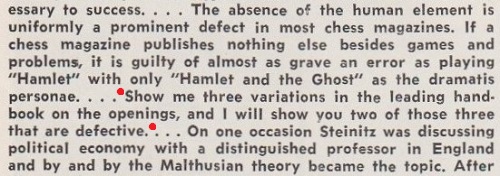
Such a remark, phrased differently, appeared on page 51 of the December 1904 issue of Lasker’s Chess Magazine:
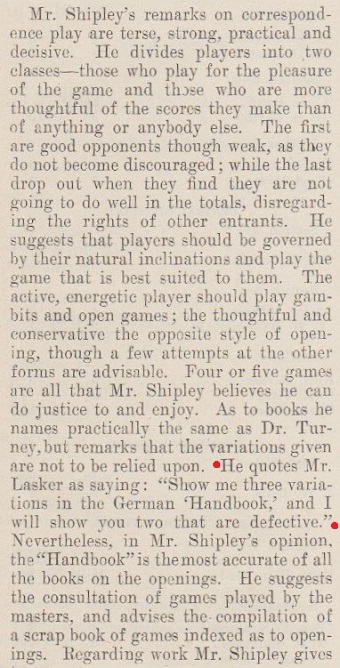
That passage comes from a review, on pages 49-51, headed ‘Pillsbury National Correspondence Chess Association’, which began:
‘A pamphlet has been issued by the Pillsbury Association which contains a history of the Association and articles on correspondence play by Rev. Leander Turney and Walter Penn Shipley. The pamphlet is a sort of yearbook, dated 1905, and evidently is intended as a guide for the members.’
Courtesy of the Cleveland Public Library, below is the relevant part of the pamphlet, an article by Shipley entitled ‘Tournament Correspondence Chess’ on pages 9-11:
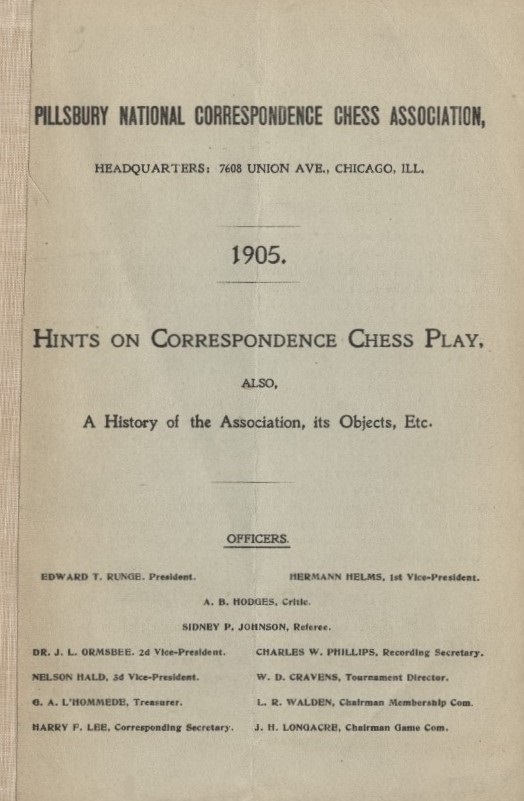
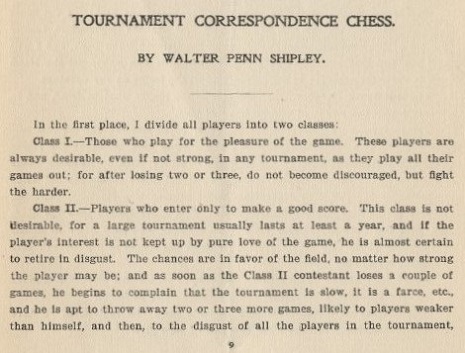


There is a minor difference (‘any three’, and not ‘three’ as quoted in Lasker’s Chess Magazine).
After all the foregoing we still have only a ‘once’ version for the Lasker remark, but it was written by an eminent figure, Walter Penn Shipley, who knew Lasker well, and it was repeated in Lasker’s Chess Magazine without contradiction.
(9360)
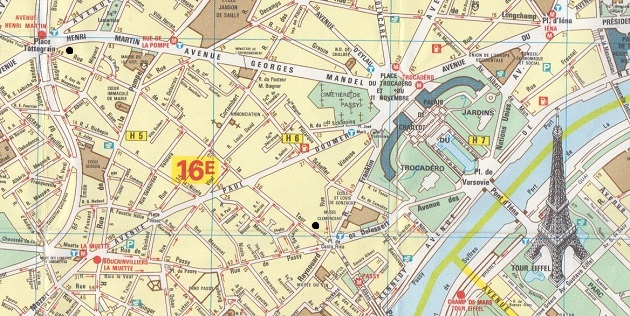
Paris (Michelin). Larger version
The two black dots mark the Rue de la Tour, which was mentioned in one version of an old story concerning Emanuel Lasker’s alleged absent-mindedness and impracticality, as evinced by an inability to find his accommodation. It is a tale related in Proustian detail (beginning airily with ‘einmal’) on page 72 of Emanuel Lasker Biographie eines Schachweltmeisters by J. Hannak (Berlin-Frohnau, 1952), as well as on pages 79-80 of the English-language version (London, 1959). Lamentably, it was even included on page 104 of the ‘New 21st Century Edition!’ of Lasker’s Manual of Chess (Milford, 2008); another example of disrespectful dumbing-down was on page 142, which gave the pigeon-breeding story (see C.N. 3662).
An unsigned item (beginning airily with ‘once’) on page 182 of the 15 April 1957 CHESS concluded with an exact address (12 Rue de la Tour, Paris):
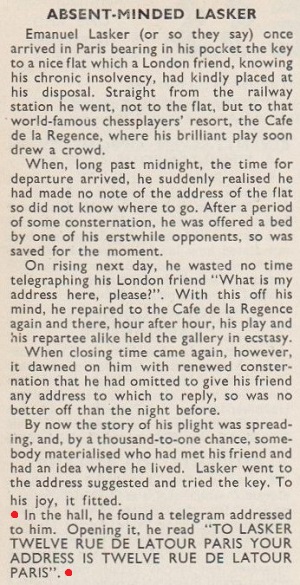
More space was filled on page 230 of CHESS, 20 June 1957 with a letter from Heinrich Fraenkel (the translator of Hannak’s book from German to English):
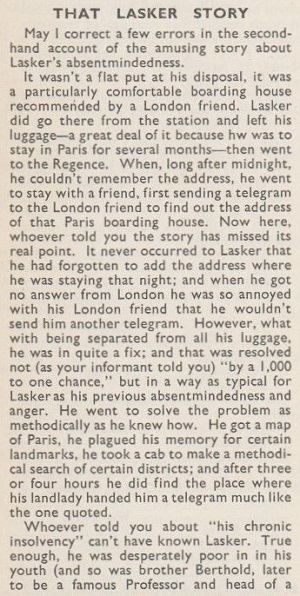

Such anecdotal rambles reveal little about Lasker, though much about the ramblers. Readers should trust nobody who unquestioningly relates ‘fun’ material about old chess masters’ déboires with hotels, restaurants and luggage, but it may sometimes be worth trying to trace who came up with what, and why. In this case, for instance, what is the explanation for ‘12 Rue de la Tour’?
(9364)
From Jan Kalendovský:
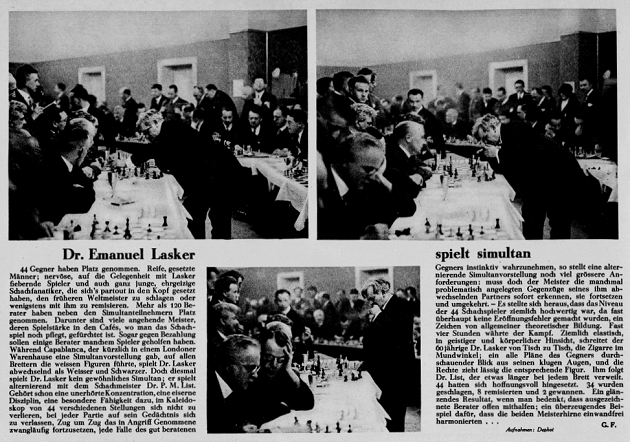
Berliner Tageblatt, 12 May 1929, page 2
(9442)
In a readily available exhibition game (Ruy López) between Walter Penn Shipley and Emanuel Lasker (Philadelphia, 10 November 1902) Shipley lost a lengthy ending. After giving the score on page 148 of her Womanhood column (C.N. 9458), Rhoda A. Bowles wrote:
‘At the conclusion of this game Mr Shipley said he felt proud to have held out so long against the finest endgame player in the world, a compliment the champion modestly disclaimed, stating that he thought Mr Pillsbury was the best endgame player. The latter, though gratified at the high appreciation bestowed by his friend and rival, will not claim the pre-eminence. This is pretty courtesy, and worthy of absolutely the two finest exponents of chess the world has ever known.’
Shipley’s annotations to his game against Lasker were published in the American Chess Weekly, 15 November 1902 and reproduced on pages 249-251 of Walter Penn Shipley. Philadelphia’s Friend of Chess by John S. Hilbert (Jefferson, 2003).
(9463)
From Jan Kalendovský comes the front page of the Dutch publication De Revue der Sporten, 7 January 1909:
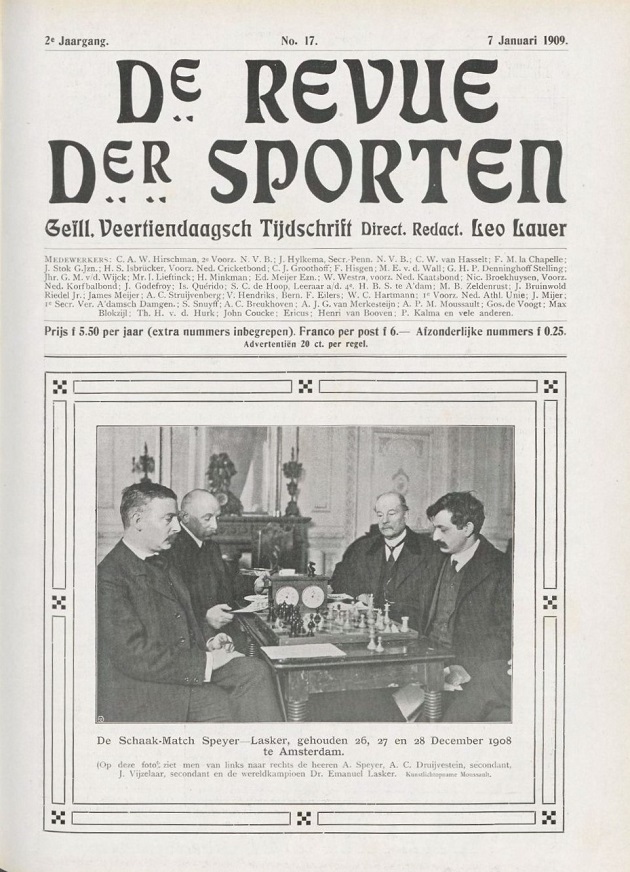
The position is recognizable as from the second match-game, a draw played on 27 December 1908.
(9513)
Thomas Niessen (Aachen, Germany) writes:
‘There are discrepancies in the score of the game between Frank Marshall and Emanuel Lasker in the Paris tournament, 28 May 1900, and particularly at moves 17 and 28.
Position after 16...Be4
When the game was published on page 9 of the Times, 6 June 1900, the continuation was 17 Bc3 f6 18 f3.
Those same moves were in the 10 June 1900 editions of the New York Times (page 10) and the Brooklyn Daily Eagle (page 9), as well as two Prague newspapers, Bohemia (page 17) and Národní listy (page 13). Other British and American newspaper followed suit.
However, when Leopold Hoffer published the game in the Field on 9 June 1900 White’s 17th and 18th moves were inverted, becoming 17 f3 f6 18 Bc3.
Position after 17 f3 f6
No note was added, but, when it gave that version of the score, page 8 the Pall Mall Gazette, 12 June 1900 stated, “The simplest is always the best” and mentioned that 18 fxe4 fxe5 19 Bc3 could be played.
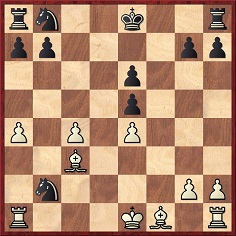
Position after 19 Bc3
The question, therefore, is whether White played 17 Bc3 (17...f6 18 f3) or 17 f3 (17...f6 18 Bc3). In the descriptive notation the difference is slight (B-B3 and P-B3), but the move-order 17 f3 f6 18 Bc3 would mean that a major oversight was committed by both Lasker (when he played 17...f6) and Marshall.
The 17 Bc3 f6 18 f3 version appeared in the Tijdschrift van den Nederlandschen Schaakbond, June 1900, pages 134-135, and the Deutsche Schachzeitung, July 1900, pages 208-209, as well as in Samuel Rosenthal’s Traité des échecs et Recueil des Parties jouées au Tournoi International de 1900 (Paris, 1901), pages 297-298.
On the other hand, the July 1900 issues of the BCM, pages 272-273, and the Wiener Schachzeitung, pages 145-146, had 17 f3 f6 18 Bc3. In the BCM the game was annotated by Richard Teichmann; he had no comments after Black’s 16th move, and the possible win (18 fxe4) went unremarked. However, the annotator in the Wiener Schachzeitung mentioned that stronger continuation.
The game was also published on pages 270-272 of La Stratégie, 15 September 1900, with a compilation of comments by Hoffer, Teichmann, the Deutsche Schachzeitung and the Wiener Schachzeitung. The move-order (17 f3 f6 18 Bc3) from three of those four sources was followed, and the observation in the Wiener Schachzeitung about the missed opportunity (18 fxe4) was quoted.
Page 169 of the August-September 1900 issue of the Wiener Schachzeitung reverted to the game with more analysis, and a correction from Lasker was added:
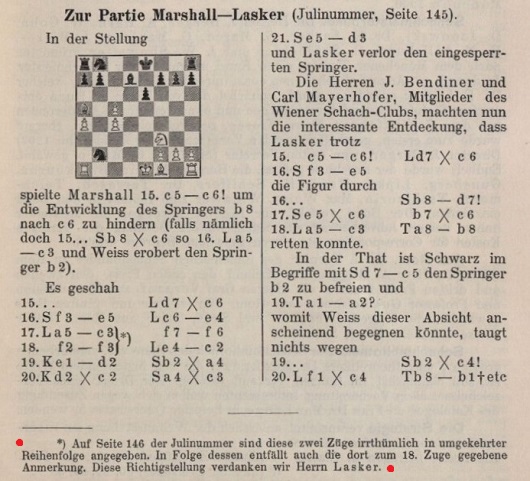
From the foregoing it can be concluded that the correct move-order is 17 Bc3 f6 18 f3.
Nevertheless, the would-be sequence 17 f3 f6 18 Bc3 has been seen in print for an astonishingly long time. Marshall included the game on pages 63-64 of Marshall’s Chess “Swindles” (New York, 1914). He gave Teichmann’s annotations, which meant that the wrong move-order from the BCM was published again. The missed opportunity was passed over in silence, although it was mentioned on pages 39-40 of Marshall’s My Fifty Years of Chess (New York, 1942):
“18 B-B3? Not the best. More exact was PxB PxKt 19 B-B3 KtxRP 20 RxKt with an easy win.”
In recent decades, the game has frequently been republished. K. Whyld gave the wrong move-order on page 93 of The Collected Games of Emanuel Lasker (Nottingham, 1998), even though Rosenthal’s tournament book was specified as the source. The right move-order was published by Egon Varnusz on page 206 of Emanuel Lasker, Volume 1, Games 1889-1907 (Budapest, 1998), but that prompted the comment “the Varnusz book doesn’t even get the move-order right” from Tim Harding in his Kibitzer column at the Chess Café, January 2000.
On pages 61-65 of Paris 1900 (Nottingham, 1986) Jimmy Adams included the correct move-order 17 Bc3 f6 18 f3 from the tournament book by Rosenthal but added notes from My Fifty Years of Chess, Teichmann in the BCM and the Deutsche Schachzeitung. John Hilbert put the wrong move-order when giving the game on pages 230-233 of Young Marshall (Olomouc, 2002), although at least two of his five sources had the correct one.’
(9528)
See also Chess Notation.
From the Preface to The Golden Dozen by Irving Chernev (Oxford, 1976):
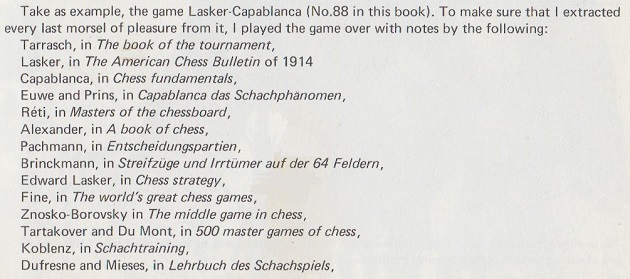

Below is the Lasker v Capablanca game with annotations by another master, Nimzowitsch, on pages 36-39 of volume one of Schachmeisterpartieen des Jahres 1914 by Bernhard Kagan (Berlin, 1914):
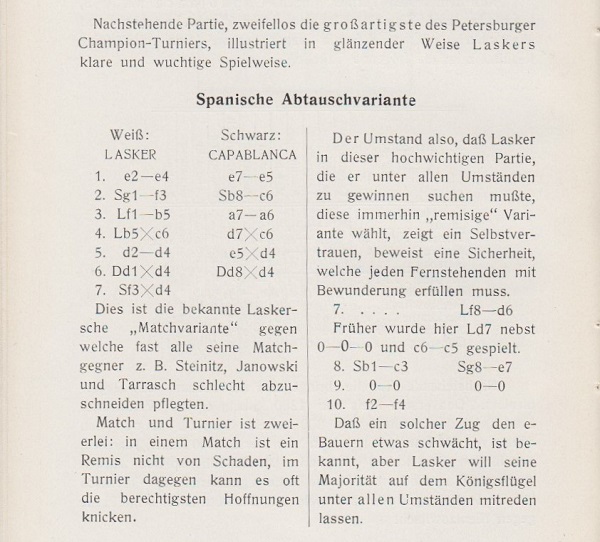
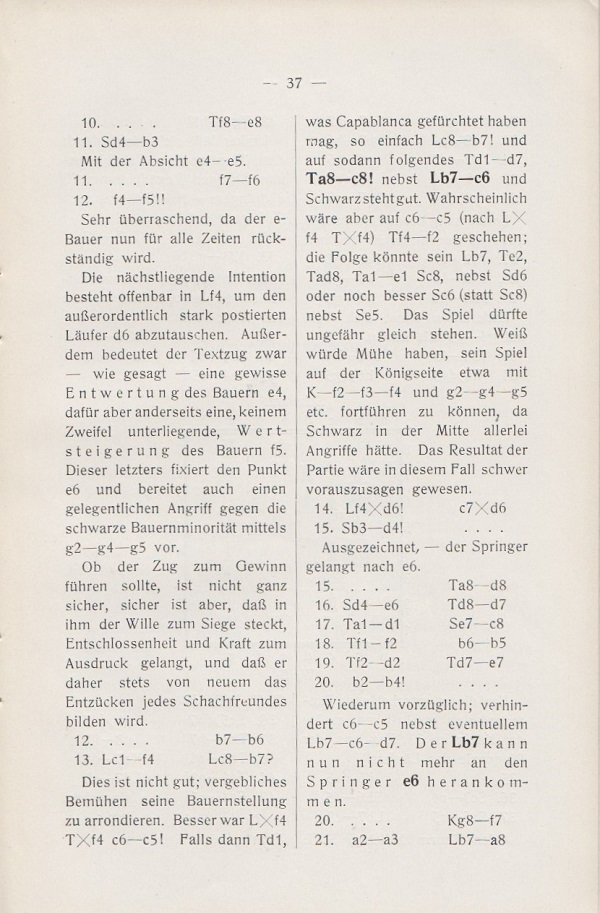
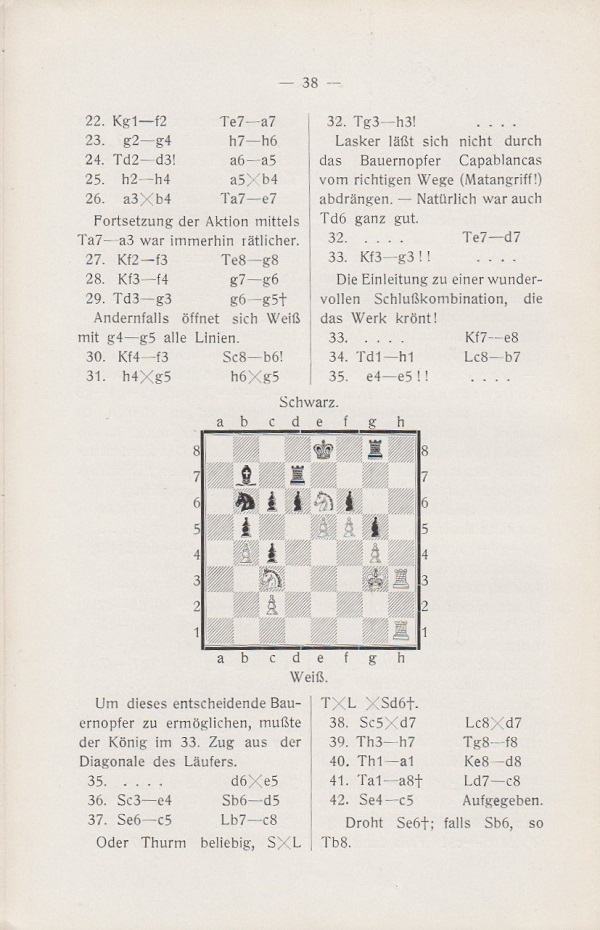
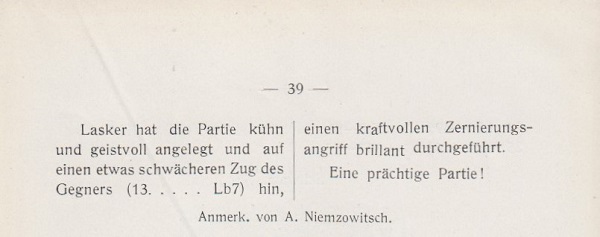
1 e4 e5 2 Nf3 Nc6 3 Bb5 a6 4 Bxc6 dxc6 5 d4 exd4 6 Qxd4 Qxd4 7 Nxd4 Bd6 8 Nc3 Ne7 9 O-O O-O 10 f4 Re8 11 Nb3 f6 12 f5 b6 13 Bf4 Bb7 14 Bxd6 cxd6 15 Nd4 Rad8 16 Ne6 Rd7 17 Rad1 Nc8 18 Rf2 b5 19 Rfd2 Rde7 20 b4 Kf7 21 a3 Ba8 22 Kf2 Ra7 23 g4 h6 24 Rd3 a5 25 h4 axb4 26 axb4 Rae7 27 Kf3 Rg8 28 Kf4 g6 29 Rg3 g5+ 30 Kf3 Nb6 31 hxg5 hxg5 32 Rh3 Rd7 33 Kg3 Ke8 34 Rdh1 Bb7 35 e5 dxe5 36 Ne4 Nd5 37 N6c5 Bc8 38 Nxd7 Bxd7 39 Rh7 Rf8 40 Ra1 Kd8 41 Ra8+ Bc8 42 Nc5 Resigns.
As listed on page 226 of Aron Nimzowitsch On the Road to Chess Mastery, 1886-1924 by Per Skjoldager and Jørn Erik Nielsen (Jefferson, 2012), Nimzowitsch’s notes were published in Johannes Behting’s column in Rigasche Rundschau, 6 June 1914 (new style). Mr Skjoldager has forwarded us the full page:
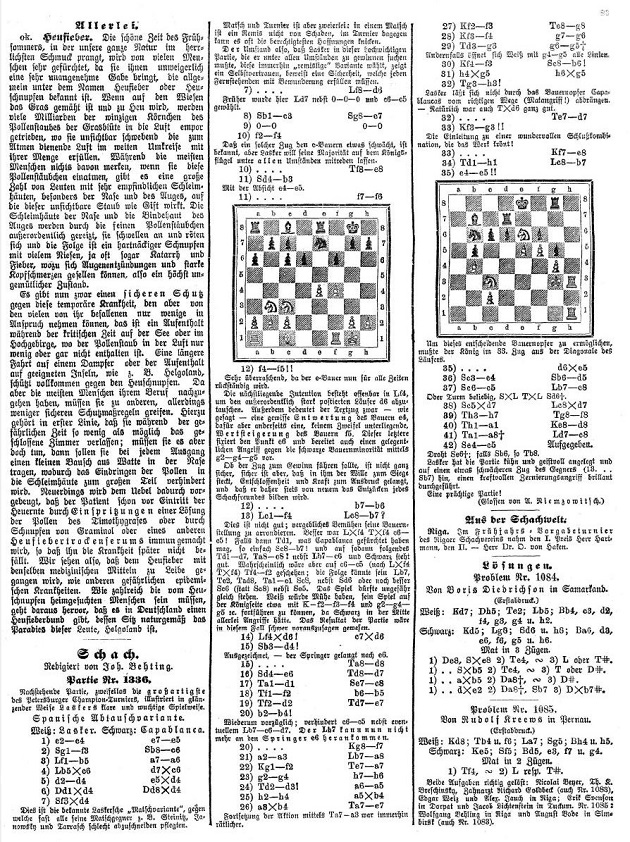
The most extensive set of notes to the Lasker v Capablanca game that we have seen in recent years is on pages 177-181 of John Nunn’s Chess Course (London, 2014).
(9534)
The photograph below, from page 1029 of Emanuel Lasker Denker Weltenbürger Schachweltmeister edited by Richard Forster, Stefan Hansen and Michael Negele (Berlin, 2009), shows Lasker with Nimzowitsch during a tournament in Berlin in spring, 1928:
See A Series of Books on Lasker.
Several on-line databases indicate that Emanuel Lasker won a 21-move brilliancy (1 e4 e5 2 Nf3 Nc6 3 Bb5 Nf6 4 O-O Bc5 5 Nc3 d6 6 d4 exd4 7 Nxd4 Bd7 8 Nb3 Bb6 9 Bg5 Ne5 10 a4 Bxb5 11 axb5 h6 12 Bxf6 Qxf6 13 Nd5 Qd8 14 Nd4 O-O 15 Nf5 Kh7 16 Ra3 f6 17 Rg3 Rf7 18 Nf4 Qd7 19 Qh5 Rh8 20 Ne6 Rg8 21 Nfxg7 Resigns) against Henneberger and Rivier in a simultaneous exhibition in Zurich in 1919. In reality, the venue was Berne, and only one other game was played concurrently.
Lasker’s annotations in Vossische Zeitung were reproduced on page 211 of the October 1919 Deutsche Schachzeitung:
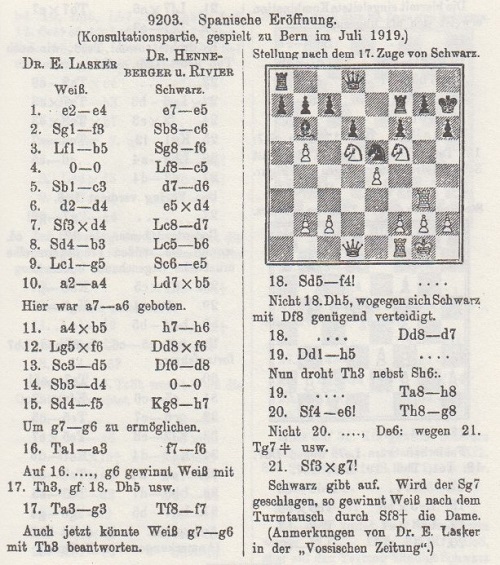
The heading stated that the game (against Walter Henneberger and William Rivier) was played in July. The correct date, 7 June 1919, was given when extensive annotations from the Basler Nachrichten appeared on pages 6-8 of the January 1920 Schweizerische Schachzeitung. The heading specified that Lasker played one other game at the same time, also against two opponents.
Fred Reinfeld discussed the Lasker v Henneberger and Rivier game (accurately putting ‘Berne, 1919’) on pages 25-29 and 106-112 of Chess Mastery by Question and Answer (London, 1940). In his Evening Standard column of 30 December 2015 Leonard Barden reported that it was ‘the first book which really improved my own chess’ and that it ‘is still a worthwhile read’.
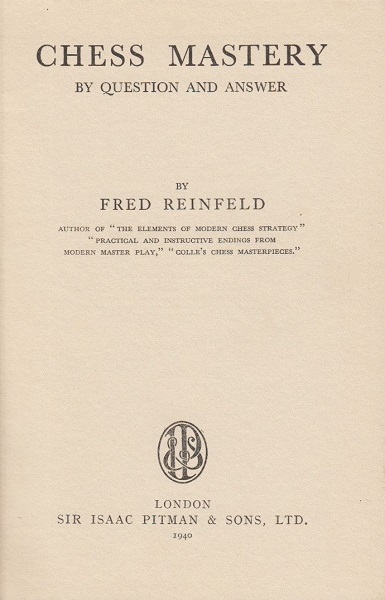
(9746)
From page 288 of the Australasian Chess Review, 8 October 1936:
‘Among the masters, it seems that clock management is the hardest part of the game. Only Lasker and Capablanca have mastered it, the former by his super-normal endowment of common sense, the latter by heaven-born genius.’
(9803)
From page 135 of Bobby Fischer and his Predecessors in the World Chess Championship by Max Euwe (London, 1976), in a section about Emanuel Lasker:
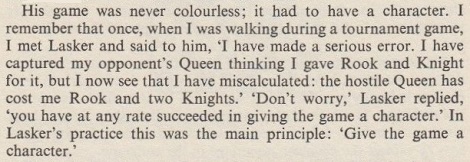
Page 208 of the Dutch version of Euwe’s book, Fischer en zijn voorgangers (Baarn, 1975), specified that the tournament was Zurich, 1934:
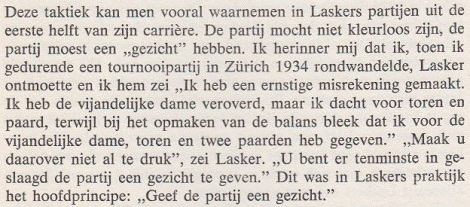
The game appears to be Rosselli del Turco v Euwe in round 13 (26 July 1934), even though the details do not fully match Euwe’s description 40 years later.
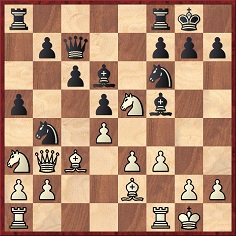
Position after 13 Bd2-c3
An extract from page 226 of the tournament book by Alekhine:
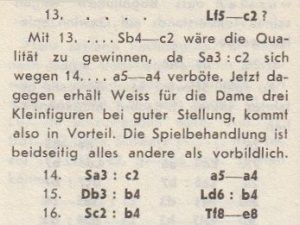
Euwe eventually won (at move 49).
(9816)
The conclusion of an article by Emanuel Lasker on pages 84-86 of Lasker’s Chess Magazine, December 1905:
‘The law of economy is charged with important meanings in respect to chess. The royal game can claim the greatest distinction of being an excellent instrument for the demonstration of the great detriment of waste in any form. Waste of a move, or of an opportunity, or of activity, may be shown to be at the root of every unsound manoeuvre in chess. The capacity for economizing brain power is acquired in chess. Its possession by the chessplayer is a sure mark of superiority and of maturity. The genius, with all the great pains that he takes to solve great problems, must be economical with his energy to achieve the greatest and most lasting results. Hence we may amend the famous definition of genius to a slight extent. Genius is an infinite capacity for taking pains where and when they are needed. But a man who does not abhor unnecessary work does not possess genius. A genius will labor hard to arrive at the simplest, shortest, most precise and most intelligible expression of his thought or work, so that he may save unnecessary labor to others. This indeed is the mission, if not the definition, of genius, and marks the goal towards which the cultured man may strive with advantage and pleasure.’
(9821)
From page 212 of the first volume of Kasparov’s Predecessors series, before 16 Ne6 in Lasker v Capablanca, St Petersburg, 1914:
‘... the knight at e6 will be like a bone in his throat!’
Exclamation marks do not enliven clichés.
(9865)
On-line collections of images permit unexpected discoveries, such as an 1895 ‘Chess Masters at Hastings’ illustration (‘Ernest Prater’) in the LIFE photo collection. The players at the board appear to be Lasker and Pillsbury, but where has the picture been published?
(9957)
Nick Pope (Ann Arbor, MI, USA) notes that a version of the picture referred to in C.N. 9957 is on page 21 of the Brooklyn Daily Eagle, 22 September 1895, with the players identified as Lasker and Pillsbury.
(10955)
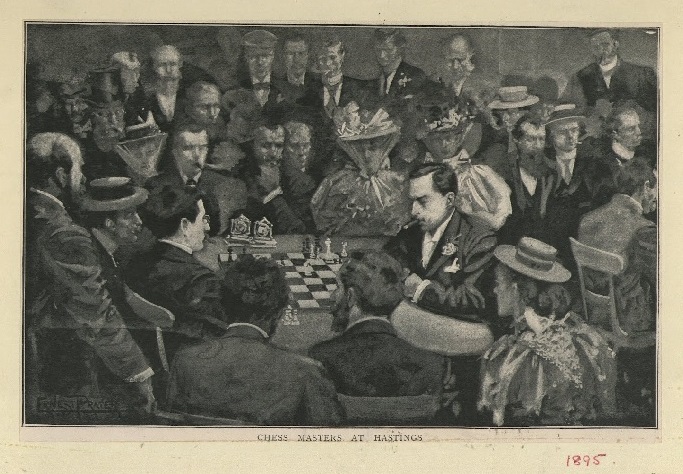
‘Lasker’s Manual has claims to be the most important chess book ever written.’
Source: C.J.S. Purdy on page 240 of the November 1960 Chess World.
(10043)
From Lasker’s Manual of Chess (Philadelphia, 1947):
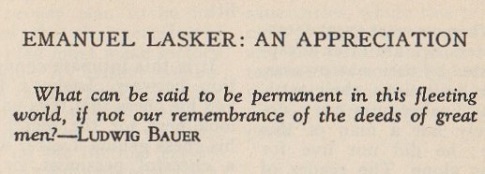
That is the heading of the introduction by Fred Reinfeld to his edition of Lasker’s book. The page was numberless, but in the 1960 Dover reprint it was page vii.
Jean-Pierre Rhéaume asks for information about Ludwig Bauer and the source of his observation. At present, we can say only that pages 308-310 of the September-October 1908 Wiener Schachzeitung reprinted an article by Bauer which covered similar general ground, though without the remark quoted by Reinfeld.
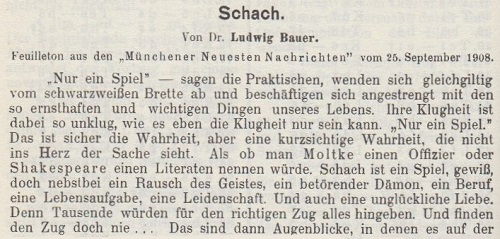
(10094)
The Center for Jewish History also has a fine photograph of Emanuel Lasker (Los Angeles Athletic Club, 31 March 1926).
Christian Sánchez notes a decision by FIDE at its General Assembly in Baku on 13-16 September 2016:
‘GA-2016/50. To announce the year of 2018 as the year of E. Lasker.’
Pro memoria, 2018 will be the 150th anniversary of Emanuel Lasker’s birth.
(10141)
In C.N. 145 Michael McDowell noted the photograph’s appearance, in reverse form, in the Dover re-issue of Alekhine’s book on New York, 1924. In C.N. 187 another correspondent, Michael Squires, mentioned that the reversed version was also on the cover of the Dover edition of Lasker’s Manual of Chess. (See page 178 of Chess Explorations.) Subsequently, Dover corrected the picture:
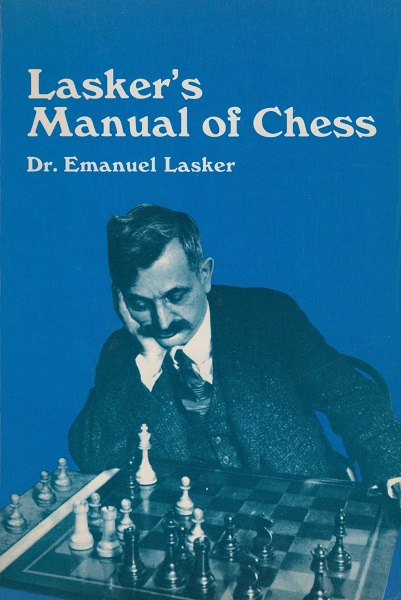

The solution given in C.N. 145 was 1 Rg8 Rxg8 2 Rh8 Rxh8 3 g7 Rg8 (or 3...Rf8) 4 h7 and wins, but C.N. 2705 (see page 365 of A Chess Omnibus) reported that our computer check with the Fritz program had yielded a humdrum mate in five (i.e. one move faster): 1 Rf7 Rg8 2 Rhg7 (Or 2 g7.) 2...Rh8 3 h7 any 4 Rg8+ Rxg8 5 hxg8(Q) mate.
Nothing has yet been ascertained about the identity of the composer or the source of the problem.
(10146)
The two Dover editions (respective prices: $2.75 and $5.50) referred to in C.N. 10146:
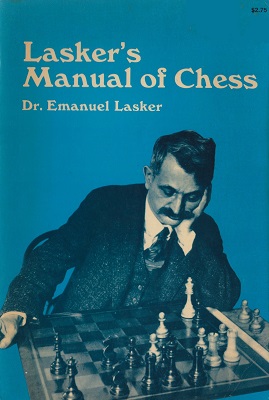

(10161)
Luc Winants (Boirs, Belgium) has another edition issued by Dover Publications, Inc. (priced at $2.50):
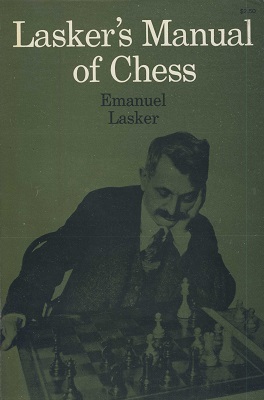
(10166)
Olimpiu G. Urcan draws attention to a number of items in the Los Angeles Times Photographic Archive (Department of Special Collections, Charles E. Young Research Library, UCLA) and other material available via the UCLA Library Digital Archives, including a 1926 picture of Lasker in Los Angeles.
(10812)
Steve Wrinn adds that in one of the photographs in the Los Angeles Times Photographic Archive mentioned in C.N. 10892 the board position being examined by Lasker was similar (a mate in five), both pictures having been taken during the former world champion’s visit to the Los Angeles Athletic Club in March 1926.
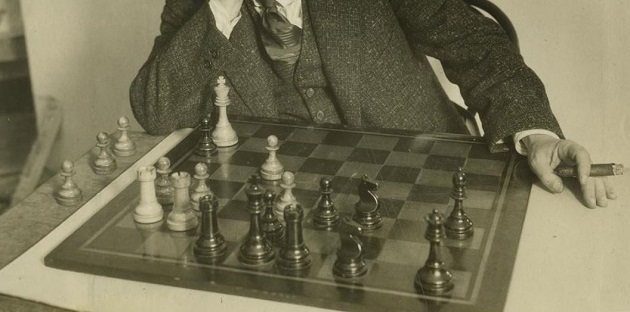
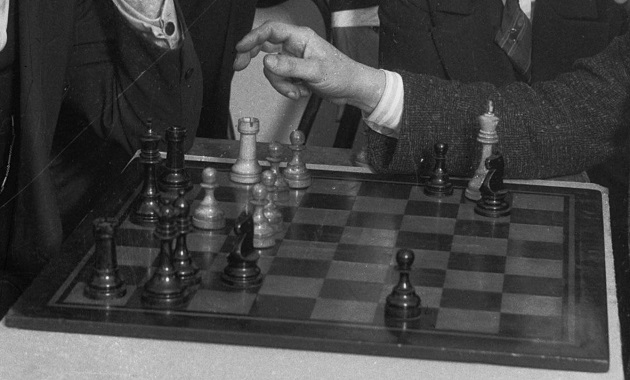

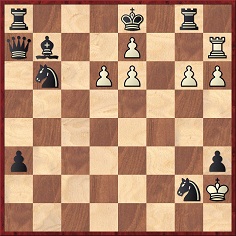
(10912)
From Olimpiu G. Urcan:
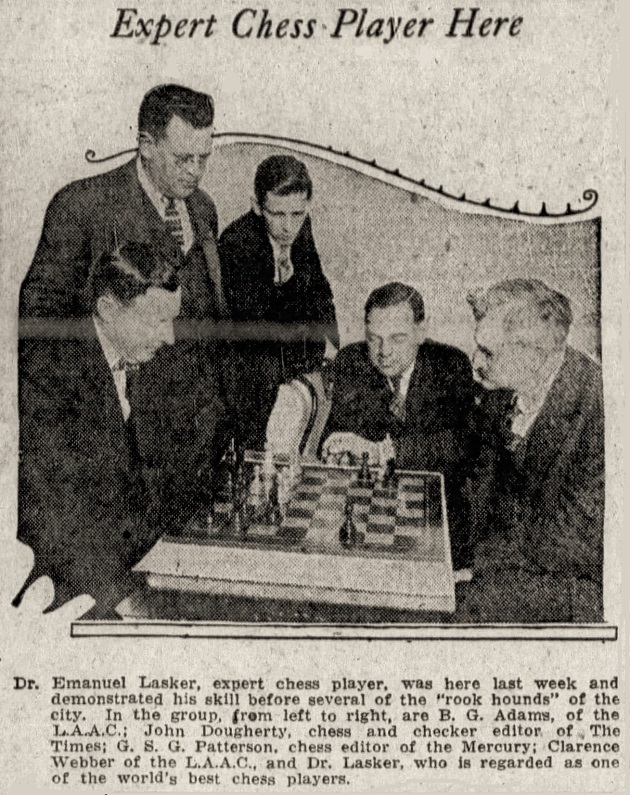
Los Angeles Times, 4 April 1926, page 13 (part VI)
The caption to this slightly different group photograph adds some information to that given in C.N.s 10892 and 10912.
(10926)
From the Detroit Free Press (Rotogravure Supplement), 23 March 1924:
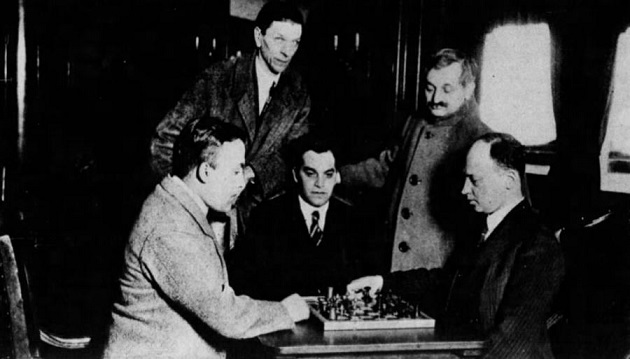
From left to right: Efim Bogoljubow, Géza Maróczy, Richard Réti, Emanuel Lasker, Savielly Tartakower
(10189)
An example of Eldorous Dayton’s chess writing is taken from page 193 of CHESS, 14 February 1938:
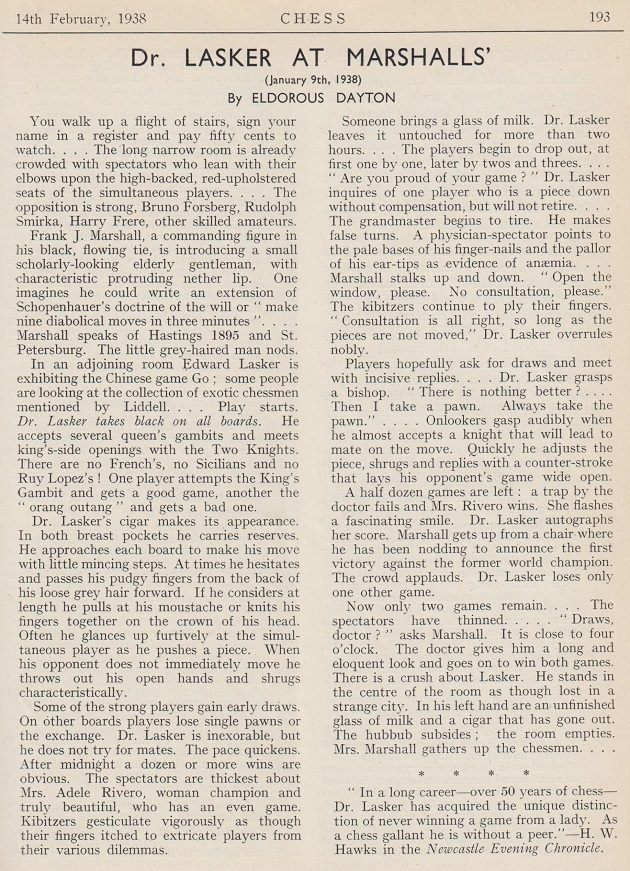
Facts about the exhibition by Lasker (Marshall Chess Club, New York, 9 January 1938) were reported on page 16 of the January-February 1938 American Chess Bulletin:

(10268)
Chernev was certainly a leading popularizer of endgame compositions, and particularly with his 1943 book Chessboard Magic!
In the Preface (pages ix-x) Chernev related Emanuel Lasker’s enthusiasm for studies:

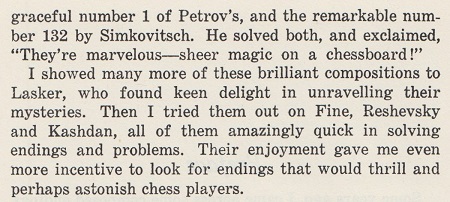
(10275)
Page 51 of Great Moments in Chess by Fred Reinfeld (New York, 1963) stated that Capablanca ‘went on to defeat Frank Marshall in a match by 9-1, a score not too far from Lasker’s world championship match victory over Marshall two years earlier by 7-0’.
Both scores are wrong.
(10281)
From page 8 of issue one of Albrecht Buschke’s publication Chess News from Russia, 10 November 1945:
‘Shortly before Dr Lasker’s death, i.e. almost three years after the return match between Alekhine and Euwe, the first few copies of a booklet about this match had arrived from Russia. The writer happened to have a copy of this booklet in his hands when he paid Dr Lasker one of his periodical visits. Dr Lasker had hardly looked at the book when he asked the writer emphatically to leave the book with him. At the astonished question whether he, of all chessplayers, had not seen these games yet, after almost three years, the Grand Old Man of Chess had a good and valid explanation: “Oh, I know the games, of course ... they don’t interest me any longer ... what I want to study are Botvinnik’s notes to these games – they are of real importance ...”’ (Ellipses in the original.)
Botvinnik’s volume on the 1937 Euwe-Alekhine match was reprinted by Издательство “Галерия”, Moscow in 2002:
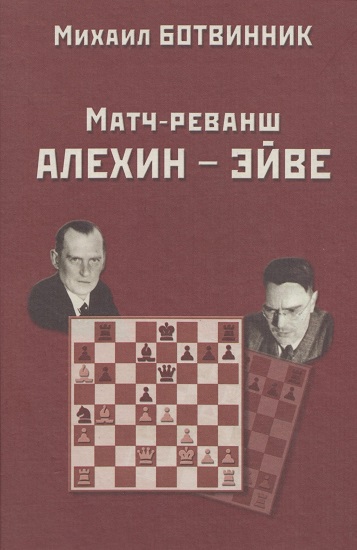
(10305)
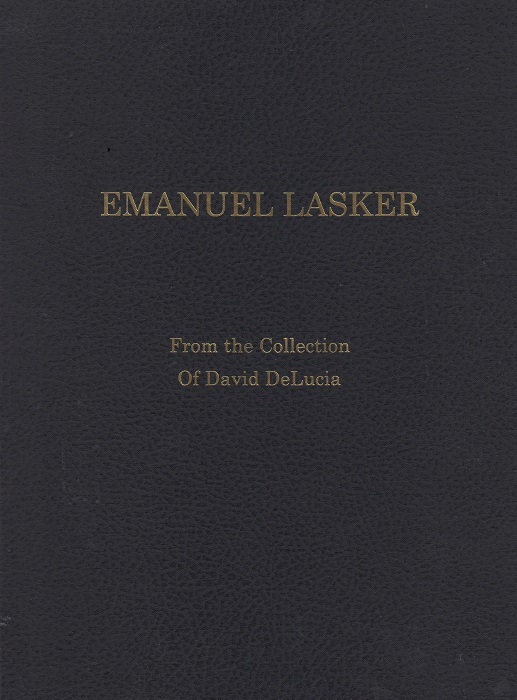
The Factfinder contains many references to the books based on the chess collection of David DeLucia, and the latest, compiled by his son John, is a 711-page hardback on Emanuel Lasker. It includes an absorbing range of letters, articles, photographs and ephemera, most previously unseen, and the production standards are unsurpassable.
(10335)
From page 226 of The Tao of Chess by Peter Kurzdorfer (Avon, 2004):
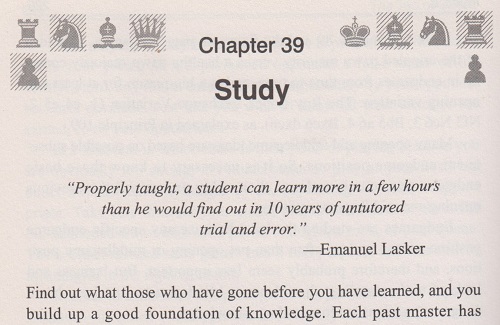
If Mr Kurzdorfer had found out what those who had gone before him had learned, he would have ascribed the quotation to Edward, not Emanuel, Lasker.
Firstly, a snippet from page 280 of Irving Chernev’s The Chess Companion:

However, on the inside front cover of Chess Review, January 1953, Chernev had correctly attributed the observation to ‘Ed. Lasker’.
The relevant passage was on page 232 of The Adventure of Chess by Edward Lasker (New York, 1950):
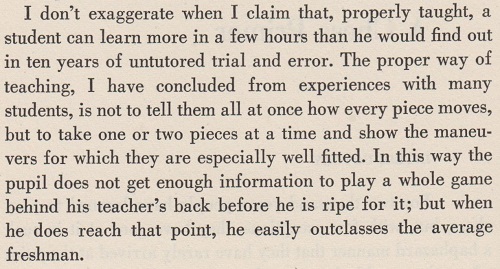
(10356)
Four games played by Lasker in simultaneous displays have been provided by Thomas Niessen (Aachen, Germany):
Fles – Emanuel Lasker
Hamburg, 4 September 1896
Queen’s Gambit Declined
1 d4 d5 2 c4 e6 3 Nc3 Nf6 4 Nf3 c5 5 Bg5 cxd4 6 Bxf6 gxf6 7 Nxd4 dxc4 8 e3 Rg8 9 Qc2 e5 10 Ndb5 Be6 11 Qa4 Nc6 12 Rd1 Qb6 13 Bxc4
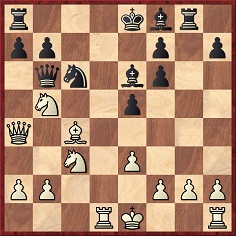
13...Rxg2 14 Bxe6 fxe6 15 Qc4 Rd8 16 Qxe6+ Be7 17 Nd6+ Rxd6 18 Rxd6 Qxb2 19 Nd1 Qb4+ 20 Rd2 Rg6 21 Nb2 Qe4 22 Rf1 f5 23 Qd7+ Kf8 24 Kd1 f4 25 Qd3 Qb4 26 Qf5+ Kg7 27 Nd3 Qa4+ 28 Rc2 Rd6 29 Rg1+ Kh8 30 Kc1 Qa3+ 31 Kd2
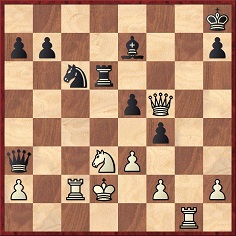
31...Rxd3+ 32 Qxd3 Bb4+ 33 Rc3 Qb2+ 34 Qc2 Bxc3+ and Black won.
Source: Neue Hamburger Zeitung, 20 September 1896, page 10.
Oeltjen – Emanuel Lasker
Hamburg, 4 September 1896
Four Knights’ Game
1 e4 e5 2 Nf3 Nc6 3 Nc3 Nf6 4 Bb5 d6 5 d4 Bd7 6 Bxc6 Bxc6 7 O-O Nxe4 8 Re1 Nxc3 9 bxc3 f6 10 Nh4 g6 11 d5 Bd7 12 f4 Bg7 13 f5 g5 14 Qh5+ Kf8 15 Nf3 Qe8 16 Qh3 h5 17 Nd4
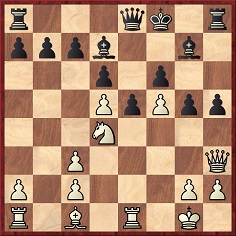
17...exd4 18 Rxe8+ Rxe8 19 cxd4 Re1+ 20 Kf2 Re4 21 Qb3 Bxf5 22 Qxb7 Re7 23 Be3 Kf7 24 Qb3 Rhe8 25 Re1 Be4 26 c4 Kg6 27 Qd1 f5 28 Kf1 h4 29 h3 Bf6 30 Bf2 Rb8 31 Qd2 Ree8 32 Kg1 Rb7 33 Qa5 Reb8 34 a4 Bd8 35 c5 c6 36 Qa6 Bxd5 37 Re8 Rb1+ 38 Be1 R8b2 39 Re2 Bf6 40 cxd6
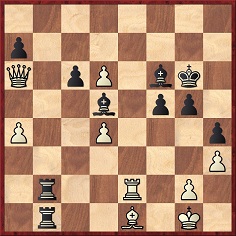
40...Rxe1+ 41 Rxe1 Bxd4+ 42 White resigns.
Source: Neue Hamburger Zeitung, 13 September 1896, page 10.
A report on the above 25-board exhibition from the Hamburger Nachrichten, 6 September 1896 page 4:

The two games below are from a 31-board display by the world champion:
Emanuel Lasker – Hans Fahrni
Hamburg, 30 January 1904
Caro-Kann Defence
1 e4 c6 2 d4 d5 3 Nc3 Nf6 4 e5 Ng8 5 f4 e6 6 Nf3 Nh6 7 Bd3 c5 8 Be3 Ng4 9 Bg1 c4 10 Bf1 Bb4 11 Nd2 Nh6 12 Ne2 Nc6 13 c3 Ba5 14 b3 b5 15 b4 Bb6 16 a4 bxa4 17 Qxa4 Bd7 18 Qa6 O-O 19 Nf3 Qc7 20 h3 Rfb8 21 g4
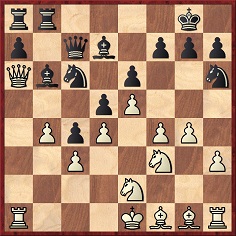
21...Ba5 22 b5 Rb6 23 Rxa5 Rxa6 24 Rxa6 Nd8 25 b6 Qb7 26 Rxa7 Rxa7 27 bxa7 Qxa7 28 Be3 Ba4 29 Ng3 Bc2 30 Bd2 Qa2 31 Be2 Kf8 32 Kf2 Be4 33 Rd1 Bc2 34 Rc1 Nc6 35 f5 Ng8 36 fxe6 fxe6 37 Ng5 Ke7 38 Nh5

38...h6 39 Nxe6 Kxe6 40 Nf4+ Kf7 41 e6+ Ke7 42 Nxd5+ Kxe6 43 Bxc4 Qxc4 44 Ne3 Qd3 45 d5+ Kf7 46 Rxc2 Na5 47 Ra2 Ne7 48 White resigns.
Sources: Neue Hamburger Zeitung, 6 February 1904, page 18, and Hamburger Nachrichten, 7 February 1904, page 28.
Kaiser – Emanuel Lasker
Hamburg, 30 January 1904
Queen’s Pawn Counter Gambit
1 e4 e5 2 Nf3 d5 3 Nxe5 dxe4 4 d4 exd3 5 Bxd3 Bd6 6 Nc4 Nc6 7 O-O Be6 8 Nxd6+ Qxd6 9 Nc3 Nf6 10 Ne4 Nxe4 11 Bxe4 O-O-O 12 Qxd6 Rxd6 13 Bf4 Rd4 14 f3 f5 15 c3 Rc4 16 Bxc6 Rxf4 17 Bb5 Bd5 18 Rfe1
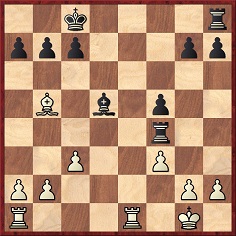
18...g5 19 Re5 c6 20 Bd3 Rf8 21 Rae1 h5 22 Re8+ Rxe8 23 Rxe8+ Kd7 24 Re5 Kd6 25 Rxf5 Rxf5 26 Bxf5 Bxa2 27 h4 gxh4 28 Bg6 Ke5 29 Bxh5
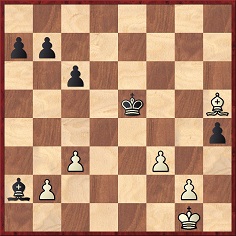
29...Kf4 30 Kf2 a5 31 Bg6 Bc4 32 Be4 Bd5 33 Bc2 b6 34 Bd3 c5 35 Bc2 b5 36 Ke2 Kg3 37 Kf1 c4 38 Kg1 b4 39 cxb4 axb4 40 Kf1 c3 41 bxc3 bxc3 42 Kg1 Ba2 43 Kf1 Bc4+ 44 Kg1 Bb5 45 Kh1 Bf1 46 Kg1 Bxg2 47 f4 h3 48 f5 h2 mate.
Source: Hamburger Nachrichten, 7 February 1904, page 28.
(10396)
Thomas Niessen has found three more Lasker games:
Happich – Emanuel Lasker (simultaneous)
Aachen, 10 November 1913
Vienna Gambit
1 e4 e5 2 Nc3 Nf6 3 f4 d5 4 fxe5 Nxe4 5 Qf3 Nxc3 6 bxc3 Nc6 7 d4 Be7 8 Bf4 O-O 9 Bd3 Be6 10 Ne2 Qd7 11 O-O f5 12 Qg3 Kh8 13 Bg5 h6 14 Bxe7 Nxe7 15 Nf4 c5 16 Nh5 Rf7 17 Rf2 c4 18 Be2 Rg8 19 Qe3 Rgf8 20 Nf4 g5 21 Nxe6 Qxe6 22 Bh5 Rg7 23 Raf1 Rfg8 24 g4 f4 25 Qc1 Ng6 26 Qa3 a6 27 Rb1 Nh4 28 Qc5
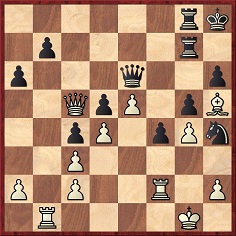
28...Rc8 29 Rb6 Rxc5 30 Rxe6 Rc6 31 Rxc6 bxc6 32 e6 Re7 33 Bf7 Kg7 34 Re2 Kf6 35 White resigns.
Source: Aachener Anzeiger – Politisches Tageblatt, 30 November 1913 (evening edition).
Vopel – Emanuel Lasker (simultaneous)
Aachen, 5 February 1925
Sicilian Defence
1 e4 c5 2 d4 cxd4 3 Nf3 e5 4 Bc4 Nc6 5 O-O d6 6 Ng5 Nh6 7 f4 f6 8 Nf3 Nf7 9 c3 dxc3 10 Nxc3 Be7 11 Kh1 O-O 12 f5 Bd7 13 Nh4 Rc8 14 Qh5 Nd4 15 Bd5 Bc6
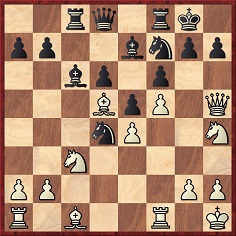
16 Ng6 Bxd5 17 Nxf8 Bc4 18 Ne6 Nxe6 19 fxe6 Bxe6 Drawn.
Source: Aachener Anzeiger – Politisches Tageblatt, 14 February 1925 (midday edition).
Emanuel Lasker (simultaneous) – Dreyfus
Aachen, 5 February 1925
Ruy López
1 e4 e5 2 Nf3 Nc6 3 Bb5 a6 4 Bxc6 dxc6 5 Nc3 Bg4 6 h3 Bxf3 7 Qxf3 Bc5 8 d3 Qf6 9 Be3 Qxf3 10 gxf3 Bd6 11 Ne2 c5 12 f4 f6 13 fxe5 fxe5 14 Rg1 g6
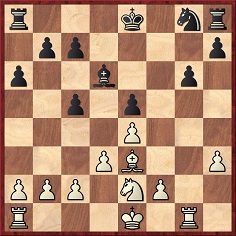
15 f4 b6 16 O-O-O O-O-O 17 Rdf1 Nf6 18 fxe5 Bxe5 19 Bg5 Rd6 20 Bf4 Bxf4+ 21 Nxf4 Nd7 22 Nd5 c6 23 Ne3 Rf6 24 Ng4 Rxf1+ 25 Rxf1 Rf8 26 Rxf8+ Nxf8 Drawn.
Source: Aachener Anzeiger – Politisches Tageblatt, 21 February 1925 (midday edition).
(10410)
In C.N.s 10396 and 10410 Thomas Niessen (Aachen, Germany) presented a number of forgotten games played by Emanuel Lasker in simultaneous exhibitions. Many more have now been discovered by our correspondent and are given below with his commentary in italics.
‘In The Hague on 23 January 1920 Lasker and Capablanca signed a draft agreement for a world title match, and that evening Lasker began a tour of the Netherlands which lasted until mid-February. Several games from his simultaneous displays were republished in K. Whyld’s The Collected Games of Emanuel Lasker (Nottingham, 1998) and in volumes 7 and 9 of the Quarterly for Chess History, but many more can be presented here, from the Delpher website.
At the second display, in Leiden on 26 January 1920, Lasker won 23 games and drew four. Two games were published in De Telegraaf, 28 January 1920 (morning edition, page 3) and the Haagsche Courant, 29 January 1920.’
van Rijnswou – Emanuel Lasker
Leiden, 26 January 1920
Ruy López
1 e4 e5 2 Nf3 Nc6 3 Bb5 Bc5 4 O–O Nge7 5 c3 O–O 6 d4 exd4 7 cxd4 Bb6 8 Be3 d5 9 Nbd2 Bg4 10 e5 Nxd4 11 Bxd4 Bxd4 12 Qc1 Bb6 13 Rd1 c6 14 Bd3 Ng6 15 Bxg6 fxg6 16 h3 Be6
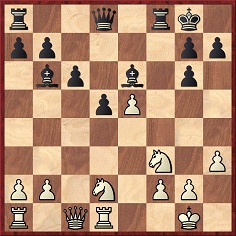
17 Ne4 dxe4 18 Rxd8 Raxd8 19 Ng5 Rxf2 20 Kh2 Bd5 21 Qc3 h6 22 Nxe4 Bxe4 23 Qc4+ Bd5 24 Qg4 Rxg2+ 25 White resigns.
Emanuel Lasker – B. Vles
Leiden, 26 January 1920
Queen’s Gambit Declined
1 d4 d5 2 Nf3 Nf6 3 c4 e6 4 Bg5 Nbd7 5 e3 Be7 6 Nc3 O–O 7 Rc1 c6 8 Bd3 dxc4 9 Bxc4 Qa5 10 O–O e5 11 Re1
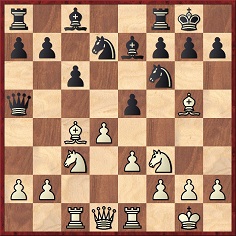
11...Nb6 12 Nxe5 Nxc4 13 Bxf6 Nxb2 14 Nc4 Nxd1 15 Nxa5 Bb4 16 Rexd1 Bxa5 17 Bh4 Be6 18 a3 Bb3 19 Rd2 b5 20 Be7 Rfe8 21 Bc5 Bxc3 22 Rxc3 Bd5 23 f3 a5 24 Kf2 f5 25 h3 Re6 26 Re2 Rae8 27 Re1 Rb8 28 Rb1 Rbe8 29 Bb6 a4 30 Bc5 g6 31 Re1 Rf6 32 Ke2 Rfe6 33 Kd2 Kg7 34 Ke2 f4 35 Kf2 fxe3+ 36 Rcxe3 Rxe3 37 Rxe3 Rxe3 38 Kxe3 Drawn.
‘On 31 January 1920 Lasker gave a display in the VAS (Vereenigd Amsterdamsch Schaakgenootschap). Two more games from the event were published in De Telegraaf, 7 February 1920 (evening edition, page 6). Although this source does not mention the event, it can be identified from the list of players and openings in De Telegraaf, 2 February 1920 (evening edition, page 10).’
Emanuel Lasker – H. van Hartingsvelt
Amsterdam, 31 January 1920
French Defence
1 e4 e6 2 d4 d5 3 Nc3 Nf6 4 Bg5 Be7 5 e5 Nfd7 6 h4 a6 7 Qg4 h5 8 Qf4 c5 9 dxc5 Nc6 10 Nf3 f6 11 exf6 gxf6 12 Bd3 Nde5 13 O–O–O fxg5 14 hxg5 Nxd3+ 15 Rxd3 Rf8 16 Qg3 h4 17 Qg4 Qc7 18 Rxh4 Bd7 19 Qh5+ Kd8 20 Qg6 Ne5 21 Qg7 Nxd3+ 22 cxd3 Qxc5 23 d4 Qd6 24 Ne5 Kc7 25 f4 Rg8 26 Qh7 Raf8 27 g3 Be8 28 Rh6 Kb8 29 Kb1
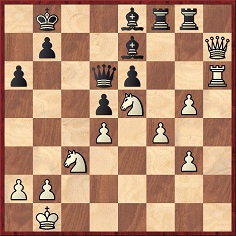
29...Bxg5 30 fxg5 Rxg5 31 g4 Rxe5 32 dxe5 Qxe5 33 Qe7 Rf1+ 34 Kc2
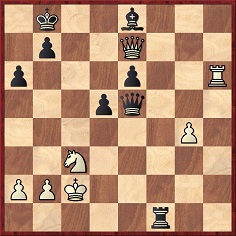
34...Ba4+ 35 Nxa4 Qe2+ 36 Kb3 Rf3+ 37 Nc3 Qc4+ 38 Ka3 Rxc3+ 39 b3 Rxb3+ 40 axb3 Qc1+ 41 Ka4 Qxh6 42 g5 Qg6 Drawn.
Emanuel Lasker – J. Perlmutter
Amsterdam, 31 January 1920
Queen’s Gambit Declined
1 d4 d5 2 Nf3 Nf6 3 c4 e6 4 Bg5 h6 5 Bh4 dxc4 6 e3 b5 7 a4 c6 8 axb5 Bb4+ 9 Nbd2 cxb5 10 Be2 Bb7 11 O–O a6 12 Ne5 O–O 13 Bf3 Bd5 14 h3 g5 15 Bg3 Bxd2 16 Qxd2 Ne4 17 Bxe4 Bxe4 18 f3 Bh7 19 f4 f6 20 Ng4 Kg7 21 h4 Nd7 22 hxg5 hxg5 23 fxg5 f5 24 Ne5 Nc5 25 Qe2 Ne4 26 Bf4 Bg6 27 g4 Qe8 28 Qg2 Rh8
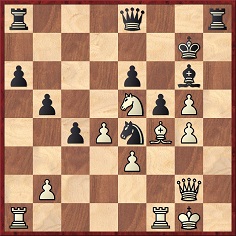
29 d5 exd5 30 Nxg6 Kxg6 31 gxf5+ Kxf5 32 Rad1 Rd8 33 g6 Qxg6 34 Bc7+ Resigns.
‘On 6 February 1920 Lasker gave a simultaneous exhibition in the club De Witte (The White) in The Hague. Two games appeared in Het Vaderland, 8 February 1920 (morning edition, page 3):’
L.A. Nijpels – Emanuel Lasker
The Hague, 6 February 1920
Albin Counter-Gambit
1 d4 d5 2 c4 e5 3 Nc3 exd4 4 Qxd4 Nc6 5 Qxd5 Be6 6 Qb5 Qd7 7 e3 Nb4 8 Qxd7+ Kxd7 9 Rb1 Nf6 10 a3
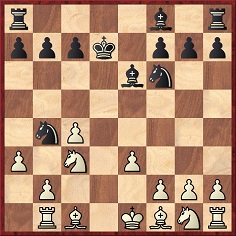
10...Nc2+ 11 Kd2 Bf5 12 Bd3 Bxd3 13 Kxd3 Ne1+ 14 Ke2 Nxg2 15 h4 Bd6 16 Kf1 Nxe3+ 17 Bxe3 Ng4 18 Rd1 Nxe3+ 19 fxe3 Kc6 20 Nge2 Rae8 21 Nd4+ Kc5 22 b4+ Kxc4 23 Ke2 Bf4 24 Nf5 Kxc3 25 Rd3+ Kb2 26 Rhd1 Be5 27 R1d2+ Kc1 28 Nd4 Bxd4 29 Rxd4 Re6 30 Rg4 Rc6 Drawn.
‘Since White could play 31 Rg1 mate, Black's 27th move may have been ...Kb1.’
H. Hakkert – Emanuel Lasker
The Hague, 6 February 1920
Ruy López
1 e4 e5 2 Nf3 Nc6 3 Bb5 Bc5 4 d3 Nge7 5 O–O O–O 6 Nc3 d6 7 h3 Be6 8 Be3 Bb6 9 Na4 h6 10 Nxb6 axb6
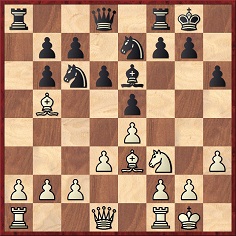
11 d4 f5 12 Bxc6 bxc6 13 dxe5 fxe4 14 exd6 exf3 15 dxe7 Qxe7 16 Qd4 Rad8 17 Qe5 Rd5 18 Qg3 Rh5 19 Qg6 fxg2 20 Qxh5 gxf1(Q)+ 21 Rxf1 Bd5 22 Qg4 Bf3 23 Qg3 Qe6 24 Bd4 Rf7 25 Kh2 Qd5 26 Bc3 Be4 27 Rg1 Qd7 Drawn.
‘The latter game was also in the above-mentioned article in De Telegraaf, 7 February 1920, which had the next one too:’
Emanuel Lasker – J.M.W. Nash
The Hague, 6 February 1920
French Defence
1 d4 e6 2 e4 d5 3 Nc3 Nf6 4 Bg5 Bb4 5 e5 h6 6 Be3 Ne4 7 Qg4 g5 8 h4 Rg8 9 Ne2 Rg7
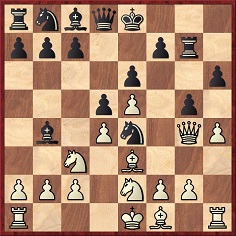
10 hxg5 hxg5 11 Rh8+ Bf8 12 Nxe4 dxe4 13 Ng3 Nd7 14 Nxe4 Qe7 15 O–O–O b6 16 Bb5 Bb7 17 Nf6+ Kd8 18 Bxd7 Resigns.
‘Lasker gave a display in the ASC (Amsterdamsche Schaakclub) on 9 February 1920. The following game was published in De Telegraaf, 13 February 1920 (evening edition, page 10). The event was not mentioned there, but can be identified from a list of players and results in the Haagsche Courant, 13 February 1920.’
Emanuel Lasker – Hendrik Gerhardus Reeders
Amsterdam, 9 February 1920
Ruy López
1 e4 e5 2 Nf3 Nc6 3 Bb5 a6 4 Ba4 Nf6 5 O–O Nxe4 6 d4 b5 7 Bb3 d5 8 dxe5 Be6 9 c3 Be7 10 Nbd2 O–O 11 Bc2 f5 12 Nb3 Qd7 13 Nbd4 Nxd4 14 Nxd4 c6 15 f3 Ng5 16 Qd3 c5 17 Bxg5 Bxg5 18 Nxe6 Qxe6 19 f4 Be7

20 g4 g6 21 gxf5 gxf5 22 Kh1 Kh8 23 Rg1 Rad8 24 Rg2 d4 25 cxd4 Rxd4 26 Qf3 Rdd8 27 Rag1 Rg8 28 Rxg8+ Rxg8 29 Rxg8+ Kxg8 30 Qd3 Qc6+ 31 Kg1 c4 32 Qg3+ Kh8 33 Bxf5 Bc5+ 34 Kf1 Qh1+ 35 Ke2 Qc1 36 Kf3 Qd1+ 37 Kg2 Qe2+ 38 Kh3 Qh5+ Drawn.
‘Another game from this event was published in Algemeen Handelsblad, 6 March 1920 (evening edition, page 9):’
Emanuel Lasker – C. Keyzer
Amsterdam, 9 February 1920
Sicilian Defence
1 e4 c5 2 Nf3 Nc6 3 d4 cxd4 4 Nxd4 Nf6 5 Nc3 d6 6 Bc4 Bd7 7 O–O g6 8 Nxc6 Bxc6 9 Be3 Bg7 10 f3 O–O 11 Qd2 Qc7 12 Nb5 Qd7 13 Nd4 Rac8 14 Bb3 Bb5 15 Nxb5 Qxb5 16 Rfd1 Rc7 17 Qf2 b6 18 a4 Qc6 19 a5 Nd7 20 c3 Rb8 21 axb6 Nxb6 22 Ra3 Rcb7 23 Rd2
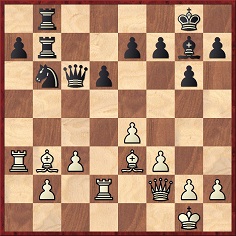
23...Nc4 24 Bxc4 Qxc4 25 h3 a6 26 Bd4 Bh6 27 Re2 Qd3 28 Ra1 Rb3 29 f4 Bxf4 30 Rf1 e5 31 Be3 Rxb2 32 Rxb2 Rxb2 33 Qxb2 Bxe3+ 34 Rf2 Qxe4 35 Kf1 Bxf2 36 Kxf2 Qc6 and Black won.
‘The next day, 10 February 1920, Lasker gave a display at the students’ chess club Philidor in Amsterdam. The game below was published in De Telegraaf, 13 February 1920 (the same edition and page number as given above) and Algemeen Handelsblad, 13 March 1920 (evening edition, page 9).’
Emanuel Lasker – P. Dijkstra
Amsterdam, 10 February 1920
Centre Counter Game
1 e4 d5 2 exd5 Qxd5 3 Nc3 Qa5 4 Nf3 Nf6 5 Be2 Nc6 6 O–O Bg4 7 d4 O–O–O 8 Be3 e5 9 Nb5 Bxf3 10 gxf3 a6 11 a4 exd4 12 Bf4 Nd5 13 Bg3 Qb4 14 Qd3 h5 15 c3 Qe7 16 Rfe1 Qf6 17 Nxd4 h4 18 Nxc6 hxg3 19 fxg3 Qxc6 20 Bf1 Bc5+ 21 Kh1 Ne3 22 Qe2
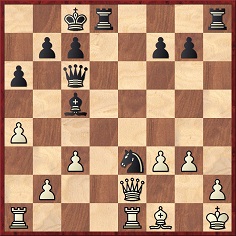
22...Nc2 23 Qxc2 Qxf3+ 24 Qg2 Rxh2+ 25 Kxh2 Rh8+ 26 Qh3+ Rxh3+ 27 Bxh3+ Kb8 28 Rf1 Bf2 29 Rg1 Bxg1+ 30 Rxg1 Qe2+ 31 Rg2 Qc4 32 a5 Qc5 33 Rd2 Qxa5 34 Kg2 f5 35 Kf3 Qe5 36 Re2 Qd5+ 37 Kf2 g5 38 Bg2 Qc5+ 39 Kf1 c6 40 Rf2 Qe3 41 Kg1 Qxg3 42 Rxf5 Qe3+ 43 Kh2 Qd2 44 White resigns.
‘Lasker gave an exhibition in Nijmegen on 11 February 1920, winning 27 games, drawing one and losing one, to H.G. Deckers (Provinciale Geldersche en Nijmeegsche courant, 12 February 1920). The defeat was published in De Telegraaf, 21 February 1920 (evening edition, page 7).’
H.G. Deckers – Emanuel Lasker
Nijmegen, 11 February 1920
Two Knights’ Defence
1 e4 e5 2 Nf3 Nc6 3 Bc4 Nf6 4 Ng5 d5 5 exd5 Na5 6 Bb5+ c6 7 dxc6 bxc6 8 Be2 h6 9 Nf3 e4 10 Ne5 Bd6 11 d4 Qc7 12 f4 exf3 13 Nxf3 Ng4 14 O–O Bxh2+ 15 Kh1 Bg3 16 Qd3 O–O 17 Qc3 Re8 18 Bd3 Nb7 19 Na3 Nd6 20 Nc4
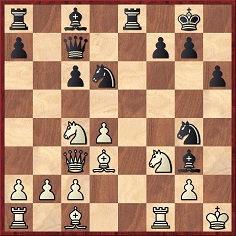
20...Nf2+ 21 Rxf2 Bxf2 22 Bf4 Bg4 23 Bxd6 Qd7 24 Nce5 Qxd6 25 Nxg4 Bg3 26 Rf1 Rad8 27 Nfe5 Qxd4 28 Qb3 Bxe5 29 Nxh6+ Resigns.
‘On 13 February 1920 Lasker was again in The Hague in the chess club DD (Discendo Discimus), where the tour had begun. This time he played simultaneously against five pairs of consulting players. All the games were published in De Telegraaf, 15 February 1920 (morning edition, page 10), and four are republished below (the fifth one, against van Gelder and H. Hakkert, having been given by Whyld).’
Emanuel Lasker – Jan Willem te Kolsté and J. Vijzelaar
The Hague, 13 February 1920
Ruy López
1 e4 e5 2 Nf3 Nc6 3 Bb5 a6 4 Ba4 Nf6 5 O–O Nxe4 6 d4 b5 7 Bb3 d5 8 dxe5 Be6 9 c3 Be7 10 Nbd2 Nc5 11 Bc2 O–O 12 Nb3 Nxb3 13 axb3 Qd7 14 Re1 Rfd8 15 Bg5 Bf5 16 Bxf5 Qxf5 17 Bxe7 Nxe7 18 Nd4 Qg6 19 b4 Nf5 20 f4 Qb6
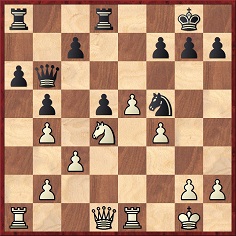
21 g4 Ne7 22 f5 c5 23 bxc5 Qxc5 24 f6 gxf6 25 exf6 Nc6 26 Qd2 Kh8 27 Kh1 Nxd4 28 cxd4 Qd6 29 g5 Re8 30 Rxe8+ Rxe8 31 Re1 Rxe1+ 32 Qxe1 Qb8 33 Qe7 Qc8 34 Qc5 Qe8 35 Qxd5 Qe1+ 36 Kg2 Qe2+ 37 Kg3 Qe3+ Drawn.
Rudolf Johannes Loman and Gerardus Wilhelmus Johannes
Zittersteyn – Emanuel Lasker
The Hague, 13 February 1920
Ruy López
1 e4 e5 2 Nf3 Nc6 3 Bb5 a6 4 Ba4 Nf6 5 O–O Be7 6 d4 exd4 7 e5 Ne4 8 Nxd4 O–O 9 Bxc6 dxc6 10 Be3 f6 11 exf6 Bxf6 12 c3 Qd5 13 Nd2 Nd6 14 Qb3 Qxb3 15 axb3 c5 16 Ne2 b6 17 Ng3 Be6 18 Rfe1 Bf7 19 Bf4 Rfe8 20 Nge4 Be7 21 f3 a5 22 Nxd6 Bxd6 23 Bxd6 cxd6
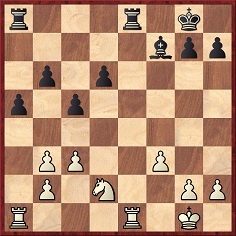
24 Nc4 Bxc4 25 bxc4 Rxe1+ 26 Rxe1 Kf7 27 Kf2 Rb8 28 Re2 b5 29 cxb5 Rxb5 30 Ke3 d5 31 Kd3 Rb7 32 Kc2 Re7 33 Rf2 a4 34 Kd2 Kf6 35 g3 Kf5 36 Re2 Rxe2+ 37 Kxe2 g5 38 Kd3 Ke5 39 Ke3 h5 40 Kd3 Drawn.
Emanuel Lasker – Gerard C. Adrianus Oskam and W. van Kooy
The Hague, 13 February 1920
Ruy López
1 e4 e5 2 Nf3 Nc6 3 Bb5 Nf6 4 O–O Nxe4 5 d4 Be7 6 Qe2 Nd6 7 Bxc6 bxc6 8 dxe5 Nb7 9 Nc3 O–O 10 Nd4 Nc5 11 Rd1 Qe8 12 Re1 Ne6 13 Nxe6 fxe6 14 Be3 Rf5 15 f4 d5 16 Qf2 Qf8
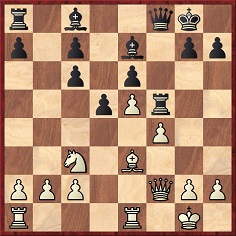
17 Na4 d4 18 Bxd4 Rxf4 19 Qd2 c5 20 Rf1 Rxf1+ 21 Rxf1 Qd8 22 Nxc5 h6 23 Rd1 Qd5 24 Qc3 Bxc5 25 Qxc5 Bb7 26 Qxd5 exd5 27 e6 Re8 28 Re1 Bc8 29 e7 Kf7 30 Bc5 a6 31 Kf2 Bf5 32 Re2 Bd7 33 Ke3 Rb8 34 b3 Bb5 35 Rf2+ Ke6 36 Rf8 Re8 37 Kd4 Bc6 38 a4 Bd7 39 Kc3 Bc6 40 Kb4 Kd7 41 Ka5 Ra8 42 Rxa8 Bxa8 43 Kxa6 Resigns.
Emanuel Lasker – J.F. Heemskerk and H. Steffelaar
The Hague, 13 February 1920
Queen’s Gambit Declined
1 d4 d5 2 Nf3 Bf5 3 c4 e6 4 Nc3 Nf6 5 cxd5 exd5 6 Qb3 Bc8 7 Bg5 Be7 8 Bxf6 Bxf6 9 Qxd5 O–O 10 e3 Qe7 11 Bd3 c6 12 Qe4 g6 13 Qxe7 Bxe7 14 Bc4 Kg7 15 O–O Nd7 16 Bb3 Nb6 17 h3 Bd7 18 Ne5 Rad8 19 Rfd1 Bc8 20 Rac1 f6 21 Nd3 Rd7 22 Ne4 Nd5 23 Nec5 Rd6 24 e4 Nc7
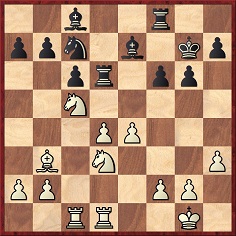
25 d5 b6 26 e5 fxe5 27 Ne4 c5 28 Nxe5 Rf5 29 Nxd6 Bxd6 30 Nc4 Bf4 31 Ne3 Rf6 32 Rc4 Nb5 33 Re4 Kf8 34 Nc4 Nd4 35 Rde1 Bd7 36 Re7 Bf5 37 Rxa7 g5 38 Bd1 b5 39 Bh5 Bg6 40 Bxg6 Rxg6 41 Ne5 Rd6 42 Nd7+ Resigns.
‘Another five-game simultaneous exhibition was given by Lasker on 16 February 1920, in the ASC. Again, only four of them are republished here, because the game against M. Euwe and C. Keijzer/Keyzer is in Emanuel Lasker Denker Weltenbürger Schachweltmeister edited by R. Forster, S. Hansen and M. Negele (Berlin, 2009). That book also has a game by Lasker against Euwe from a standard display. The first three games below are taken from De Telegraaf, 19 February 1920 (morning issue, page 2), and the fourth game was published in Algemeen Handelsblad, 20 March 1920 (evening edition, page 9).’
H. van Hartingsvelt and Hendrik Gerhardus Reeders – Emanuel
Lasker
Amsterdam, 16 February 1920
Two Knights’ Defence
1 e4 e5 2 Nf3 Nc6 3 Bc4 Nf6 4 d3 Bc5 5 Nc3 d6 6 Bg5 h6 7 Bxf6 Qxf6 8 h3 Ne7 9 Qd2 c6 10 a3 Bb6 11 O–O–O Be6 12 Bxe6 fxe6 13 d4 exd4 14 Nxd4 O–O–O 15 f3 Rhe8 16 Rhe1 Ng6 17 Nde2 e5 18 Kb1 Nh4 19 Nc1 g5 20 Na4 Bc7 21 c4 Ng6 22 Ne2 Kb8 23 Qc2 h5 24 Rd3 Nf4 25 Nxf4 gxf4 26 Red1 b6 27 Nc3 Rg8 28 b4 Qe6 29 Na4 a6 30 c5 dxc5 31 Rxd8+ Rxd8 32 Rxd8+ Bxd8 33 Qd3 Bc7 34 bxc5 b5 35 Nb2 Kb7 36 Qc3 Qg8 37 Qc2 a5 38 Nd3 Ka6
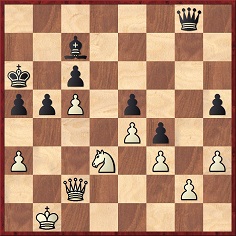
39 a4 Qd8 40 Qc3 bxa4 41 Kc2 Qg8 42 Ne1 Kb5 43 Qb2+ Qb3+ 44 Qxb3+ axb3+ 45 Kxb3 Kxc5 46 Nc2 Bd6 47 Ka4 Kc4 48 Na1 Bb4 49 Nb3 c5 50 Nc1 Kc3 51 g4 fxg3 52 Ne2+ Kb2 53 Nxg3 c4 54 Nxh5 c3 55 Ng3 c2 56 Ne2 c1(Q) 57 Nxc1 Kxc1 58 h4 Bd2 and White resigned after a few more moves.
Emanuel Lasker – E. Straat and P. Wiersma
Amsterdam, 16 February 1920
Queen’s Gambit Declined
1 d4 d5 2 Nf3 Nf6 3 c4 e6 4 Bg5 h6 5 Bh4 dxc4 6 e3 Bb4+ 7 Nbd2 b5 8 Be2 Bb7 9 O–O Nbd7 10 Qc2 a6 11 Rad1 Qc8 12 Bxf6 Nxf6 13 Nxc4 O–O 14 Nce5 Bd6 15 Rc1 Nd7 16 Nc6 Qe8 17 Na5 Bd5 18 e4 Bb4 19 Nc6 Bxc6 20 Qxc6 Ba5 21 a4 bxa4 22 Bxa6 Nf6 23 Bb7 Qxc6 24 Bxc6 Rab8 25 Rc2 Rb4
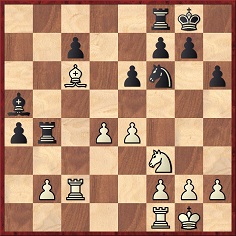
26 e5 Nd5 27 Rc5 Bb6 28 Rb5 Rc4 29 Bxd5 exd5 30 Rxd5 Rb4 31 Ra1 Rxb2 32 h4 Ra8 33 Ra3 Kf8 34 e6 fxe6 35 Re5 c5 36 dxc5 Rb1+ 37 Ne1 Bxc5 38 Rxc5 Rxe1+ 39 Kh2 Re4 40 g3 Rb4 41 Rc7 Rb3 42 Rxb3 axb3 43 Rb7 Ra2 44 Kg2 Rb2 45 Kf3 Rb1 46 Kg4 b2 47 Kh5 g5 Drawn.
Emanuel Lasker – Gerard Kroone and J.H. Löhr
Amsterdam, 16 February 1920
King’s Gambit Accepted
1 e4 e5 2 f4 exf4 3 Nf3 Nf6 4 e5 Nh5 5 d4 d5 6 Be2 g6 7 O–O c5 8 Ne1 Nc6 9 Bxh5 gxh5 10 Bxf4 Bg4 11 Qd2 Rg8 12 c3 Rc8 13 Be3 cxd4 14 cxd4 Qd7 15 Nc3 Ne7 16 Nd3 Ng6 17 Rac1 Rc6 18 Kh1 h4 19 Nf2 h3 20 Nxg4 Qxg4 21 gxh3 Qxh3 22 Qf2 f6 23 Nxd5 Nh4

24 Rxc6 Rg2 25 Rc8+ Kd7 26 Rc7+ Resigns.
Jos. de Koning and W. Fok – Emanuel Lasker
Amsterdam, 16 February 1920
English Opening
1 c4 e5 2 Nc3 Nc6 3 g3 f5 4 Bg2 Nf6 5 d3 Bc5 6 Bg5 Bxf2+ 7 Kd2 Bb6 8 e3 d6 9 Nge2 Be6 10 Bd5 Bxd5 11 cxd5 Ne7 12 Bxf6 gxf6 13 Qa4+ Qd7 14 Qh4 O–O 15 d4 Kh8 16 Rhg1 Rae8 17 Raf1 c6 18 dxc6 bxc6 19 Qh3 Qe6 20 b3
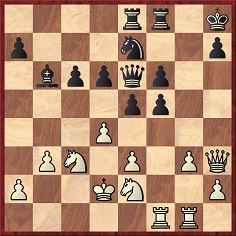
20...c5 21 d5 Nxd5 22 Qxf5 Nxe3 23 Kxe3 c4+ 24 Kd2 Bxg1 25 Qxe6 Rxe6 26 Rxg1 cxb3 27 axb3 d5 28 Rf1 Rd8 29 Ra1 a6 30 Ra4 Red6 31 g4 h5 32 h3 hxg4 33 hxg4 Kg7 34 Ng3 Kg6 35 Nf5 R6d7 36 Rxa6 Kg5 37 Ra5 Kf4 38 Kd3 d4 39 Ne4 Rb7 40 Nc5 Rb6 41 Ra4 Kxg4 42 Ke4 d3 43 Ne3+ Kg5 44 Nxd3 Rxb3 45 Nc5 Rb6 46 Nd3 Rb5 47 Ne1 Kg6 48 Nf3 Rdb8 49 Nh4+ Kf7 50 Nhf5 Rb4+ 51 Rxb4 Rxb4+ 52 Kd5
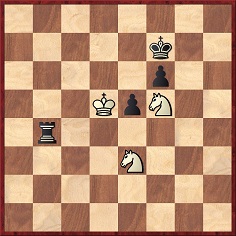
52...Rb1 53 Kd6 Ra1 54 Kd5 Ra8 55 Nd6+ Ke7 Drawn. (Adjourned and adjudicated by H. Weenink)
‘A simultaneous display in Utrecht was given by Lasker on 20 February 1920. The following two games were published in De Telegraaf, 21 February 1920 (evening edition, page 7 – as above), and the event is identifiable on account of a short report in Algemeen Handelsblad of the same day (evening edition, page 10).’
Emanuel Lasker – G.Ch. Smeekes
Utrecht, 20 February 1920
Queen’s Gambit Declined
1 d4 d5 2 c4 e6 3 Nf3 Nf6 4 Bg5 Nbd7 5 e3 Be7 6 Nc3 O–O 7 Rc1 b6 8 cxd5 exd5 9 Bd3 Bb7 10 O–O c5 11 Ne5 h6 12 Bh4 Re8 13 f4 Ne4 14 Bxe7 Rxe7 15 Nxe4 Nxe5 16 dxe5 dxe4 17 Bc4 Qc7 18 Qb3 Rd8 19 Rcd1 Rxd1 20 Rxd1 Bc8
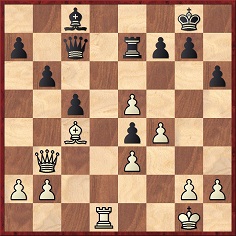
21 Rd6 Rd7 22 Qd1 Rxd6 23 Qxd6 Qxd6 24 exd6 Kf8 25 Bd5 f5 26 Bc6 Be6 27 a3 Kf7 28 g4 g6 29 Kf2 Bc4 30 gxf5 gxf5 31 Bd7 Be6 Drawn.
Emanuel Lasker – P. Ponssen
Utrecht, 20 February 1920
Queen’s Gambit Declined
1 d4 d5 2 c4 c6 3 e3 Nf6 4 Nc3 Bf5 5 cxd5 cxd5 6 Qb3 Bc8 7 Nf3 a6 8 Bd2 e6 9 Rc1 Bd6 10 Bd3 O–O 11 O–O Nc6 12 e4 dxe4 13 Nxe4 Be7 14 Bc3 Nd5 15 Rfe1 Nxc3 16 bxc3 b5 17 Qc2 g6 18 a4 b4 19 Red1 Rb8 20 Bc4 Na5 21 Bd3 b3 22 Qb2 Qb6 23 Ne5 Qc7 24 c4 f5 25 Ng3 Bf6 26 f4

26...Rb4 27 d5 Qc5+ 28 Kh1 Bxe5 29 Qxe5 Nxc4 30 Bxc4 Rxc4 31 Rb1 exd5 32 Rxb3 Rxa4 33 h4 Ra2 34 Rbd3 Bb7 35 h5 Qf2 36 Rg1 d4 37 Qe6+ Kg7 38 Qe7+ Rf7 39 h6+ Kg8 Drawn.
‘The following game was published with the two previous ones, and since Lasker’s opponent was from Utrecht it may be from the same display.’
Emanuel Lasker – J.H. Goud
The Netherlands, January or February 1920
King’s Gambit Accepted
1 e4 e5 2 f4 exf4 3 Nf3 g5 4 Bc4 Bg7 5 d4 h6 6 c3 d6 7 O–O c6 8 Qb3 Qe7 9 Nbd2 Nd7 10 a4 Nb6 11 Bd3 Be6 12 Qc2 a5 13 b3 Qc7 14 Bb2 Ne7 15 c4 Bg4 16 d5 Bxb2 17 Qxb2 O–O–O 18 b4 Nd7 19 Rfc1 axb4 20 Qxb4 Nc5 21 Bc2 Na6 22 Qb2 c5 23 Ne1 Ng6 24 a5 Ne5 25 Nd3 f6 26 Qc3 Kb8 27 Ba4 Rhf8 28 Bb5 Nxd3 29 Qxd3 Nb4 30 Qb3 Ka7 31 Nb1 Qe7 32 Nc3 h5
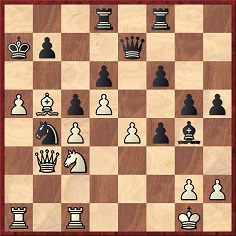
33 a6 b6 34 Bc6 Nxc6 35 dxc6 Be6 36 Nb5+ Ka8 37 Rd1 Rh8 38 Rab1 Bg4 39 Re1 Rc8 40 c7 Be6 41 Qd3 Rxc7 42 Nxc7+ Qxc7 43 Red1 Rd8 44 Qc3 Ka7 45 Qxf6 Bxc4 46 Qxg5 f3 47 Qf4 fxg2 48 Rd2 Bxa6 49 Ra1 Ra8 50 Rda2 Kb7 51 Qf5 c4 52 Qd5+ Qc6 53 Qxc6+ Kxc6 54 Rxa6 Rxa6 55 Rxa6 Kb5 56 Ra8 c3 57 Kxg2 Kb4 58 Kf2 c2 59 Rc8 Kb3 60 Ke2 Resigns.
‘A game definitely played in Utrecht is the next one, whose finish was published in De Telegraaf, 21 February 1920 (morning edition, page 7):’
Emanuel Lasker – Schuckink Kool and G.A.W. Verzijl
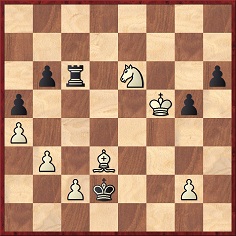
1 Be4 Rxc2 2 Bxc2 Kxc2 3 Nc7 Kxb3 4 Nd5 Kxa4 5 Nxb6+ Kb5 6 Nd5 Kc4 7 Nb6+ Kd4 Drawn.
‘On 24 February 1920 Lasker gave an exhibition in the chess club in Zeist (Algemeen Handelsblad, 25 February 1920, morning edition, page 8), and the latter part of a game was published in the Nieuwe Rotterdamsche Courant, 26 February 1920 (evening edition, page 1):’
Emanuel Lasker – A.S. Katan
Zeist, 24 February 1920
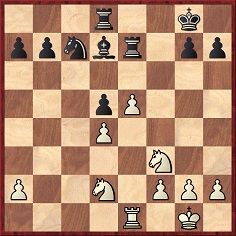
23 Nb3 Bc6 24 Nfd2 Ne6 25 h4 Rf8 26 g3 h5 27 f4 Nxf4 28 gxf4 Rxf4 29 Kg2 Rxh4 30 Nf3 Rg4+ 31 Kf2 Bd7 32 Rh1 Rf4 33 Kg3 Ref7 34 Nbd2 Bg4 35 Ng5 Rxd4 36 Nxf7 Rxd2 37 Ng5 Rxa2 38 Rc1 Re2 39 Kf4 d4 40 Rc7 d3 41 Rxb7 g6 42 Rb8+ Kg7 43 Rb7+ Kf8 44 Nh7+ Ke8 45 Nf6+ Kd8 46 Nxg4 d2 47 White resigns.
‘Lasker gave another display in The Hague on 26 February 1920, this time in the Residentie chess club. Three games were published in Het Vaderland the next day (evening edition, unnumbered page):’
Emanuel Lasker – Jan Willem te Kolsté
The Hague, 26 February 1920
Ruy López
1 e4 e5 2 Nf3 Nc6 3 Bb5 a6 4 Bxc6 dxc6 5 Nc3 Bc5 6 d3 Qd6 7 Be3 Bg4 8 h3 Be6 9 d4 exd4 10 Bxd4 Bxd4 11 Qxd4 Nf6 12 O–O–O Qf4+ 13 Kb1 O–O 14 Rd3 b6 15 g3 Qh6 16 Qe3 Qxe3 17 Rxe3 Rad8 18 g4 Rfe8 19 Kc1 Bc8 20 Rd1 Bb7 21 Rxd8 Rxd8 22 Rd3 Rxd3 23 cxd3
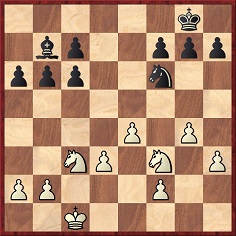
23...c5 24 Kd2 h6 25 Ke3 Kf8 26 Nh4 g6 27 f4 Ke7 28 Ne2 c4 29 Ng3 cxd3 30 Kxd3 c5 Drawn.
Emanuel Lasker – W. de Bruijn
The Hague, 26 February 1920
Queen’s Gambit Declined
1 d4 d5 2 c4 e6 3 Nf3 Nf6 4 Bg5 Nbd7 5 e3 Be7 6 Nc3 O–O 7 Rc1 c5 8 cxd5 cxd4 9 Nxd4 Nxd5 10 Bxe7 Nxe7 11 Be2 Nf6 12 Bf3 Ned5 13 O–O Nxc3 14 Rxc3 e5 15 Nb5 a6 16 Nc7 Rb8 17 Qb3 e4 18 Be2 b5 19 Qb4 Nd5 20 Nxd5 Qxd5
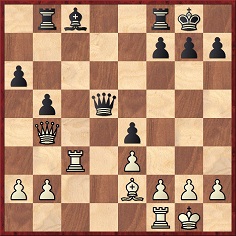
21 a4 Qd2 22 Bc4 Bd7 23 axb5 Bxb5 24 Bxb5 Rxb5 25 Qxe4 Rxb2 26 Qd3 g6 27 Qxd2 Rxd2 28 Ra3 Ra8 Drawn. ‘White’s 28th move is taken from De Telegraaf, 5 March 1920.’
Emanuel Lasker – R.D.G. Telkamp
The Hague, 26 February 1920
Ruy López
1 e4 e5 2 Nf3 Nc6 3 Bb5 d6 4 d4 Bd7 5 Nc3 Nf6 6 O–O Be7 7 Bg5 O–O 8 Qd3 a6 9 Bxc6 Bxc6 10 dxe5 dxe5 11 Nxe5 Re8 12 Nxc6 bxc6 13 Bf4 Qb8 14 b3 Bb4 15 f3 Rd8 16 Qe3 Ba5 17 Na4
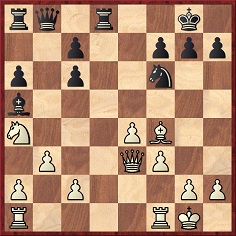
17...Bd2 18 Qxd2 Rxd2 19 Bxd2 Qa7+ 20 Rf2 Rd8 21 Kf1 Nd7 22 Re1 Qb7 23 Be3 Ne5 24 Nc5 Qb4 25 a4 a5 26 Rfe2 Drawn.
‘There are also games whose exact occasion cannot be specified:’
R.A.J. Meijer – Emanuel Lasker
The Netherlands, January or February 1920
Queen’s Pawn Opening
1 d4 Nf6 2 Nf3 e6 3 c4 b6 4 d5 Bb7 5 Nc3 Bb4 6 Bg5 h6 7 Bxf6 Qxf6 8 Qb3 Na6 9 O–O–O Bxc3 10 Qxc3 Qxc3+ 11 bxc3 Nc5 12 Rd4 Ke7 13 Nd2 e5 14 Rg4 Rag8 15 e4 d6 16 h4 Bc8 17 Rg3 g6 18 Re3 f5 19 f3 f4 20 Re1 Bd7 21 Nb3 Na4 22 Kd2 g5 23 Nc1 g4 24 Be2 Rg7 25 Kc2
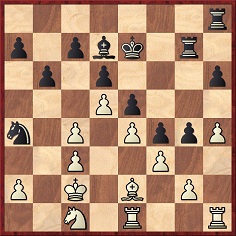
25...Rhg8 26 Nd3 Kf6 27 Ref1 Nc5 28 Ne1 gxf3 29 Bxf3 b5 30 cxb5 Bxb5 31 Rf2 Rb8 32 Rd2 Rb6 33 g4 fxg3 34 Ng2 Rg8 35 Ne3 Ba4+ 36 Kc1

36...Rgb8 37 White resigns.
‘It is known that Meijer lost to Lasker in Nijmegen on 11 February 1920, but this game had already been published in De Telegraaf, 7 February 1920 (evening edition, page 6 – as above). That is also the source for the next game:’
Willem Andreas Theodorus Schelfhout – Emanuel Lasker
The Netherlands, January or February 1920
Vienna Gambit
1 e4 e5 2 Nc3 Nf6 3 f4 d5 4 fxe5 Nxe4 5 Nf3 Nc6 6 Bb5 Be7 7 O–O O–O 8 Qe2 Nc5 9 d4 Ne6 10 Be3 f6 11 Rad1 a6 12 Ba4 Na5 13 Bb3 Nxb3 14 axb3 c6 15 Qf2 fxe5 16 dxe5 Bd7
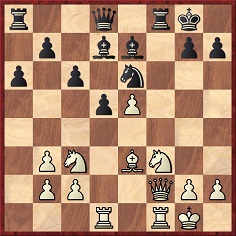
17 Bb6 Qxb6 18 Qxb6 Bc5+ 19 Qxc5 Nxc5 20 b4 Ne6 21 Na4 Rad8 22 c3 Be8 23 Nd4 Rxf1+ 24 Rxf1 Nxd4 25 cxd4 Rd7 26 Nc5 Re7 27 h3 Bg6 28 Rf4 Bc2 29 g4 b6 30 Nxa6 Bd3 31 Nb8 Bb5 32 e6 Rxe6 33 Nd7 g5 34 Rf5 Re1+ 35 Kg2 h6 36 Rf6 Kg7 37 Rd6 Re2+ 38 Kf3 Rxb2 39 Nxb6 Rxb4 40 Nc8 Rxd4 41 Ne7 Rd3+ 42 Kg2 c5 43 Nf5+ Kf8 44 Rxh6 Rd2+ 45 Kg3 Bd3 46 Rh8+ Kf7 47 Rh7+ Ke6 48 Rh6+ Ke5 49 Rg6 c4 50 Rxg5 c3 51 White resigns.
‘It is known that Schelfhout lost to Lasker in Enschede on 29 January 1920 (Provinciale Overijsselsche en Zwolsche courant, 2 February 1920), but it is unclear whether this was the game.
The final game was published in De Telegraaf, 13 February 1920 (same edition and page as above).’
Emanuel Lasker – M.L.
The Netherlands, January or February 1920
French Defence
1 e4 e6 2 d4 d5 3 Nc3 Nf6 4 Bg5 Be7 5 e5 Nfd7 6 h4 a6 7 Qg4 h5 8 Bxe7 hxg4 9 Bxd8 Kxd8 10 Nd1 f6 11 exf6 gxf6 12 Ne3 f5 13 Ne2 Nf6 14 g3 Bd7 15 Bg2 Nc6 16 O–O–O b5 17 Nf4 Ne7 18 Rhe1 Ne8 19 c4 c6 20 b3 bxc4 21 bxc4 Ng7 22 Kb2 Kc7 23 Kc3 Rab8 24 Rb1 dxc4 25 Nxc4 Nd5+ 26 Bxd5 cxd5 27 Ne5 Bb5 28 Nf7 Rhc8 29 Kd2 Be8
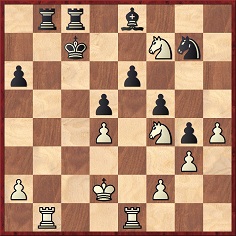
30 Ng5 Rxb1 31 Rxb1 Kd6 32 Rb7 Bd7 33 Ra7 Rc6 34 Nf7+ Ke7 35 Ne5 Rd6 36 h5 Ne8 37 Nfg6+ Kf6 38 Nxd7+ Kg5 39 Nf4 Resigns.
(10432)
From page 67 of CHESS, February 1941, in a tribute to Emanuel Lasker by W.H. Cozens:
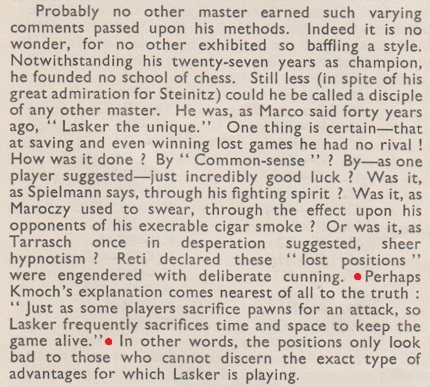
The highlighted remark attributed to Kmoch deserves further scrutiny:
‘Just as some players sacrifice pawns for an attack, so Lasker frequently sacrifices time and space to keep the game alive.’
(10426)
Neil Blackburn (Redditch, England) draws attention to an observation by Lasker about Steinitz (Lasker’s Chess Magazine, August-September 1906, page 182) concerning the opening game of their first world championship match (New York, 15 and 16 March 1894), in which Lasker was White. 1 e4 e5 2 Nf3 Nc6 3 Bb5 d6 4 d4 Bd7 5 Nc3:
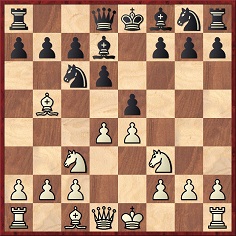
Steinitz now played 5...Nge7.
Lasker wrote:
‘I did not try for more than the slight advantage which naturally accrues to the first player from a somewhat quicker development. Steinitz played an absolutely sound defence to my Ruy López, such as with slight modification has come into vogue at the present moment. Still, his fifth move left something to be desired, as it advanced Black’s development only to a small degree. But quick development was not a thing which Steinitz aimed at.
He was satisfied with a development sufficiently rapid to meet attacks, but sufficiently backward to leave many pieces unexchanged and to lead to many complications – an ingenious idea of which nobody but Steinitz has ever known, the masterly execution.
It was in the nature of things that Black’s king’s knight had to make many moves before it arrived at a stable position. The fifth move implied that necessity.’
Pages 183-184 had Steinitz’s annotations to the game. The first two notes:
After 3...d6: ‘The revival of this defence met with much opposition, but I have seen nothing as yet to vitiate the equalizing effect which, in my opinion, it possesses.’
After 5...Nge7: ‘An important key-move to this defence, which I first adopted in my match against Gunsberg.’
Steinitz was referring to the second game of his 1890-91 match against Gunsberg, which began 1 e4 e5 2 Nf3 Nc6 3 Bb5 d6 4 c3 Bd7 5 O-O Nge7.
Steinitz’s notes to the above-mentioned Lasker game were published in the New York Recorder of 18 March 1894. An account by Lasker had appeared in the New York Daily Tribune the previous day.
(10434)
The Introduction to Why Lasker Matters (London, 2005) begins, on page 3, with Soltis’s signature sourcelessness:
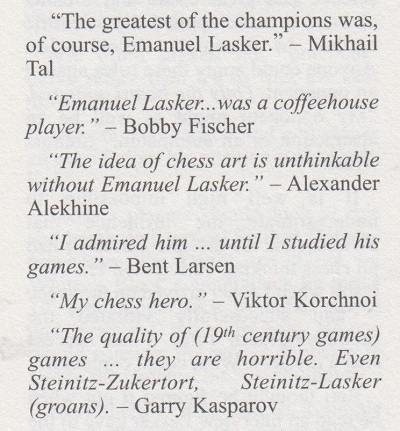
(10435)
From Chess and the English Language:
The introductory note to Lasker v Bauer, Amsterdam, 1889 on page 14 of Why Lasker Matters by Andrew Soltis (London, 2005):
‘Okay, it can’t be delayed any longer. This is the brilliancy that made Lasker famous.’
From page 303, at the start of the note to 13 Rxf6 is Lasker v Pirc, Moscow, 1935:
‘Yeah, right, another rook-takes-knight sack in the Sicilian. What’s the big deal?’
Those citations prompt some general thoughts. If paragraphs can begin with ‘Okay’ and ‘Yeah’, they can finish with ‘Just saying’, ‘Nuff said’ and ‘End of’. Instead of ‘in my opinion’, there is ‘for my money’, ‘my ten cents’ worth is that’ and, more assertively, ‘fact is’. A bewildering set of abbreviations may be deployed, such as ‘fwiw’ [for what it’s worth] to introduce, with specious diffidence, an opinion worth nothing.
Emanuel Lasker’s view of the Immortal Game:
‘It is not very difficult to understand why the “Immortal Game” between Anderssen and Kieseritzky should appeal to the popular mind. Besides the enormous sacrifice of material by White, there is the rare occurrence of all Black’s pieces on the board when he is mated.
The effect of the tremendous labor of the annotators of this game must ultimately result in removing it from the singularly high position in which it has been fixed. The demonstrable fact that White missed a certain win, and that later Black missed a certain draw, practically removes the game from the realms of the classics.
It is a very moot question whether “skittle” games deserve the amount of attention which is bestowed upon them. It may be that irresponsibility and accident produce bewildering, dazzling and even original positions.
“Skittle” playing, as recreation, has a useful function to perform. But, if chess is to be treated as literature, then it is incumbent that the games that are published shall be the product of much thought, of deep imagination, of a sentiment of truth; and above all that the players shall be imbued with a feeling of responsibility, such as follows from tournament or match play.’
The game was then given with detailed notes.
Source: pages 18-20 of the Chess Player’s Scrap Book, February 1907. The periodical, edited by Lasker, was discontinued later that year, after issue 6-7.
(10502)
The Immortal Game and the Evergreen Game were annotated on pages 82-84 of Emanuel Lasker’s London Chess Fortnightly, 14 January 1893.
Page 68 of the May 1907 issue of the Chess Player’s Scrap Book gave the bare score of Morphy v the Duke and Count with the following introduction by Lasker:
‘This is a great game, played against a weak combination. On the eighth move White could have won the QKt pawn, which would have been good enough to win the game, or played BxPch, followed by QxKtP. But that would have been a butcher’s method, not an artist’s.’
Lasker’s butcher/artist remark has often been quoted sourcelessly (e.g. in P.W. Sergeant’s first monograph on Morphy) with reference to 8 Bxf7+, and not also 8 Qxb7.
(10503)
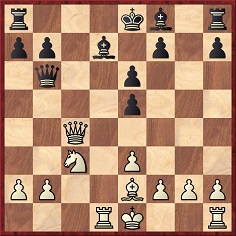
White has played 13 Bf1-e2
In this position from Pillsbury’s win over Lasker at Cambridge Springs, 1904 the world champion played 13...Qxb2. From page 123 of Impact of Genius by R.E. Fauber (Seattle, 1992):
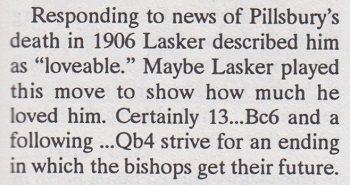
Sentences beginning with ‘Maybe’ seldom impress, and this is a particularly odd specimen.
It is nonetheless true that Lasker described Pillsbury as ‘lovable’ in an obituary published on pages 25-27 of Lasker’s Chess Magazine, May 1906. The first paragraph:
‘American chessplayers, and with them the whole chess world, mourn over the sad loss and fate of a youthful, great and lovable man. The heart that bore undying love to all that is beautiful in chess beats no more. Harry Nelson Pillsbury was released from his sufferings on 2 [sic] June.’
The obituary concluded:
‘... the reproach cannot be spared to the chess world that it made the meagre prices it gave him dependent on too much effort and exertion. The victor of Hastings, the pathfinder in the thickest of chess theory, gifted with pleasant and lovable traits, a source of pleasure and joy and a teacher for thousands, he should not have been suffered to be without the comforts that make work easy and keep health intact. Instead he was made to work hard, he had to spend the valuable matter of his brain in many “entertainments” lasting six to ten hours in order to earn a barely sufficient livelihood.
Emanual [sic] Lasker.’
The obituary was reproduced on pages 81-83 of the final issue (June-July 1907) of the world champion’s other periodical of the time, the Chess Player’s Scrap Book. That number was wholly devoted to Pillsbury and had, on page 112, the score of Pillsbury v Lasker, Nuremberg, 1896 with this introduction by Lasker:
‘The 1896 Nuremberg tournament included the most noted players of the time, and the following game was undoubtedly the most brilliant played. After Black’s ninth move the game is lost, though, of course, not obviously.
Pillsbury’s genius for attack has never been demonstrated so admirably as in this game.
The crescendo sacrifice of a pawn, followed by the exchange and then a piece, is evidence of fearlessness in carrying out a plan on the chessboard such as has never been excelled.
At no point of this magnificent combination does he waver or deviate from the most correct course, nor could he, at any point, have accomplished his object in less time. It is a rare thing to find a game with successive sacrifices so long drawn out that some resource cannot be found to save the situation. But here his play is as sound as a rock, and the structure must remain a perpetual monument to his genius, and a classical example of chess at the end of the nineteenth century.’
The first part of the game was annotated on pages 247-248 of Lasker’s Manual of Chess (London, 1932).
(10512)
‘The man who criticizes books which tend to be scientific or literary is paid badly. Consequently no-one is induced to make a serious study of the act of criticism, with the result that much passes for great that is merely mediocre, and that the mediocre is praised beyond merit.’
Source: The Community of the Future by Emanuel Lasker (New York, 1940), page 181.
(10525)
C.N.s 3680, 3681, 3689 and 9904 (see Chess and Postage Stamps) showed Austrian stamps featuring Alekhine, Capablanca, Fischer, Kasparov, Rubinstein and Mieses.
We have a few others, including portraits of Steinitz, Lasker and Smyslov:
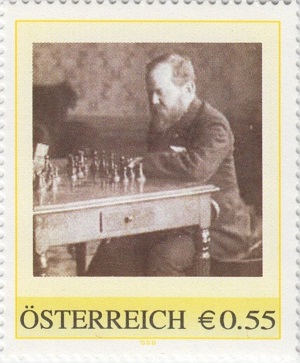
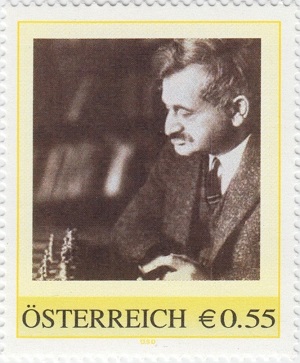
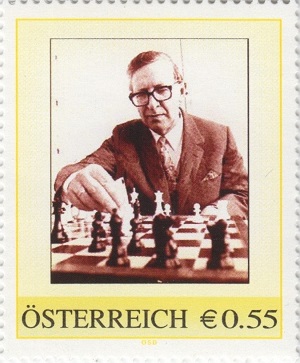
(10545)
From page iv of World’s Championship Matches, 1921 and 1927 (New York, 1977), in Irving Chernev’s 11-page Introduction to that Dover edition:
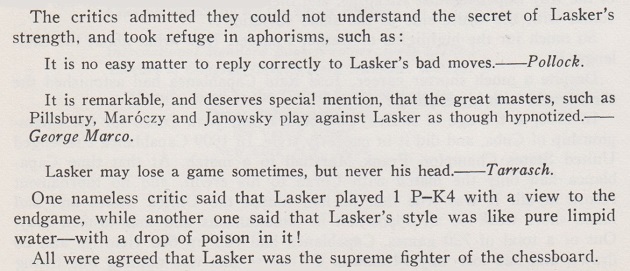
For the Pollock ‘aphorism’ (in the Hastings, 1895 tournament book), see our feature article on him. The source of Marco’s observation (Wiener Schachzeitung, 1900) was specified in C.N. 10546. The comment about P-K4 was discussed on page 297 of Chess Facts and Fables and in C.N. 9329. The water/poison remark was by Mieses (Berliner Tageblatt and the San Sebastián, 1911 tournament book), as shown in C.N.s 3160 and 3161 (see Chess: the Need for Sources).
That leaves Tarrasch’s remark, ‘Lasker may lose a game sometimes, but never his head’. It was on page 137 of Tarrasch’s book on St Petersburg, 1914:
‘Lasker verliert mitunter eine Partie, aber niemals den Kopf.’
It appeared in connection with Lasker’s move 24 Rc5 in his victory over Alekhine in the first round of the final section. Alekhine has just played 23...Nf5-e3:
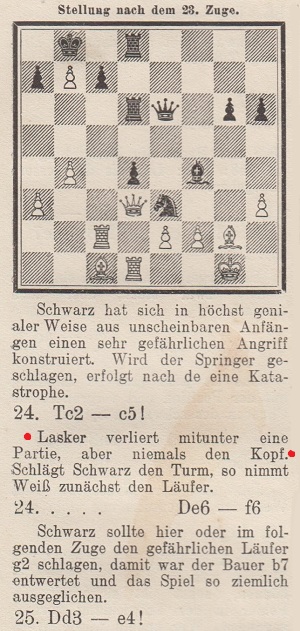
(10550)
From our above-mentioned feature article on Pollock:
Pollock defeated Steinitz in their only individual encounter (Hastings, 1895), a game which the victor annotated on pages 396-397 of the September 1895 BCM. Apart from their intrinsic interest, the notes are significant for being the source of Pollock’s most famous quote, ‘It is no easy matter to reply correctly to Lasker’s bad moves.’ Previous to the championship match between Steinitz and Lasker, at the request of the latter I played the defence to the Giuoco in a few off-hand games with him at the Manhattan Chess Club. I adopted this old defence without success, although Lasker admitted it was new to him. But I told him that Steinitz would play it against him and beat him if he did not play the attack differently. (It is no easy matter to reply correctly to Lasker’s bad moves.
From Nine Chess Positions:
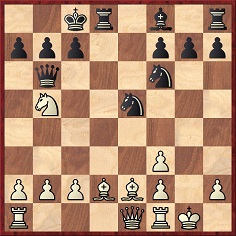
Black to move
Allies (J. Rosenthal, M. Rosenbaum and W.S. Morris)-J. Mieses, New York, 2 January 1908
12…Rxd2 13 Qxd2 Qxb5 14 f4 (‘Two pieces are now attacked simultaneously. A witty resource saves them both.’ – Emanuel Lasker.) 14…Qd7 and Black won easily.
Source: American Chess Bulletin, February 1908, page 24.
Regarding What is a Chess Combination?, Jean-Pierre Rhéaume notes that Lasker’s Manual of Chess does not mention the word ‘sacrifice’ in the definition of a combination. From page 123 of the 1927 book and page 109 of the 1932 edition:
‘In the rare instances that the player can detect a variation or net of them which leads to a desirable issue by force, the totality of these variations and their logical connections, their structure, are named a “combination”. And he who follows in his play such a chain of moves is said to “make a combination”.’
We recall a position from Blackburne v Weiss, New York, 1 April 1889:
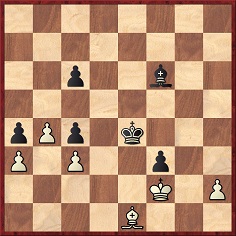
Black to move
52...Bh4+ 53 Kf1 Bxe1 54 Kxe1 Kd3 55 h4 Kxc3 56 h5 Kb3 57 h6 c3 58 h7 c2 59 Kd2 f2 60 h8(Q) c1(Q)+ 61 Kxc1 f1(Q)+ 62 Kd2 Qf2+ 63 Kd3 Qc2+ 64 Ke3 Qc3+ 65 Qxc3+ Kxc3 66 Ke4 Kb3 67 Kd4 Kxa3 68 Kc3 Ka2 69 Kc2 a3 70 Kc1 Kb3 71 White resigns.
On page 140 of The Most Instructive Games of Chess Ever Played (New York, 1965) Irving Chernev commented after 52...Bh4+:
‘This begins a 15-move combination. Despite its length, it is easy enough to visualize and understand it, if we break it down.’
Chernev then listed six stages in ‘the series of ideas’.
After 54...Kd3 Steinitz wrote on page 74 of the New York, 1889 tournament book:
‘The rest speaks for itself, for every move of the opponent is forced. Very likely, Herr Weiss had foreseen the present position and played for it some moves ago, before exchanging bishops, but, undoubtedly, he must have fore-calculated the very end of this game 16 moves later, when he did effect the exchange and relied on the move in the text.’
(10605)
Three simultaneous games played by Emanuel Lasker in Plzeň (Pilsen) on 15 [sic] June 1908 have been found by Jan Kalendovský in issues of Plzeňské Besedy from 1908-09 (exact publication dates unavailable):

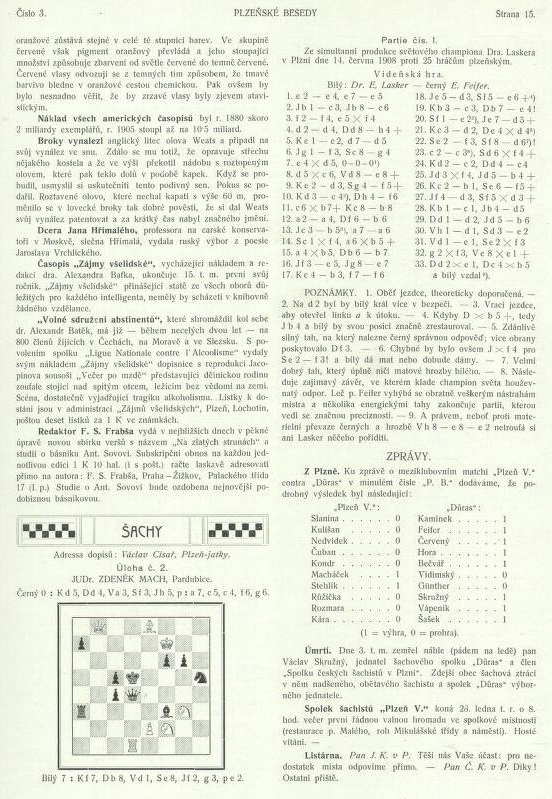
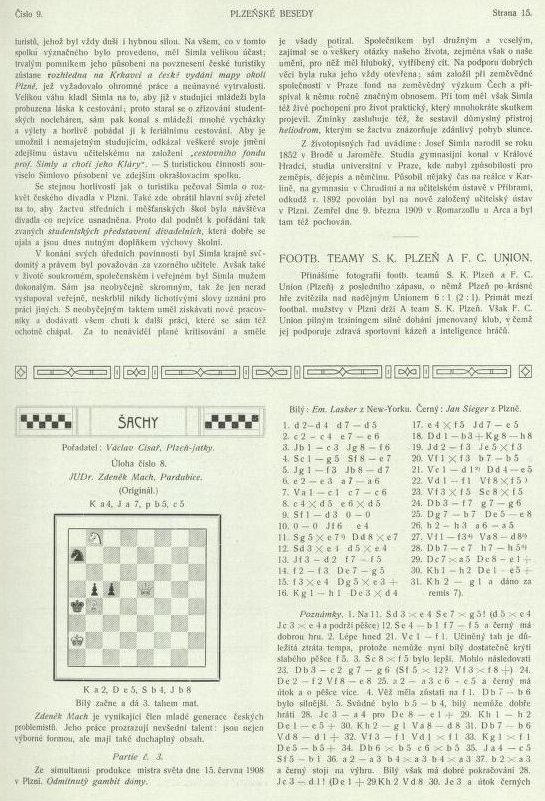
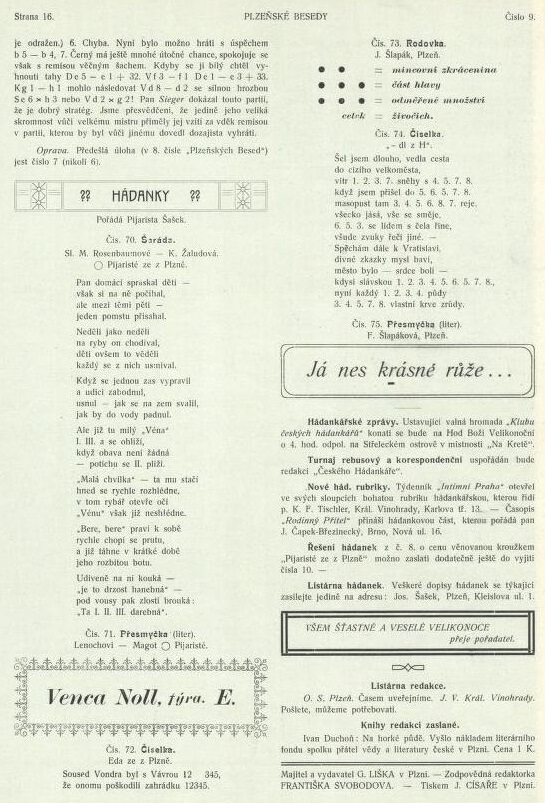
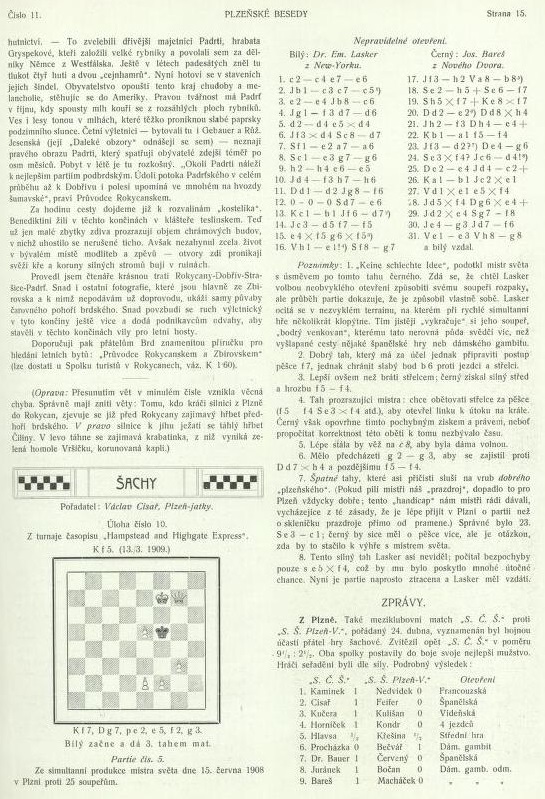
Lasker v E. Feifer: 1 e4 e5 2 Nc3 Nc6 3 f4 exf4 4 d4 Qh4+ 5 Ke2 d5 6 Nf3 Bg4 7 exd5 O-O-O 8 dxc6 Re8+ 9 Kd3 Bf5+ 10 Kc4

10...Qf6 11 cxb7+ Kb8 12 a4 Qb6 13 Nb5 a6 14 Bxf4 axb5+ 15 axb5 Qxb7 16 Ne5 Ne7 17 Kb3 f6 18 Nd3 Be6+ 19 Kc3 Qe4 20 Be2 Nd5+ 21 Kd2 Qxd4 22 Bf3 Bd6 23 c3 Bxf4+ 24 Kc2 Qc4 25 Nxf4 Nb4+ 26 Kb1 Bf5+ 27 Nd3 Bxd3+ 28 Kc1 Nd5 29 Qd2 Nb6 30 Rd1 Be2 31 Re1 Bxf3 32 gxf3 Rxe1+ 33 Qxe1 Qxb5 34 White resigns.
Lasker v Jan Sieger: 1 d4 d5 2 c4 e6 3 Nc3 Nf6 4 Bg5 Be7 5 Nf3 Nbd7 6 e3 a6 7 Rc1 c6 8 cxd5 exd5 9 Bd3 O-O 10 O-O Ne4 11 Bxe7 Qxe7 12 Bxe4 dxe4 13 Nd2 f5 14 f3
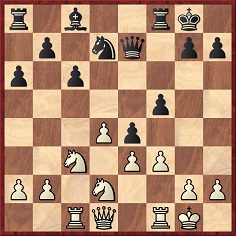
14...Qg5 15 fxe4 Qxe3+ 16 Kh1 Qxd4 17 exf5 Ne5 18 Qb3+ Kh8 19 Nf3 Nxf3 20 Rxf3 b5 21 Rd1 Qe5 22 Rdf1 Rxf5 23 Rxf5 Bxf5 24 Qf7 g6 25 Qb7 Qe8 26 h3 a5 27 Rf3 Rd8 28 Qc7 h5 29 Qxa5 Qe1+ 30 Kh2 Qe5+ 31 Kg1 Drawn.
Lasker v Jos. Bareš: 1 c4 e6 2 Nc3 c5 3 e4 Nc6 4 Nf3 d6 5 d4 cxd4 6 Nxd4 Bd7 7 Be2 a6 8 Be3 g6 9 h4 e5 10 Nf3 h6 11 Qd2 Nf6 12 O-O-O Be6 13 Kb1 Nd7 14 Nd5 f5 15 exf5 gxf5 16 Rhe1 Bg7 17 Nh2 Rb8 18 Bh5+ Bf7 19 Bxf7+ Kxf7 20 Qe2 Qxh4 21 Nf3 Qe4+ 22 Ka1
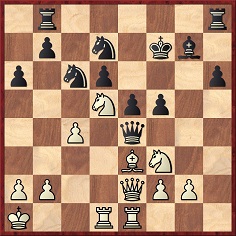
22...f4 23 Nd2 Qg6 24 Bxf4 Nd4 25 Qe4 Nc2+ 26 Kb1 Nxe1 27 Rxe1 exf4 28 Nxf4 Qxe4+ 29 Nxe4 Bf8 30 Ng3 Nf6 31 Re3 Rg8 32 White resigns.
(10694)
Taking the example of a 1932 Spielmann v Stoltz game, C.N. 2035 (see pages 208-209 of Kings, Commoners and Knaves) asked whether the definition of ‘combination’ should cover combinative hallucinations.
Not according to Emanuel Lasker, who wrote on page 153 of Lasker’s Manual of Chess (New York, 1927):
‘A combination must be sound. An unsound combination is no combination at all. It is merely an attempt, an error, a failure, a nonentity.’
The remark is in the Third Book, after a Tartakower-Alekhine position. The text in various German editions (page numbers vary):
‘Eine Kombination muß richtig sein, sonst ist sie nur ein Versuch, ein Fehlgriff, ein Irrtum, und eigentlich ein Unding.’
(11191)
From Richard Forster:
‘Can any reader shed light on Emil Lasker, the author of a 32-page booklet Das Pokerspiel. Leichtfaßliche Anleitung zu seiner gründlichen Erlernung (an easy introduction to poker)? It was brought out in 1907 by the Berlin publishing house of Hugo Steinitz (1852-1909), with a second edition/printing in 1924.
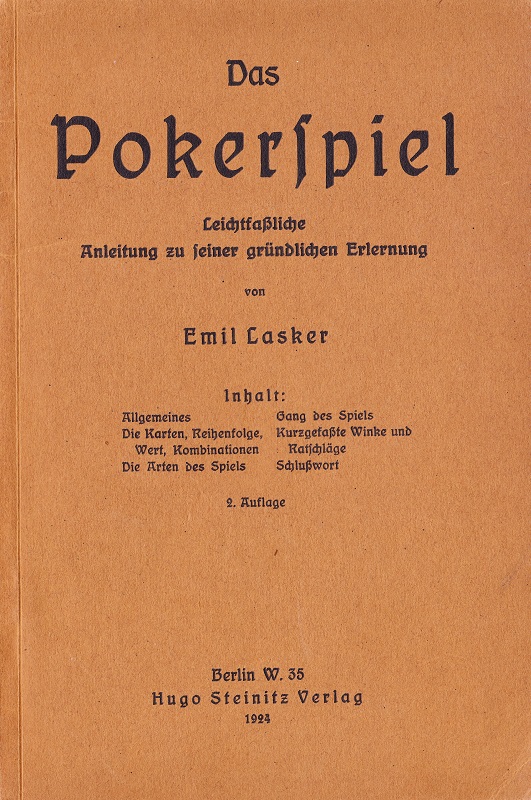
No biographical information on an “Emil Lasker” from that period has been found. Was it a pseudonym?
Emanuel Lasker did study and write about poker in the 1920s. This is the start of a 1927 manuscript on the game (courtesy of Jurgen Stigter, Amsterdam):
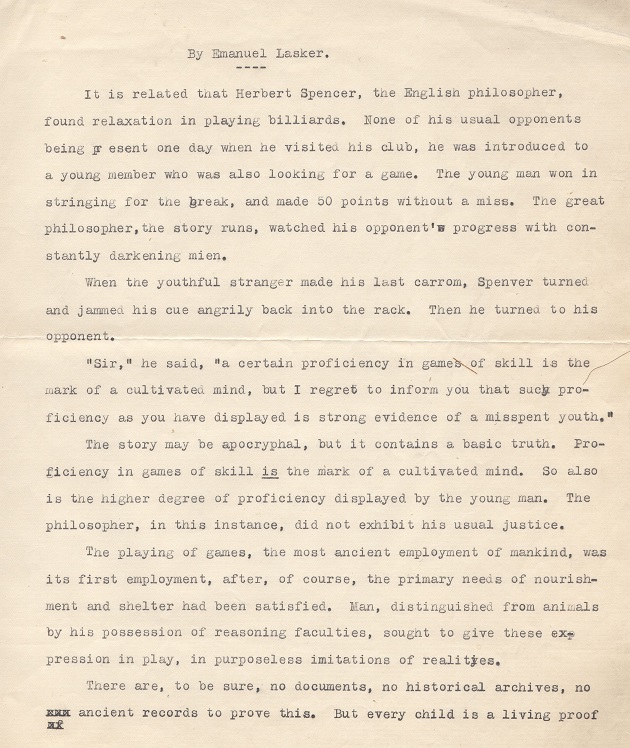
When Das Pokerspiel was first published, in 1907, Emanuel Lasker was in the United States. Although nothing has been found to link him to any person named Emil Lasker, the abbreviation “Em.” sometimes led writers to misname him. For example, on page 19 of the 1891 Schach-Jahrbuch Ludwig Bachmann reported that “Emil Lasker” had won the Hauptturnier in Breslau in 1889 .’
The above illustrations have been provided by our correspondent. An updated and expanded English edition of the 2009 German-language monograph on Emanuel Lasker is in preparation as a trilogy, and the first volume is due to be published by Exzelsior Verlag, Berlin in autumn 2018. Edited by Richard Forster, Michael Negele and Raj Tischbierek, that volume will focus on the early part of Lasker’s life (childhood; family; visits to the United Kingdom and the United States; his relations with Tarrasch, culminating in the 1908 world championship match) but will also discuss Lasker’s mathematical work and his chess studies and problems.
(10705)
From Michael Negele (Wuppertal, Germany):
‘According to page 226 of the Chess Monthly, April 1890, and various other sources, Lasker learned the rules of chess when he was 12 from his elder brother Berthold. As the future world champion was born on 24 December 1868, this must have been around 1881. The previous year he had moved from his parents’ home in Berlinchen to live in Berlin with Berthold, who was eight years his senior. Although fascinated by chess almost immediately, Emanuel stated on several occasions that he really learned how to play chess only a couple of years later, when “for over a year” he did not attend school (Ostrauer Zeitung, 5 January 1929; see also the interview in C.N. 9846). Research and examination of school records indicate that this period of intense chess immersion was in 1885; towards the end of that year his parents removed him from the temptations of chess and made him attend school in Landsberg.
During the early Berlin period, Emanuel met Siegbert Tarrasch for the first time according to Jacques Hannak; see page 16 of Emanuel Lasker Biographie eines Schachweltmeisters (Berlin, 1952). At that time, Berthold Lasker and Tarrasch met regularly over the chess board, and since Emanuel followed his brother’s chess activities closely from very early on, it is indeed highly probable that Tarrasch and the younger Lasker met on such an occasion, although their different levels make it unlikely that they played against each other. Tarrasch’s biographer Wolfgang Kamm suggests that those first meetings occurred in 1881/82, given that Tarrasch left Berlin in October 1882 to pursue his studies in Halle an der Saale. See page 91 of Siegbert Tarrasch Leben und Werk (Unterhaching, 2004).
What else is known about these activities in Berlin in the first half of the 1880s?’
This photograph of Tarrasch in 1880, of which a small version appeared in C.N. 3462, is given courtesy of Wolfgang Kamm:
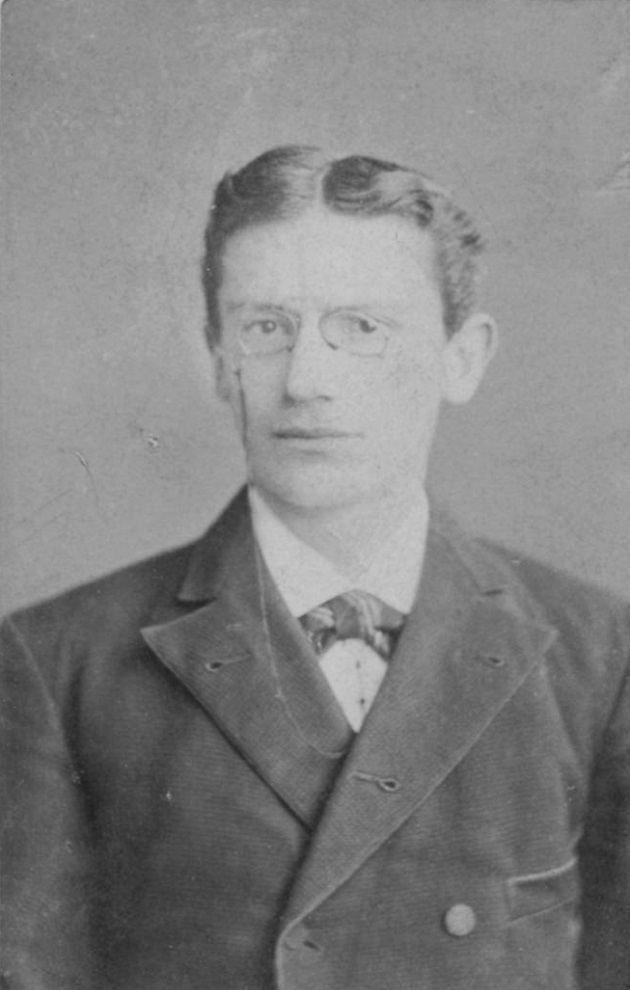
(10715)
Further to C.N. 10715, Michael Negele seeks more information about Lasker’s chess activities in 1886-88. He reports that his current knowledge may be summarized as follows:
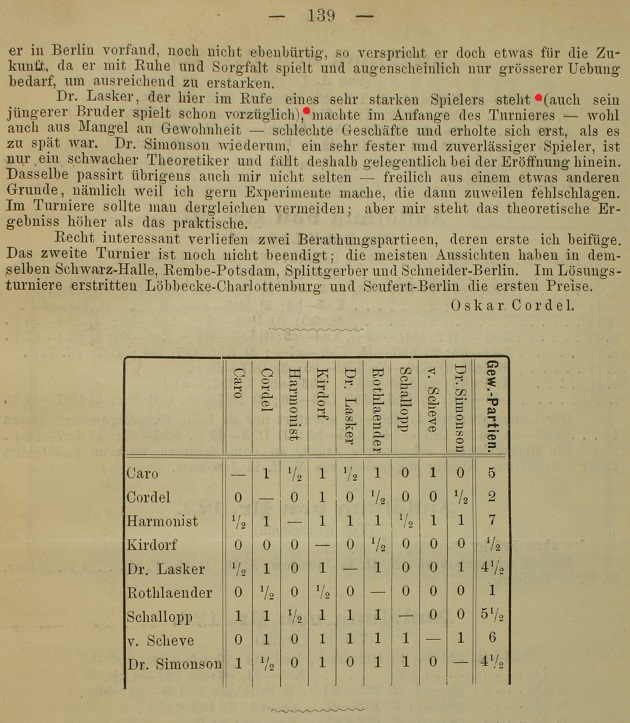
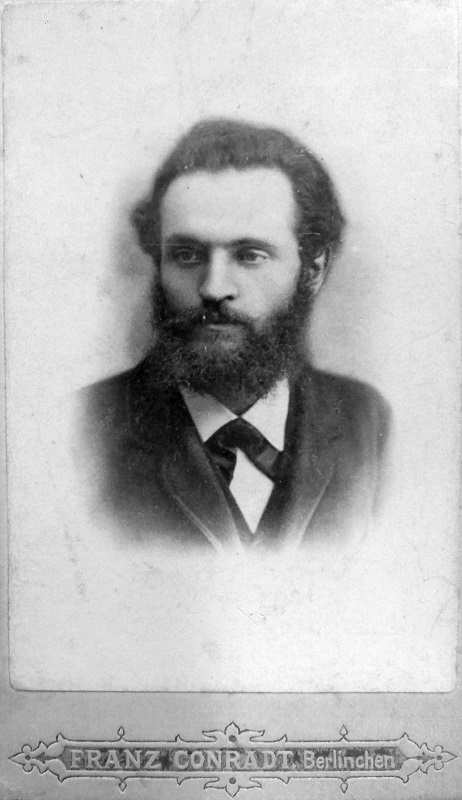
Berthold Lasker (Source: Niemeijer scrapbooks, Royal Dutch Library, The Hague)
Michael Negele, who has provided the above illustrations, concludes:
‘Is it possible to trace further corroboration of Lasker’s encounter with Tarrasch and, in particular, first-hand evidence which helps to date their two games? What is known of Lasker’s membership of the relatively obscure Berliner Schachklub and, more generally, can further information about the period 1885-88 be found in the local chess press or in later reminiscences by contemporaries? A search of the 1885-88 chess column of the Berlin Tägliche Rundschau (which Cordel appears to have edited from 27 May 1886 onwards) has produced no results.’
(10724)
From Peter Anderberg (Harmstorf, Germany):
‘An earlier reference to Emanuel Lasker with regard to chess is in the chess column of Tägliche Rundschau (Unterhaltungsbeilage), 30 March 1887, page 300, shortly before Easter 1887 (Easter Sunday that year fell on 10 April). Emanuel Lasker was called “Lasker II” as in Brüderschaft in 1888.

See also issue 35 of Kaissiber (December 2009), page 47.’
(10727)
Since the matter raised by Bernd Graefrath in C.N. 2192 (see page 338 of A Chess Omnibus) remains unresolved, his contribution is repeated here:
‘In my research on Emanuel Lasker I have found conflicting data on a move in the fourth game of his match with Tarrasch (Düsseldorf, 24 August 1908). Lasker made his famous rook manoeuvre from e7 via e5 to c5. On move 15 did the white queen go from d4 to c3 or from d4 to c4?
The earliest sources by both Lasker and Tarrasch give 15 Qd4-c3 (and 17 Qc3-b3), as is shown by the Olms volume Die Schachwettkämpfe Lasker-Tarrasch um die Weltmeisterschaft 1908 und 1916 (Zurich, 1981). But later sources give 15 Qd4-c4 and 17 Qc4-b3. These include Réti’s Die neuen Ideen im Schachspiel (Vienna, 1922), Tartakower’s Die hypermoderne Schachpartie (Vienna, 1924-25) and, even, a book by Lasker himself, Brettspiele der Völker (Berlin, 1931), page 79. I think that the older sources are more reliable, but how did the wrong move originate and spread?’
(10716)
Richard Forster writes:
‘In June 1889 Emanuel Lasker won a tournament at the Café Kaiserhof in Berlin. From a biographical note in the Chess Monthly, April 1890, page 226: “His first success dates from June 1889, when he won the first prize in a tournament at the Kaiserhof, Berlin, without losing a single game.” In an interview with the Berliner Schachzeitung (the issues of 1 and 16 April 1896, pages 3-7 and 18-21) Lasker mentioned that he had won every game in a tournament organized among students at the Café Kaiserhof, that each participant paid one Thaler and that the winner was to take everything: “Um jene Zeit wurde von mehreren hiesigen Studenten ein Turnier im Café Kaiserhof veranstaltet, in der Weise, dass jeder Teilnehmer einen Thaler einzuzahlen hatte und der Sieger den ‘Pot’ gewinnen sollte. Hierbei gewann ich sämmtliche Partieen und damit den Preis.” Lasker’s victory in all the games in the Kaiserhof tournament is confirmed by a report in Deutsches Wochenschach, 8 April 1894, page 116, which mentioned that Karl Holländer came second.
Describing the success on page 20 of Emanuel Lasker Biographie eines Schachweltmeisters (Berlin, 1952) Jacques Hannak mentioned a “Winterturnier” at the Kaiserhof, in the years 1888-89. Ken Whyld, on page 14 of The Collected Games of Emanuel Lasker (Nottingham, 1998), even referred to “the annual tournament of the Kaiserhof café in Berlin, in 1888-89”. This is in contrast to the earlier reports which point to a rather shorter event, with Deutsches Wochenschach in 1894 even calling it a “preparation tournament” for the summer 1889 Breslau congress. Does any reader have more information on the event?’
(10761)
A photograph has been forwarded by Eduardo Bauzá Mercére from Argentina’s Archivo General de la Nación, courtesy of the Ministerio del Interior, Obras Públicas y Vivienda (reference AR_AGN_DDF/Consulta_INV: 130945):
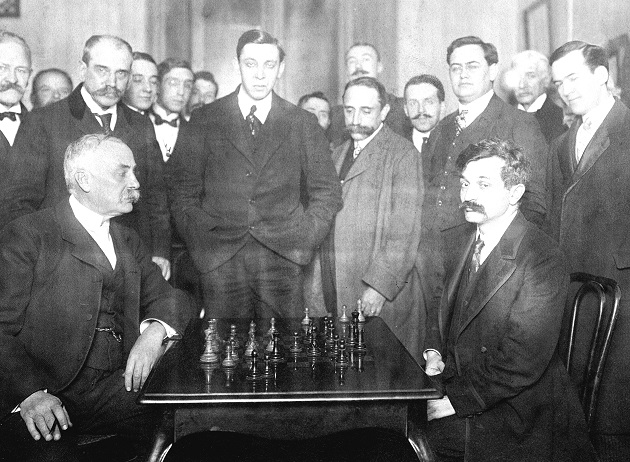
José Pérez Mendoza v Emanuel Lasker, Buenos Aires, June 1910
An inferior version of the picture was given in C.N. 4591, from page 408 of Pérez Mendoza’s book El Ajedrez en la Argentina (Buenos Aires, 1920):
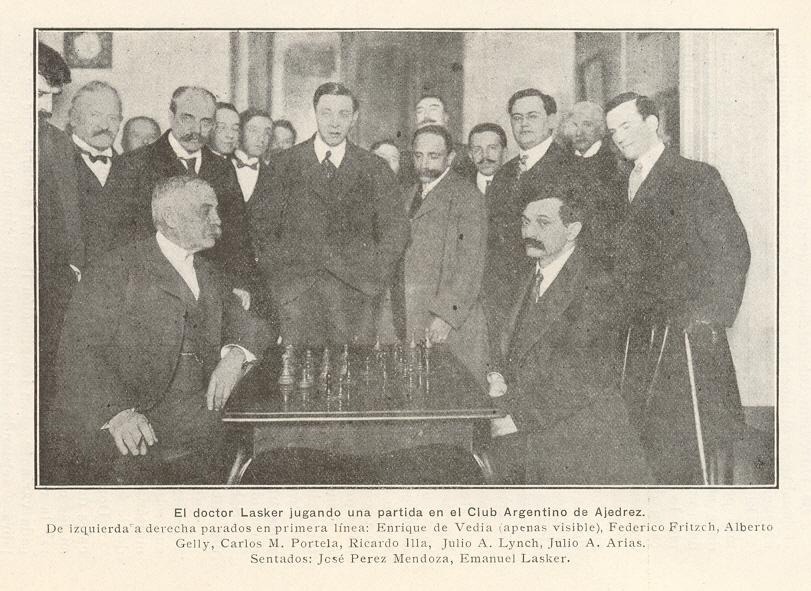
(10718)
Page 239 of Deutsches Wochenschach, 14 July 1889 gave this ending won by Lasker against Dr von Heydebreck at the Café Kaiserhof:
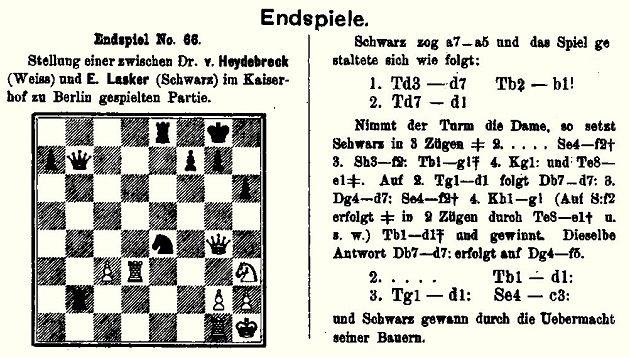
After 1...a5 2 Rd7 Rb1 White was unable to take the queen because of 3...Nf2+ 4 Nxf2 Rxg1+ 5 Kxg1 Re1 mate, and Black went on to win after 3 Rdd1 Rxd1 4 Rxd1 Nxc3.
Richard Forster comments:
‘It has been speculated by later writers that this ending was played in the 1889 Kaiserhof tournament. However, in an 1896 interview with the Berliner Schachzeitung (C.N. 10761) Lasker not only called it a tournament among students but also described Dr von Heydebreck as one of his most frequent opponents in those days at the Café Kaiserhof. The philologist Dr Wilhelm Adolph von Heydebreck (1840-99) was approaching his 50th year at the time of the game; how likely is it that he played in the tournament?’
(10762)
A further contribution from Richard Forster:
‘According to page 49 of the Breslau, 1889 tournament book, a group picture was arranged, featuring almost all the participants in the congress, and the photographer offered to take portraits of the masters free of charge. Lasker apparently availed himself of the opportunity, and courtesy of Bernhard Schmid (Lothar Schmid Collection, Bamberg) the portrait can be shown here:
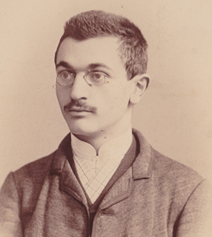
However, the Breslau, 1889 group photograph seems elusive. Has it ever been published?
The tournament was Lasker’s first official appearance, and he won the Hauptturnier after a play-off. An article on page 267 of Deutsches Wochenschach, 10 August 1890 reported on the well-known incident with von Bardeleben in the Berlin, 1890 tournament; during that game Lasker left the tournament hall for a long time. In its discussion of the circumstances, the article also stated that Lasker had to be reprimanded in Breslau for not entirely correct behaviour (“... wegen eines nicht ganz korrekten Verhaltens eine Rüge zugezogen hat”). Is any information available on that alleged incident in Breslau?’
(10763)
This photograph, from page 6 of Das interessante Blatt, 26 April 1894, has been noted by Jan Kalendovský:
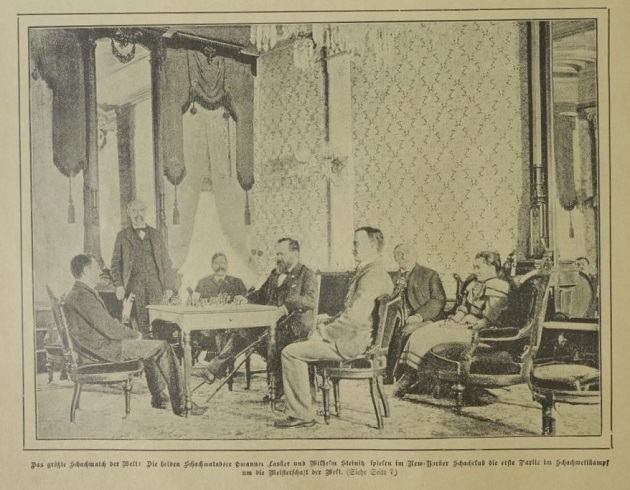
The picture was given, from another source, on page 55 of Emanuel Lasker Denker Weltenbürger Schachweltmeister edited by Richard Forster, Stefan Hansen and Michael Negele (Berlin, 2009).
(10824)
From a review by C.S. Howell of Lasker’s Manual of Chess (New York, 1927):
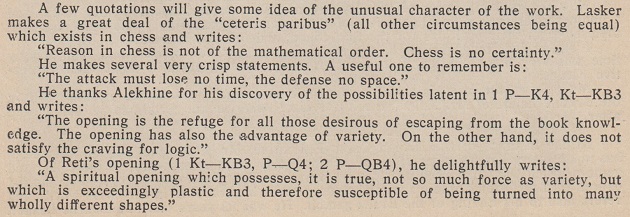
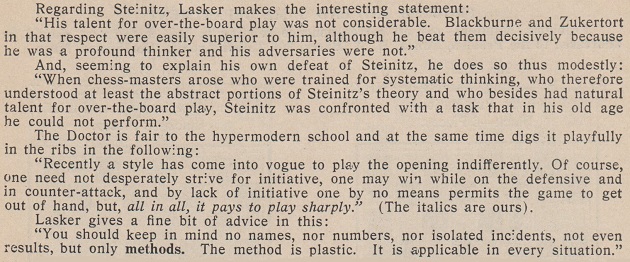
Source: American Chess Bulletin, September-October 1927, pages 158-159.
Lasker’s remark ‘The attack must lose no time, the defence no space’ comes from page 97 of the book and specifically concerned half-open games:
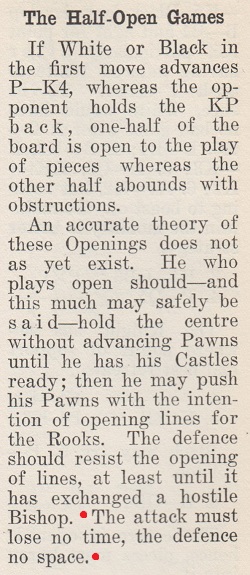
The passage is on pages 86-87 of the London, 1932 edition.
(10826)
Jean-Pierre Rhéaume points out that Lasker’s Manual of Chess ascribes the phrase ‘as cheap as blackberries’ to Hamlet (instead of Falstaff, in Henry IV Part I, act two, scene four – ‘if reasons were as plenty/plentiful as blackberries’). In the Manual page numbers vary from one edition to another; the reference is in the opening paragraph of the section entitled ‘The History of Planning in Chess’ in the Fourth Book. In German editions the text read ‘billig wie Brombeeren’, also with Hamlet mentioned incorrectly.
(10949)
The first paragraph of W.H. Watts’ ‘General Account of the Tournament’ in the Hastings, 1922 book by Alekhine:
‘During the early days of the London International Tournament of 1922 it was rumoured that the energetic Hastings Club were organizing a Masters’ Tournament. It was hoped that the participation of both Capablanca and Lasker would be secured, but first one and then the other dropped out for reasons it is unnecessary to go into here.’
In fact, plans for a tournament in Hastings involving Capablanca, Lasker, Alekhine and Rubinstein were in the public domain well before London, 1922 began. Page 257 of the June 1922 Chess Amateur carried a report from the Morning Post that the plan ‘aims at no less than a World Champions’ tournament. The present and past champions and the two candidates for the title ...’:
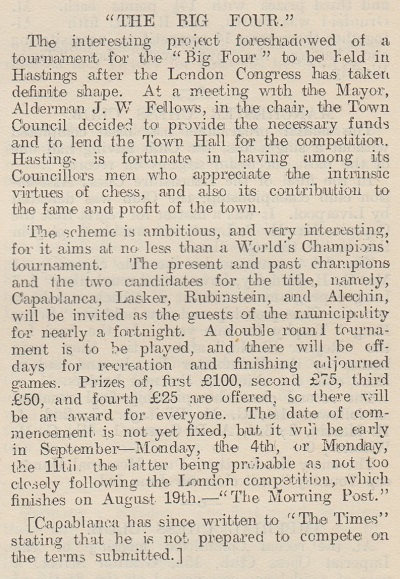
From page 9 of the 20 May 1922 edition of the Hastings and St Leonards Observer:

Capablanca’s refusal to participate was explained in detail in a letter published on page 7 of The Times, 26 May 1922, which is on page 120 of our book on the Cuban.
(10960)
Noting that Emanuel Lasker was 67 when he defeated Euwe at Nottingham, 1936, José Carlos Santos (Porto, Portugal) asks whether any even older player has ever beaten a reigning world champion under standard tournament or match conditions.
We add that Lasker’s famous win was discussed on pages 23-24 of the January 1937 Australasian Chess Review in an article by T.A. Krishnamachari. Its title, ‘Cross-Attack’, is a seldom-seen technical term.

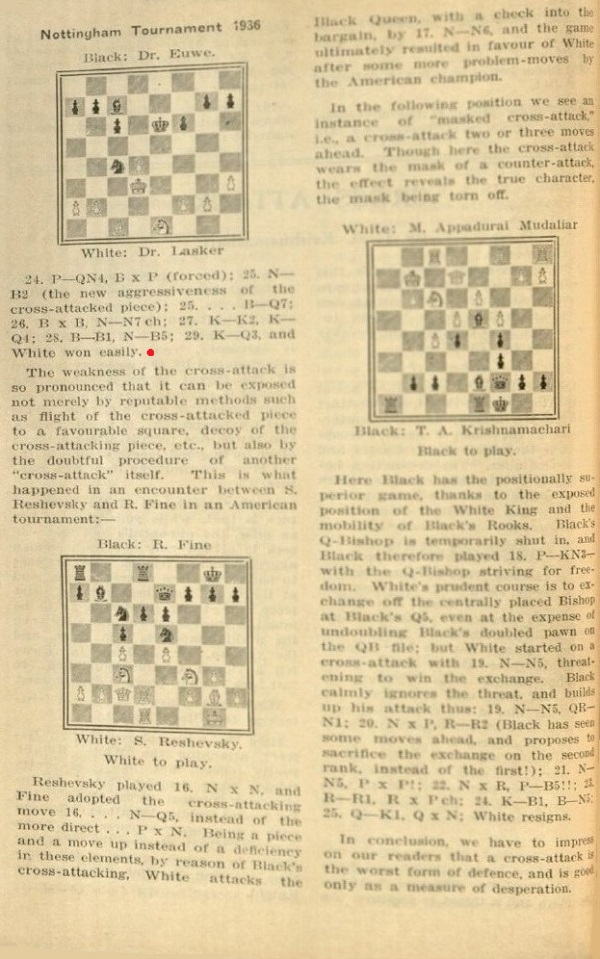
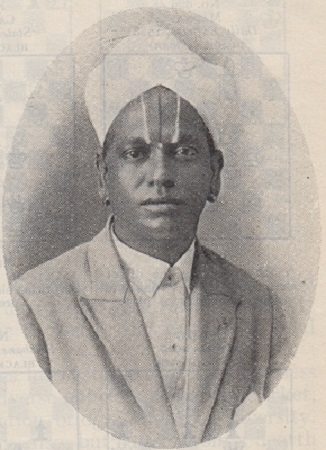
This photograph of T.A. Krishnamachari (also: Krishnamachariar) is taken from an article about him by T.R. Dawson on pages 31-32 of the January 1940 BCM. See too C.N. 3391 on pages 220-221 of Chess Facts and Fables, and the entry on pages 214-215 of Indian Chess History 570 AD-2010 AD by Manuel Aaron and Vijay D. Pandit (Chennai, 2014).
(11020)
A book of truly exceptional quality has just arrived: Emanuel Lasker edited by Richard Forster, Michael Negele and Raj Tischbierek:

A beautiful 450-page hardback, entirely in English, it is the first volume in a trilogy adapted from, and expanding on, Emanuel Lasker Denker Weltenbürger Schachweltmeister edited by Richard Forster, Stefan Hansen and Michael Negele (Berlin, 2009).
We are grateful to the Editors for permission to show here three photographs which they obtained from the collection of the late Lothar Schmid:

Page XIV: Emanuel Lasker, circa 1897
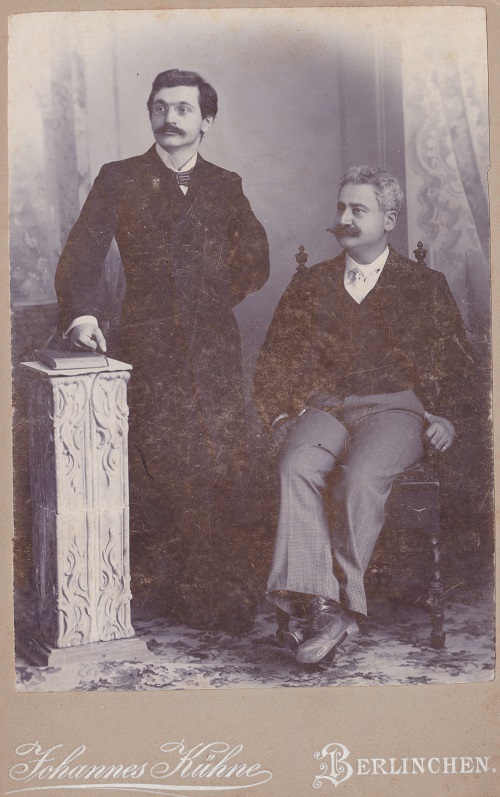
Page 186: Emanuel Lasker ‘probably with his father Michaelis Aron’, 1899
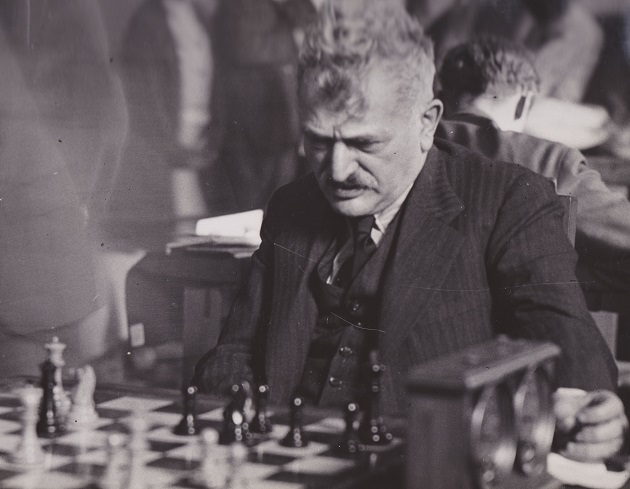
Page 140: Emanuel Lasker (first-round game against Reuben Fine, Nottingham, 1936).
(11070)
Just received: volume two of Emanuel Lasker edited by Richard Forster, Michael Negele and Raj Tischbierek (Berlin, 2020):
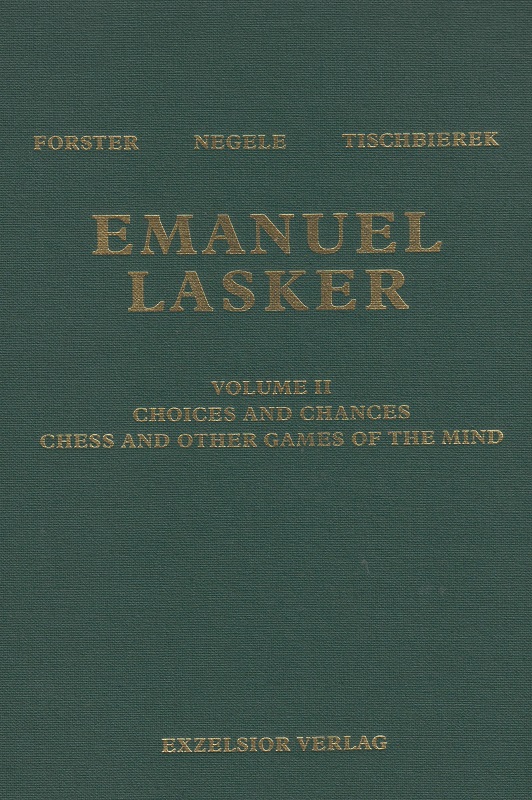
The publisher’s webpage presents an extract from this superb volume, as well as ordering details; the book will also be obtainable from McFarland & Company, Inc.
From the private archive of Christian Wohlfarth (Berlin) we reproduce with the Editors’ permission a photograph of Lasker playing Go which is on page 164 of volume two:
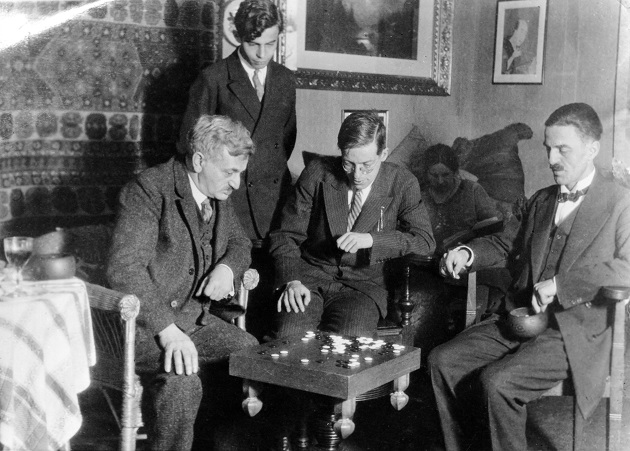
The caption states that Lasker’s opponent was Felix Dueball, at whose residence the picture was taken on 7 March 1930. His eldest son Fritz is standing, and the man seated in the centre is Kurt Rosenwald.
(11814)
Just received: the final volume in the Emanuel Lasker trilogy by Richard Forster, Michael Negele and Raj Tischbierek, published by Exzelsior Verlag, Berlin, with a Foreword by John Nunn.
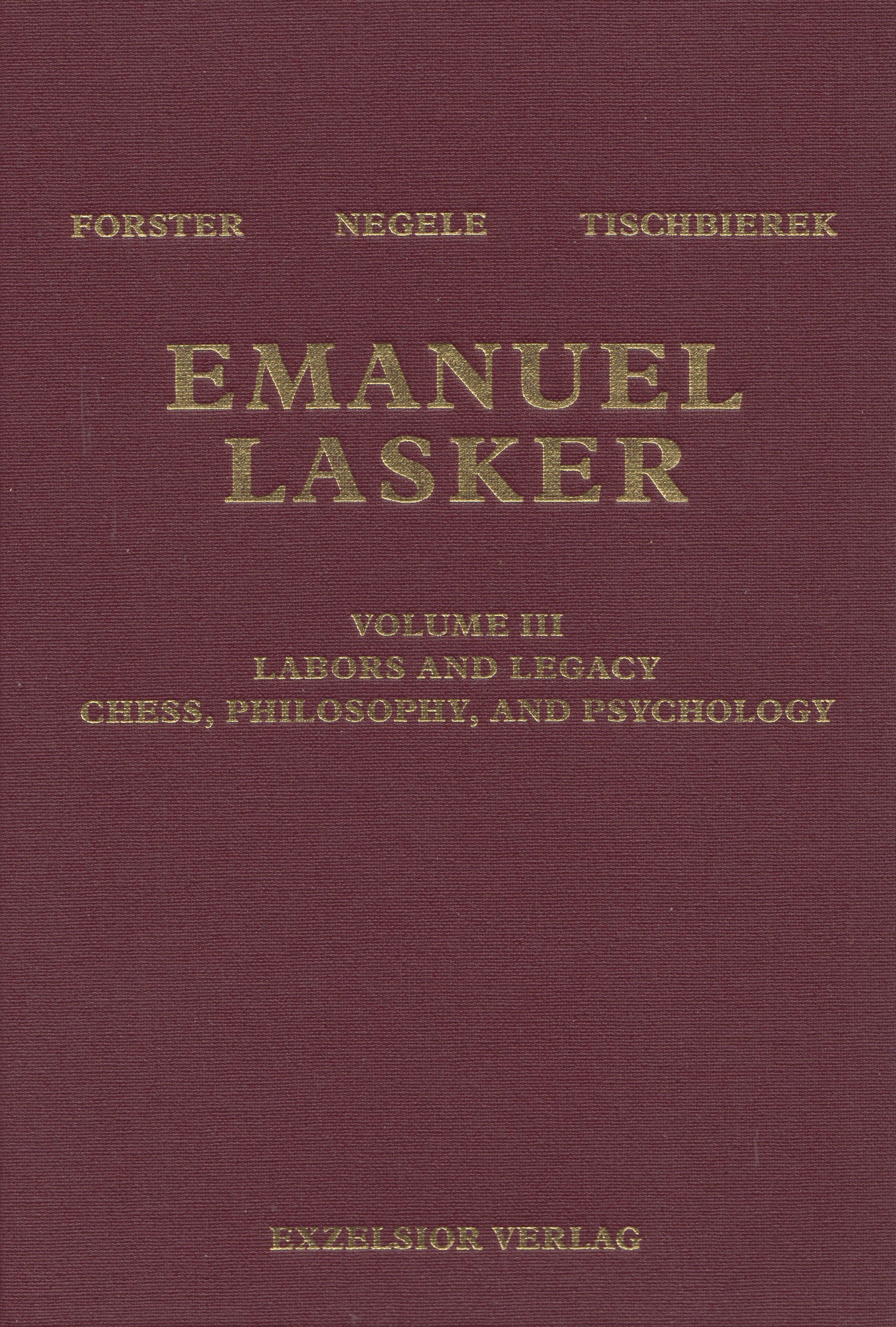
Extracts are available on-line, and the book may be ordered direct from the publisher’s webpage, although some readers outside Europe may prefer to use the McFarland page.
Below are four photographs of Lasker (on, respectively, pages 125, 149, 196 and 220 of the book):
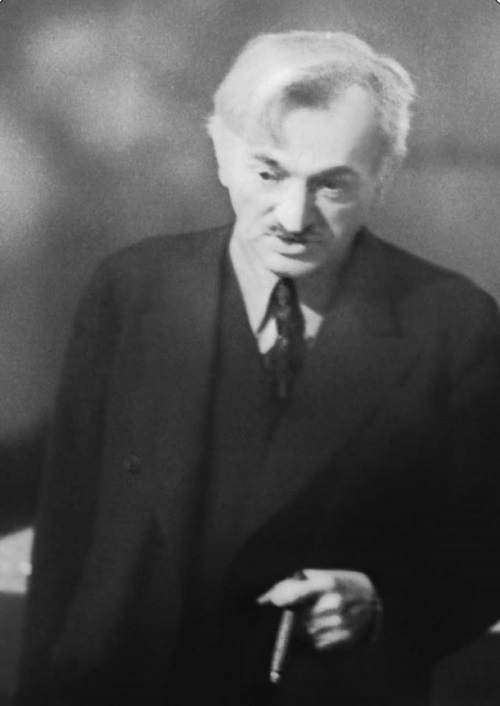
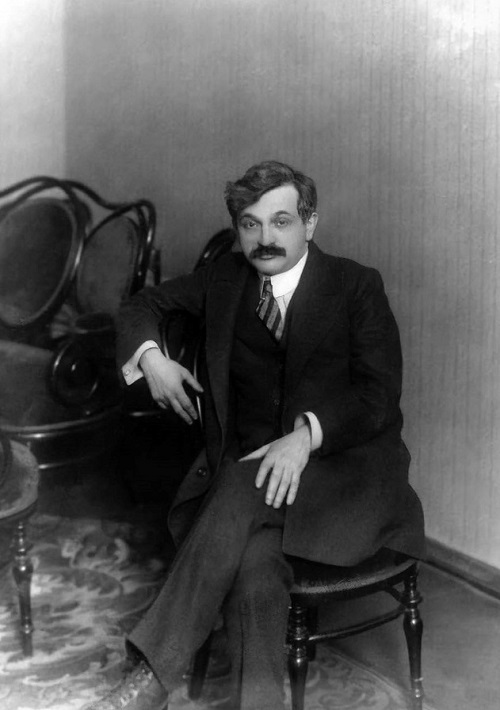
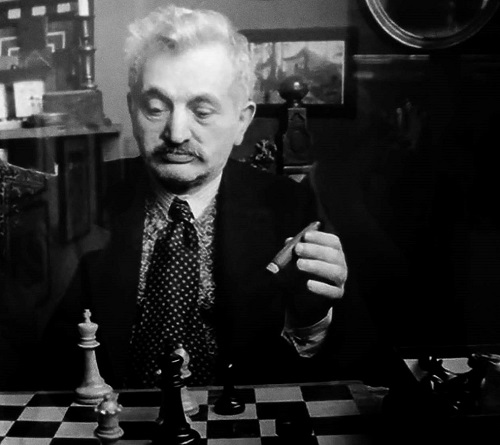

In common with its predecessors, this third volume is of superlative quality.
(11901)
From Lasker v Capablanca, Moscow, 3 June 1936:
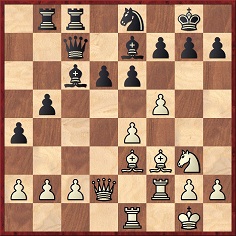
‘“What about the backward pawn?”, shrieks the pious student, brought up on sound positional principles. The answer is that there ain’t goin’ to be no backward pawn.’
That remark by C.J.S. Purdy was quoted on page 217 of The Immortal Games of Capablanca by Fred Reinfeld (New York, 1942) and on pages 259-260 of Capablanca’s Best Chess Endings by Irving Chernev (Oxford, 1978). Neither book mentioned the source: Purdy’s annotations on pages 283-284 of the Australasian Chess Review, 8 October 1936.
The game continued 20 Nh5 Qb7 21 Bg5 f6 22 Be3 Nc7 23 Qd1 Rd8 24 Rd2 Kh8 25 a3 Rbc8 26 Bf2 d5.
(11075)
Page 3 of The World Chess Championship: 1951 Botvinnik v Bronstein by William Winter and R.G. Wade (London, 1951):
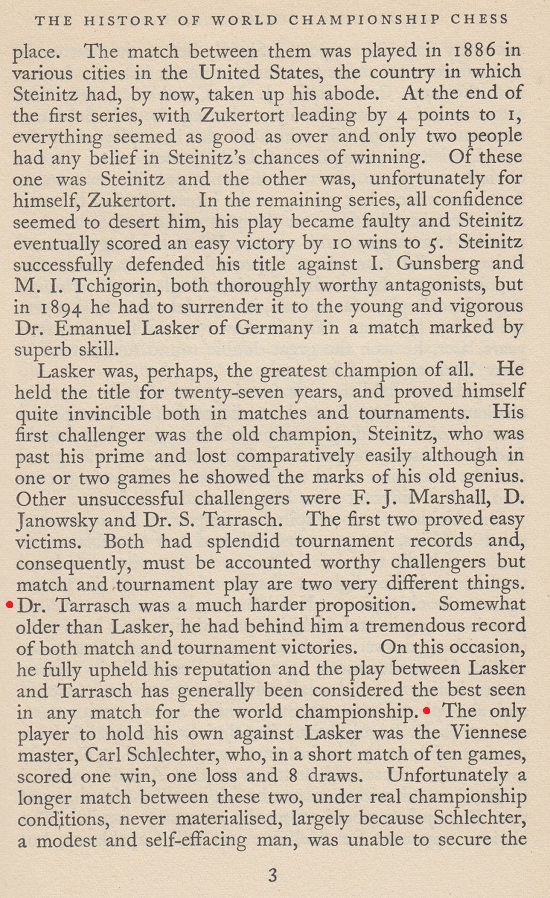
Given that Lasker defeated Tarrasch +8 –3 =5, this account seems generous to Tarrasch. As regards the quality of play, James Mortimer expressed a different view on page 8 of the Daily Mail, 15 September 1908:
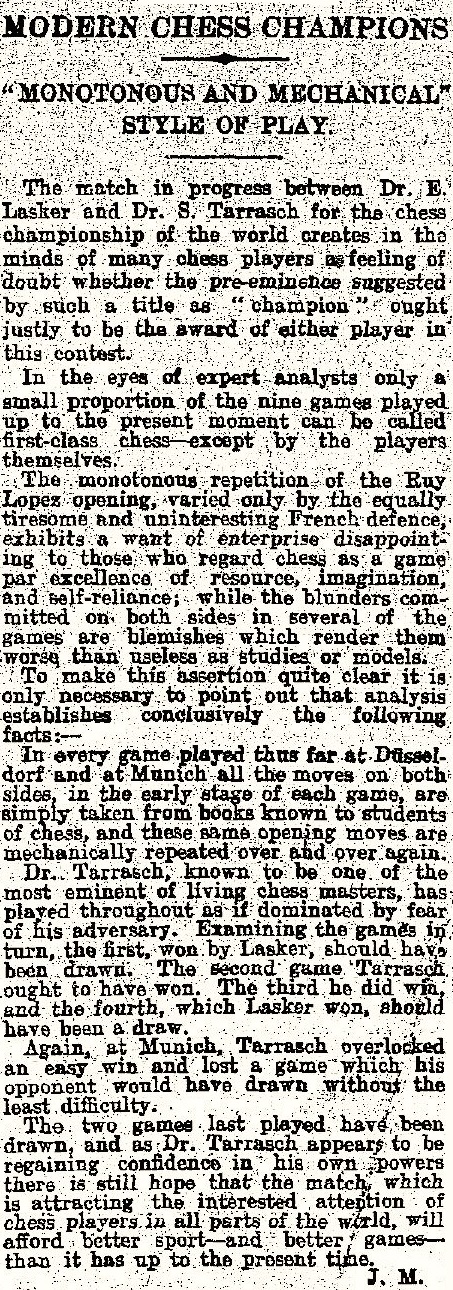
(11094)
From pages 486-487 of the November 1908 BCM:
‘Thus the match, which the German Schachbund took such pains to bring about, was veritably an encounter of giants, and justified the widespread interest that was taken in it. Surely never before has the daily press devoted so much attention to our game. All over the world – even in far-away Japan – the course of the match was followed with close interest, and no doubt the circle of chessplayers has been greatly widened by the unique advertisement thus given to the game.
Apart from the heavy monetary prize at issue, both players had a still greater incentive to exert their best efforts in the reputation that they staked. Until the verdict of an actual encounter with Tarrasch had been given, the German chess world was loth to concede the title of world champion to Lasker. To the majority of German chessplayers Dr Tarrasch appeared invincible, and it must be confessed he himself seemed to share the opinion. Lasker, of course, had the glory and the pecuniary value of his title to defend.’
(11145)
Everyman Chess has just brought out Lasker move by move by Zenón Franco (London, 2018):
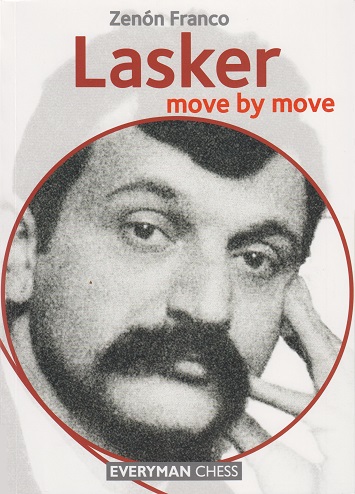
It arrived this morning, and we have not yet progressed beyond the desperately superficial bibliography on page 5 and the welter of unsourced quotes by and about Lasker on pages 9-12.
(11130)
Discussing the Lasker v Tarrasch world title contest, page 247 of the new Franco book has the phrase ‘the “Match of the Century”, as it was called at the time’.
Called by whom?
(11139)
Bob van de Velde (Amsterdam) draws attention to a passage about Emanuel Lasker in the 2010 novel Field Grey by Philip Kerr. Page numbers vary from one edition to another, but the text is at the start of the chapter entitled ‘Berlin, 1954’:
‘Most people go through life accumulating possessions. I seemed to have gone through mine losing them or having them taken away from me. The only thing I still had from before the war was a broken chess piece made of bone – the head of a black knight from a Selenus chess set. During the last days of the Weimar Republic this black knight had been constantly in use at the Romanisches Café, where, once or twice, I’d played the great Emmanuel [sic] Lasker. He’d been a regular at the café until the Nazis obliged him and his brother [sic – Berthold Lasker died in 1928] to leave Germany for ever, in 1933. I could still picture him crouched over a board with his cigarettes and cigars and his Wild West moustache. Generous to a fault, he would give out tips or play exhibitions for anyone who was interested; and on his last day in the Romanisches Cafe – he went to Moscow, and then to New York – Lasker presented everyone who was there to wish him goodbye with a chess piece from the café’s best set. I got the black knight. The way I’d been played over the years I sometimes think a black pawn would have been more appropriate. Then again, a knight, even a broken one, seems intrinsically more valuable than a pawn, which was probably why I tried so hard to keep it through one adversity after another.’
Why is it so hard to find photographs of the 1921 world championship match in Havana? There was no Cuban chess magazine at the time, and we have yet to locate pictures in the host country’s mainstream press.
(11095)
From page 344 of The Jew in American Sports by Harold U. Ribalow (New York, 1959):
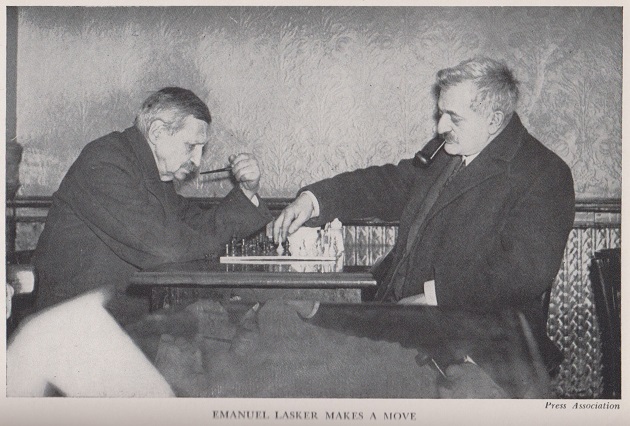
Who was Lasker’s opponent?
(11119)
A paragraph from page 368 of Lasker’s Manual of Chess (New York, 1927), in the chapter entitled ‘Final reflections on education in chess’:
‘Most chessplayers slowly climb to a certain rather low level and stay there. Of players to whom a master can give the odds of the queen there are millions; players of greater skill count probably no more than a quarter of a million. If we reckon the number of rook-odds players as a hundred and fifty thousand, of knight-odds players as fifty thousand, of pawn and two-move odds players as forty thousand, of pawn and move odds players as nine thousand, and the number of those to whom no master can allow odds as one thousand, we are likely not to be far wrong.’
The wording was slightly different on page 336 of the more readily available 1932 and 1947 editions, but the figures were the same.
(11147)
More figures advanced in Lasker’s Manual of Chess (New York, 1927), page 369:
‘In fact, there are a quarter of a million chess friends who devote to chess at least two hundred hours every year, and of these only a thousand, after a lifetime of study, attain the end. Without losing myself in calculations, I believe I am safe in voicing the opinion that our efforts in chess attain only a hundredth of one per cent of their rightful result.’
(11196)
See How Many People Play Chess?
Two books by Edward Lasker quoted a conversation with Janowsky in Berlin in 1910, at the time of the latter’s world title match against Emanuel Lasker.
From page 101 of The Adventure of Chess (New York, 1950):
‘Instead of admitting that he spent his nights at roulette, he said to me one day: “I don’t think I will win a game in this match. Lasker plays too stupidly for me to look at the board with any interest.”’
From page 115 of Chess Secrets I Learned from the Masters (New York, 1951):
‘After losing the first three games of the match, he said to me: “Your namesake plays such stupid chess that I simply cannot look at the board while he is thinking. I am afraid I shan’t do well in this match at all.”’
Edward Lasker’s statements on chess history require caution. For example, page 101 of The Adventure of Chess placed both of the longer Lasker v Janowsky matches in Berlin. On that point, page 88 of Chess Secrets I Learned from the Masters was correct (the former ‘took place in Paris in the fall of 1909’) but wrongly asserted that it was for the world title.
(11155)
See Lasker v Janowsky, Paris, 1909.
From page 101 of Lasker’s Manual of Chess (New York, 1927):
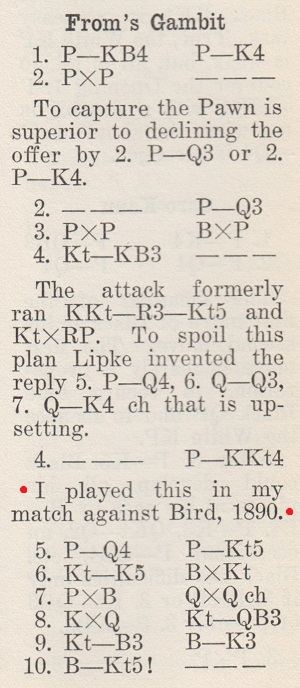
The text appears towards the end of the Second Book; page numbers vary in other editions.
Jean-Pierre Rhéaume points out that the game in question which began 1 f4 e5 2 fxe5 d6 3 exd6 Bxd6 4 Nf3 g5 occurred in the second Lasker v Bird match, i.e. in 1892 and not 1890.
The score was given on pages 485-486 of H.E. Bird by Hans Renette (Jefferson, 2016), with these notes by Steinitz from page 22 of the New York Daily Tribune, 25 September 1892:

Notwithstanding what appears in some publications and databases, the game continued until move 63, as reported in many contemporary sources, such as page 5 of The Scotsman, 31 August 1892 and page 12 of Lasker’s London Chess Fortnightly, 1 September 1892. The concluding moves (after 42...Bxh1) have not been found.
Page 68 of the recent Zenón Franco book on Lasker (C.N.s 11130, 11139 and 11140) has ‘40 Bb6 Bd5! 0-1’. As regards the opening, page 61 states:

The misspelling ‘Fromm’ is common, but the player’s name is not in doubt: Martin From (1828-95).
Some articles on the opening:
(11174)
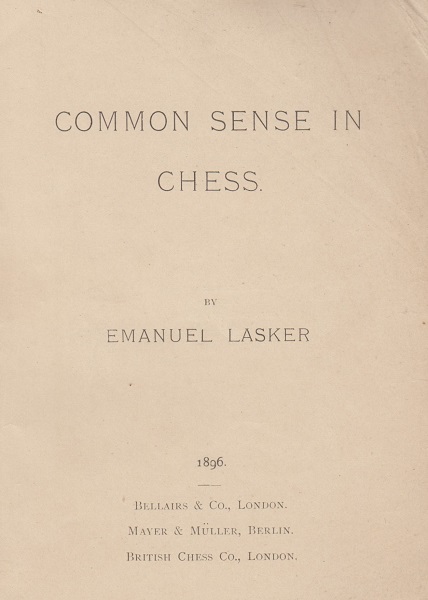
Pages 60-61 of Common Sense in Chess by Emanuel Lasker (London, 1896):
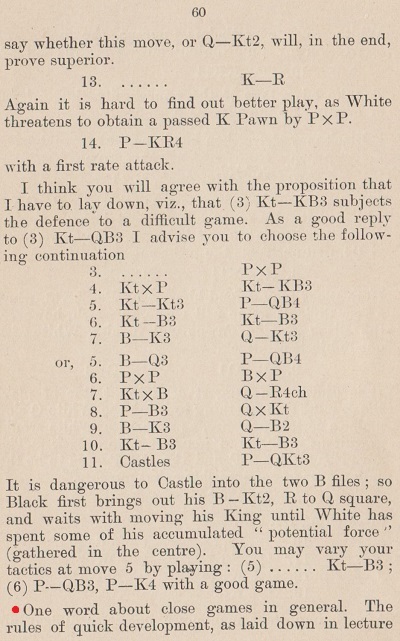
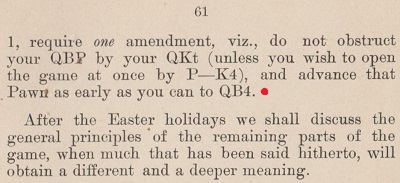
On page 36 of Chess Treasury of the Air by Terence Tiller (Harmondsworth, 1966) Harry Golombek quoted the marked paragraph and contended:
‘This sentence alone contains more instruction than many a book that we see turned out by the dozen nowadays.’
(11179)
From pages 102-103 of Schachjahrbuch 1922 by Ludwig Bachmann (Ansbach, 1924):
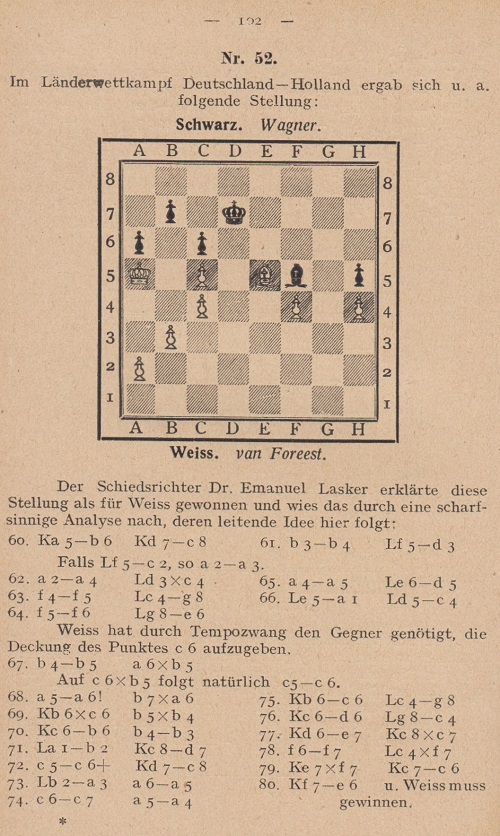

(11185)
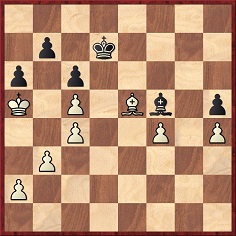
White to move
This position from a game between A. van Foreest and H. Wagner in an international team match was analyzed by Emanuel Lasker as a win for White.
W. John discussed the match on pages 121-123 of the June 1922 Deutsche Schachzeitung, with, at the bottom of page 122, a reference to Lasker’s analytical work:
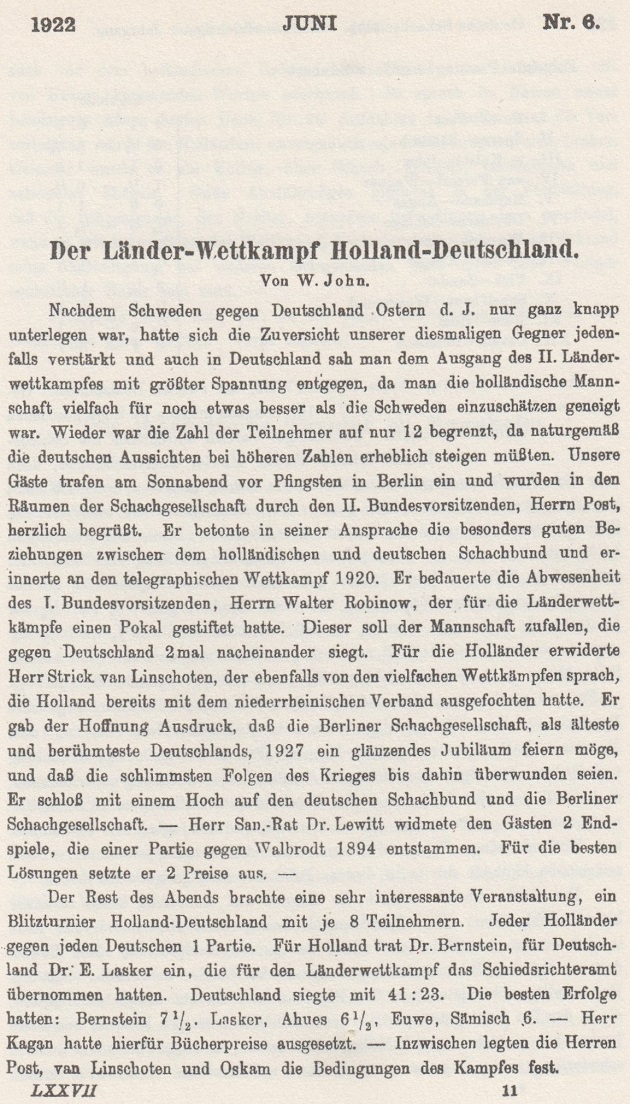
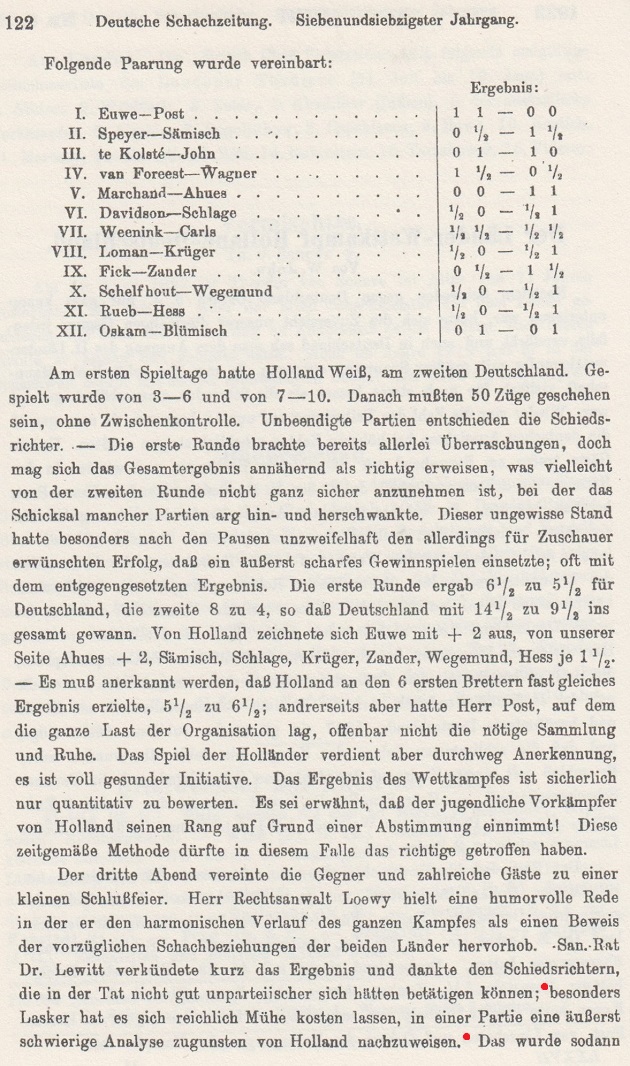
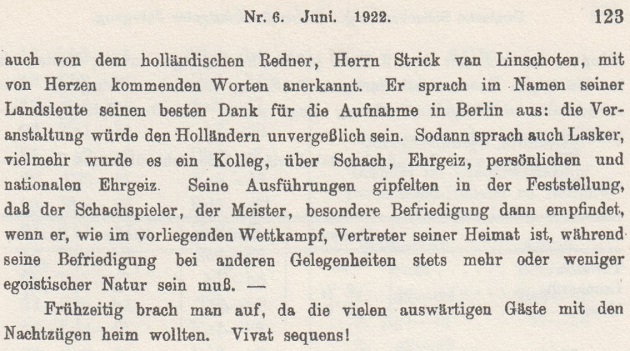
The Deutsche Schachzeitung did not give the game-score, but it was published on pages 127-128 of Deutsches Wochenschach, 18 June 1922:

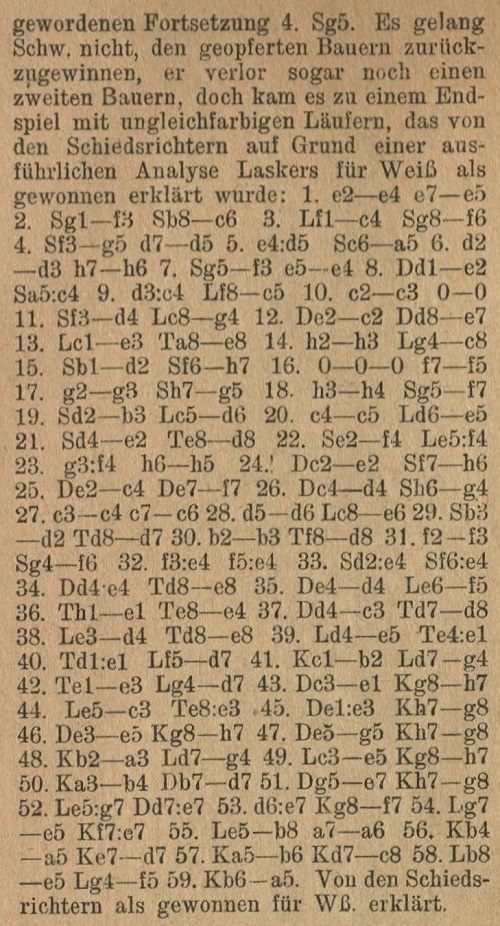
The game is also on pages 151-152 of the June 1922 Tijdschrift van den Nederlandschen Schaakbond, with a reference to analysis by Bernstein as well as Lasker:
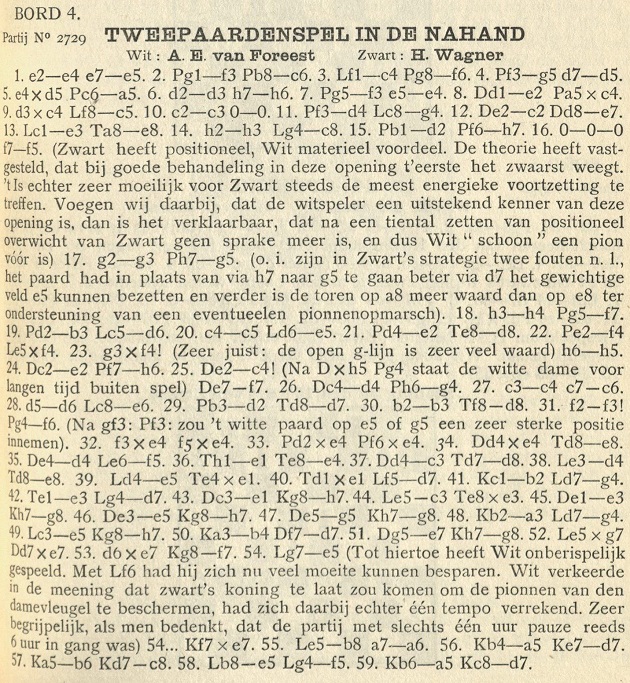
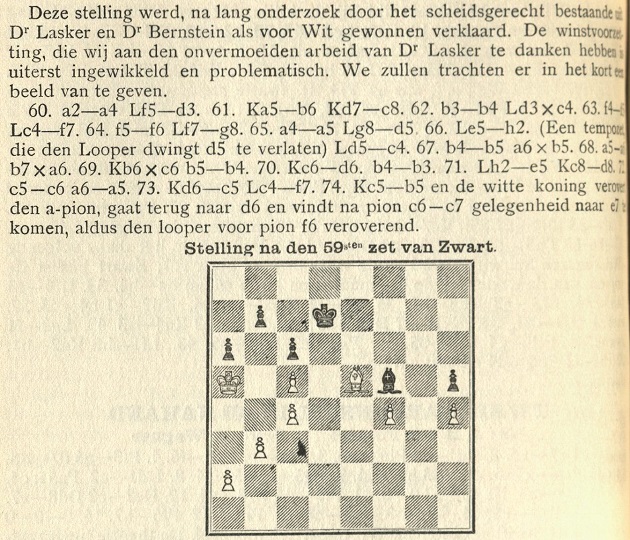
The pages from Deutsches Wochenschach and Tijdschrift van den Nederlandschen Schaakbond are reproduced courtesy of the Cleveland Public Library.
The full game: 1 e4 e5 2 Nf3 Nc6 3 Bc4 Nf6 4 Ng5 d5 5 exd5 Na5 6 d3 h6 7 Nf3 e4 8 Qe2 Nxc4 9 dxc4 Bc5 10 c3 O-O 11 Nd4 Bg4 12 Qc2 Qe7 13 Be3 Rae8 14 h3 Bc8 15 Nd2 Nh7 16 O-O-O f5 17 g3 Ng5 18 h4 Nf7 19 N2b3 Bd6 20 c5 Be5 21 Ne2 Rd8 22 Nf4 Bxf4 23 gxf4 h5 24 Qe2 Nh6 25 Qc4 Qf7 26 Qd4 Ng4 27 c4 c6 28 d6 Be6 29 Nd2 Rd7 30 b3 Rfd8 31 f3 Nf6 32 fxe4 fxe4 33 Nxe4 Nxe4 34 Qxe4 Re8 35 Qd4 Bf5 36 Rhe1 Re4 37 Qc3 Rd8 38 Bd4 Rde8 39 Be5 Rxe1 40 Rxe1 Bd7 41 Kb2 Bg4 42 Re3 Bd7 43 Qe1 Kh7 44 Bc3 Rxe3 45 Qxe3 Kg8 46 Qe5 Kh7 47 Qg5 Kg8 48 Ka3 Bg4 49 Be5 Kh7 50 Kb4 Qd7 51 Qe7 Kg8 52 Bxg7 Qxe7 53 dxe7 Kf7 54 Be5 Kxe7 55 Bb8 a6 56 Ka5 Kd7 57 Kb6 Kc8 58 Be5 Bf5 59 Ka5 Kd7. Adjudicated a win for White.
For ease of reference, the feature on pages 102-103 of L. Bachmann’s Schachjahrbuch 1922 (C.N. 11175) is repeated here:


Richard Forster writes:
‘The analysis in the Schachjahrbuch and in the Dutch magazine differ, and it is possible that Lasker gave no concrete lines himself, but showed the general winning plan, which different editors then put into different lines. Although both sets of analysis lead to a win, the best result comes from combining the two.
60 Kb6 Kc8 61 b4 Bd3 62 a4 Bxc4 63 f5 Bg8 64 f6 Be6 65 a5! Bd5
66 Bh2!
66 b5 axb5 leads nowhere, but now Black is in Zugzwang. After the move in the Schachjahrbuch (66 Ba1), Black could defend more tenaciously with 66...Kb8, forcing White to go for the Zugzwang with, for instance, 67 Bb2 Kc8 68 Be5.
66...Bc4 67 b5! axb5
67...cxb5 68 c6 bxc6 69 Kxa6 c5 70 Kb6 also wins for White. The try 67...Kd7!? 68 bxc6+ bxc6 leads to a technically lost position after 69 f7 Ke7 70 Kxc6 Bxf7 71 Kb6 Kd7 72 c6+! (but not 72 Kxa6?? Kc6).
68 a6 bxa6 69 Kxc6 b4 70 Kd6!
White does not need the king manoeuvre to b6 or b5 (which is given in both sets of analysis, although at different points). Against the best defence, this would simply lose time. The king belongs on d6.
70...b3 71 Be5 Kd8 72 c6 a5 73 c7+ Kc8 74 Bb2 a4
75 Ba3!
The important last point. If White cashes in too early with 75 Ke7? Kxc7 76 f7 Bxf7 77 Kxf7, Black has 77...Kd6! and saves the game.
75...Bg8 76 Ke7 Kxc7 77 f7 Bxf7 78 Kxf7 Kc6
Thanks to 75 Ba3, Black does not have the square d6 for the king and must lose.
79 Ke6
White wins by picking up the queen’s-side pawns with his king.’
(11188)
Fabrizio Zavatarelli (Milan, Italy) points out a passage on page 16 of Why Lasker Matters by Andrew Soltis (London, 2005), in the game Lasker v Bauer, Amsterdam, 1889:

C.N. 11207 commented: ‘Specifying sources is not only an act of fairness to earlier writers but also a way of ensuring that relevant background information is known.’ Soltis did not name the researchers who found the 1867 and 1884 games (Owen Hindle and Richard Forster respectively) or, indeed, the author of Lasker’s Combination (Victor Charushin). The assertion by Soltis that the Burn v Owen game was ‘little known until mentioned in the British Chess Magazine in 2003’ is incorrect (see C.N. 11207).

In the above position Lasker, against Bauer, played 15 Bxh7+, and Steinitz wrote on page 268 of the September 1889 International Chess Magazine:
‘The beginning of a most profound and elegant combination.’
Page 354 of the September 1889 BCM had Lasker as the loser:
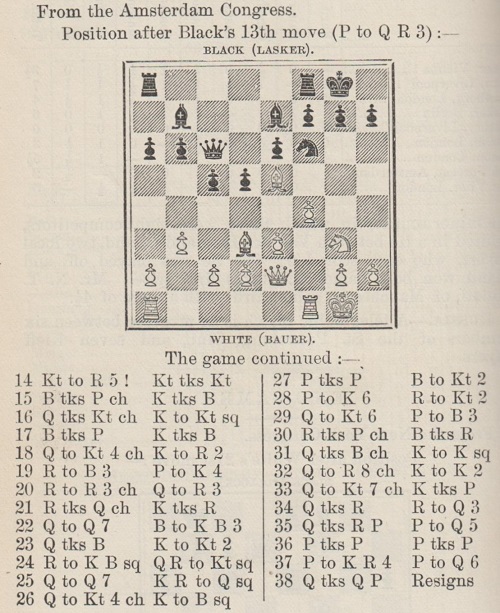
(11211)
See too The Double Bishop Sacrifice.
From Gaffes by Chess Publishers and Authors:
Horacio Paletta (Buenos Aires) points out that the spine of El sentido común en ajedrez by Emanuel Lasker (Barcelona, 1971) misspells común:
Alekhine made some notable comments about chess psychology, including a reference to Lasker, on page 150 of his book Das New Yorker Schachturnier 1927 (Berlin, 1928):

(11239)
See Chess and Psychology.
From page 75 of the February 1938 BCM:
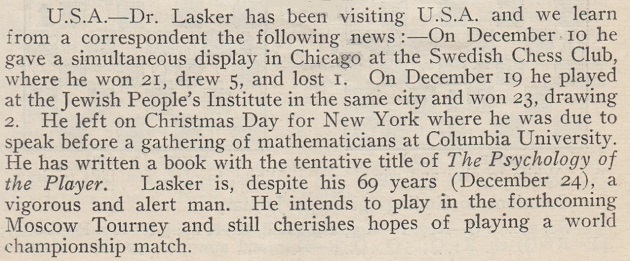
The ‘forthcoming Moscow Tourney’ had been mentioned on page 23 of the January 1938 issue in the section on news from Russia:
‘A grand master tournament is being planned to take place here in February. Amongst those invited will be Euwe, Lasker, Capablanca and even Alekhine.’
(11240)
This interview was published on page 5 of the El Paso Times, 29 March 1926:

(11241)
From Chess and Jews:
An article by Emanuel Lasker, ‘Jude, wohin?’ on page 1 of Aufbau, 1 January 1939:
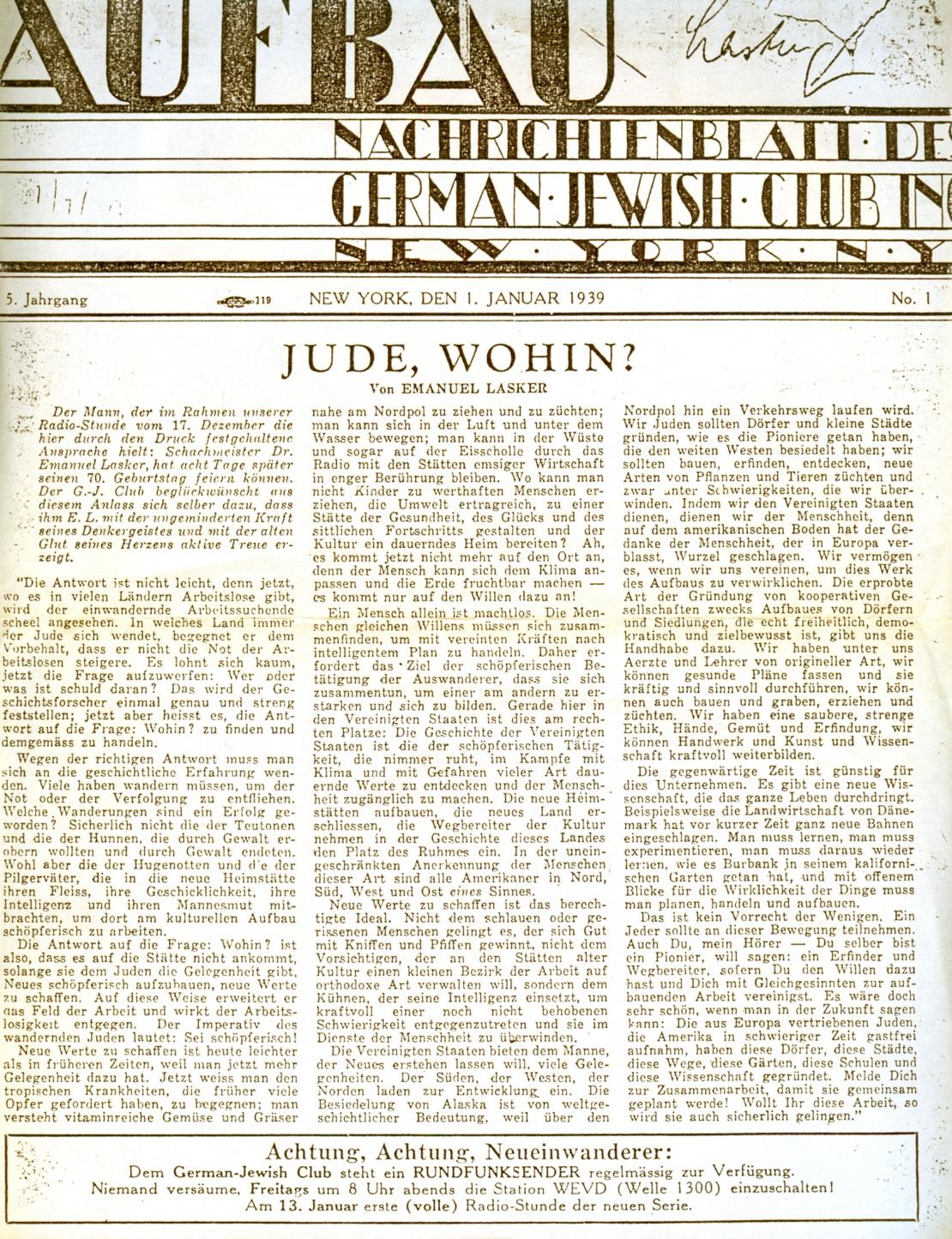
Can an authoritative explanation be found, or put together, concerning Emanuel Lasker’s absence from London, 1922?
(11277)
Plans to hold an international tournament in London were reported on page 12 of The Times, 19 September 1921:
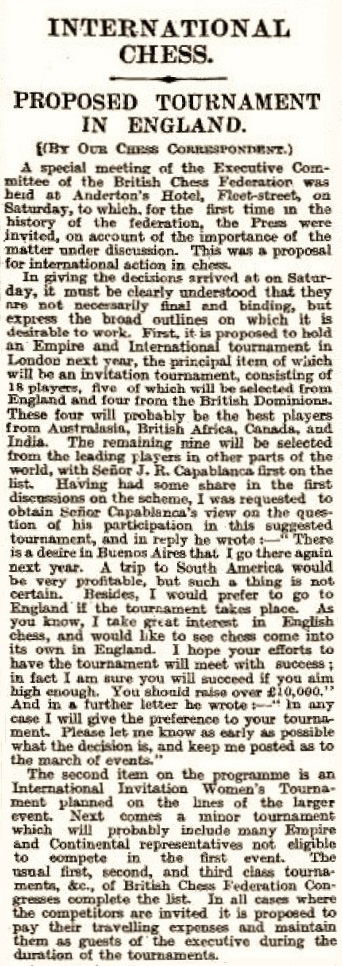
A similar account was on page 362 of the October 1921 BCM:

A tentative list of participants was published on page 195 of the Chess Amateur, April 1922:
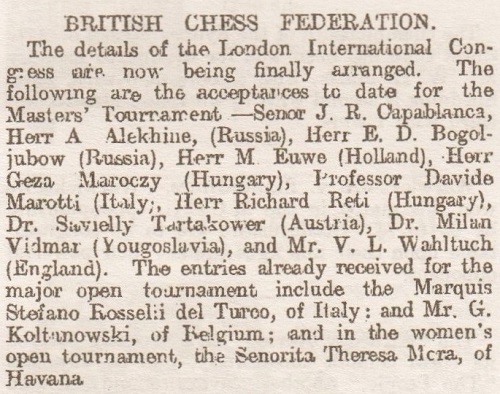
From page 258 of the June 1922 edition:
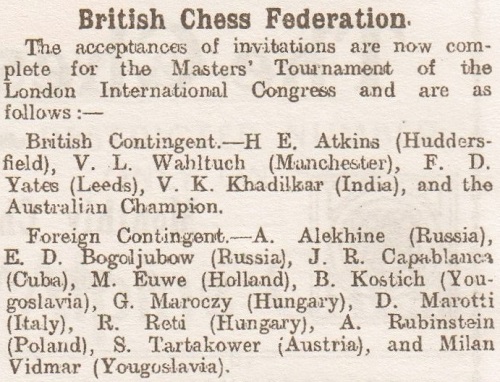
Neither V.K. Khadilkar nor B. Kostić participated. Regarding the former, page 14 of The Times, 31 July 1922 reported:
‘Znosko-Borovsky takes the place of the Indian Champion, V. Khadilkar, who found himself unable to make the journey to England.’
The name of J.S. Morrison of Canada was added in a report on page 5 of The Times, 26 June 1922:
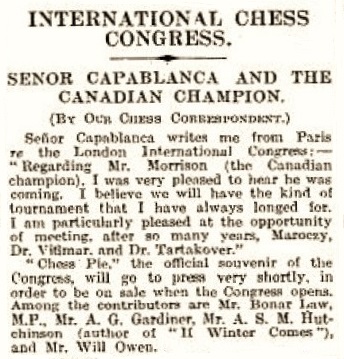
Most British reporters wrote about the tournament as if German chess did not exist, although two BCM issues in 1922 carried reports in the ‘Colonial and Foreign News’ section, under the heading ‘Germany’, about Lasker’s non-participation in London, 1922:
July 1922, page 273:
‘In connection with the proposed quadrangular tournament in Hastings between Capablanca, Lasker, Alekhine and Rubinstein, the Deutsches Wochenschach remarks that in Hastings they appear to be more open-minded than in Chauvinistic London! The DW does not propose to report the London tournament.’
August 1922, page 307:
‘The Deutsches Wochenschach has reconsidered its decision not to report the London Congress, influenced by the fact of the invitation of Dr Lasker to Hastings, which, our contemporary says, shows that the exclusion of German masters from the London Congress is a mistake for which the whole of England must not be held responsible.’
It will be borne in mind that after Lasker wrote a series of nationalistic/patriotic/jingoistic articles about the Great War in the Vossische Zeitung from 16 August to 25 October 1914, he was strongly criticized in England, and especially in the Chess Amateur. See C.N. 3272, reproduced on page 211 of Chess Facts and Fables.
Pages 277-279 of the April-June 1927 Kagans Neueste Schachnachrichten reproduced a statement by Lasker from the Essener Zeitung of 21 December 1926. His explanation as to why he would not be participating in New York, 1927 included the following about his absence from London, 1922 (and Hastings, 1922):

Another version of such remarks by Lasker was given on page 195 of our book on Capablanca.
In an endnote on pages 319-320 we quoted from Brian Harley’s column on page 19 of the Observer, 26 March 1922:
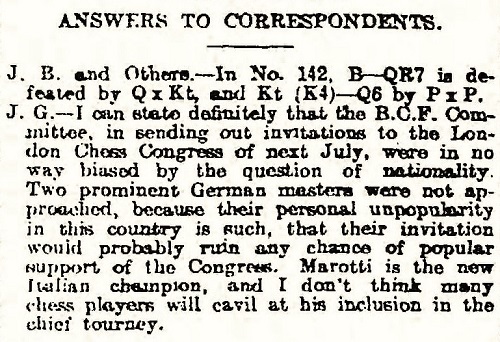
On page 8 of the 23 July 1922 edition of the Observer, in a column by Harley entitled ‘Capablanca and his rivals’, there was a rare reference to Lasker by name in connection with London, 1922:
‘In the Masters’ Tourney we have the world champion, Capablanca, most of the other great foreign experts (with Lasker a conspicuous exception) and six representatives of the British Empire.’
Further details are still sought concerning the basis on which invitations to London, 1922 were, or were not, extended, and especially with regard to Lasker and Tarrasch.
(11284)
Noting that the Argentinian weekly magazine Caras y Caretas is available via the digital collection of the Biblioteca Nacional de España, Olimpiu G. Urcan has forwarded these items:
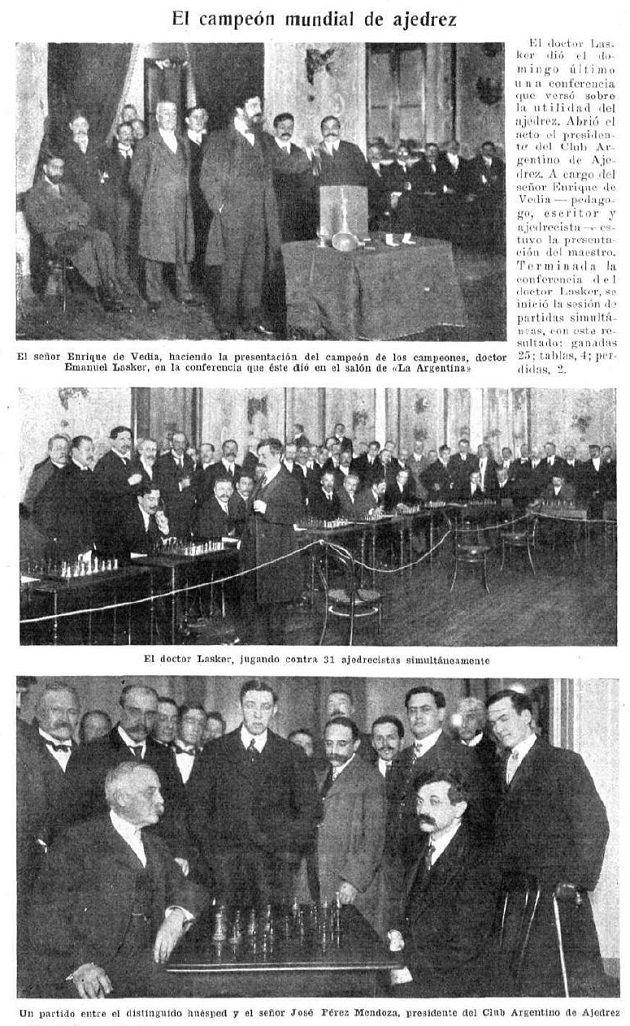
25 June 1910
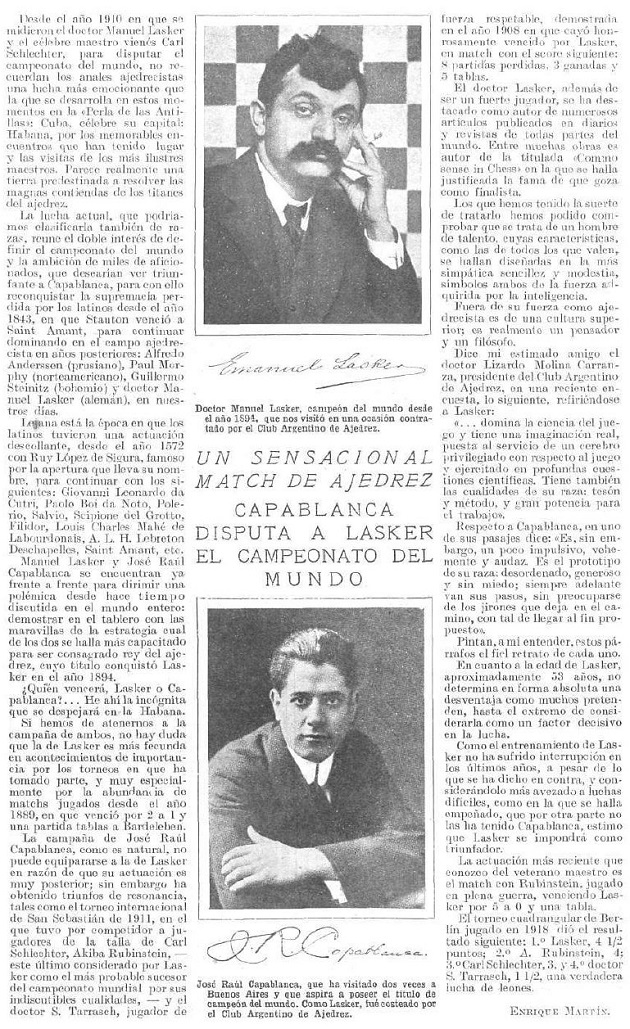
26 March 1921
(11318)
From page 189 of The Golden Treasury of Chess by Francis J. Wellmuth (Philadelphia and New York, 1943):
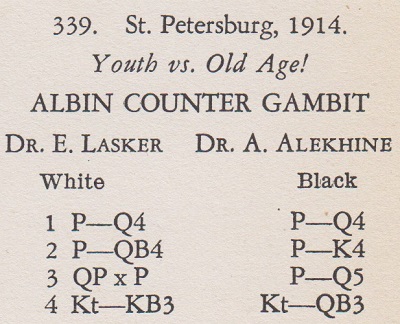
Lasker was aged 45.
The ‘Youth vs. Old Age!’ heading remained in Al Horowitz’s editions of the Treasury (game 190).
The annotations by Fred Reinfeld to Schlechter’s win over Alekhine at Carlsbad, 1911 concluded on page 120 of The Unknown Alekhine 1905-1914 (London and New York, 1949) with this remark:
‘For once, old age conquered youth.’
As pointed out in C.N. 643 (see page 147 of Chess Explorations), Schlechter was 37.
(11352)
Yandy Rojas Barrios (Cárdenas, Cuba) has provided an article by Juan Corzo y Príncipe, written after Emanuel Lasker announced his resignation as world champion, on pages 47 and 76 of Social, July 1920:
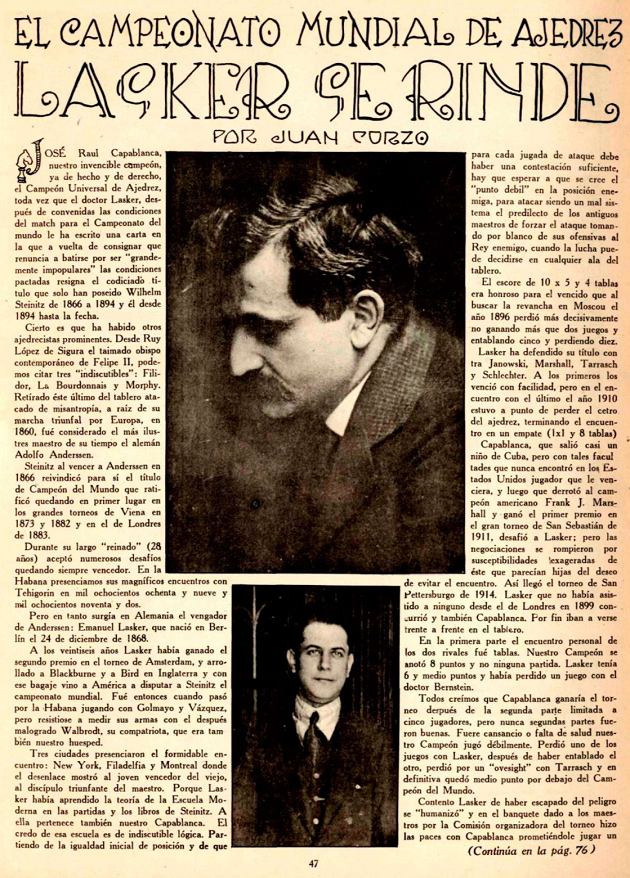
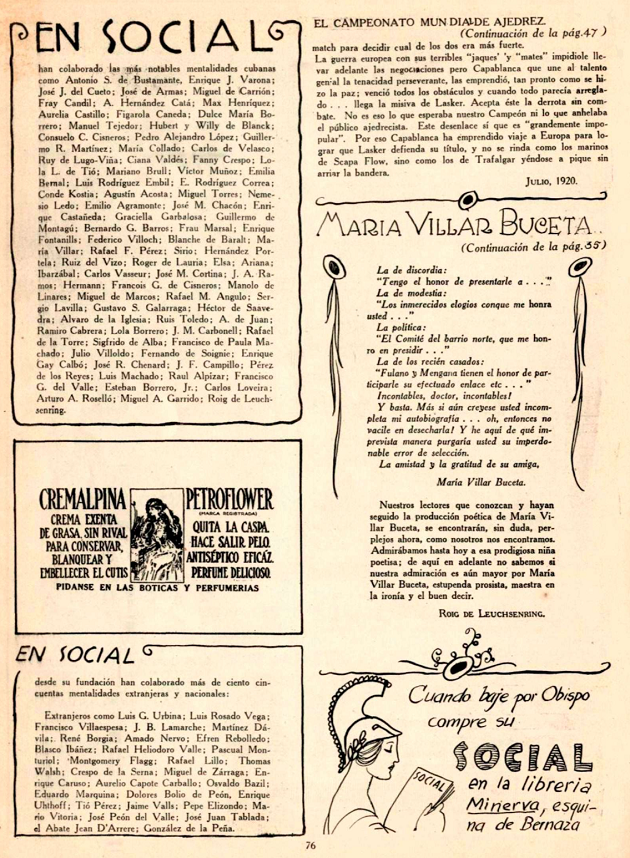
(11368)
From ‘My Encounters with Lasker’ by Ossip Bernstein on pages 202-204 of the July 1955 Chess Review:

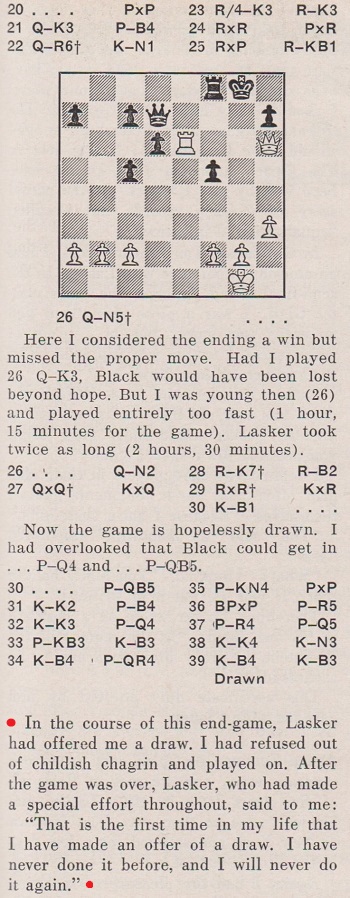
(11400)
From page 134 of The Human Side of Chess by Fred Reinfeld (New York, 1952), in the chapter on Emanuel Lasker:
‘He claimed that the climate had affected him adversely, whereas Capablanca’s praise of the climate sounded like plagiarism from a travel brochure. Who was right? Probably both men. The climate was probably unfavorable for a stranger, and an elderly man at that; and bearable to a native, who was 20 years younger.’
Lasker was aged 52 when he played the match, in March-April 1921. His remarks about the Cuban climate appeared in Mein Wettkampf mit Capablanca (Berlin and Leipzig, 1922), and two pages are shown here:


Those were the two pages specifically referred to by Capablanca in his response in 1922:
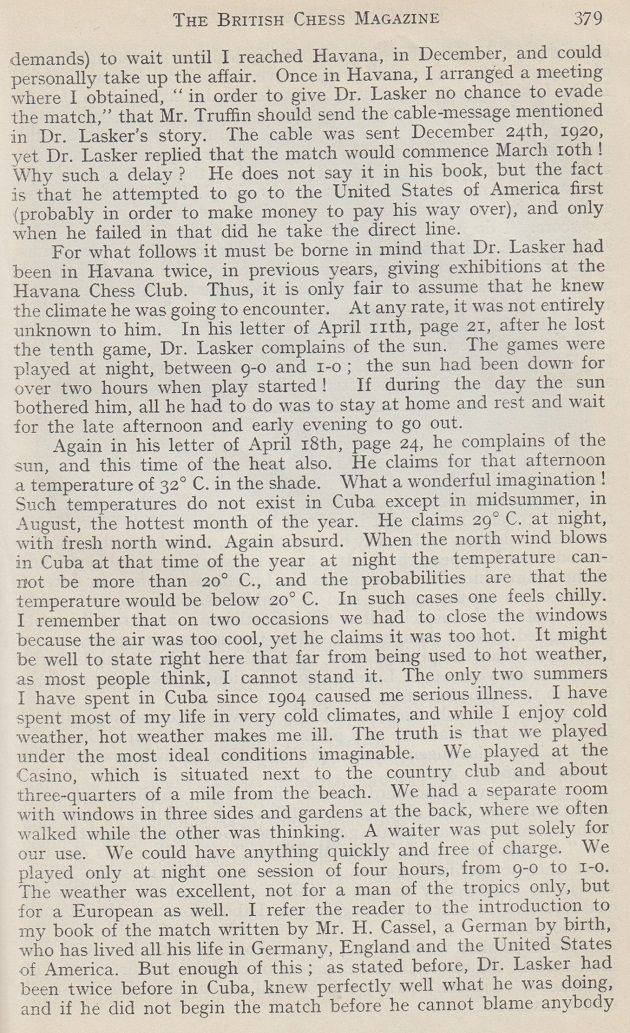
Capablanca’s Reply to Lasker has the full text, from pages 376-380 of the October 1922 BCM.
English versions of some despatches by Lasker from Havana were published in the Sunday Times in 1921 (see Lasker on the 1921 World Championship Match). He wrote a response to Capablanca’s BCM article, but the magazine refused to publish it (see page 37 of the February 1927 American Chess Bulletin).
In the archives of the Climate Center of the Institute of Meteorology in Casablanca, Havana, Yandy Rojas Barrios (Cárdenas, Cuba) has found day-by-day and hour-by-hour data on the temperature, relative humidity and winds in the Cuban capital in March and April 1921. For example:
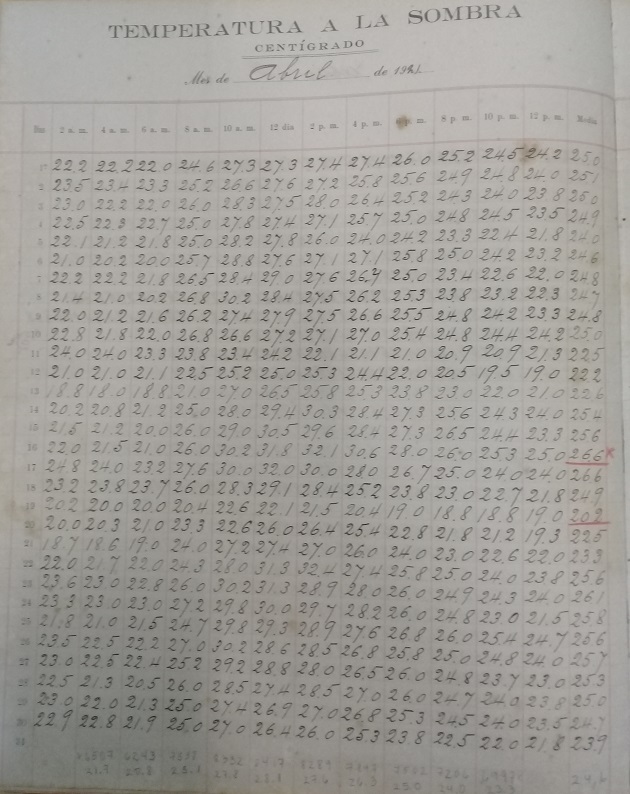
The set of eight tables has been added to the above-mentioned feature article Capablanca’s Reply to Lasker.
(11437)
From page 261 of the November 1936 Chess Review:
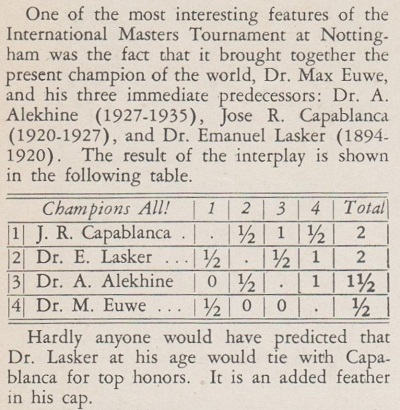
(11497)
This strange photograph on page 1 of Leninsky iskry, 6 January 1936 has been submitted by Yuri Kireev and Mikhail Sokolov (Moscow):
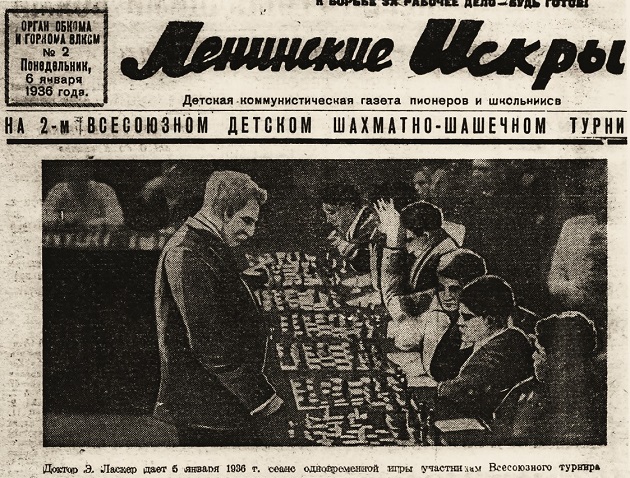
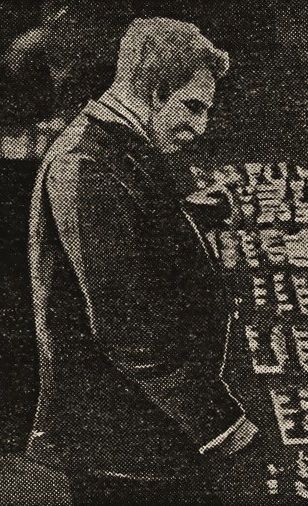
(15505)
Stefan Müllenbruck (Trier, Germany) sends a column relevant to two topics discussed in C.N.: the player who claimed never to have beaten a healthy opponent (pages 322-323 of Kings, Commoners and Knaves and C.N. 4189) and the ‘When I am White, ... when I am Black ...’ remark (C.N.s 5063, 9647 and 10407). Both observations were ascribed to Emanuel Lasker in a column by ‘Philidor’ (C.H.O’D. Alexander) on page 866 of The Spectator, 22 June 1956:

(11510)
An article about Lasker and phrenology on page 8 of the Pall Mall Gazette, 14 July 1899:

The article was featured on page 123 of the American Chess Magazine, September 1899. Regarding the sketches, see too C.N. 5729 and our feature article on London, 1899.
(11526)
From our archives:
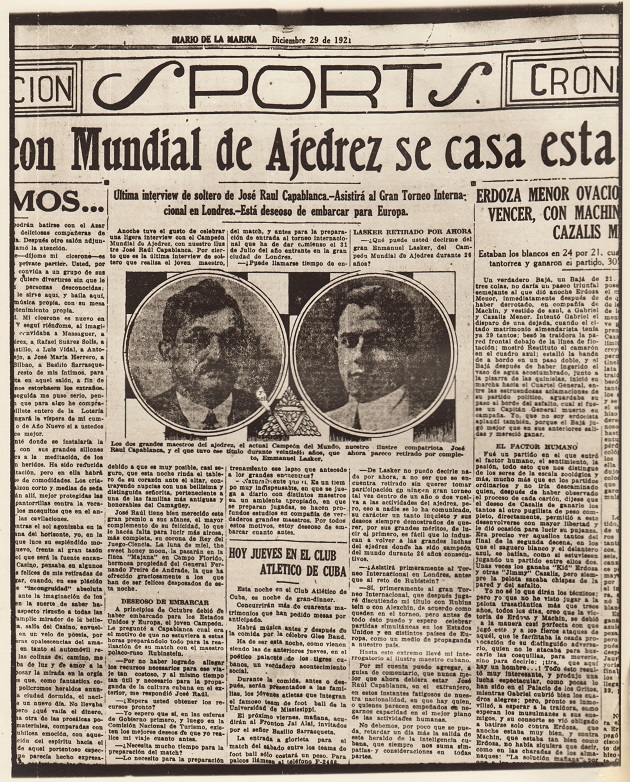
For a translation of the interview with Capablanca, see page 117 of our monograph on him.
(11560)
From the Sammlung Archiv für Kunst und Geschichte, Berlin, Olimpiu G. Urcan has obtained authorization for us to reproduce this photograph of Emanuel Lasker:
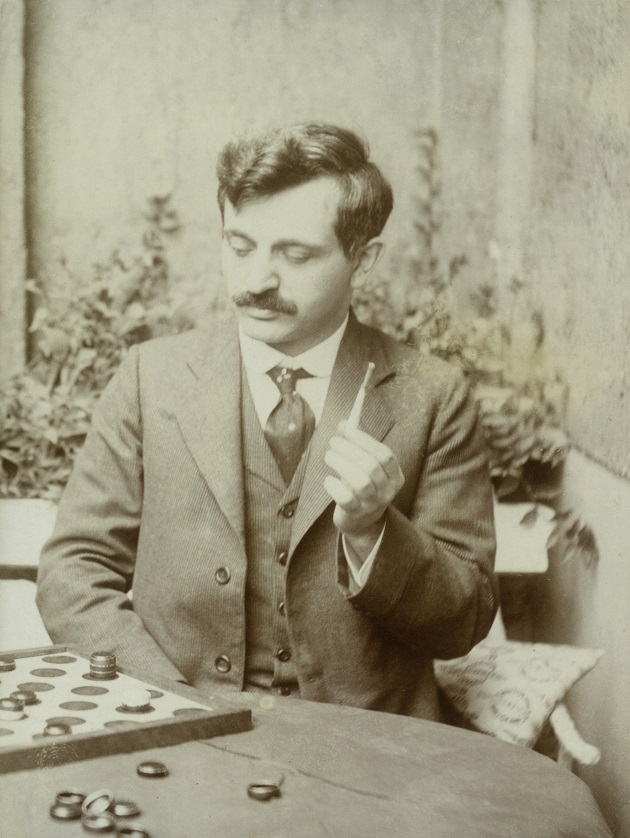
Pages 308-330 of Emanuel Lasker Denker Weltenbürger Schachweltmeister edited by Richard Forster, Stefan Hansen and Michael Negele (Berlin, 2009) consist of a chapter about Laska by Wolfgang Angerstein, with the following on page 308:
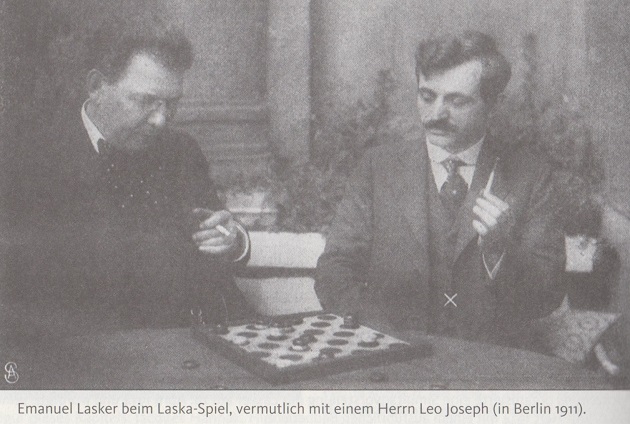
It will be noted that the identification of Lasker’s opponent as Leo Joseph is tentative. Page 1057 gives the source of the picture: Der Tag, 27 September 1911.
The Berlin Archives have only the Lasker part of the photograph.
(11567)
C.N. 11572 gave the full text of a report on page 2 of the Weston Mercury and Somersetshire Herald, 7 March 1908 of a visit to Weston-super-Mare by Emanuel Lasker. It included the following:
‘Dr Lasker is of Jewish extraction and, by way of preface, it may be mentioned that there is considerably more in that fact than would prima facie appear, for the championship in the king of games has been retained in Jewish hands for no less than 42 years, Steinitz holding it for 28 years until 1894, while the subject of the present notice has been champion ever since. Dr Lasker himself attributes predominance of the Jewish genius in chess to the fact that its rules are entirely based upon those of self-defence in the struggle for life, of which art Jews are adepts.’
From page 129 of The Chess Scene by David Levy and Stewart Reuben (London, 1974):

The unspecified source proves a disappointment: the alleged Tal remark is on page 44 of the End-October 1965 issue of CHESS, in an article by Dimitrije Bjelica. It follows a brief reference to Tal’s win against Héctor Rossetto at the 1958 Interzonal tournament in Portorož and begins, ‘“You play like Lasker”, we said to Tal ...’
There was a different wording on page 237 of Bjelica’s Grandmasters in Profile (Sarajevo, 1973): ‘They say that Lasker is going to lose in every other game, about me they say that I am going to lose in every one.’
(11585)
The front cover of the Cuban periodical Jaque Mate:
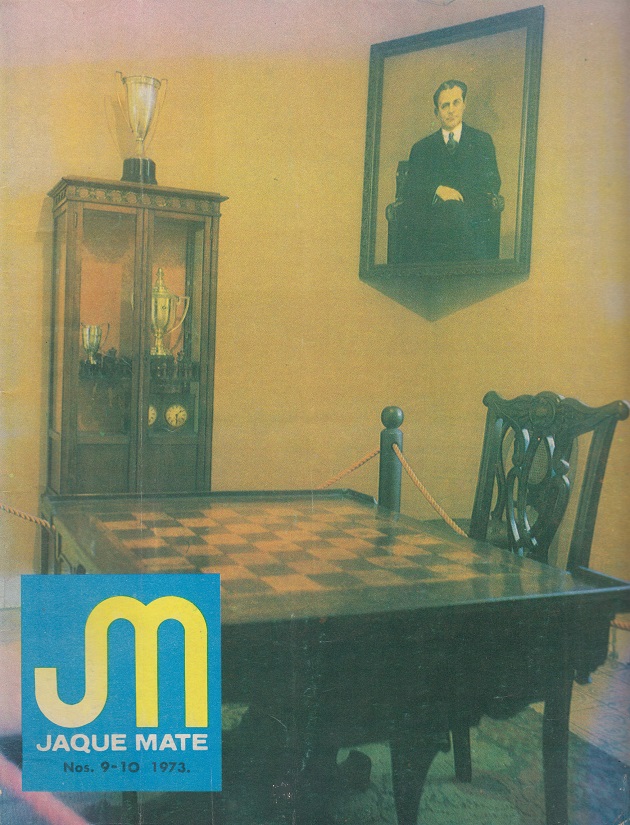
The photograph below, showing a commemoration of the 1921 world championship match, was taken at the National Museum of Sports, Havana by Bernardo Alonso García and was sent to us in 1994 by Armando Alonso Lorenzo:
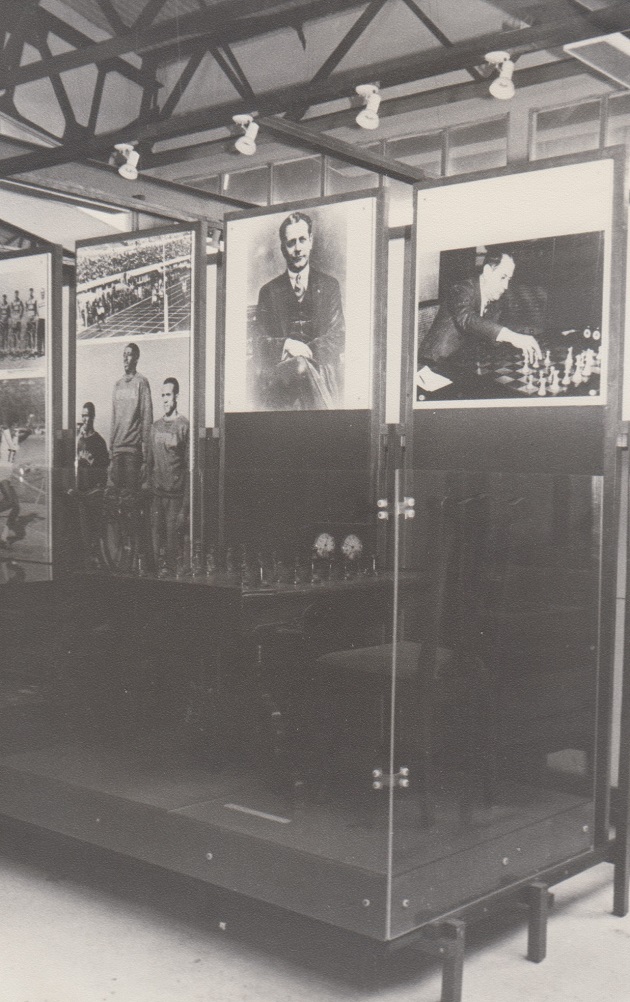
(11662)
From page 102 of Chess Memoirs by Joseph Platz (Coraopolis, 1979), in a section on Edward Lasker:
‘Martha Lasker, Emanuel’s wife, did not care too much for Edward and made no bones about it. She felt that Edward took undue advantage of the fact that his name was Lasker. In fact, in Germany, he had published a book under the name Dr E. Lasker, and that induced a book critic to write: “Another great book by the famous world champion”.’
We are aware of no grounds for the accusation. Two title pages:
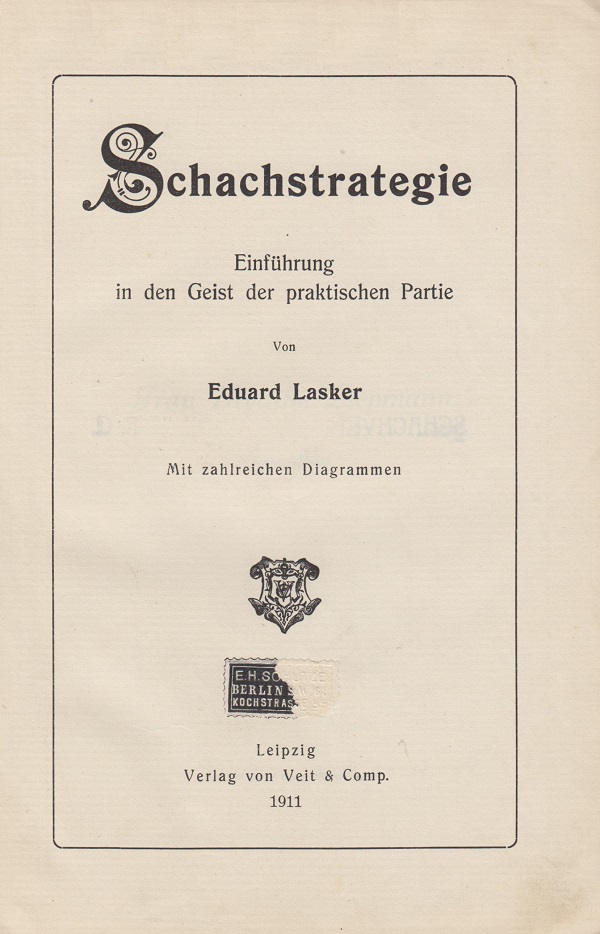
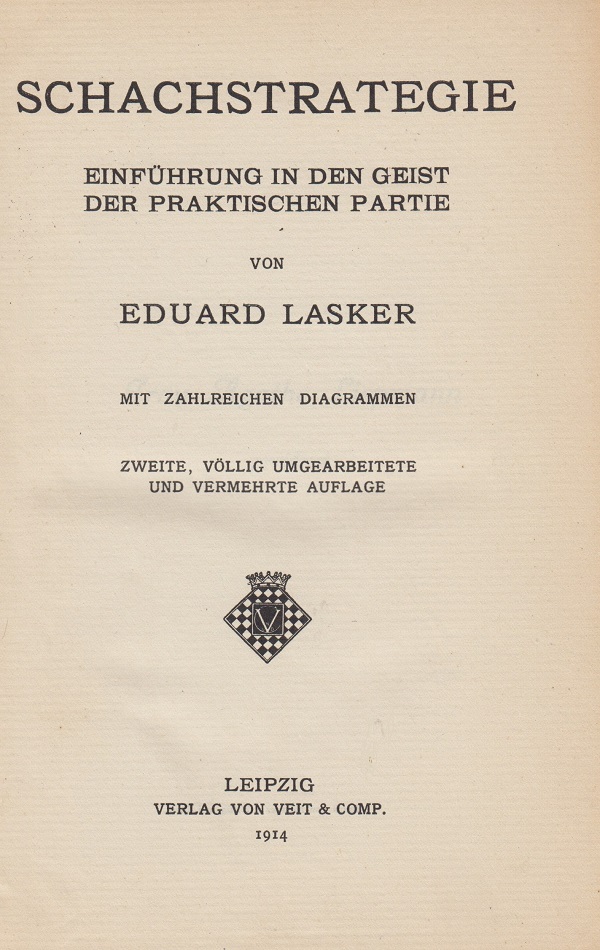
(11683)
Emanuel Lasker’s absence from New York, 1927 was due to a bitter dispute with the organizers of New York, 1924, and he issued a lengthy statement on the affair at the end of 1926. Much confusion and additional controversy arose because the text was published – in German, Dutch, Spanish and English – with many variants and discrepancies. Richard Forster has sifted through all available versions of the statement in a special article presented here: Lasker Speaks Out (1926).
(11704)
Under the title ‘Attempts to strip Lasker’, C.N. 3272 quoted this paragraph by A.J. Neilson in the Falkirk Herald (14 February 1917, page 4) which was reproduced on page 162 of the March 1917 Chess Amateur:
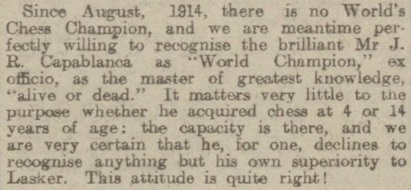
C.N. 3272 is on page 211 of Chess Facts and Fables and in Patriotism, Nationalism, Jingoism and Racism in Chess.
The frontispiece to the August 1909 BCM:
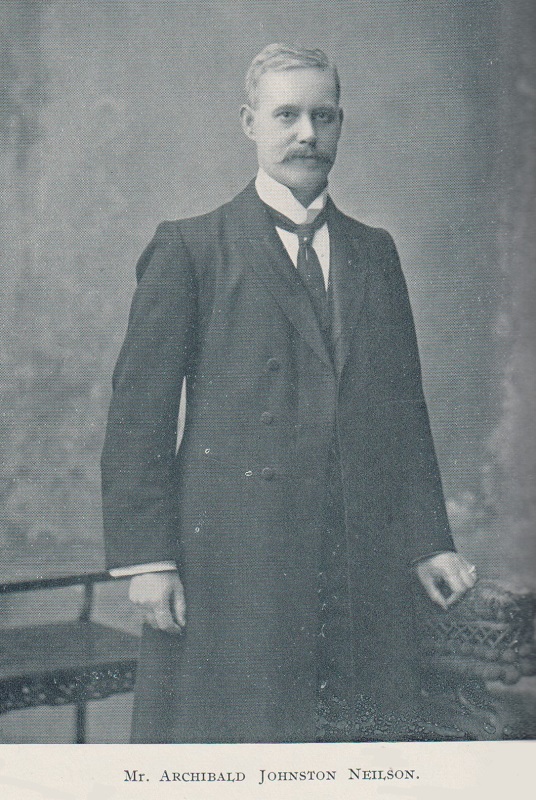
Below are further extracts from his Falkirk Herald column:
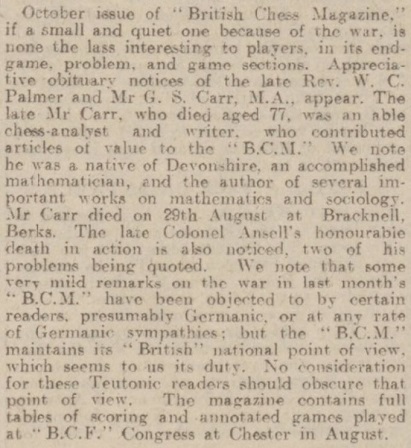
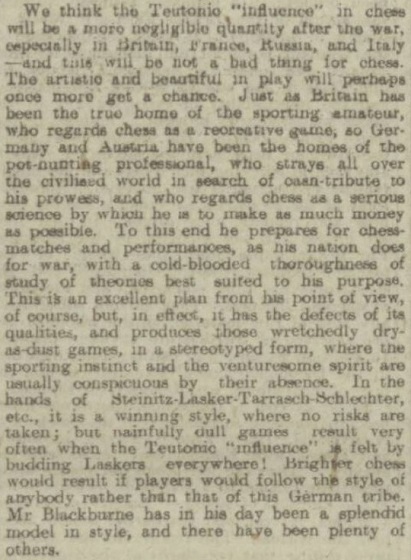
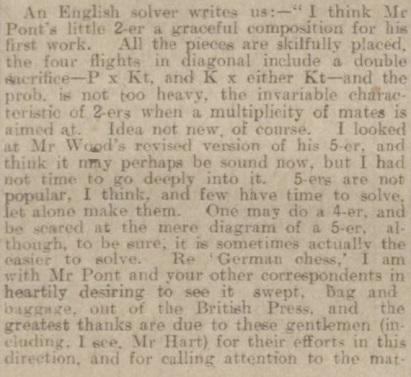
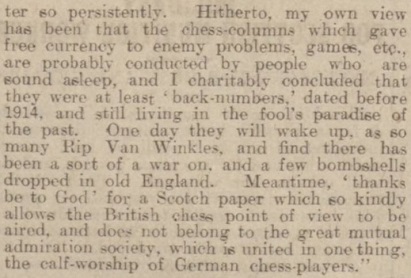
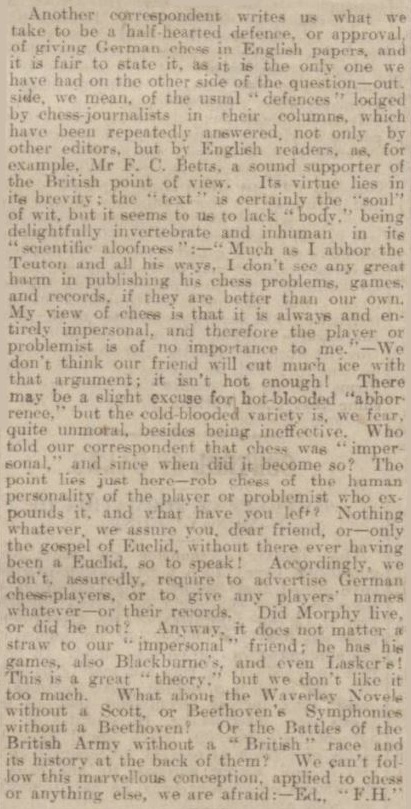
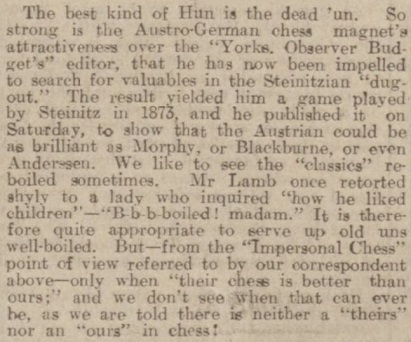
(11787)
Richard Forster writes:
‘In a letter to Ilya Maizelis (New York, 7 July 1939), Emanuel Lasker wrote:“Der Vereinigung der Schachmeister, deren Mitglieder Botwinnik, Alekhin, Capablanca, Euwe, Flohr, Fine, Reszhewski, Keres sind, bin ich nun angeschlossen und hoffe, dass sie etwas zur Förderung des Meisterschachs beitragen wird.”
Are any details known about this attempt to form a masters’ association, perhaps in conjunction with the AVRO, 1938 tournament?’
(11892)
C.N. 10977 referred to the unavailability of any sound recording featuring Emanuel Lasker, but now Olimpiu G. Urcan has found an instance on the Beeld en Geluid website and has secured permission for the file to be presented by us:
It was broadcast by the Dutch station KRO on 5 November 1935, during the Alekhine v Euwe world championship match. The interviewer, it seems, was Salo Landau.
The following transcript of Lasker being interviewed in Dutch has been provided, together with an English translation, by Hans Renette (Bierbeek, Belgium):
‘Ja, ja, ook zij hebben getoond zwakke zijden te hebben. Zo is de mens nu eenmaal. Niet steeds übermensch. Wat is de mens zonder enige zwakte? [Dat] bestaat alleen in de verbeelding.
Hoe kan Euwe van de zwakke zijde van Aljechin profiteren?
Indien hij speelt wat Aljechin niet goed ligt. Meer voor de hand ligt de vraag: wat zal Aljechin doen om zijn zwakke zijden te versterken? Dat hij daarmee tussen het spelen van de partijen druk bezig is, daaraan bestaat voor mij geen twijfel.
Zal het hem lukken?
Ik zal je een geheim toevertrouwen. Deze jonge man heeft talent. [De interviewer lacht.] Dat zeker. Dus wat een geniaal mens bereiken kan en hoe snel en handig hij iets kan aanleren, kan immers niemand raden.
Als ik het goed begrijp, heeft Euwe dus goede kansen als hij met wit speelt mits hij met de damepion opent. Maar hoe staat het met zijn verdediging als hij met zwart speelt?
Tot nu toe heeft hij met zwart ongunstig gespeeld. Vier partijen verloren met zwart is allesbehalve mooi. Maar vijf winstpunten met wit en slechts een verliespartij met deze kleur is uitstekend.
We zullen het zo zeggen: wie met wit speelt heeft een voordeel?
Zo was het niet altijd. Zukertort was van mening was dat e2-e4 een slechte zet was die door e7-e5 weerlegd werd en Aljechin’s loopbaan onderlijnt dit. Hij heeft met zwart in de Spaanse partij, die toch als zeer sterk geldt, zo goed als alle partijen gewonnen en geen enkele daarvan verloren, haast dertig jaren.
Tegenwoordig echter worden de meeste partijen door wit gewonnen?
Maar dat is individueel en afwisselend. Sommige meesters voelen zich beter thuis in de verdediging en anderen voelen zich meer op hun gemak als ze kunnen aanvallen.
Hoe komt dat dan, dokter?
Alles in het leven gaat op en neer. Zo is het ook hier. In het ene tijdperk winnen de witte stukken, in het andere, de andere keer, winnen de zwarte. Ik zal u liever vertellen wanneer Euwe zich echt in zijn element voelt.’
‘Yes, yes, they too showed weaknesses. That is how man is. Not always an übermensch. What would a man be without weaknesses? That exists only in the imagination.
How can Euwe take advantage of Alekhine’s weak side?
By playing that which does not suit Alekhine. But the more obvious question is: what will Alekhine do to strengthen his weaknesses? I have no doubt that he is working on that between the games.
Will he succeed?
I shall entrust you with a secret. This young man has talent. [The interviewer laughs.] That is for sure. How much a genius can achieve and how quickly and skilfully he can learn something – that is anybody’s guess.
If I understand correctly, Euwe has good chances when playing White – provided that he opens with the queen’s pawn. But what about his defence with Black?
So far he has played inauspiciously with Black. Losing four games with Black is anything but good. But five wins and just one loss with White – that is excellent.
Can we put it this way: White has the advantage?
It was not always like that. Zukertort considered e2-e4 a bad move, refuted by e7-e5, and Alekhine’s career underlines this. With Black against the Spanish Opening, known, after all, as a very strong opening, he has won almost all his games and did not lose a single one for nearly 30 years.
However, nowadays are not most games won by White?
But that is individual and variable. Some masters feel more at home in defence, and others feel more at ease when they are able to attack.
How can this be explained, Doctor?
Everything in life goes up and down. The same also here. In one period, the white pieces win, in another the black pieces do. I would prefer to tell you when Euwe truly feels in his element.’
Richard Forster points out that Lasker mentioned the radio broadcast in two letters to his wife Martha (xeroxes courtesy of Jurgen Stigter, Amsterdam). On 31 October 1935, Lasker wrote from Amsterdam:
‘Jetzt arbeite ich an meinem nächsten holländischen Vortrag vom 5ten Nov Abends 9.45min, indem fortgesetzt unter Leitung von Alex Frank Übungen an der Aussprache mache.’
[‘Now I am working on my next talk in Dutch for 5 November, 9.45 PM, by doing constant pronunciation training under the guidance of Alex Frank.’]
For some details concerning the journalist and actor Alex Frank (1888-1950), see this webpage.
On the day of the radio broadcast, 5 November 1935, Lasker informed his wife late at night:
‘Alle sind erstaunt, dass ich so gut auf holländisch geredet habe. Landau + Alex Frank waren entzückt, auch die Leute vom Radio selbst.’
[‘Everyone is amazed how well I spoke Dutch. Landau and Alex Frank were delighted, as were the radio people themselves.’]
(11905)
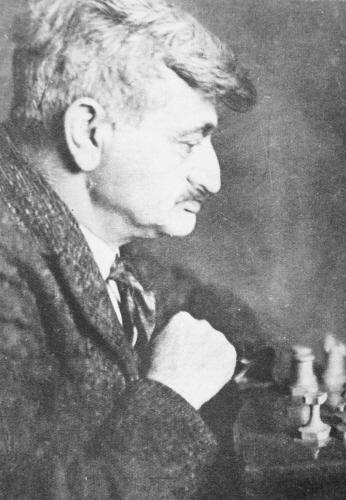
Emanuel Lasker (see A Series of Books on Lasker)
C.N.s 3471 and 3475 (see Chess Cartoons and Caricatures) have shown a caricature of Emanuel Lasker by Rafael Blanco. Now, Yandy Rojas Barrios (Cárdenas, Cuba) supplies a better-quality version, from page 125 of El Fígaro, 4 March 1906:
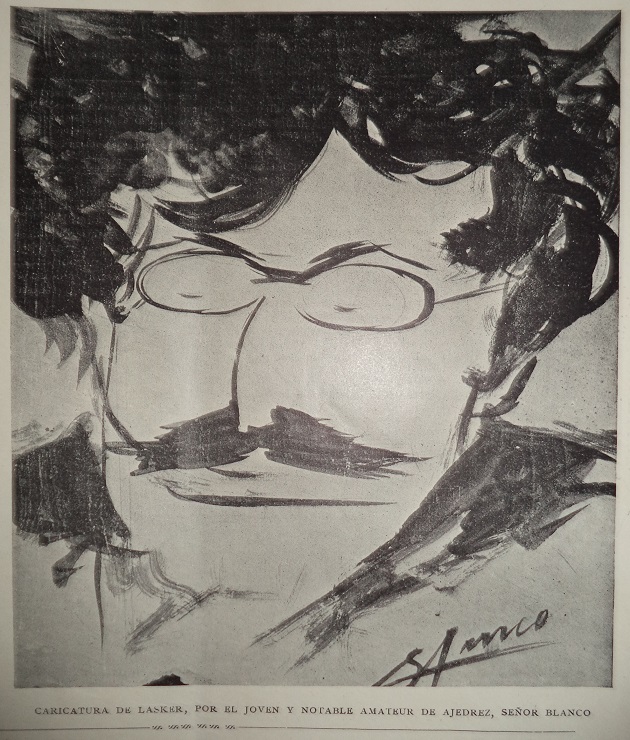
(11944)
Johannes Wiegand (Washington DC, USA) asks about possible contact between Lasker and Capablanca in the late 1930s and early 1940s, and the nature of their relationship towards the end of their lives, when both were living in New York.
Currently, we can quote only one account of their having met. On page 120 of the third volume (Berlin, 2022) of the Lasker trilogy Richard Forster wrote:
‘Back in bustling New York, the Laskers had an unusual guest in late summer [1940]: Capablanca turned up. He was, Martha noted, so much more likable than earlier, he was entertaining, and all former jealousy and arrogance had gone. At long last the two old champions were reconciled.’
The source of this information is a Lasker diary (see pages 114-115 of the book, which Richard Forster co-edited with Michael Negele and Raj Tischbierek).
Richard Forster has shown us the full entry by Martha Lasker concerning her husband’s meeting with Capablanca in 1940. About 260 words long, it includes this remark about the Cuban:
‘Früher als er in Havana Em die Weltmeisterwürde im Schach abgenommen hatte (unter Einwirkung der Tropenhitze auf Em) war er mir unausstehlich.’
(11947)
Olimpiu G. Urcan points out two photographs of Emanuel Lasker giving a simultaneous display.
For a list of Lasker’s exhibitions, see the Emanuel Lasker Online website.
(11957)
Much writing on chess history is wishful thinking or name-dropping, but careful authors sidestep the trap of what we propose to call ‘figurehead romanticism’. This includes, for example, claims or assumptions that most of the contents of Lasker’s Chess Magazine and Capablanca-Magazine were written by Lasker and Capablanca themselves. (The case of the International Chess Magazine is different, since Steinitz specified that it was largely a solo enterprise.)
A similar practice was mentioned in C.N. 8827: attributing a book by Tartakower and du Mont to Tartakower only. When there is assisted authorship (such as Kasparov books involving Donald Trelford or Mig Greengard, both of whom receive a ‘with’ credit), some writers need no second bidding to prefer without; they mention Kasparov alone. We can see a case for that in brief bibliographies, but not in reviews or discussions of the book.
(12043)
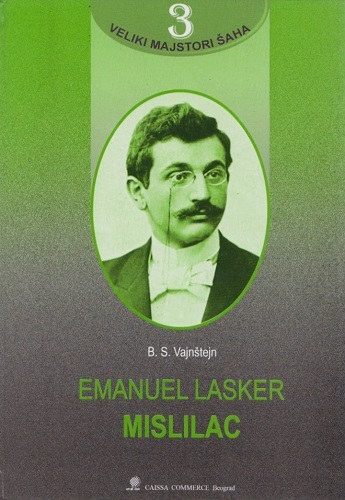
Lasker, Em.: 71 Chiswell Street, London, EC, England (Chess Player’s Annual and Club Directory 1893-94, page 283).
Lasker, Em.: Lützowstrasse 85B, Berlin W, Germany (American Chess Bulletin, November 1909, page 245).
Lasker, Em.: Aschaffenburger Str. 6A, Berlin W 30, Germany (Ranneforths Schach-Kalender, 1915, page 67).
Lasker, Em.: 610 West 139th Street, New York, USA (American Chess Bulletin, January-February 1941, page 3).
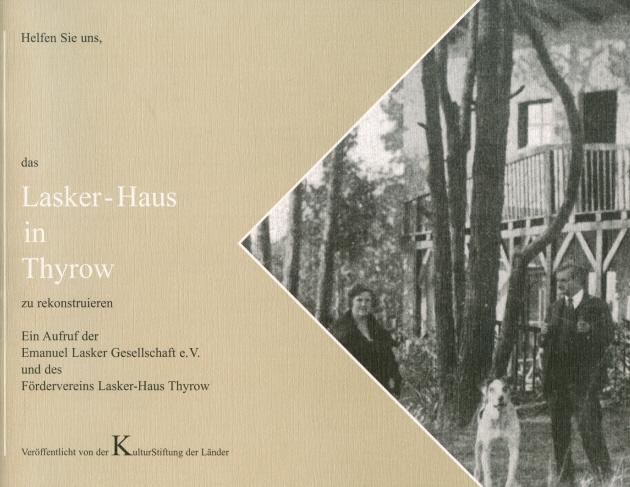
Addition on 3 November 2024:
Page 146 of the American Chess Magazine, October 1898:
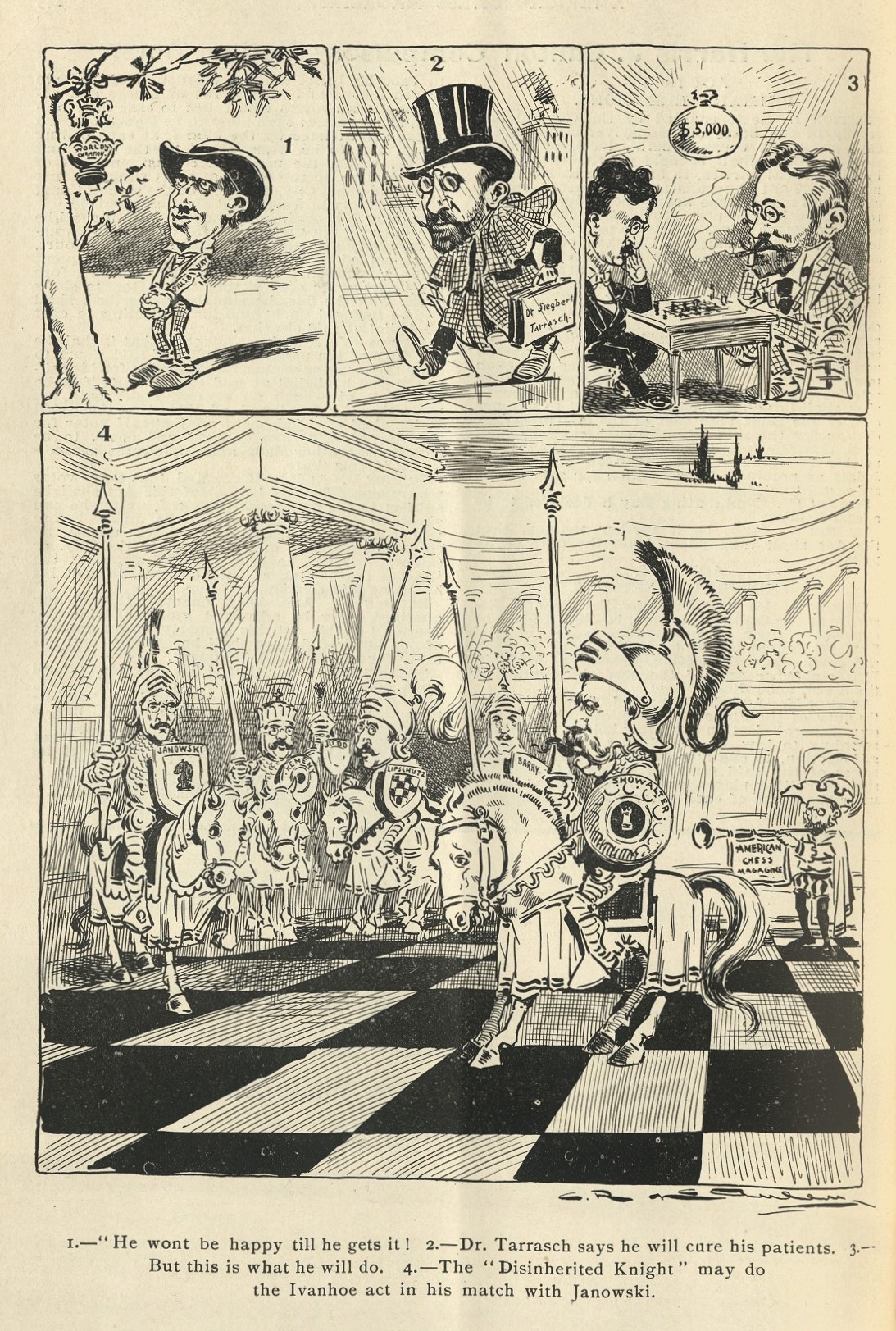
Acknowledgement for the scan: Cleveland Public Library
Addition on 24 December 2024:
From Lasker’s column in the New York Evening Post, 19 June 1907, page 5:
‘Force, as applied to chess, is often misunderstood. The prevalent idea is that superior force wins by direct strokes. This is partly true. But in chess, as in the life, a superior force has the power to compel the weaker to sacrifice itself. In life, often, the menace of impending disaster compels a man to take his own life – under normal conditions, the very last thing he wants to do.
In chess the application of this principle is more definite. The weaker force must do something; he cannot resort to tactics of masterly inactivity, as in life. He must move. And such compulsion is that which brings about his own destruction.
Only a few chessplayers understand this. The majority imagine that to win with superior force, aggressive tactics must be adopted on all occasions. But there are times when aggressiveness by superior force would prove utterly futile.’
Addition on 26 December 2024:
From page 10 of the New York Evening Post, 29 June 1907:
‘Deprecatory remarks are frequently made against players because they have lost a game badly, or because they got a very bad opening. Sometimes such criticism is justified; against the best players it is due to ignorance of the motives which determine their play. The man who has no great ambition, who wishes simply to obtain average and ordinary success, does not make any great blunders; nor does he make any great successes. He cannot reach higher than his aims. On the other hand, the man who has big ideas may rarely achieve them, but if he does he obtains great success.
The chessplayer who sits down with a grim determination not to get a bad game, to develop his pieces on the best-known lines, is a hard player to beat. Treat him in the same manner, and it will be hard to lose. Such players achieve average success; they do not try for more.
But the player who wishes to win a tournament, who is not satisfied with an average position, cannot afford to wait for a blunder which may never occur. He tries from the start to make the game hard and complicated. It is inevitable that such players should now and again get into bad positions, and lose on account of that.
In the following game played in the tournament at Ostend [in 1907: Tartakower v Spielmann], we see how Black gets a bad game because he is anxious to get a good one. He afterwards shows so much ingenuity that one is tempted to ask whether such a player should take a risk so early, whether he ought not to rely on his natural strength. It is all a matter of temperament. Dr Tarrasch would never think of making anything but the very best move; if his opponent does likewise, a draw is inevitable. Other players, in their anxiety to avoid a drawn game, take risks. Sometimes they win and at others they lose. A player should find out to which style he is better adapted, and apply himself to that.’
Addition on 30 December 2024:
The beginning of Emanuel Lasker’s column in the New York Evening Post, 10 July 1907, page 5:
‘In modern chess the beautiful is less on the surface than in the games of the past. It requires somewhat of a search before one can enjoy the full charm of the games of today. There has been a good deal of discussion over the comparative merits of the old and the modern school in chess. Even so astute a critic as Ruskin saw more beauty in the superficial chess of the old school, and inveighed against the painstaking methods of the present.
It would be easy to examine modern games and discover beautiful things which are not shown in the scores, because they consist in the avoidance of efforts which, though tempting, are not entirely sound.’
Addition on 2 January 2025:
From Lasker’s Evening Post article on page 7 of the 28 September 1907 edition:
‘There is a law in the strategy of chess by which enterprise is regulated. He who strives to be brilliant must earn the opportunity for brilliancy by an effort. Imagination can only fructify an opportunity, not create it.’
Addition on 10 January 2025:
On page 9 of the New York Evening Post, 2 November 1907 Lasker gave the 13th match-game between Blackburne and Zukertort, London, 7 June 1887 with this introduction:
‘It is well, from time to time, to cast a look into the past in order to compare present achievements with those of a former generation. One is as apt to exaggerate the one as the other. Those who are musically inclined think of the past as beautiful and dream of a future Eden, but they are never happy in the present. And the practical man who enjoys what he holds fast is a loser to the extent in which he might live old pleasures over again. That is as true in chess as in anything else. In chess we have lately been living at such a high rate of speed that one hears the old masters and masterpieces mentioned but seldom, and then with a sort of apology. There are so many “events” to be recorded that we forget to inquire into the quality of the achievement over the clamor of it. Hence an occasional retrograde movement of, say, two decades back, will do some good to the chess student and chess lover.
At that time there was a great analyst whose notes were studied assiduously by Pillsbury and, in the opinion of many, have never been equalled. That was he of a philosophical if untutored mind, the great Steinitz, who pried the innermost secrets of chess strategy open, but whom the world did not recognize or reward. The manner in which he laid bare the inner workings of the chess pieces in any game that he analyzed is a treat to the connoisseur. Here is an example, taken almost at random from the pages of his International Chess Magazine, where one may find it in the August issue of 1887.’
Addition on 20 January 2025:
From his Evening Post column of 25 January 1908, page 7:
‘Nothing succeeds worse against a strong attack than a pure defence.’
Addition on 14 January 2025:
The set of sketches below of Emanuel Lasker in Birmingham, with R.J. Buckley, was published on page 13 of the Birmingham Weekly Post, 1 December 1900:

By way of introduction to the now familiar simultaneous game F.W. Dunn v Emanuel Lasker, London, 21 January 1908, which began 1 e4 e5 2 Nf3 Nc6 3 Bc4 Nf6 4 Ng5 d5 5 exd5 Nd4, Lasker’s column on page 7 of the New York Evening Post, 28 March 1908 stated:
‘Simultaneous chess, which has now become so popular, both here and in Europe, is capable of furnishing entertainments and instruction to the amateur chessplayer. But in order to make it so, it is necessary that the single performer – usually a master – should consider the interests of his opponents, and instead of measuring his success by the high score he can make, he should endeavor to play all sorts of combinations, calculated to exercise the ingenuity of his spectators. One should not try to play perfect chess on such occasions, for, to begin with, under the condition of play, one cannot succeed in doing so and, on the other hand, by introducing novelties that may lead to lively, though perhaps unsound, attacks, one not only avoids unduly prolonging the performance but also presents to the spectators many interesting and exciting positions. This sort of simultaneous chess also appeals to the opposing players, who usually prefer being defeated in a fair fight rather than being gradually and dismally ground down by the proverbial pawn plus.
Dr Lasker’s popularity as a simultaneous performer is largely due to his following this method of procedure. Always endeavoring to make his exhibitions both entertaining and instructive, he rarely follows the orthodox lines of play, but by varying at some point endeavors to create interesting situations that shall throw his opponents [sic] on his own resources, and enable him to exercise his ingenuity in finding the best reply.’
A comprehensive chronicle of his simultaneous displays from 1893 to 1940 is provided on the Emanuel Lasker Online website.
(12099)
From Emanuel Lasker’s column in the New York Evening Post, 2 May 1908, page 9:
‘Maróczy has the emotional nature of the Magyar, and is therefore as variable as his moods. He can play all styles, the highest and the lowest, and neither his upper nor his lower limits have yet been determined. Hence he is somewhat of a riddle, that could be solved only if he pitted himself against the foremost masters in match play, but he resolutely declines to do so. Perhaps he likes to remain a mystery.’
Page 273 of our monograph on Capablanca gave his words about Emanuel Lasker on page 12 of the New York Times, 11 January 1936:
‘He beat me in our game in the Moscow tournament last year, and he did it fairly and squarely, with no excuses. He still is the most formidable player I know in a single game or a short match. Of course his age would be too great a handicap for him in a long match.’
A remark by Walter Penn Shipley in his obituary of Lasker in the Philadelphia Inquirer, 9 February 1941, page 18:
‘José R. Capablanca had the greatest respect for the man who surrendered to him the world’s crown, and as recently as 1937 stated that although Dr Lasker on account of his age was hardly capable of doing his best in a match, nevertheless for a single game was still the most dangerous opponent in the world.’
(12156)
From Yandy Rojas Barrios (Cárdenas, Cuba):
‘I have just finalized a 300-page manuscript on Emanuel Lasker’s visits to Cuba in 1893 and 1906. It is in Spanish, but I am hoping to have it published in English, in a single volume or in two parts.
With the advances in AI technology, it is now possible for me to produce a working English translation, but to ensure maximum accuracy I shall need it to be reviewed by a native English-speaking editor with good knowledge of Spanish. In addition, I am seeking an English-language publisher.
As examples of the material that has been found, here are two reports giving very different impressions of Lasker:
Andrés Clemente Vázquez, El Fígaro, Ausencia de Mr. Lasker, 19 February 1893, page 70:
“El Sr. Lasker nos ha dejado convencidos de sus excepcionales facultades como luchador de la Escuela Moderna, pero sería inútil ocultar que su despedida ha sido fría, no sólo por haberse negado a medir sus fuerzas con el Sr. Walbrodt, en lo cual había extraordinario empeño por parte de los aficionados de esta capital, sino porque en todos casos demostró, al jugar con esos mismos aficionados, un implacable sistema de aprovecharse de los más insignificantes detalles, para ganar a toda costa. En la primera partida con nosotros, nos obligó a jugar media hora más después de habernos eximido de ella previamente, a causa de una repentina indisposición que sufrimos; habiéndose debido quizás su postrero cambio de parecer, al hecho evidente de que en el instante en que debía haberse suspendido el combate, la posición era crítica para él, y no le convenía que con el descanso tuviéramos mucho tiempo para buscar y encontrar la jugada con la cual podía perder. Esto no obstante, al día siguiente le quedaban diez minutos para hacer nueve jugadas, se presentó en el lugar de la cita con un cuarto de hora de retardo, y nosotros no quisimos reclamar la victoria, por el transcurso del tiempo ... Nobleza obliga, y la generosidad y la caballerosidad han sido siempre blasones de nuestra raza. Nosotros relegamos todo eso al archivo del pasado, y deseamos al inteligente y joven champion de Inglaterra [sic] las mayores prosperidades, en su ya brillantísima carrera, como jugador de primer orden, en el sublime arte de Philidor y Anderssen.”
Juan Corzo y Príncipe, Diario de la Marina, Lasker en la Habana, 11 February 1906, page 5:
“El Campeón del mundo cuenta 36 [sic] años de edad, aunque representa menos …
Desde su llegada se ha captado Mr. Lasker las simpatías de los aficionados de Cuba, que no habíamos tenido ocasión de conocerle cuando vino a la Habana en 1893.
Siendo una eminencia en un juego eminente, y poseyendo gran cultura que se revela en su conversación que puede sostener en cuatro idiomas, pues conoce perfectamente, a más del alemán, el inglés y el francés y algo de español, es modesto y afable, habiéndose prestado desde el primer día a jugar partidas rápidas con los jugadores fuertes y dando partido a los jugadores débiles, siendo para ellos un franco camarada, a la vez que un maestro ideal, porque sabe enseñar deleitando.”’
We shall pass on to Mr Rojas Barrios any messages from readers about editing and publishing his work.
(12169)
Addition on 6 August 2025:
Mr Rojas Barrios has entered into a contract for the publication of his book in Spanish and English.
From John Townsend (Wokingham, England):
‘C.N. 10101 noted some prominent people from the world of chess who were identified as freemasons during the nineteenth century from the membership records available on Ancestry.com.
To these should be added the even more illustrious name of Emanuel Lasker, who became a member of Montefiore Lodge in London (Lodge no. 1017). He was initiated there on 22 April 1896, “passed” on 27 May 1896, and “raised” on 24 February [year not specified]. His age on admission was given as 27, and his residence was 71 Chiswell Street, [London], EC. His profession was Mathematician. In the column headed “Certificates” is entered the date 8 March 1897. He kept up his subscription payments until 22 January 1902, the day of his resignation.
John Lane’s Masonic Records 1717-1894, second edition, 1895, on page 337 traces the constitution of Montefiore Lodge back to 9 May 1864, and notes early meetings at Freemasons’ Tavern, Freemasons’ Hall, and the Regent Masonic Hall.
Montefiore Lodge was described as “a real tribute to the benevolence of Bro. Sir Moses Montefiore as a man and a Mason” in The Freemason’s Repository, Vol. XX, 1890-91, page 634.
See also the brief reference on pages 112-113 of volume one (Berlin, 2018) of the Emanuel Lasker trilogy of books co-authored by Richard Forster, Michael Negele and Raj Tischbierek.
Further particulars about Lasker’s activities as a freemason may be obtained at: Museum of Freemasonry, Freemasons’ Hall, 60 Great Queen Street, London. WC2B 5AZ.’
(12190)
Olimpiu G. Urcan provides the following:
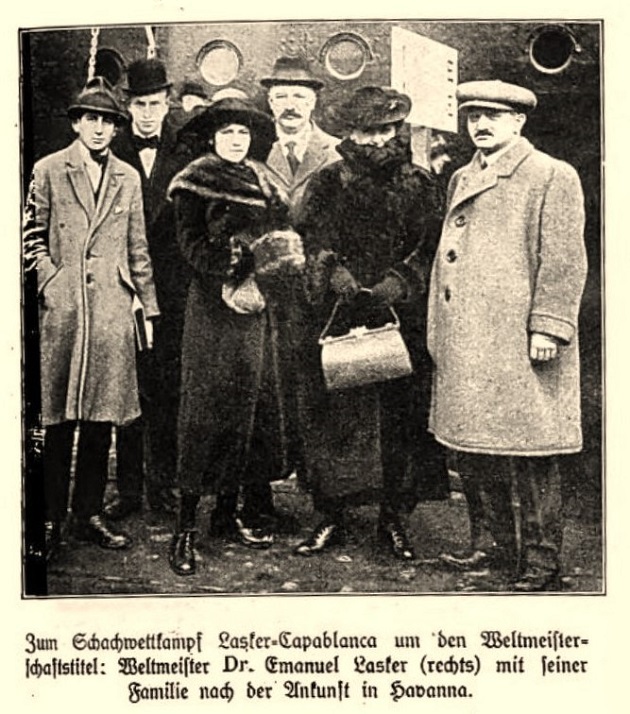
Source: Illustrirte Zeitung, 7 April 1921, page 281.
(12192)
Our feature article Patriotism, Nationalism, Jingoism and Racism in Chess asked this quiz question:
When Emanuel Lasker died in 1941, how did Deutsche Schachblätter cover the event?
The answer given at the end of the article: There was no obituary or report of any kind.
We first drew intention to the Deutsche Schachblätter case in C.N. 1718, which also mentioned that Capablanca’s obituary in the 7/8 1941 issue (page 60) was three lines.
The present general article on Lasker complements the following more specific feature articles, and very little material from them has been duplicated here:
A Series of Books on Lasker
Steinitz, Lasker, Potter and the ‘Modern School’
London, 1899 Pen-portraits
The Consultation Game That Never Was
Lasker v Janowsky, Paris, 1909
The Lasker v Schlechter Controversy (1910)
How Capablanca Became World Champion
Lasker on the 1921 World Championship Match
Capablanca’s Reply to Lasker
Dr Lasker’s Chess History
World Championship Disorder
Articles about Emanuel Lasker.
See also:
Chess and Bridge
Copyright on Chess Games
Ely Culbertson and Chess
Luck in Chess
Zugzwang
Early Uses of ‘World Chess Champion’
Chess Problems by H.F.L. Meyer.
To the Chess Notes main page.
To the Archives for other feature articles.
Copyright: Edward Winter. All rights reserved.